
* A Distributed Proofreaders Canada eBook *
This ebook is made available at no cost and with very few restrictions. These restrictions apply only if (1) you make a change in the ebook (other than alteration for different display devices), or (2) you are making commercial use of the ebook. If either of these conditions applies, please contact a FP administrator before proceeding.
This work is in the Canadian public domain, but may be under copyright in some countries. If you live outside Canada, check your country's copyright laws. IF THE BOOK IS UNDER COPYRIGHT IN YOUR COUNTRY, DO NOT DOWNLOAD OR REDISTRIBUTE THIS FILE.
Title: Canada
Date of first publication: 1907
Author: William Wilfred Campbell (1860-1918)
Date first posted: July 21, 2017
Date last updated: July 21, 2017
Faded Page eBook #20170716
This ebook was produced by: Mardi Desjardins & the online Distributed Proofreaders Canada team at http://www.pgdpcanada.net

CANADA

ILLECILLEWAET BELOW SIR DONALD
CANADA
PAINTED BY T. MOWER MARTIN R.C.A.
DESCRIBED BY WILFRED CAMPBELL LL.D.
PUBLISHED BY A. & C. BLACK • LONDON MCMVII

To
HIS EXCELLENCY
THE RIGHT HONOURABLE
EARL GREY, G.C.M.G.
GOVERNOR-GENERAL OF CANADA
THIS BOOK IS BY PERMISSION
DEDICATED
The author has not attempted to give a history of Canada. It is a new country, and not the stage of centuries of human struggle and effort, in the sense that European countries are. Therefore his idea has been to describe the great natural features of the land, in its broader characteristics—its coasts, rivers, mountains, lakes, and prairies, those physical beauties and sublime effects of nature for which the region is specially famous. With this he has attempted to depict the seasons, and the beauty of the Canadian woods.
In addition there is given a brief sketch of the settlement and development of the different communities, with special reference to the great centres of provincial and racial activities, and a reference to the people, its origins, composite ideals, and the leading actors on its historical stage of progress and accomplishment.
Ottawa, Canada.
December 1906.
| PAGE | |
| CHAPTER I | |
| Introduction | 1 |
| CHAPTER II | |
| The Maritime Provinces and the Early Discoverers | 13 |
| CHAPTER III | |
| The Maritime Provinces—Later History and Characteristics | 29 |
| CHAPTER IV | |
| Quebec and the Lower St Lawrence Valley | 49 |
| CHAPTER V | |
| Montreal and the Upper St Lawrence | 72 |
| CHAPTER VI | |
| Ottawa, the Capital of the Dominion | 94 |
| CHAPTER VII | |
| The Canadian Seasons and Woods | 119 |
| CHAPTER VIII | |
| Toronto and Western Ontario | 143 |
| CHAPTER IX | |
| The Canadian Lake Region | 177 |
| CHAPTER X | |
| The Old North-West and Manitoba | 206 |
| CHAPTER XI | |
| The Two New Prairie Provinces | 224 |
| CHAPTER XII | |
| British Columbia and the Rocky Mountains | 237 |
| INDEX | 263 |
Transcriber’s Notes can be found at the end of this eBook.
| 1. | Illecillewaet below Sir Donald | Frontispiece |
| FACING PAGE | ||
| 2. | North of Howe Sound, Pacific Coast, British Columbia | 2 |
| 3. | Mount Cheops and the Hermit Range | 4 |
| 4. | Sunset on the Great Selkirk Glaciers | 6 |
| 5. | Settler’s Farmyard, Muskoka | 8 |
| 6. | Mountain Goats Feeding | 10 |
| 7. | End of Lake Louise, and Mount Aberdeen | 12 |
| 8. | Road near the Bay of Fundy, Autumn | 16 |
| 9. | Fall of the Year, Nova Scotia | 20 |
| 10. | Port Hawkesbury, on the Strait of Canso, Cape Breton | 24 |
| 11. | Cape Porcupine, Gut of Canso, Cape Breton | 28 |
| 12. | Old-fashioned Farm, New Brunswick | 32 |
| 13. | Basin of Minas, Nova Scotia | 36 |
| 14. | York Redoubt, and Halifax Harbour | 40 |
| 15. | Stormy Sunset, Coast near St John, New Brunswick | 44 |
| 16. | St Lawrence, near Sillery Cove | 54 |
| 17. | The Citadel, Quebec | 62 |
| 18. | Quebec, from Point Levis | 64 |
| 19. | Martello Tower, Plains of Abraham | 70 |
| 20. | An Indian Chief | 74 |
| 21. | Owl’s Head Mountain, near Montreal | 76 |
| 22. | Montreal: the River St Lawrence from the Mountain | 80 |
| 23. | In Sherbrooke, Eastern Townships, Quebec | 86 |
| 24. | A Farmyard in Ontario | 94 |
| 25. | Ottawa, from near the Experimental Farm | 102 |
| 26. | The Ottawa at Vaudreuil | 108 |
| 27. | Early Spring, near Victoria, British Columbia | 120 |
| 28. | Autumn in New Brunswick | 124 |
| 29. | Big Spruce in Stanley Park | 128 |
| 30. | Falls on the Illecillewaet River, Selkirk Mountains, British Columbia | 130 |
| 31. | Road near Victoria (Evening) | 132 |
| 32. | Winter-time in Vancouver Island, British Columbia | 136 |
| 33. | Ross Peak, Selkirk Mountains, British Columbia | 140 |
| 34. | Toronto, from the Island | 150 |
| 35. | Toboganning at Rosedale, Toronto | 158 |
| 36. | Indians in the Olden Time | 164 |
| 37. | Niagara Falls | 166 |
| 38. | A Glimpse of Niagara from under Luna Island | 168 |
| 39. | Evening Mists, Muskoka | 178 |
| 40. | Muskoka Lake, North Ontario | 180 |
| 41. | Showery Weather, Muskoka Lake | 182 |
| 42. | Autumn on Lake of Bays, Muskoka | 186 |
| 43. | Sunset on Canoe Lake, Parry Sound | 190 |
| 44. | Portage on Surprise Lake | 196 |
| 45. | Sunset on Lake Superior | 198 |
| 46. | North Shore, Lake Superior | 200 |
| 47. | In the Moose Country, near Lake Superior | 202 |
| 48. | Cariboo Island, Thunder Bay | 204 |
| 49. | Van Horne Range (Evening) | 206 |
| 50. | Mount Temple, with Wild Goats Feeding | 208 |
| 51. | Mounts Aberdeen, Lefroy, and Victoria, on Lake Louise | 210 |
| 52. | Pitt River and Golden Ear Mountains | 212 |
| 53. | From the Foot of Eagle Peak, Selkirk Mountains | 214 |
| 54. | Mount Sir Donald, in the Selkirks | 216 |
| 55. | Winnipeg: Corner Main Street and Portage Avenue | 218 |
| 56. | Out on the Prairies | 220 |
| 57. | On Arrow Lake, Columbia River | 222 |
| 58. | Buffalo Feeding in Winter | 224 |
| 59. | Mountain Sheep at Home | 226 |
| 60. | The Valley from Rogers Pass | 228 |
| 61. | Pitt Meadows, on the Fraser River, British Columbia | 230 |
| 62. | Back Country Farmyard, Winter | 232 |
| 63. | Source of the Beaver River | 234 |
| 64. | Buffalo in Summer-time, on Bow Range, near Banff | 236 |
| 65. | Ottertail Range, Rockies, British Columbia | 238 |
| 66. | Hastings Wharf, Vancouver | 240 |
| 67. | Burial-ground of Siwash Indians | 242 |
| 68. | Outlet of Lake Agnes | 244 |
| 69. | Fanning Sheep coming down to Feed | 246 |
| 70. | Glacier Crest, Illecillewaet | 248 |
| 71. | Great Illecillewaet Glacier | 250 |
| 72. | Lake Louise, Laggan | 252 |
| 73. | Coast near Sechelt, British Columbia | 254 |
| 74. | Coast of Vancouver Island | 256 |
| 75. | Siwash Village, Pacific Coast | 258 |
| 76. | Olympic Mountains, from Coast near Victoria | 260 |
| 77. | Pacific Coast near Nelson’s Island | 262 |
Thou land for gods, or those of old
Whom men deemed gods, of loftier mould,
Sons of the vast, the hills, the sea,
Masters of earth’s humanity:
I stand here where this autumn morn,
Autumnal garbs thy hills adorn,
And all thy woodlands flame with fire,
And glory of the world’s desire.
Far northward lie thy purple hills,
Far vasts between, thy great stream fills,
Ottáwa, his fleet tides impearled,
From deep to deep, adown the world.
O land, by every gift of God
Brave home of freemen, let thy sod,
Sacred with blood of hero sires,
Spurn from its breast ignobler fires.
Keep on these shores where beauty reigns,
And vastness folds from peak to plains,
With room for all from hills to sea,
No shackled, helot tyranny.
Spurn from thy breast the bigot lie,
The smallness not of earth or sky
Breed all thy sons brave stalwart men,
To meet the world as one to ten.
Breed all thy daughters mothers true,
Magic of that glad joy of you,
Till liberties thy hills adorn,
As wide as thy wide fields of corn.
Let that brave soul of Britain’s race,
That peopled all this vastness, trace
Its freedoms fought, ideals won,
Strength built on strength from sire to son
Till from thy earth-wide hills and seas,
Thy manhood as the strength of trees,
Thy liberty alone compare
With thy wide winnowed mountain air,
And round earth’s rim thine honour glows,
Unsullied as thy drifted snows.
Wilfred Campbell.
CANADA
INTRODUCTION
A country of dry frost in winter, and of fruitful heat in summer, with numerous delightful climates in between—this is the rising nation, Canada. And of a similar strange mixture are its people, at once the most hard-working and yet most hopeful of any people upon earth, in the mind of him who deeply ponders upon their unique conditions. The destiny of a young and vigorous people animated by high ambitions must be either lofty or sordid. It is between these two extremes that national tragedy lies. Canada promises either to be the theatre of one of the greatest commonwealths the world has seen, or else, failing this, to be the land where race has died out in a crude, vulgar cosmopolitanism; where patriotism has been destroyed by a foolish party system, and all idealism crushed out in a hard materalism. There is no blinking the situation. We are the youngest people in the world, and yet we have some of the gravest problems to solve; and it is all because we are strong and proud, and have taken the bit in our teeth with a brave spirit and an ambition to rule ourselves, and be all or nothing.
The Scotland of America, Canada should well be called, both from its northern position on this continent, its rugged, austere lands, its severe, invigorating climate, and the fact that the greater portion of its people, with the exception of the French, are of the blood which has made famous in history that remarkable home of great souls, North Britain.
There is no doubt that Canada is the Scotland of America, and that, as in Scotland, the very semi-poverty of her people, or rather lack of great wealth, coupled with her bracing and vigorous climate, has had much to do with the production of a hardier, more determined race than the country to the south on the whole produces. The north has ever been the home of liberty, industry, and valour. History teaches that conquerors have not usually come from the south. With all his faults—and he has his own—the young Canadian is unusually self-sustaining. He is over-eager to leave home and struggle for himself. The fate of his future for the most part depends purely upon his personal ambition and mental energy. Where this is combined with a highly ethical conception of life, a personality of uncommon force of character is likely to be produced. And there is not wanting evidence that such a type may develop here in Canada.
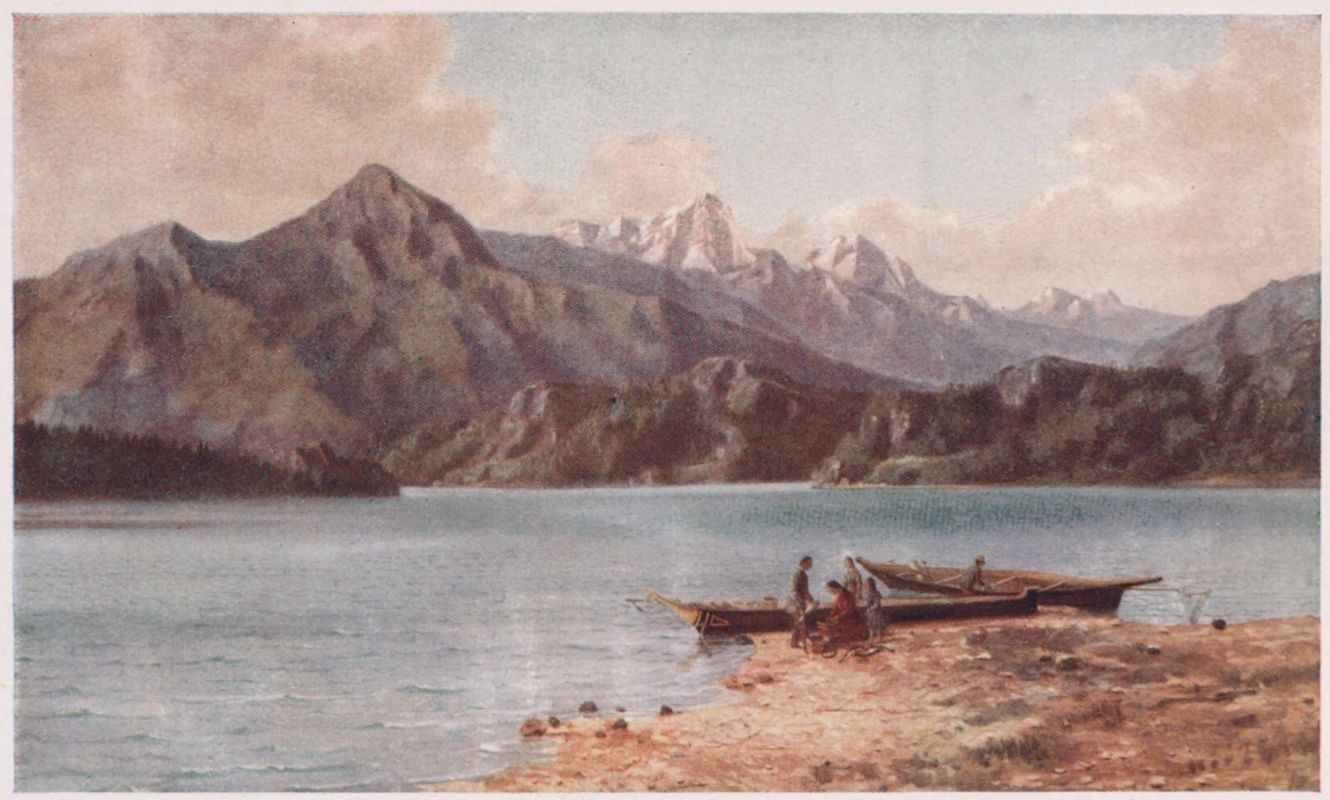
NORTH OF HOWE SOUND, PACIFIC COAST, BRITISH COLUMBIA
It is this possibility as to character, this promise of a strong, individual, intellectual, ethically-governed manhood, that gives most hope for the Canada of the future. Not all the millions of acres of wheat-lands of her prairies, not all her cities of smoking factories and busy commerce in the east and west, will succeed in making her dominant in the world-arena, as will the strong personality, the unflinching character, of her coming men.
The northern peoples have always been the truest, the wisest, and the deepest thinkers; and their imagination has always been the most beautiful and the sanest, because the nearest to nature. They have ever been the strongest in personality and the self-rulers of the world. Northern Europe, Northern Britain, Northern Ireland, are all historical evidence of this fact. Even in the United States this is so far true; and Canada cannot escape this great law of life and nature.
But it is not all a mere matter of zone or climate; it is rather owing to the stock of people, who by a natural instinct seek, or brave, through preference, those more rugged temperate climes. It is this heredity, this temperament, which is needful to make a people really great. Never in a soft, enervating clime has man sought for God and interpreted His personality and relationship to life so clearly, so humanly, and so sublimely, and in so personal a manner, as he has done in the opens of Northern Europe and America.
Never has man been so wide awake as an individual to the whole responsibilities and possibilities of his existence as he has been among those more rugged, self-ruling, self-searching, dominant, nature-subduing races of the northern zone. It is this, after all, which makes a people really great—this slow, sure, true development of a race individuality. May the people of Canada retain this strong individual interest in the race-ideals of the past, and emulate the greatness of their ancestors.
But the Scot is not the only man who has made Canada what it is to-day. The earliest discoverer here was the Norman, that strong world-conqueror of the past; and he, the cousin in blood of the Scot, is his partner and rival in the future destinies of this newer Britain, as he has been in that older Britain of William the Conqueror.
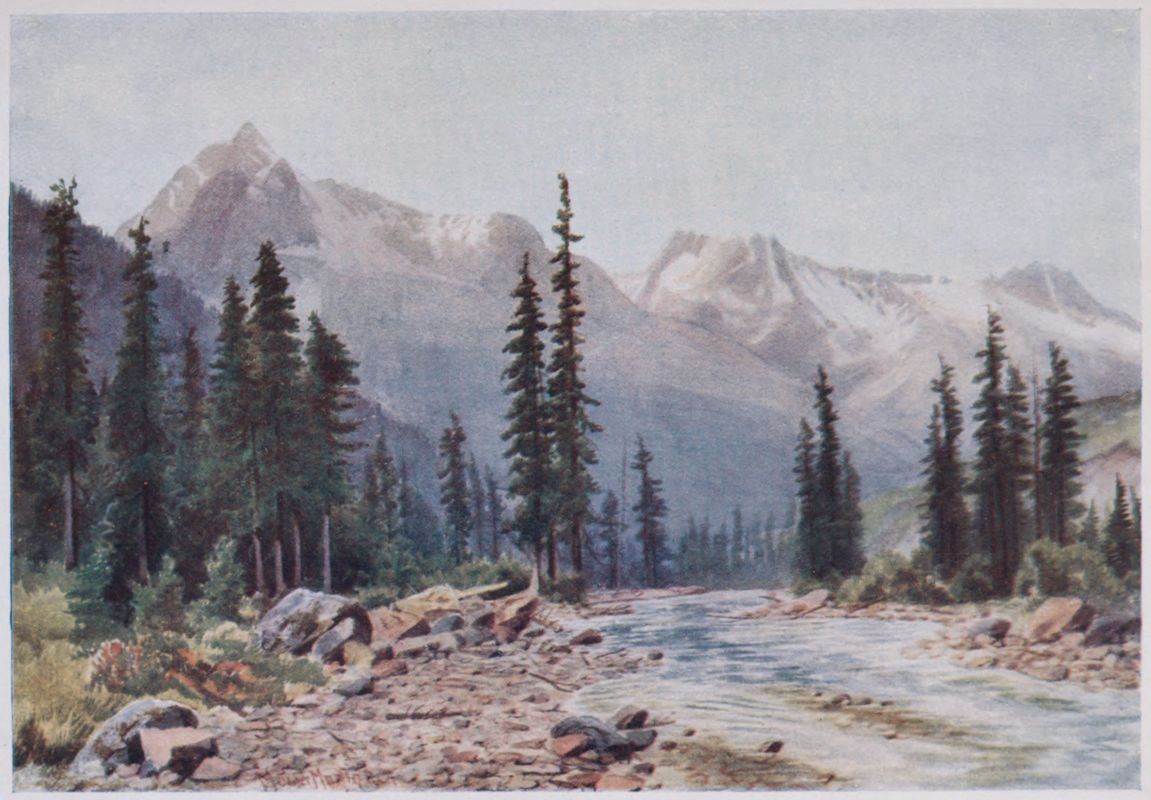
MOUNT CHEOPS AND THE HERMIT RANGE
Then there are the English, the sturdiest, the most independent stock of men in the whole world; and next follows the north of Ireland Scot, who has perhaps more than any other class dominated and moulded the character, and affected the speech and accent, of the Canadian people.
After these comes the Irishman, the genial southern Celt with warm heart, who has ever stood for culture, and also for liberty everywhere save, sad to say, in his own land. Ireland has been represented in Canadian history by a remarkable band of gifted men, such as D’Arcy M‘Gee, Edward Blake, and Archbishop Connolly. Last but not least, the United Empire Loyalists, who came in from the republic to the south, rather than live outside of British rule, and who are of British stock, have been a prominent element in the making of the Canadian community.
But remarkable as is the personality of the Canadian of the past and present, it is not the Canadian himself that attracts the attention of the outside world; it is rather the physical advantages of the country in which he is so fortunate to dwell.
That which must, first and last, compel the wonder and admiration of the old-world traveller in this new land, is its vastness, its distances, the grandeur of the scale upon which the natural features which characterise the broad half of this great western continent known as Canada are formed. He has possibly heard that the Dominion stretches from ocean to ocean, that it contains great inland seas, and a chain of mountains rivalling any in the world; that its riverways are the vastest water highways on the globe; yet it is a question if he is ever prepared for the reality.
We ourselves scarcely realise the wealth of the Dominion in both scenery and natural resources. We have fallen into our inheritance without any of the struggle and sacrifice of our forefathers. Even the memory of that struggle is, sad to say, passing. The trackless forest is no longer assailed by the puny hands of a few settlers, endeavouring to carve out a home for themselves in the wilderness. Railways and government surveys have changed all this. The outsider must realise that we, as a people, have passed into a more advanced, if less picturesque, stage, and that even the literature of our country no more represents the backwoods and the Indian; and he who would so represent us misrepresents our true condition. The life of the canoe and the wilds is long past, and as alien from the great modern life of cultured Canada as it is from the civilisation of London. We have a few writers who, without any true human grip of the Canadian life as it is, and seeking what they falsely think makes their work unique, strain to make out that the spirit of Canada is yet to be found in the wilds; but these are mere posers, who do not count in our real advancement—flies on the national wheel, such as are found in every country. Even these men produce their literary pabulum in the heart of American or Canadian cities. The truth is that we have a greatness of nature about us in Canada; but it is at our very doors; and in the environs of the capital of Canada will be found as grand natural scenery as is to be seen anywhere in the world.
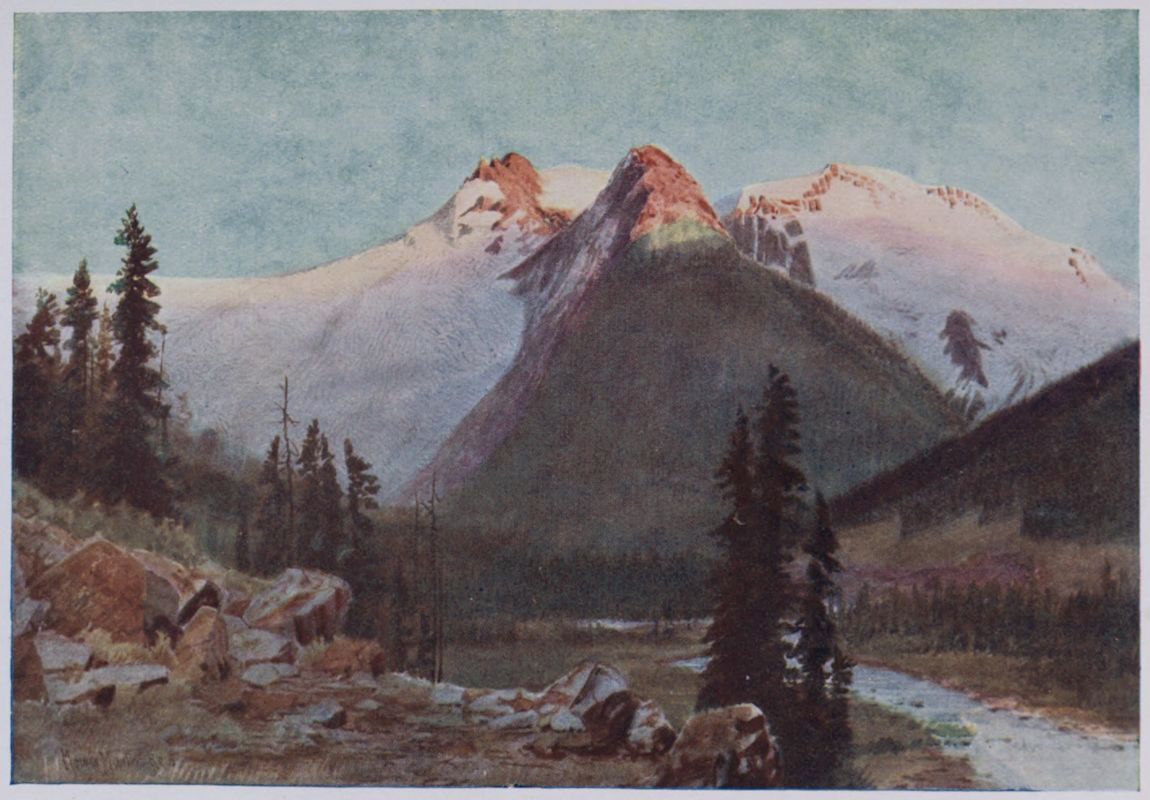
SUNSET ON THE GREAT SELKIRK GLACIERS
Our chief characteristic in the eyes of the stranger, is that we are still regarded, perhaps wrongly, as a virgin land. To the rest of the world there still hangs over our country that delightful golden mist of great and boundless possibilities which makes the Avalon of desire, the Eldorado of dreams, a field for adventure and enterprise where every man has a chance, and hope as a guiding star shines bright, with success ever in sight. This glamour will always exist where men are dreamers, and discontented with their own surroundings. As the poet has said:
“’Tis distance lends enchantment to the view,
And robes the mountain in its azure hue.”
We have, however, a climate in many ways without compare, either dry or moist, moderate or severe, according to locality; lands rich and waiting for cultivation, virgin forests covered with timber, and in some parts still abounding in game. We have vast mineral deposits as yet undeveloped and unexplored; so that, in so far as the material attractions are concerned, Canada is a country for the strenuous man of the present and future, who is willing to work and struggle not only with nature but with his fellow-man.
The traveller entering Canada from the east, by way of the Gulf of St Lawrence, enters one of the great rivers of the world. Passing the rock and fortress of Quebec, and the district through which the St Lawrence flows, he comes to Montreal, the Canadian metropolis; then on to Toronto, and west to Winnipeg, the centre of the Dominion; and thence to the Rocky Mountains and beyond. In this journey a revelation—I will not say a disillusionment—awaits him.
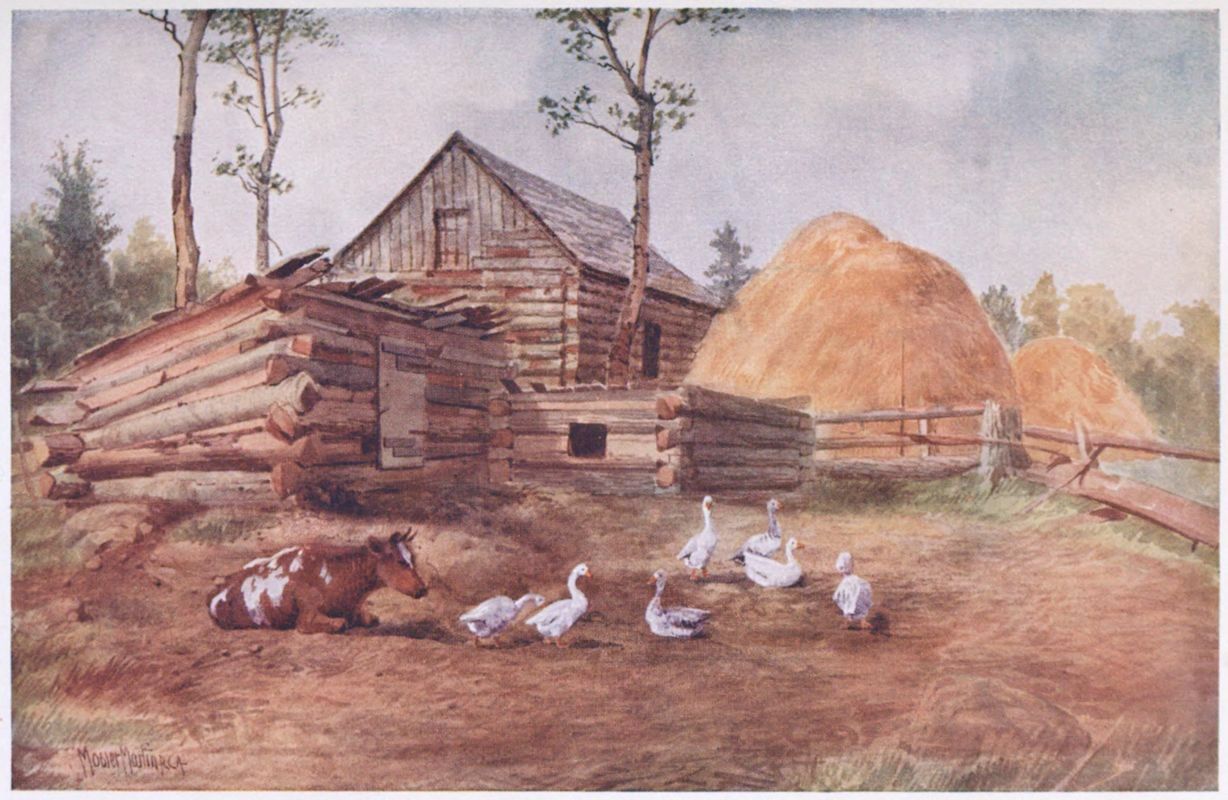
SETTLER’S FARMYARD, MUSKOKA
The vastness, the grandeur of the scenery, the miles upon miles of country over which he is being rapidly whirled, while the ever-varying panorama materialises and dissolves as he passes, must be a continual source of astonishment and admiration. And though he may have seen the beauty and grandeur of the great lakes, he is scarcely prepared for the scene which awaits him after he passes the wide prairies, through seas of waving grass, and the glorious vision of the Rocky Mountains arises like a vast new dream conjured up by Dante, or touched by the master-hand of that magician, Turner.
It must be admitted that we, as a people, have not been as true as we should have been to the vast and priceless trust which fate and nature have given into our hands, as the possessors of so much natural wealth. We, in common with all inhabitants of new countries, have been sadly wasteful of our forests, which, as a people, we were unfit not only to possess but to control. It would have been well for Canada if, fifty years ago, someone had warned the people of the terrible destruction of timber all over the country, and if we had had statesmen to make laws to restrict this destruction. No man has a perfect right to waste his land or what grows thereon. The law should compel all landowners to provide for future generations. The same ruin has taken place regarding our fisheries, and the lumber industry has been allowed to kill with sawdust all the fish in our streams. But these weaknesses, grave as they are, are those of all young peoples; and we are tardily coming to a sense of our shortcomings in this respect.
We are, however, not without our ideals, and under all the upper current of materialism which dominates our society there is a surely developing discontent with crude methods of legislation, and a determination toward loftier ethical levels of thought and action. This is shown not only in the more earnest pulpit utterance, the higher-class journalistic warnings, and a very few of our literary influences, but also in an awakening toward better and cleaner municipal government and general national responsibility, as is evinced in the Canadian Municipal Union, and in the attempt at better local conditions on the part of some of the churches. We are after all but a younger Britain in this new world, repeating the old race-ideals and race-blunders; and if we succeed in establishing as strong and as elevated a civilisation on this continent as Britain has in the old land, we will have every reason to be thankful.
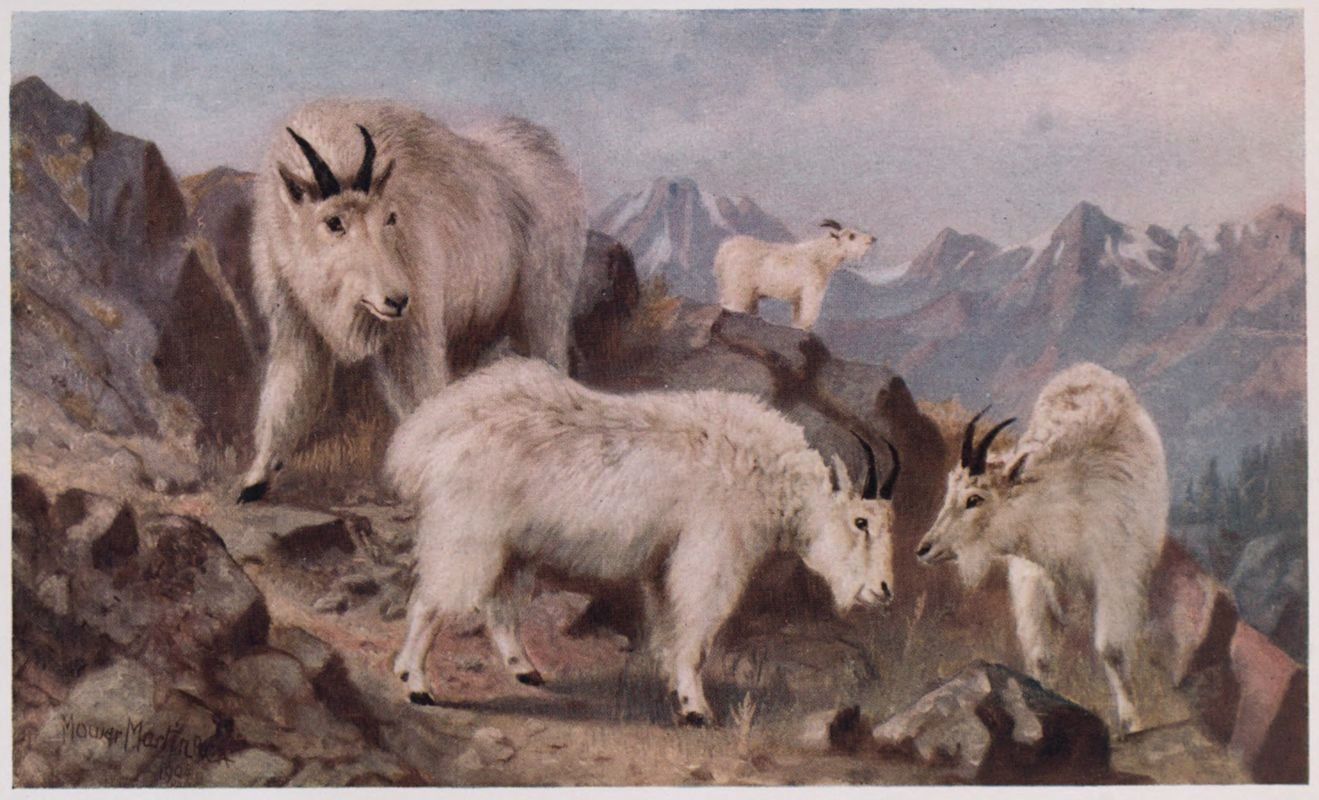
MOUNTAIN GOATS FEEDING
Our real material and moral welfare, our very future existence, depends, however, largely on the growth and development of our rural population. The great social danger of the near future will be owing to the overgrowth of the material industries. These are rapidly changing the whole order of the social conditions, and deteriorating mankind into but two classes, the merely rich and the poor. This condition threatens, at no distant date, to destroy the whole fabric of society. The only final cure for all this is to get as many of the people as possible on to the land. Every man on his own soil, self-supporting and independent, is the centre of a little social organisation which is self-ruling. Every man removed from the land, and enticed or forced into the city or manufacturing centre, is a pillar torn from the roof-support of the social temple.
The nation of the future, which will rule the world, will be that one which lays most stress on her rural population and her rural wealth; she will be the one in which the great mass of the people till the land. Commerce is all right in its place; but it must be kept in its place. Mining as an industry may be a great asset in the wealth of a country; but it does not make for the best citizenship in either workman or owner. What makes for the highest, healthiest type of manhood and womanhood, is the proper industry for a nation to engage in. My hope for my country is, that she will turn all her energies in the direction of the cultivation of the soil, and that she will become a country of orchards and vineyards and wheat-fields and meadows, and a vast pasture for the herds of the earth. The independent owner and tiller of the soil is the bulwark of the nation, and it is this bulwark that we need in Canada. It is true that in all ages a country is chiefly known through her great cities; but there can never be really great cities unless there is a corresponding rural population.
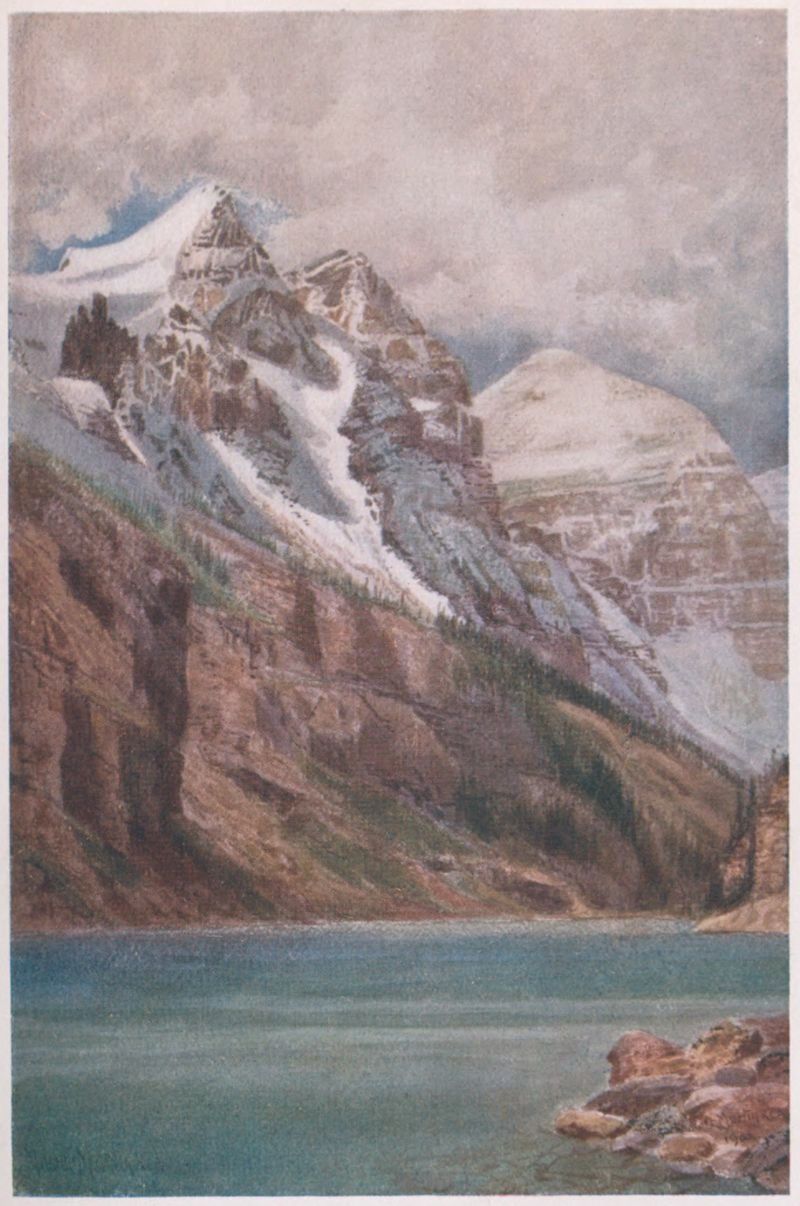
END OF LAKE LOUISE, AND MOUNT ABERDEEN
THE MARITIME PROVINCES AND THE EARLY DISCOVERERS
The New World is not, like the Old, a network of historic highways; but, recently as its history of discovery dates, its shores and waters are not barren of heroic adventure, incident, and legendary charm.
Who has entered for the first time the noble Gulf of St Lawrence, and sailed inward up that vast river, with its wild and forbidding or elusive and mountainous shore-line, without feeling deeply the part it has played in the history of our race and the world?
Here came the first discoverers, from battle-worn, commerce-burdened Europe; seeking, by a sort of divine instinct, new dreams of human ideal and human effort in a virgin world. Or perchance, as some thought, they imagined they were reaching the farther shores of distant Ind or Cathay.
Whatever their dreams and knowledge, whatever their limitations, they were animated by a great spirit, alike of impulse and faith, which drew them past the superstitious fear and narrow conventions of their day to the truth and actuality which lay beyond. Those great spirits
“Feared no unknown, saw no horizon dark,
Counted no dangers; dreamed all seas their road
To possible futures; struck no craven sail
For sloth or indolent cowardice; steered their keels
O’er crests of heaving ocean, leagues of brine;
While Hope firm kept the tiller; Faith in dreams
Saw coasts of gleaming continents looming large,
Beyond the ultimate of the sea’s far rim.”
Whatever may have been their special human frailty, these early discoverers were of no mean stock, of no empty courage, but were of the best influence which animated their people and their time.
“Souls too great for sloth
And impotent ease, goaded by inward pain
Of some divine, great yearning restlessness;
Which would not sit at home on servile shores,
And take the good their fathers wrought in days
Long ancient timeward; reap what others sowed:
But nobler sought to win a world their own,
Where men might build the future: rear new realms
Of human effort, forgetful of the past,
And all its ill and failure: knowing only
Immortal possibility of man.”
Stripped of all its cruel, superstitious, greedy, and adventurous cloak, this was the inward spirit of early discovery at its best.
Each age is dominated by some great dream which seizes its best mind and energy. Philosophy, art, religion, science, literature, commerce, and war have each had their age. That of Columbus, Galileo, Raleigh and Gilbert, of Cabot and La Salle, was the age of human discovery.
It was not only an adventurous and restless period, but it was of a certainty a heroic one. Let those who doubt this, voyage out on the broad Atlantic, starting from Liverpool or Southampton, in one of the great ocean-liners of to-day—vast in the dock, but how incomparably small in contrast with the vastness of ocean!—and let them imagine the small, high-pooped sailing vessel which essayed this voyage for the first time, adventuring out into the unknown and far from kindly Atlantic; and they will realise the desperate undertaking of our first Canadian discoverers.
South of the noble gateway to the eastern interior of Canada, the famed St Lawrence, there lies a group of provinces of the Dominion, small in comparison with the western areas, but important as the first to be discovered, and by reason of their heroic history from that day to this. These provinces are Nova Scotia, New Brunswick, and the small island called Prince Edward. These were settled by the Scottish, Acadian French, and United Empire Loyalist stock; and while they are now a small proportion of the Dominion, yet they represent in their people the three dominant elements which have gone to make up the Canada of to-day.
This is a region of much sea-line, of bold, rugged shores, noble mountains, and vast sea-marshes. It is a region teeming with history and legend. Out of its confines came the beautiful story of Evangeline, the romance and tragedy of La Tour and De Monts, and the splendid failure of the Scotsman Alexander.
It has later been the theatre of the more practical, if less romantic, successes of the modern Scot and United Empire Loyalist; and is to-day most favourably known because of its mines, fisheries, harbours, its orchards, and the Canadian statesmen and thinkers which it has produced.
On a neck of land connecting New Brunswick and Nova Scotia, and on the south side of this isthmus, are the famed marshes of Tantramar, one of the great sights of Canada, and a noted haunt for sportsmen. Here the Bay of Fundy, where the tides rise higher and fall lower than anywhere else in the world, washes for miles a vast marsh-land, which at low water is an immense gleaming beach, and at high water an inland sea.
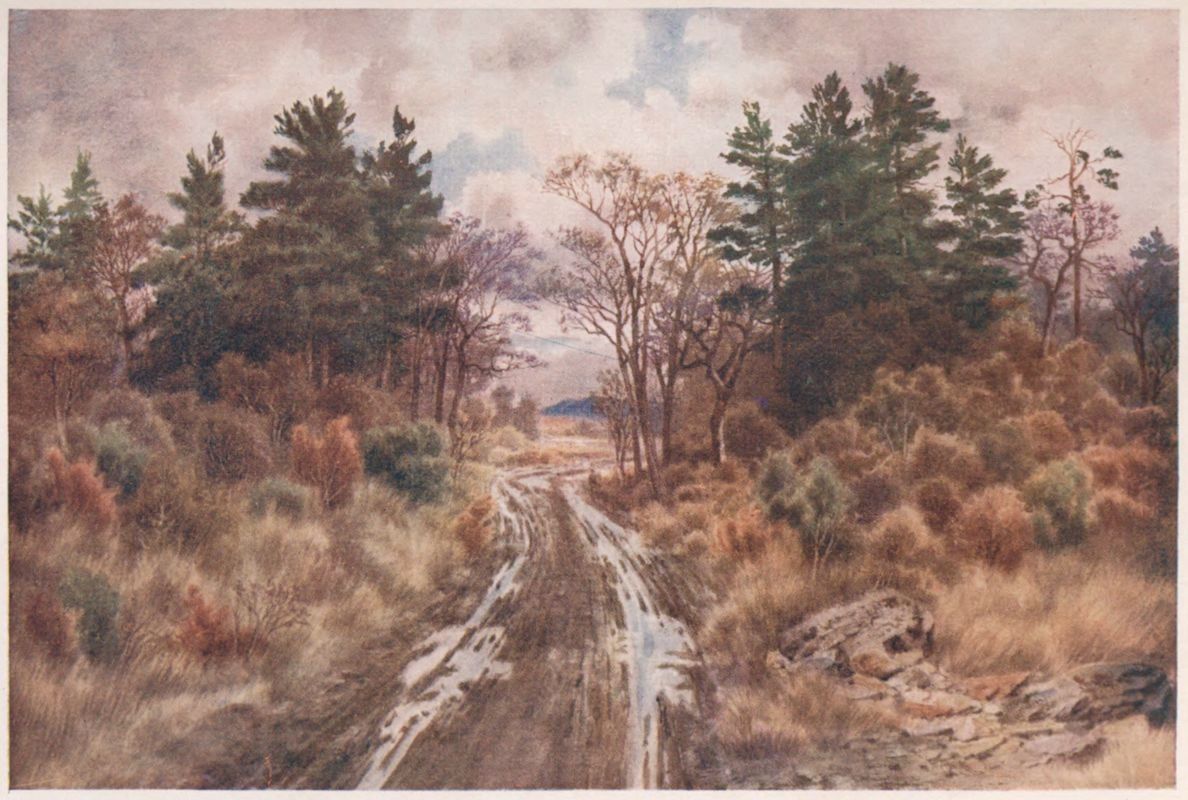
ROAD NEAR THE BAY OF FUNDY, AUTUMN
It is, next to the shores of the great inland lakes, one of the most lonesome places in the whole world; and the very sea-wind, on a summer day, is full of a desolation quite Celtic in its suggestion. Here the soul may loiter at high tide, and listen, while far out and away from
“The roar of cities and the haste of men,
Tumultuous Fundy thunders through his haze
A grief more sad than woe of poet’s pen,
And wakes the sea-wolf in his craggy den,
And lifts his mists, and brims his tides afar,
To lave the shining wastes of haunted Tantramar.”
The north-east point of Nova Scotia is the island of Cape Breton, with its Bras d’Or Lake, an arm of the sea, its new Campbelton, Sydney, and the famed Louisburg.
Here, it is said, first came Eric the Red and his fellow-Norsemen, discovering Markland and perchance Vinland or Vineland; and here, perchance, also, the hero of Longfellow’s Skeleton in Armour may have first sighted land.
“Three weeks we westward bore,
And when the storm was o’er,
Cloud-like we saw the shore,
Stretching to leeward.”
Here it was that the great Cabot first came, as the discoverer of the American mainland, and touched at this eastward cape after weeks of drifting and tacking; and fear and doubt on the part of his followers. But genius is self-centred and self-sustaining. It leans only on Deity and its own indomitable spirit of resolution; and, like the fabled heroes of olden story, he was compelled to sail on, led by an impulse stronger than human fear and human doubt.
“Over the hazy distance,
Beyond the sunset’s rim,
For ever and for ever
Those voices called to him.
Westward! westward! westward!
The sea sang in his head,
At morn in the busy harbour,
At nightfall on his bed.
Westward! westward! westward!
Over the line of breakers,
Out of the distance dim,
For ever the foam-white fingers
Beckoning, beckoning him.”
It was the eternal call of the sea to the restless son of old Ocean; and here he came, after a long travail by storm and calm, and was the first man in history to land on these shores.
Here, after him, and later, came the Breton and Basque merchants and adventurers, De Monts and his associates, founding Port Royal and that Acadia so famed in song and story. Legend, however, has it that, centuries before this, Europe had knowledge of these coasts.
Here later adventured Sir William Alexander, a Scottish poet, who was granted by the British monarch a nobility greater than many a kingdom, and who founded a lesser peerage, extant to this day, and known as the baronetage of Nova Scotia. Thus Scotland had her part in, and gave her name to, this romantic and remote region.
The story of the discovery of Nova Scotia, or New Scotland, by the two Cabots is an interesting one. John Cabot, a Venetian merchant settled in England, by means of his adventurous spirit obtained favour with King Henry VII.; and, ambitious of doing for England what Columbus had done for Spain, Henry granted to him and to his sons a patent to sail under the flag of England on an adventure of discovery of new lands.
Cabot, his son Sebastian, and a crew of eighteen men sailed from Bristol and beat west for fifty days, sighting land on St John’s Day, the 24th of June 1497. This land was the northern shore of Cape Breton. Here Cabot erected a large cross with the standards of England and Venice, and called the land Prima Terra Vista. Cabot was thus the pioneer of English discovery and colonisation in Canada, and the first known founder of the Maritime Provinces.
Britain having shown the way, Portugal and France sent out discoverers, and the greatest of these was Cartier, who discovered the St Lawrence and claimed Canada for the French in 1534.
That gifted Celtic-Canadian statesman and poet, D’Arcy M‘Gee, has fittingly told in heroic verse of the departure of Cartier from St Malo:
“In the seaport of St Malo ’twas a smiling morn in May
When the Commodore Jacques Cartier to the westward sailed away.
In the crowded old cathedral all the town were on their knees,
For the safe return of kinsmen from the undiscovered seas
And every autumn blast that swept o’er pinnacle and pier
Filled manly hearts with sorrow and gentle hearts with fear.
. . . . . . .
But the earth is as the future; it hath its hidden side,
And the captain of St Malo was rejoicing in his pride.
In the forests of the north, while his townsmen mourned his loss,
He was rearing on Mount Royal the fleur-de-lis and cross.“
Then the spirited ballad describes his return, and his pictures of the wonders of the new world; as, for instance, when
“He told them of the river whose mighty current gave
Its freshness for a hundred leagues to ocean’s briny wave.”
While this great adventurer is chiefly famous as the discoverer of the St Lawrence and Quebec, he came at first to Acadia, and in 1541 fortified Cape Breton.
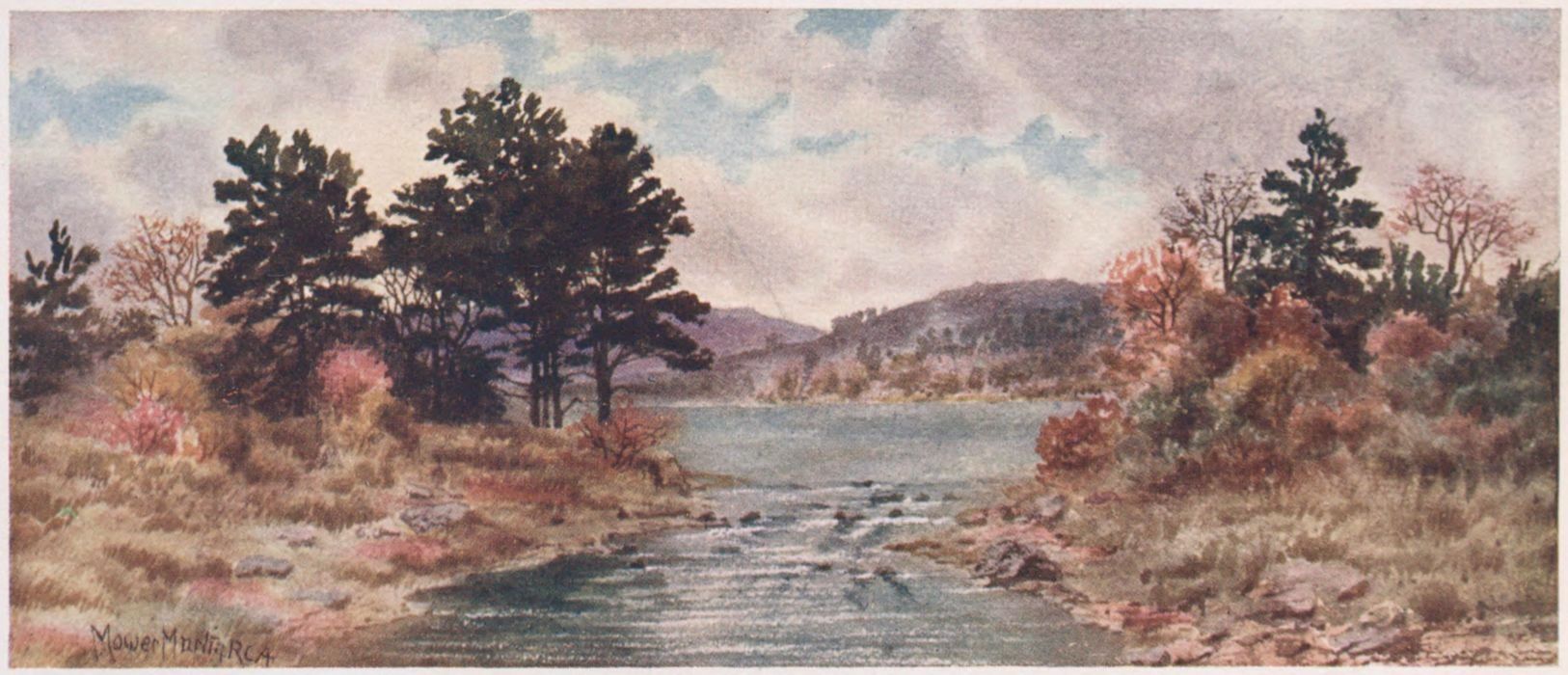
FALL OF THE YEAR, NOVA SCOTIA
The next explorer to arrive was Jean François de la Roque, seigneur de Roberval, appointed by the king of France to be lieutenant of Canada and the lands adjacent.
We next come to the period of Queen Elizabeth, and the hero, Sir Humphrey Gilbert, a man of great physical stature and prowess, and noted as a scholar and a patriot. He set sail in 1583 with four vessels, carrying two hundred and fifty emigrants, the first emigration expedition from Britain to Canada. Arriving at Newfoundland, he took possession in the name of the virgin queen. But his emigrants proved a sad failure, by reason of their discontent and lawlessness; and it is said that the governor found it necessary to crop the ears of the unruly in order to maintain his authority. There is no doubt that, in all early colonies, the failure was owing to the desperate character of the colonists, who were for the most part restless malcontents who could not be satisfied at home or anywhere else, and who mistook licence for freedom.
Sir Humphrey, having raised a pillar carrying the royal arms of England, sailed in his ship, the Squirrel, a vessel of only ten tons burden—remarkably small in comparison with the Allan liner, the Virginian, of twelve thousand tons burden—and was swamped in a great storm.
The historical account says:—
“When the wind had abated and the vessels were near enough, the Admiral was seen, constantly seated in the stern, with a book in his hand. On the 9th of September he was heard by the people of the Hind to say: ‘We are as near heaven by sea as by land.’ In the following night the lights of the ship suddenly disappeared. Nothing more was seen or heard of the great Admiral.”
Longfellow has the following beautiful picture of his heroic death:—
“Eastward from Campobello
Sir Humphrey Gilbert sailed.
Three days or more, seaward he bore,
Then, alas, the land wind failed.
Alas, the land wind failed,
And ice-cold grew the night,
And never more on sea or shore
Should Sir Humphrey see the light.”
And so ended disastrously the first practical attempt at British colonisation of the new world.
Another picturesque attempt at the colonisation of Acadia was that of Sable Island. Henry IV. of France was a great patron of maritime adventure and enterprise, and he sent the Marquis de la Roche as lieutenant of Acadia, who took out a cargo of convicts and left them on that barren spot where nothing grew. Here they lingered in great misery for seven years, subsisting on seals and other fish, until only twelve remained to return to France, where they were pardoned by the king, who was astonished at their long beards and sealskin garments, and ordered them to be paid a gratuity of fifty crowns each.
Here in turn came Frank and Scot, each setting foot, and each in turn being ousted by his rival. The most famous theatre of this struggle for race dominance was the beautiful and now historical Annapolis Valley. Seen in fine weather, it is one of the fairest regions in all the world. It is now a country of mountain and valley dotted over with beautiful farms and famous orchards. Poutrincourt and his adventurers found it as pleasing in their day, when sailing along the south coast of Fundy, called by them La Baye François, they discovered what is now the Gut of Digby, and, steering in, found the splendid basin surrounded by hills and valleys, and streams of fresh water that ran down to the level wooded lands that rimmed the shore.
Here, in this newer Eden, he founded the famous Port Royal, amid its grassy meadows, its numerous streams, its cascades tumbling from the hills, and its forest-clad mountains.
But this beautiful spot was not long destined to remain French. Soon it was to be the stronghold of an organisation of Scottish baronets headed by the noted Sir William Alexander, who was created Earl of Stirling and Viscount Canada; and long after the place was called Annapolis in honour of Queen Anne.
It is not the province of this work to go into the details of history, but the present result of all this adventure and struggle is shown in a people largely Scottish and United Empire Loyalist, with a few settlements of the original Acadian French still remaining.
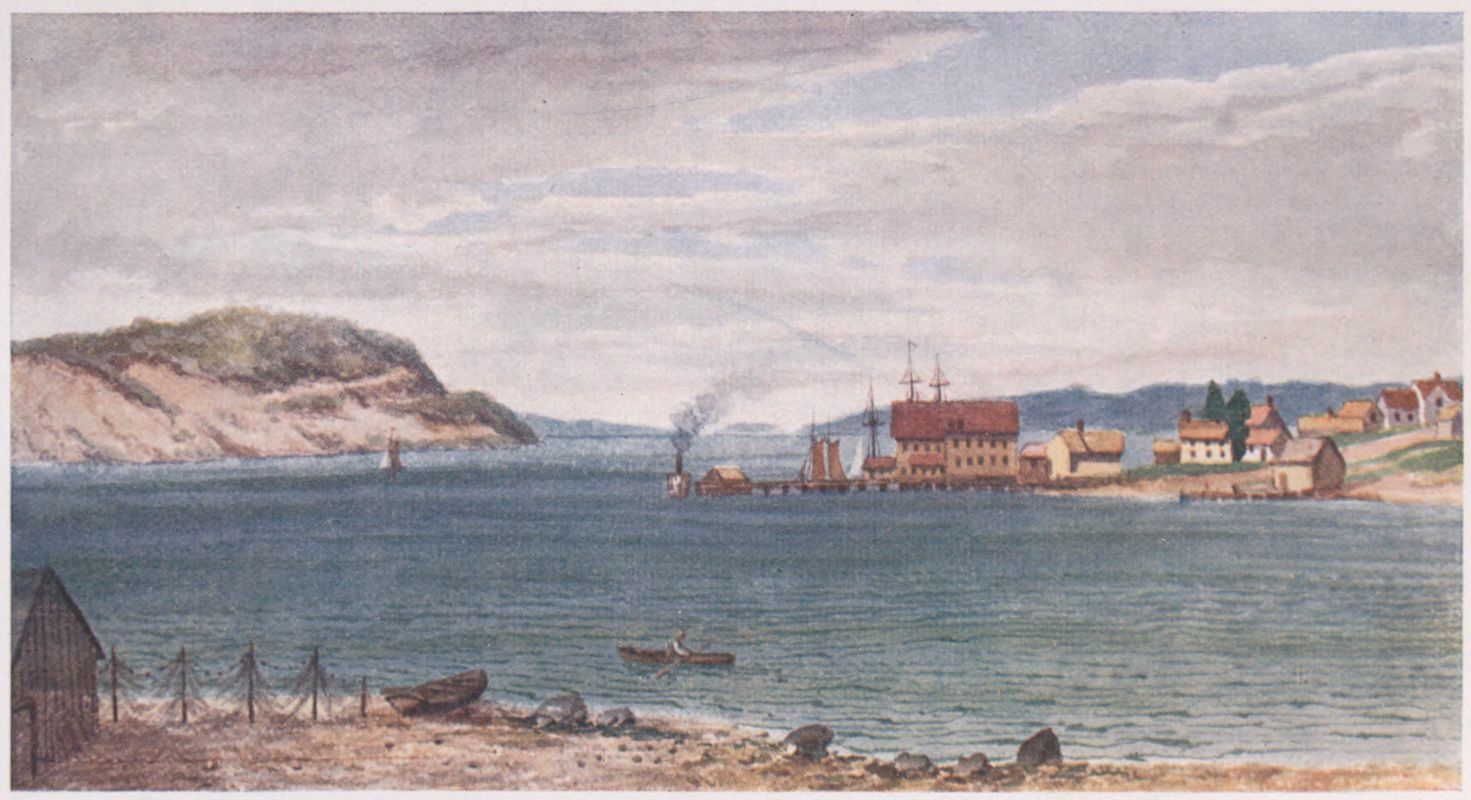
PORT HAWKESBURY, ON THE STRAIT OF CANSO, CAPE BRETON
The Nova Scotian is a Canadian, but he is also a type by himself, by reason of his parent stock, his experience, and his peculiar environment. The Acadian people are much as they were in the days of the tragedy of Evangeline. They are a simple, primitive folk of the old-time Breton type, living largely to themselves, and apart from the progress and strenuous effort around them.
The quaint and romantic village of Grand Pré is their most representative locality, and the one chiefly associated with their dispersion by Lawrence. The visitor to their villages and farm-lands will find very little difference in their character and manner of life from that depicted in Longfellow’s beautiful Evangeline.
“In the Acadian land on the shores of the basin of Minas,
Distant, secluded, still, the little village of Grand Pré
Lay in the fruitful valley. Vast meadows stretched to the eastward,
Giving the village its name, and pasture to flocks without number.
Dykes, that the hands of the farmer had raised with labour incessant,
Shut out the turbulent tides; but at stated seasons the floodgates
Opened, and welcomed the sea to wander at will o’er the meadows.”
“Away to the northward,
Blomidon rose, and the forests of old, and aloft on the mountains
Sea-fogs pitched their tents.”
Now, as then, will be found the conditions of this happy, contented, quaintly religious people, living apart in their own manner, away from the strenuous, restless, more masterful people about them.
It is not to be supposed that they have not changed somewhat, where change is eternal in all peoples.
The region first called Acadia, or, according to the Indians of Champlain’s time, “the place of plenty,” abounding in fish, moose, caribou, partridge, and many fur-bearing animals, and afterwards called Nova Scotia, was finally divided into three provinces. During the latter part of the eighteenth century, settlements of Scots from the old world located themselves on different parts of the coast.
These were followed by a great influx of loyalists who came from the south at the time of the American Revolution. The chief settlements were at Halifax and St John; but others were scattered throughout the country.
These new-comers, while they helped to save the country for Britain, brought with them just a touch of the Yankee atmosphere, which permeates the country to this day. Upper Canada, now Ontario, had a similar invasion; but the element from the old country was stronger than that in the Maritime Provinces, so that there is a difference in the characteristics of the two peoples. In Ontario, it cannot be said that the United Empire Loyalist dominated as he did in Nova Scotia and New Brunswick.
The result has been that the ruling class in the Maritime Provinces, when not Scotch, has been largely U.E. Loyalist; whereas in Ontario this element has not forced itself to the front to the same extent. Such names as Howe, Wilmot, Tupper, and Borden give a slight idea of the many U.E. Loyalist families which have produced men of prominence.
The Maritime Province men as a class are more akin to the New Englander in their characteristics. They are simpler in their lives than the people of the other provinces, and take an unusual part in the public life of the Dominion. They are intellectual and energetic quite to the extent of restlessness. They have all the strong qualities and weaknesses of maritime folk. They know more of the world than do inland people. But they are unsettled and ambitious, and the young men rarely stay at home. The result has been that some of the ablest Nova Scotians dwell in Boston and other American cities.
Maritime Canada has suffered much from this drain of her best blood, but some day the reaction will come and the tide turn the other way. Meanwhile this close intercourse with the land to the south has been not altogether for the good of our people in that part of Canada.
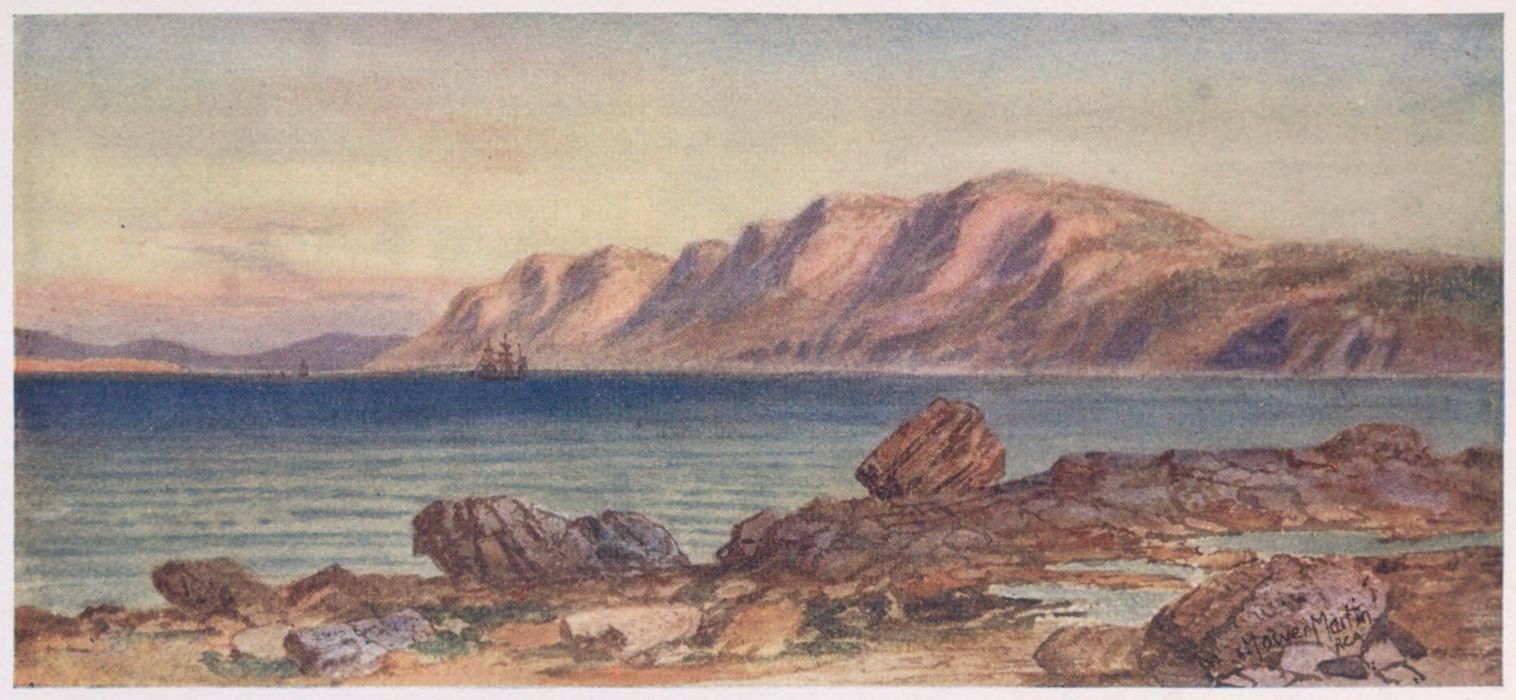
CAPE PORCUPINE, GUT OF CANSO, CAPE BRETON
THE MARITIME PROVINCES—LATER HISTORY AND CHARACTERISTICS
In spite, however, of this constant drain, the Maritime Provinces have produced some of the most distinguished Canadians. In public life to-day we have such able administrators as the Honourable W. S. Fielding, next to Sir Wilfred Laurier the most prominent man in the Canadian Cabinet; the Honourable R. L. Borden, the brilliant leader of the opposition; and the names of Sir Charles Tupper, Sir Leonard Tilley, the Honourable Andrew Blair, the Honourable George E. Foster, Dr Weldon, and a host of other men, prominent in public life, witness the political activities of these provinces. In other walks of life, Archbishop Connolly, the greatest ecclesiastic that English-speaking Catholic Canada has produced, and one of the great men of the early days of Maritime Canadian history; Principal Grant; and Bishop Medley (Anglican), of New Brunswick, stand first in the religious world; though Bishop Inglis (Anglican) and Archbishop O’Brien (Roman) were distinguished men.
In education, Grant and Dawson are prominent names in the Dominion.
Joseph Howe and Thomas Haliburton (“Sam Slick”) were Nova Scotia’s greatest sons. Howe and D’Arcy M‘Gee were the two greatest Canadian orators. Howe was a printer who wrote poetry and was inspired by an ardent desire to liberate his province from the trammels of bureaucracy, and after years of struggle he succeeded. He had the faults common to all great orators and public men who win much popularity; but he never became a mere demagogue. His oratory was irresistible. He could rise to the highest flights, and tell the drollest stories; and his magnetic personality, coupled with his high ideals, made him the idol of his people, though for many years he seemed to fight a losing battle. He was a strong Imperialist, as was Haliburton; but he stood out for a long time against the bringing of Nova Scotia into the federation. He was afraid that his province would be swamped in the union, and to a certain extent he was right.
But the union had to come; and in time Howe himself accepted office under Sir John A. MacDonald at Ottawa. But Howe never felt exactly right about it; and it is said that once MacDonald and Howe were walking together in the streets of Ottawa, down near the Chaudière, when the former exclaimed: “Well, Howe, I have got you here at last.”
“Yes,” answered Howe moodily, “but with the halter about my neck.”
Howe was not a great poet, but he had a fine literary instinct, and his influence in that direction was very strong. He was a delightful lecturer, and an address which he delivered on Shakespeare, at Halifax, on the occasion of the three hundredth anniversary of the great poet’s birth, was a brilliant and scholarly effort, and showed his unusual mind.
The other great Nova Scotian was Thomas Haliburton, who was of Scottish descent, and who became famous under the pen-name of “Sam Slick.” He has been acknowledged as the father of American humour, and was the first of that remarkable school whose ranks contain Artemus Ward and Mark Twain.
Haliburton was not merely a wit; like Howe, he was a far-seeing philosopher, and much that he predicted regarding Canada has come to pass. He foresaw, not only confederation, but also, as Howe did, Imperial federation, and was the first Canadian to win a seat in the British House of Commons.
His satire on the Yankee character of the day was inimitable, and made him noted on both sides of the Atlantic. Dickens never depicted a character more truly and successfully than Haliburton has the hypocritical cheat of his day, in the following terse dialogue:—
“Sam, have you watered the spirits?”
“Yes, sir.”
“Have you sanded the sugar?”
“Yes, sir.”
“Then come up to prayers.”
He immortalised the Yankee horse-trader and general pedlar, who, no doubt, in ante-protection days, flooded Maritime Canada with his spurious wares, such as wooden nutmegs and paralytic clocks, and took away good Canadian horses in exchange. But Haliburton struck a specially hard blow at the religious hypocrisy and social vulgarity which were then rampant; and he possessed a human touch and a sense of humour that made his work not only popular, but a strong influence for good, in a way which has only been equalled by Lowell’s Bigelow Papers.
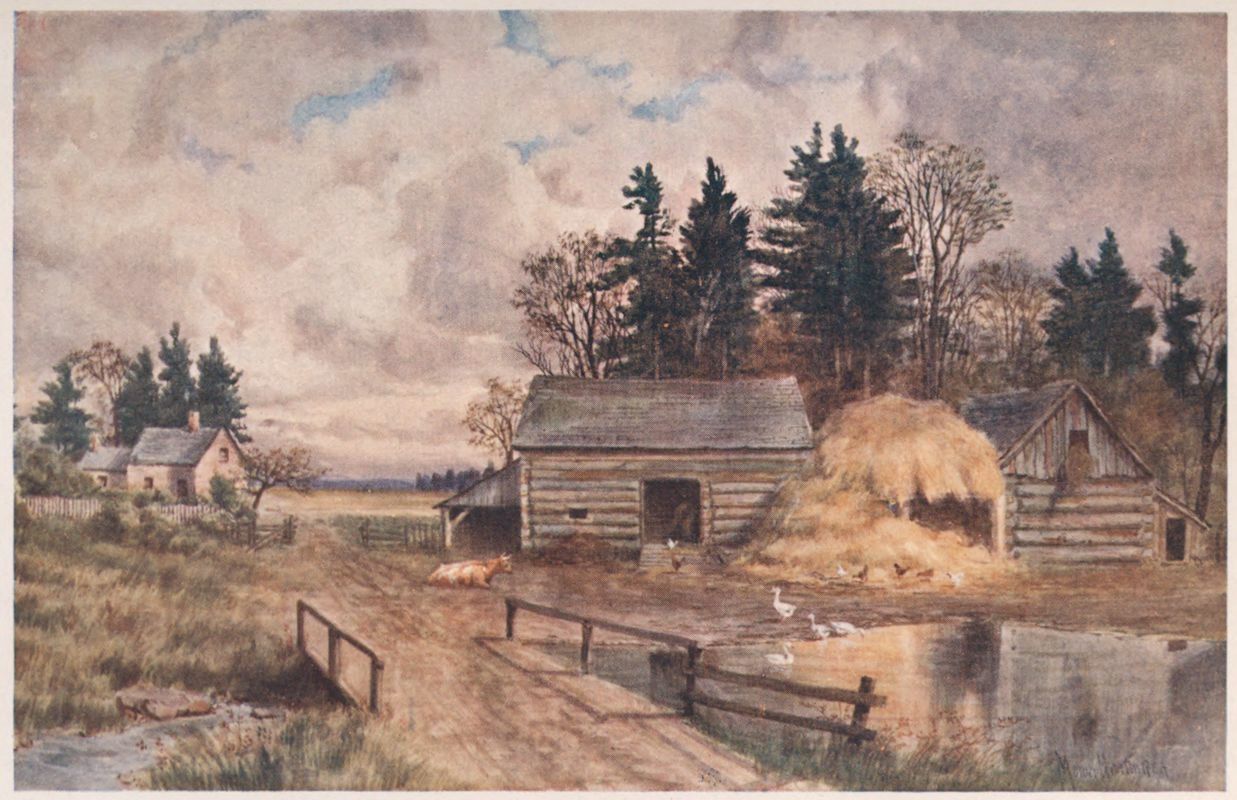
OLD-FASHIONED FARM, NEW BRUNSWICK
The leader in public affairs in New Brunswick who came nearest to Howe in character and ability was Lemuel Wilmot, who was as noted for his persuasive oratory as for his desire for constitutional government. It is to be wondered what such men as Howe and Wilmot would think were they to see the present condition in Canada, where the franchise, which they struggled so nobly to obtain, is bartered, trampled under, or ignored by the people, who seem to value little the gift presented to them by former generations.
There is no doubt that these able and conscientious patriots of the past would recognise, what men of sense and thought are beginning to realise, that the franchise has been given to too many; and that society is getting into the hands of a mob of reckless or conscienceless irresponsibles, who deal in votes as a purchasable commodity. What a contrast there is between the efforts of such great men as those were, and the people of the present, who ruthlessly waste and destroy what those noble Canadians won for us as a lasting heritage of freedom!
Howe and Haliburton were like their own coast and sea-line. They were large and noble; they were men of ideal and action; they towered like Blomidon; they lashed the coasts of human tyranny and helotism as Atlantic smites his rocky shores.
The tendency to-day in this country to live too much in and for the present, receives a constant rebuke in the verse and speeches of Joseph Howe. Many of this generation, who claim to have made Canada, and are inclined to cast a slur on the past, or to forget its deeds, need to imbibe somewhat of the spirit and principles of the following poem from the pen of this great Nova Scotian. It is entitled:—
OUR FATHERS
“Room for the dead! Your living hands may pile
Treasures of art the stately tents within,
Beauty may grace them with her richest smile,
And genius there spontaneous plaudits win:—
But yet amidst the tumult and the din
Of gathering thousands, let me audience crave!
Place claim I for the Dead—’twere mortal sin,
When banners o’er our country’s treasures wave,
Unmarked to leave the wealth safe garnered in the grave.
The fields may furnish forth their lowing kine,
The forest spoils in rich abundance lie,
The mellow fruitage of the clustered vine
Mingle with flowers of every varied dye;
Swart artisans their rival skill may try,
And while the rhetorician wins the ear,
The pencil’s graceful shadows charm the eye;
But yet, do not withhold the grateful tear
For those, and for their works, who are not here.
Not here? O yes! our hearts their presence feel,
Viewless, not voiceless; from the deepest shells
On memory’s shore harmonious echoes steal,
And names which in the days gone by were spells
Are blent with that soft music. If there dwells
The spirit here our country’s fame to spread,
While every breast with joy and triumph swells,
And earth reverberates to our measured tread,
Banner and wreath will own our reverence for the Dead.
Look up: their walls enclose us. Look around:
Who won the verdant meadows from the sea?
Whose sturdy hands the noble highways wound
Through forest dense, o’er mountain, moor, and lea?
Who spanned the streams? tell me whose work they be,
The busy marts where commerce ebbs and flows?
Who quelled the savage? and who spared the tree
That pleasant shelter o’er the pathway throws?
Who made the land they loved to blossom as the rose?
Who, in frail barques, the ocean surge defied,
And trained the race that live upon the wave?
What shore so distant where they have not died?
In every sea they found a watery grave.
Honour for ever to the true and brave,
Who seaward led their sons with spirits high,
Bearing the red-cross flag their fathers gave;
Long as the billows flout the arching sky,
They’ll seaward bear it still—to venture or to die.
The Roman gathered in a stately urn
The dust he honoured—while the sacred fire,
Nourished by vestal hands, was made to burn
From age to age. If fitly you’d aspire,
Honour the Dead; and let the sounding lyre
Recount their virtues in your festal hour;
Gather their ashes—higher still, and higher,
Nourish the patriot flame that history dowers,
And, o’er the old men’s graves, go strew your choicest flowers.”
Canada may be noted in the present for her vast natural scenery and her store of natural products; she may be famed in the future for prosperity, intellectual and material; but she will never produce a gem of humanity or nature more precious than the memory of this great Canadian. The times have changed. We are producing a more concentrated if less inspired quality of verse, and a keener and more expert class of men. But in both our literature and our personality we miss that large humanity, that love of truth and genuine liberty, which inspired our patriots and our poetry of the past.
We have been told that life is growing broader in its outlook and sympathies. But in truth it is becoming narrower and harder; and we are in great danger of being ground down by a tyranny of materialism and greed, which has absorbed our lives. Men seem of late to have lost much of that old spirit of independence and love of righteousness which once dominated our literature and life, and made such men as Howe, Haliburton, and M‘Gee possible. To-day we are told that business methods have superseded the old-time rhetoric, and that the cool head has taken the place of the warm heart. But what has been the result of this reign of business and keen financial enterprise? We read it in every election-trial, and we see it in the general deterioration of the life about us.
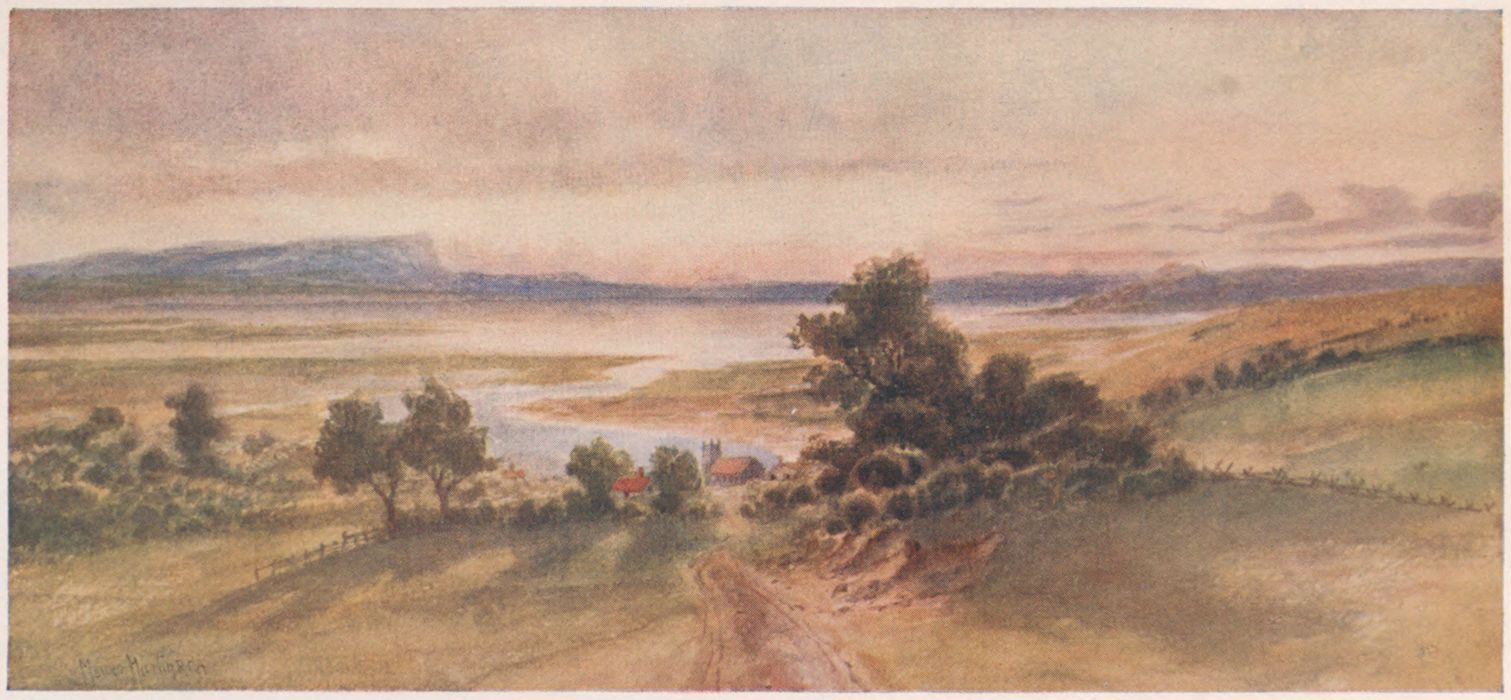
BASIN OF MINAS, NOVA SCOTIA
What Canada needs to-day is a return to the conditions which produced such men, who brought high ideals, humanity, and culture into the everyday political life, and appealed to the highest sense of the people rather than to the lowest and meanest.
In this description of Nova Scotia I do not want to appear to lay too much stress, without reason, upon one man. But as Scotland had her Burns, so Nova Scotia had her Howe; and it might be answered of the latter in his own language applied to Burns, in reply to his question why the Scottish poet’s memory had been so universally honoured:—
“It was because, long after he was dead and his faults and follies were forgotten, it was discovered that in this man’s soul there had been genuine inspiration—that he was a patriot, an artist—that by his genius and independent spirit he had given dignity to the pursuits by which the mass of mankind live, and quickened our love of nature by exquisite delineation. It was found that hypocrisy stood rebuked in presence of his broad humour.”
But Howe’s genius lay not alone in his oratory, culture, and humanity. He was a prophetic man, who saw beyond his time, and foresaw not only Imperial federation, but the ultimate union of the British race. This man, the very finest essence of the Nova Scotian, the pride and glory of the province by the sea, was no mere narrow Canadian, no separatist. On the other hand, he saw clearly the ultimate destiny of the Empire and the race. While he loved his native province, no one was a more patriotic Briton than he, who loved and honoured her history, her achievements, and who closed his fine address on Shakespeare with the following picture of Britain’s accomplishment and British conditions:—
“If it be permitted to the Bard of Avon to look down upon the earth this day, he will see his ‘sea-walled garden’ not only secure from intrusion, but every foot of it embellished with all that wealth can accumulate or art display. But he will see more—he will see her ‘happy breed of men’ covering the seas and planting the universe; rearing free communities in every quarter of the globe; creating a literature that every year enriches; and moulding her institutions to the easy government of countless millions, by the light of large experience. He will see more. He will see the three kingdoms, hostile or disjointed at his death, united by mutual interests, and forming together a great centre of power and dominion, bound in mutual harmony and dependence by networks of iron roads and telegraphic communication, and by lines of floating palaces connecting them with every part of the world.”
Nova Scotia proper is connected with the body of North America by a narrow isthmus, and contains nearly ten million acres of land. The surface of the country is undulating in hills, small mountain ranges, and agreeable valleys. Its sea-coast is inhospitable, and presents a bold, rocky shore and a sterile soil covered with birch and fir trees. The most noted cliff is Aspotagoes, a promontory near St Margaret’s Bay. It is a vast bastion over five hundred feet high, and is the first land discerned, approaching Halifax from Europe. Cape Blomidon, which juts on the Bay of Fundy, rises a dark red basaltic rock, and is an imposing and majestic sight.
In Nova Scotia, as in other parts of Canada, the autumn foliage is very brilliant when the leaves change under the quick action of the frost. Much of the province, however, is bleak and barren, owing to the vast amount of rock and the immense sea-coast line exposed to the fierce bitterness of the northern Atlantic.
The city of Halifax, the capital of Nova Scotia, was founded by the Honourable Edward Cornwallis, who sailed from Britain, and arrived on the 21st of June 1749 with 2576 emigrants. He had thirteen transports, guarded by one warship, the Sphinx. Up the harbour they went, with flags flying and sails unfurled—a wonder to the simple aborigines, who floated about them at a safe distance in their bark canoes.
It was the colony of Massachusetts, then belonging to Britain, which had interested herself in this northern peninsula. A scheme for colonisation was adopted, and the king’s commission was granted to Lord Halifax, Minister of Trade and Plantations, who took a personal interest in the work. The war with France had just closed, and the disbanded soldiers were selected as colonists, while Parliament voted forty thousand pounds. Five thousand emigrants were housed about the harbour during the first winter, and during that year St Paul’s Church and St Matthew’s meeting-house were erected. Fort George is on Citadel Hill, an eminence 256 feet above sea-level, and commands a superb view of the city, harbour, sea, and surrounding country.
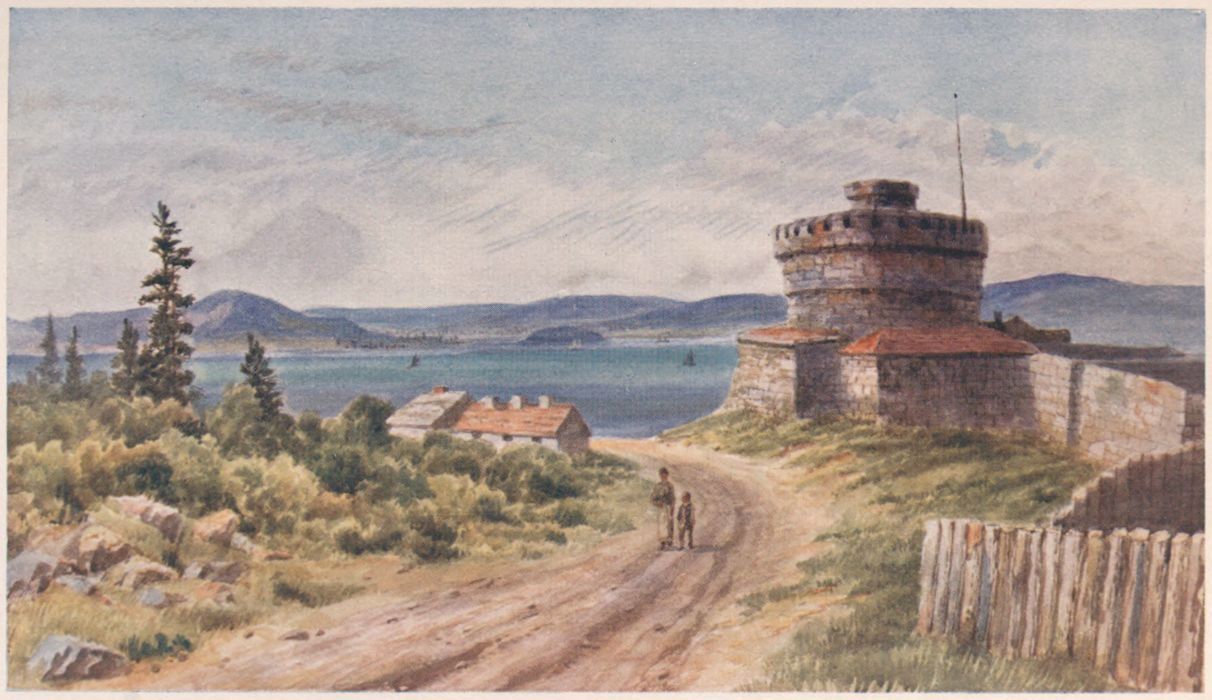
YORK REDOUBT, AND HALIFAX HARBOUR
The approach to Halifax by sea is very fine. Here is one of the finest harbours in the world. It is said that a thousand vessels may float there in safety. It is six miles long, and accessible at all times of the year.
Halifax is a fine maritime city, and was long the chief British citadel on the Atlantic, and also a naval station. The ships are now withdrawn, and the fort is manned by Canadian troops.
It is also the terminus of the intercolonial railway, and the winter seaport for Canadian Atlantic steamers. It is also famous for its fish market, which has, it is said, a more varied supply of fresh- and salt-water fish all the year round than any other market in America. Here also fleets are fitted out for the Labrador and Island fishing-banks, so well depicted by Kipling and the Canadian writer Norman Duncan.
Near here, at the head of the harbour, the late Duke of Kent, father of Queen Victoria, resided, when stationed in British North America. The quaint lodge where he lived, with the grounds about it, are still pointed out as an object of local interest.
From here one can go north-east to Antigonish on the gulf, and from thence, across the narrow strait, to the island of Cape Breton, where the Sydney iron-mines are as likely to make it famous in the future as the ancient fort of Louisburg made it noted in the past.
Going directly west from Antigonish, Stellarton, New Glasgow, and Pictou, in Pictou County, are reached. The two former are noted mining centres, and the latter, Pictou, is famous as being one of the principal Scottish settlements in this province. Here were born and reared many noted Scotch Canadians, prominent among them being that remarkable and distinguished man, Principal Grant, late head of Queen’s University, Kingston, and the man of all men most fitted to have written the biography of Joseph Howe.
Northward and westward from Pictou, the Northumberland Straits separate the mainland from the small island province, Prince Edward Island. This province is smaller in area than Cape Breton Island, and contains only three counties, Princes, Queens, and Kings. It has for its size an immense shore-line; and Charlottetown, its capital, is a quaint old town. Agriculture and fishing are its chief industries, the latter being the best in the Gulf of St Lawrence, the province being especially famous for its oysters.
Returning to Halifax, one can go by rail north to Truro, Amherst, and Moncton; and thence to Quebec province or to St John, New Brunswick.
Here, at the mouth of one of the Canadian rivers, St John, the prominent seaport, like Halifax, is situated on a hill overlooking the sea, but, unlike it, is a mercantile port alone. The city faces on the great Bay of Fundy, and is the second leading maritime port for ocean steamers.
Here a fort was built by the La Tours, and here Charles La Tour ruled feudally in the wilderness, and held the trade of New Brunswick and Maine in the hollow of his hand. It was here that, in bastioned security, he defied Charnissay and the French government; and it was here that his heroic wife later made the brave but futile stand, which ended in her death a short time afterwards.
The city of St John was founded by the loyalists who left New England and landed here in 1783. The same year New Brunswick was created into a separate province. This city was formerly a great shipbuilding port, and was several times destroyed by fire.
The valley of the St John was once a great lumber centre, and is now one of the most beautiful farming regions in America. Going by boat or by railway along its western bank, Fredericton, the capital, a flourishing city in a fine agricultural country, is reached. The mouth of the St Croix, which forms the boundary between New Brunswick and the United States, is also a beautiful region. Here are the harbour and town of St Andrews, a delightful summer resort; and by boat can be reached the picturesque and desolate island of Grand Manan, out in the Bay of Fundy.
The people of this district are largely influenced by their cousins over the border; but some of the most strenuous and active men in Canadian public life have come from this province, among them being two prominent finance ministers and other important ministers of the Dominion Cabinet.
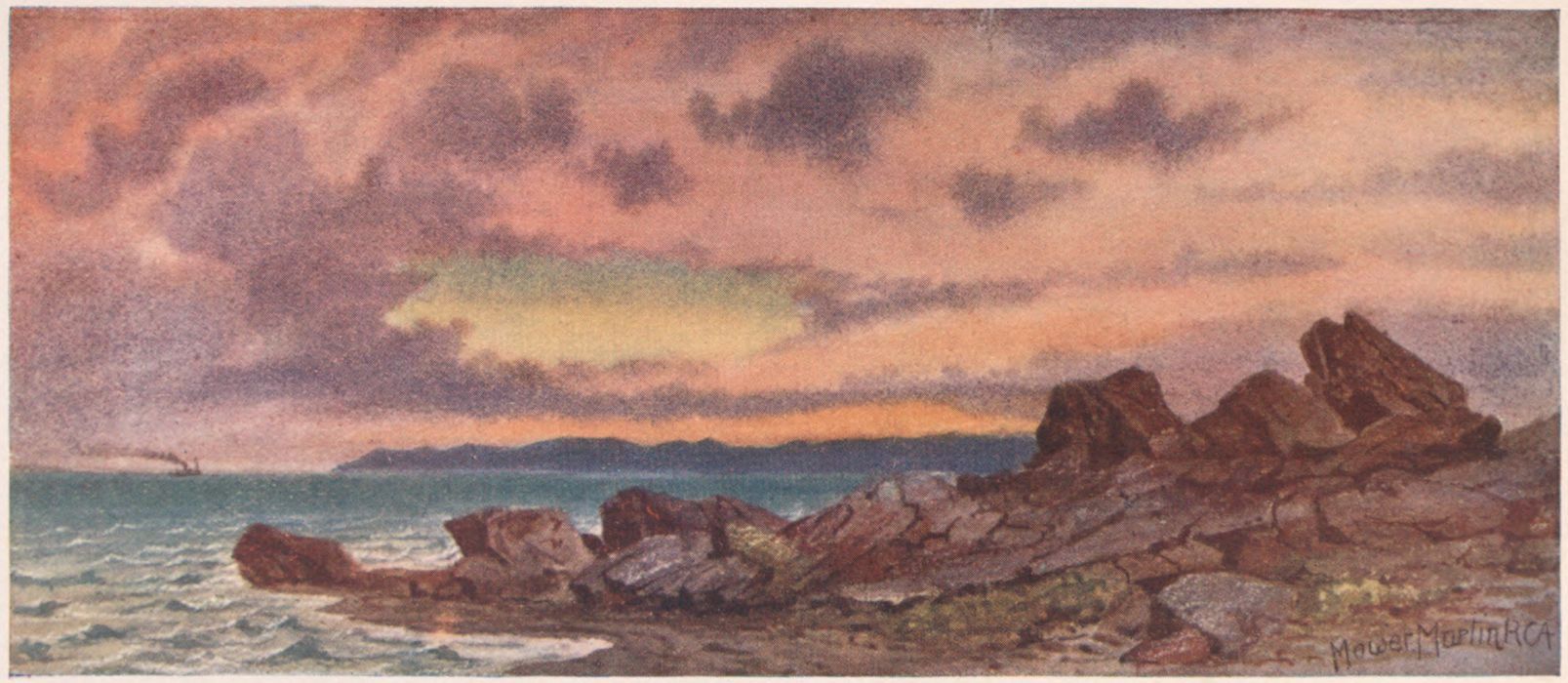
STORMY SUNSET, COAST NEAR ST JOHN, NEW BRUNSWICK
Before leaving the Maritime Provinces, it might be suggested that it would be for the benefit not only of the Dominion, but of the Maritime Provinces themselves, if the three provinces were united in one. The vast growth of the west, with its great provinces, and the recent addition to Quebec and Ontario, will make the union of the three eastern provinces a virtual necessity in the near future.
It may not be realised abroad, but it is recognised in this country that a great deal of our political corruption has arisen in the first place in the local legislatures. We are
“A people for high dreamings meant,
But damned by too much government.”
The world is beginning to see that what is called home rule has its drawbacks as well as its good qualities, and that local government has been somewhat overdone on this continent. It has been to a great extent the curse of the United States in the past, and the American Federal Government has just struck its first blow at this overdoing of the local evil, when it points out that California must be amenable to a treaty made at Washington with Japan. The Canadian Government has made a similar move in retaining the control of the lands in the new provinces. Localism has had too much of its own way during the nineteenth century, and has been literally done to the death. It was popular so long as it meant defiance of Downing Street. But now, when it applies to Washington or Ottawa, it is seen to be scarcely so virtuous and admirable an attitude.
The people in the British Islands should take a lesson from us in this matter, and be careful ere they go too far in this direction in granting home rule to Ireland, Scotland, and England. If the matter is studied, apart from mere passion and prejudice, it will be found that petty local governments can prove very often more a curse than a blessing to the localities where they are established.
There is such a thing as having too many governments, which mean often merely so many organised local jealousies, animosities, and self-advantages at the expense of the whole country. And when, in a large territory like Canada or the United States, a small province or state demands all of the rights and privileges that are accorded to a neighbouring community ten times its size in area and population, it is only a vicious system of party government, accustomed to grant all sorts of absurd demands for the sake of power, that does not see the ridiculous situation at once.
The day will come when common sense will prevail, when the United States will reconstruct her people into several large provinces, and do away with the monstrous absurdity of so many petty states and petty legislatures, which are a continual bar to progress, and a feeding-ground for corrupt parish politics. Long since have the most of these states ceased to count for anything save in name. In the great questions of the nation, even in the election of a president, a few prominent cities and states control the Union; and it is a long time since anything smaller than the solid north, the solid south, or the solid west has been heard from.
This is rapidly becoming true also of Canada, and if such a man as Joseph Howe were alive to-day in the Maritime Provinces, he would agitate just such a union as has been suggested. The day has gone by when a small people or a minority community can hold up the vast majority and demand privileges merely because they are ancient in their foundation. The day of little governments has departed, and with the rapid growth and expansion of the west, the present conditions in the east will not long be tolerated.
The Maritime Provinces have done much for Canada, but the road of progress and population seems to be ever westward; and, in this sense, our eastern provinces are already more of the past than the present. What they need is a re-adjustment of their government on practical lines, so as to bring the control and development of their country more up to date. They have great physical resources, mines, fisheries, farm-lands, and harbours, as yet untouched and undeveloped. They have millions of acres that will yet be tilled; and the day will come, when the wave of westward emigration has begun to ebb, when the lands of these provinces will be more appreciated.
Meanwhile, one strong government, with a good immigration and development policy, would do much to bring, what they are sorely in need of, a greater population, to fill those beautiful valleys and shore-lands, which are the historical and picturesque gateway to the vaster Britain of the west.
QUEBEC AND THE LOWER ST LAWRENCE VALLEY
The eastern gateway to Canada is the vast waterway of the St Lawrence. Here came Cartier and Champlain, and that longtime of noble discoverers, adventurers, and ecclesiastics; founding historic Quebec and the famed Mount Royal, which now gives one of his titles to one of the greatest Scotchmen and Canadians of the nineteenth century.
Parkman, the great American historian, has immortalised the history of this famous stream, and has made the early French explorers stand out among the most interesting and heroic figures in all history.
When one reads Parkman, Canada ceases to be a mere northern, desolate region of iron-bound, inhospitable coasts, trackless forests, and lonely lakes and rivers. It becomes at once a romantic and enchanted land, the theatre of incidents and events both heroic and historic, and as beautiful and sublime in its vast background as the glamour which heroism, religion, the charm of race, and love of adventure can throw over the characters and communities which made it their stage of action and ideal.
It is remarkable, and a strong rebuke to those narrow theoretical nationalists who make national patriotism a profession, that the truest and most noted writers who have dealt with our history and legend have been outsiders, and not of our country at all. Genius cannot be limited; imagination knows no boundaries. It is the petty professional writer who boasts that all his subjects for literary purposes shall be limited to his own country. We have in Canada, and have had in the past, a very few such writers and cliques, exploiters of our new nationalism for the advantages which it may bring them. But the best answer to all such is the fact that the three leading American historians are famous because of their interest in outside countries and nationalities. Motley has given to the world his Dutch Republic, Prescott his noted History of Mexico, and Parkman is famous for his beautiful studies of French Canada.
The two most famous Canadian poems, Evangeline and Hiawatha, were written by Longfellow, the American poet. The scene of Hawthorne’s finest novel, The Marble Faun, is laid in Italy. Washington Irving’s Bracebridge Hall deals with rural England. Whittier’s most popular ballad is The Siege of Lucknow. Some of Emerson’s most noted poems deal with mediæval history and the East. On the other hand, the finest American novel is The Virginians, by Thackeray. Charles Reade’s greatest novel, The Cloister and the Hearth, deals with Germany of the days of Erasmus.
This all shows that there can be no limit to genius. No class of men can dictate to the writer as to the choice of his subject. But it will be found that most of our writers have had a special interest in the rich civilisations of the past, as more attractive than the crude, material present. Because of this, French Canada, with its romantic atmosphere, has been the chief theatre for our Canadian literature.
In reality, the history of French Canada is more alien from the Ontario writer, whose parents or grandparents have come from England, Ireland, or Scotland, than is the history of those homes of his ancestors; and it is an affectation to say that it should not be so. The truth is that the greater portion of the people of Canada, up to the present, have known little of each other; and where people have been living, as in Lower and Upper Canada, separated by race, religion, and language, it is absurd to expect that they should have anything in common. It is quite natural that the settler in Canada from Scotland should know much of Scottish history and literature, and nothing whatever of the history of French Canada.
In fact, had it not been for an American, Parkman, and the common school history, the people of Ontario would know practically nothing of early French Canadian history. And much as we may admire the deeds performed, and the characters who walked the stage, it is all as foreign history to us, in so far as we are concerned, as is the history of Peru or the Dutch Republic.
As well ask the inhabitants of Kent to call the early history of Ireland or Scotland theirs, as ask the Ontario man or the Manitoban to become enthusiastic over the early French régime. It would be as absurd as to ask the French Canadian to regard as his own the United Loyalist history, or that of the settlement of St John by the British.
It should be realised by the outsider that Canada is a vast country, including the larger northern part of one of the greatest continents on the globe; that its territory stretches from ocean to ocean; and that it is now but the result of the union of several scattered colonies with a common history dating only since about forty years back. In this way, only, will it be realised that the amalgamation of the Canada of the future is as difficult a matter as was the union of the British peoples in the remote past. Even to-day the French Canadian calls his fellow English Canadians English, and regards himself as the only Canadian; and in some parts of the Maritime Provinces I have heard people talk of going up to Canada.
It may be acknowledged that the union of the Canadas in the ’sixties, like the union of the American States and the separation from Britain, was no simply unanimous and spontaneous matter. There was much opposition and bickering; and in some of the provinces for years there existed a class who never recognised the Federation. In a town in New Brunswick I saw a strange sight—the chimneys of a man’s house were painted black; and I was told that he had done this on the day of Confederation, it being his peculiar way of going into mourning for provincial independence; and he would never until the day of his death acknowledge himself as a Canadian.
When we realise that for more than half of the nineteenth century the whole of Canada meant merely Quebec and the province of Ontario, it cannot be wondered at that the French Canadian, who is separated in language, law, religion, and social habits, and who was the first inhabitant, should yet regard himself as the original and only Canadian.
No person coming to Canada should fail to come by the St Lawrence route. Not only is the scenery of the gulf and river beautiful, but the sight of the French villages on the river banks, with their large churches quaintly topped with tin spires, and their small whitewashed houses, is one not soon forgotten.
The habitant of the present day in the rural districts is much the same as he was a century since. He is happy and contented by nature, and not fond of change or very desirous of progress. Faithful to his church, his language, and his traditions, he tills his land much as his forefathers did, indifferent to modern improvements and the American vortex about him.
But, in spite of this conservative trend of mind in the mass of her people, French Canada has produced a group of statesmen, ecclesiastics, and litterateurs of which any country might be proud. From the very first she has had picturesque figures in her history; and the French Canadian should have good reason to be proud of his province in this respect. In the early days such names as Cartier, Champlain, La Salle, Brebeuf, and Frontenac were famous in history. Since British rule, Lafontaine, Cartier, Papineau, Chapleau, and Laurier stand out, especially the first two and the last, as rivals of any political leaders on either continent. But it is interesting to note that the spirit which has animated these leaders has led them away from the contentment and conservativism already mentioned, and in the direction of British and American institutions and ideals.

ST LAWRENCE, NEAR SILLERY COVE
There is, however, a quality in French Canada which marks her out from the rest of America. It is associated somewhat with her heroic history, with the sad and ideal, if mistaken, spirit of her early clergy. She is no doubt, in many senses, the most poetic people on this continent, and she has managed, in spite of all her weaknesses—and she has had many,—to ennoble and place a glamour upon the land she has occupied as has none other of the American peoples. That French Canada owes much to Parkman is true; but there is a charm, a quaintness, an artistic quality, a real love of life and its happiness, among her people, which seems sadly wanting elsewhere upon this continent.
In visiting Quebec province one notices a thing that is remarkable, and it is the flag flown everywhere, the tricolour of modern France. This seems strange and inconsistent, as of course the official flag is the British, and the old flag under which the French came to Canada was the royal flag of the golden lilies. Added to this that the modern French republic has ever been, and now is, antagonistic to the Roman Church, which is all-powerful and the State Church of Quebec; it is the more surprising that the tricolour should be the favourite flag of the people.
There have been several explanations of this replacement of the old flag by the tricolour. One is that the English brought it into Quebec after the Crimean War, as a tribute to the fact that France and England had fought side by side against Russia. But the true reason is that the strongest influence in Quebec is Nationalism, as is evinced by the jealousy of the people regarding their language. This is a very natural feeling, and it is an evidence that the race-idea is the most lasting one; and those who foolishly hope to destroy all race-ideals will find the spirit of the French Canadian one not to be crushed in that manner. The Quebec people are quite willing that all in Canada should be Canadian in their own way. They may smash their own or anyone else’s race-traditions; but they must not interfere with the Quebec man’s peculiar Canadianism. In other words, they may graft the new Canadianism on the old French Canadian stock; but the old trunk—that is, his ideals and his race-traditions, his loyalty to all that is French—must be left alone. Now, one cannot but admire this attitude on the part of the French Canadian; but it should also teach that the British Canadian on his part has sacred race-traditions, which must not be effaced, and which will be necessary to the highest development of the future Canadian people.
Entering the Gulf of St Lawrence, we reach Anticosti, an island with an interesting history, and now owned by Menier, the French chocolate-king. Passing the south shore, a series of gloomy mountain-ranges, with fishing villages nestled here and there amid sparse farm-lands in bays on the shore-line, we reach Rimouski on the south shore, the place where the European mails are landed. Farther up, as the river narrows, Green Isle or Isle Verte is reached; and opposite, on the north shore, is Tadousac, and the mouth of the great river Saguenay, the waterway to what is called the Lake St John district.
The Saguenay is one of the most remarkable streams on this continent. It is gloomy, forbidding, and lonely in its character; the shores often rise in high crags; and Cape Eternity, whose sheer cliff rises hundreds of feet from the river’s edge, is one of the most majestic and famous rocks in America. The following sonnet gives a description of its gloomy grandeur:—
CAPE ETERNITY
“About thy head, where dawning wakes and dies,
Sublimity, betwixt thine awful rifts,
’Mid mists and gloom and shattered lights, uplifts,
Hiding in height the measure of the skies.
Here pallid Awe for ever lifts her eyes,
Through veiling haze, across thy rugged clefts,
Where, far and faint, the sombre sunlight sifts,
’Mid loneliness and gloom and dread surmise.
Here nature to this ancient silence froze,
When from the deeps thy mighty shoulders rose,
And hid the sun and moon and starry light;
Where based in shadow of thy sunless floods,
And iron bastions vast, for ever broods
Winter, eternal stillness, death and night.”
The Saguenay river has always been held by the inhabitants of the province in a good deal of awe, and, as a stream, it has been associated with a mysterious and sombre fate.
It was up this stream, says legend, that the morose and unhappy Roberval disappeared into its desolate vasts. The tradition adds that, suspecting great mineral wealth in the interior, he sailed up its gloomy waters and vanished completely from the knowledge of men.
Another legend is associated with Tadousac, which is situated at the mouth of the Saguenay. It is the marvellous story of the Père Brosse, and is told in Lemoyne’s Chronicle of the St Lawrence, Père Brosse was the priest stationed at this place, and the story concerns his death, which was accompanied, so the legend states, by several miraculous happenings. The good father, having knowledge of his approaching death, bade his people go for the neighbouring curé, Père Compain, who was on the island of Aux Coudis, and bring him to perform the funeral offices. He prophesied that there would be a storm, but they were not to heed this, for he guaranteed them protection, and that they would find Compain awaiting them. All happened as he had prophesied, and, on their return, the Père Brosse was found at midnight in his church, dead, leaning against the altar; and it is added that the church-bells were tolled without men’s hands on the occasion of his death.
Near this locality is St Anne de Beaupré, the famous Canadian shrine, where, it is claimed, thousands of pilgrims have been cured of their diseases through the intervention of the good saint. It has been for years the Mecca for all sorts of ill folk, of the Roman faith, who go there in crowded excursion trains, in hopes of being cured. In the church is a great pyramid of crutches and other evidences of disease and physical disability, left by the pilgrims as testimony of the miraculous cures worked.
The Saguenay is considered one of the best salmon regions in Canada, and attracts yearly large numbers of American and other sportsmen.
Above Green Isle is Cacouna Bay and Cacouna, one of the most noted watering-places on the St Lawrence. From here up, on both sides of the river, are many summer resorts, among them being Murray Bay, one of the most popular. Near Quebec is the historic island of Orleans, well known in early French history; and after this a bend in the river is turned, and the city of Quebec is reached.
Quebec is the most famous of the Canadian cities. It is called the Gibraltar of the West, though its present fortification is, to all intents and purposes, a farce. It was the key to French Canada, and when Wolfe went up its scarp and surprised Montcalm in his hold, he changed the rule of the northern half of the continent. But at the cession Britain, virtually, while freeing the country from French rule, handed the government back to the people, and gave them privileges which were not only hurtful to themselves, but caused jealousy in the colonies to the south; and ever since Quebec has remained, as she is to-day, French Canada.
The city stands on the lake-like expansion of the St Lawrence, at the junction of that river and the river Charles. It is gradually becoming the leading seaport of the St Lawrence route; and the great iron bridge, now being constructed across the river just above the city, will bring it into close touch with the leading railway systems.
Quebec was founded by Champlain, the great discoverer of the St Lawrence, in 1608. Parkman rightly calls him “the Æneas of a destined people.” Here he defied Kirke, and finally had to surrender Canada; but his name is associated for ever with the history of this country.
In Champlain’s time there was an energetic effort made to colonise the banks of the St Lawrence; and, while the Roman Church prevailed, there was a sharp struggle on the part of Protestantism to Christianize this region. Parkman tells of the quarrels between the Huguenots and the Roman clergy. There is a famous picture depicting the fierce controversy that was waged on shipboard between the Jesuits and the Huguenot ministers, on the way out to Canada. Each religious party is represented as occupying one side of the deck, and in front of each, a fierce theological leader belonging to that side, in threatening attitude and angry disputation. Near them are seen the sailors and shipmen, grouped together and enjoying the spectacle; and the satirical title of the picture is, “And They Disputed by the Way.”
De Monts was a Huguenot, and brought out both priests and ministers of his own clergy.
“I have seen our curé and the minister,” says Champlain, “fall to it with their fists on questions of faith. I cannot say which had the more pluck, or which hit the harder; but I know the minister complained to the Sieur de Monts that he had been beaten.”
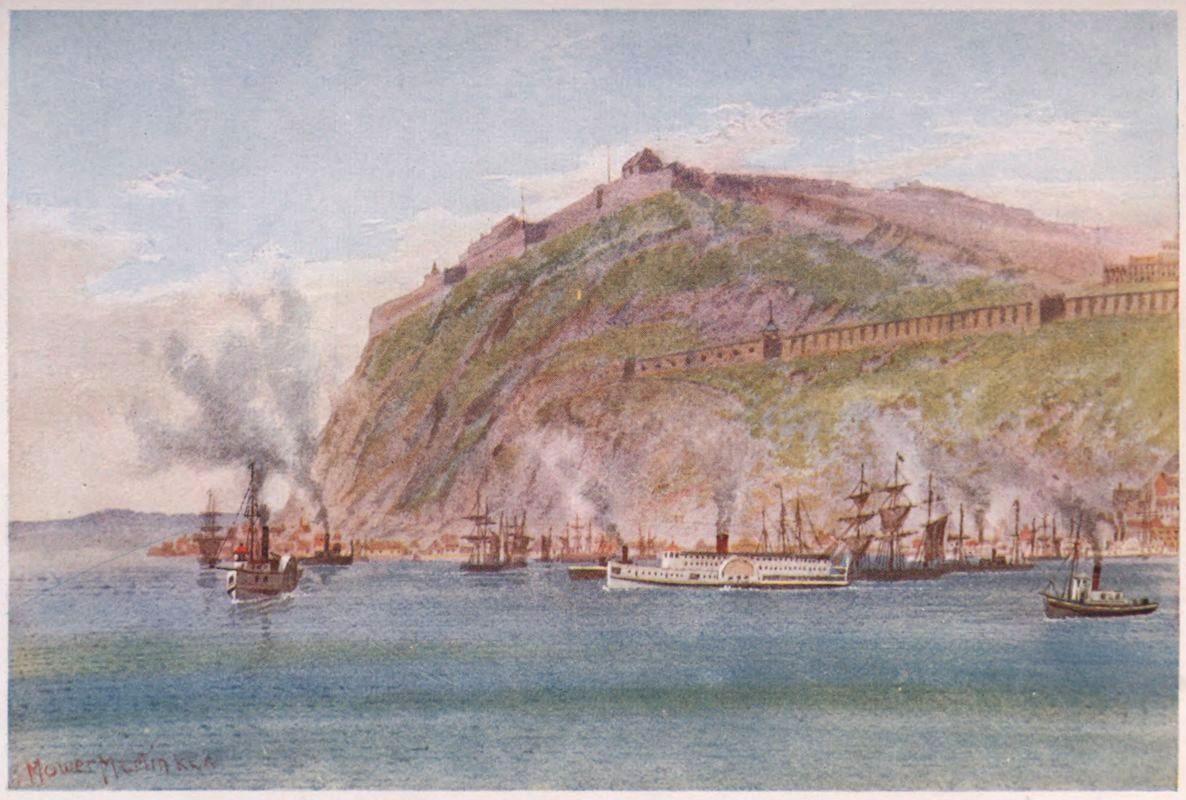
THE CITADEL, QUEBEC
An interesting episode in the history of Quebec is that of the British flag which was captured by the French in 1690. Sir William Phipps, after taking Port Royal, advanced up the St Lawrence and arrived at Quebec in October. Here, he summoned the city to surrender; but the valiant Frontenac, who was governor, refused to do so, though he was taken at a disadvantage by the sudden arrival of Phipps. A battle ensued, and Phipps had to return, leaving behind him some cannon and his flag, which was shot off in the action, and which was captured by an enterprising Frenchman who swam out and secured it.
The finest pen-portrait I have seen of this old-world city in the new world is that given in his verse by the Duke of Argyll, and written by him when, as Marquis of Lorne, he was Governor-General of Canada. It is, as will be seen, not only a splendid description of the old city, its surroundings, and its historical splendour; but it also contains many stanzas and single lines of rare poetry, as when he apostrophises the mighty Key to the St Lawrence in the following lines:—
“O fortress city, bathed by streams
Majestic as thy memories great,
Where mountain-floods and forests mate
The grandeur of the glorious dreams,
Born of the hero-hearts who died
In founding here an empire’s pride.
Who hath not known delight, whose feet
Hath paced thy streets, thy terrace way;
From rampart sod or bastion grey
Hath marked thy sea-like river greet
The bright and peopled banks which shine
In front of the far mountain’s line;
Thy glittering roofs below, the play
Of currents where the ships entwine
Their spars, or laden pass away.
As we who joyously once rode
Past guarded gates to trumpet sound,
Along the devious ways that wound
O’er drawbridges, through moats, and showed
The vast St Lawrence flowing, belt
The Orleans Isle, and seaward melt;
Then by old walls by cannon crowned,
Down stair-like streets, to where we felt
The soft winds blown o’er meadow ground.
Where flows the Charles past wharf and dock,
And Learning from Laval looks down,
And quiet convents grace the town;
There swift to meet the battle shock,
Montcalm rushed on; and eddying back
Red slaughter marked the bridge’s track;
See now the shores with lumber brown,
And girt with happy lands which lack
No loveliness of summer’s crown.
Quiet hamlet alleys, border-filled
With purple lilacs, poplars tall,
Where flits the yellow-bird, and fall
The deep eave-shadows. There, when tilled
The peasant’s field or garden bed,
He rests content if o’er his head,
From silver spires, the church bells call
To gorgeous shrines, and prayers that gild
The simple hopes and lives of all.”
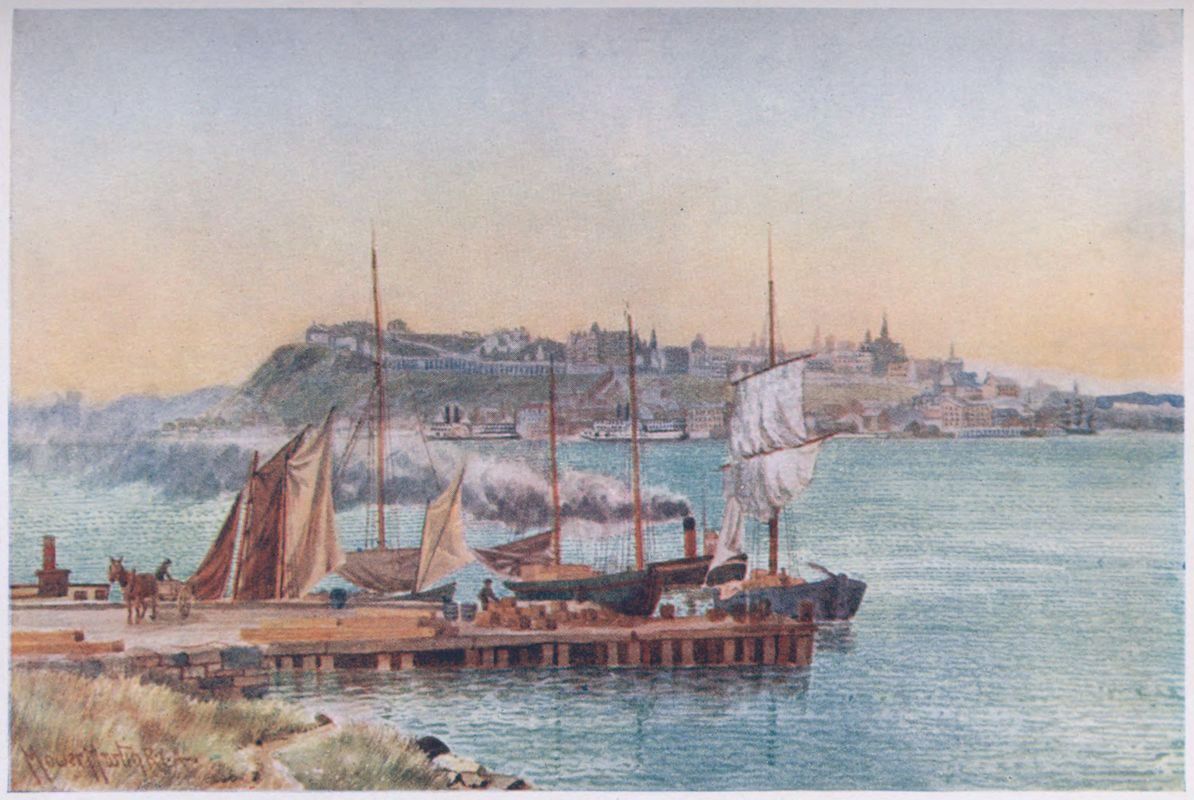
QUEBEC, FROM POINT LEVIS
Here we have the quality of the true poet, who, a fine artist, gives us a delightful picture of this old bastioned town above its flowing tides not only by depiction, but also by suggestion. In this poem we not only see the
“Fortress city, bathed by streams
Majestic as her memories great”;
but we also revive those memories, and once more feel the thrill of old battle-call and the romance of her past and present.
But this poet has also given us a description of the environs of Quebec, and in delicate language describes the coming of the seasons, and shows how bounteous nature is in this often bleak and iron-bound region. He pictures how—
“In the dank grass at our knee,
Shone pearls of our green forest sea,
The white star-flowers of triple leaf,
Which love around the brooks to be.”
He also gives us a picture of a thunder-storm; and in some beautiful lines refers to the historic battle, and the resultant peace, which made this old fortress famous:
“Before the blasts and rains forth poured,
And slow o’er mighty landscapes drew
The grandest pageant of the Lord.
The threatening march of flashing cloud,
With tumults of embattled air,
Blest conflicts for the good they bear;
A century has God allowed
None other, since the day He gave
Unequal fortune to the brave.
Comrades in death! you live to share
An equal honour, for your grave
Bade Enmity take Love as heir!”
The line, “With tumults of embattled air,” is very beautiful, and the final apostrophe to Wolfe and Montcalm is noble and heroic.
Near Quebec are the famous falls of Montmorenci, one of the most majestic cataracts on this continent. The river of that name literally tumbles over an immense cliff into the St Lawrence. Lord Lorne describes its beauty in exquisite verse:
“We watched, when gone day’s quivering haze,
The loops of plunging foam that beat
The rocks at Mont Morenci’s feet,
Stab the deep gloom with moonlit rays.”
The view from the citadel is one of the finest in the whole world. Far below and out to the distant horizon stretches the vast river, “sea-like”; and beyond rise the dim, purpled peaks of the bleak mountain-ranges against the Canadian sky. Lord Lorne describes this scene by night, with the ancient city sleeping below:
“Or from the fortress saw the streams
Sweep swiftly o’er the pillared beams;
White shone the roofs and anchored fleet,
And grassy slopes where nod in dreams
Pale hosts of sleeping marguerites.”
The winter sports and the winter landscape of Quebec are widely known and appreciated. Indeed, our Canadian winter has been too much praised abroad to the detriment of the character of our climate. It is not so widely advertised that Canada, especially Ontario, is in many parts quite tropical in its summer heat, and the title “The Lady of the Snows” has scarcely been justified.
Yet our winter season is a delightful and bracing one, and Canadians sadly miss what is called the good old-time Canadian winter, when, as in some years of late, it has failed to appear.
The Marquis of Lorne has given a very delicate picture of the winter life, the winter atmosphere and landscape at Quebec:
“Or when the dazzling Frost-King mailed
Would clasp the wilful waterfall,
Fast leaping to her snowy hall
She fled; and where her rainbow hailed
Her freedom, painting all her home,
We climbed her spray-built palace dome,
Shot down the radiant glassy wall,
Until we reached the snowdrift’s foam.
Then homeward, hearing song or tale,
With chime of harness-bells, we sped,
Above the frozen river-bed.
The city, through a misty veil,
Gleamed from her cape, where sunset fire
Touched Louvre and cathedral spire.”
Canada has produced many writers who have described her natural and historic glories, and have pointed out to the world her splendid resources. But it is remarkable that it was one of her Governors-General who was the first to picture her historic fort in such fine classic verse as is here quoted; and nowhere in all our poetic literature is Quebec city so truly and artistically depicted as in this poem.
The Quebec of to-day is much improved in a utilitarian sense, and the fine Canadian Pacific Hotel, the Château Frontenac, a stately pile, adds to the picturesque charm of the upper city.
But its ancient glories are still its chief ones. Its old university, “where Learning from Laval looks down,” is the great Roman Catholic university of Canada, and was founded by the famous ecclesiastic of that name.
Quebec’s churches are interesting because of their history and association with the early struggles of the pioneer days, and not least among them is the Anglican cathedral of St James, the second oldest Anglican church in Canada.
Other picturesque features of this city were its old historic gates, some of which have fallen into decay, but which helped to give it the air of an old-world town. It would be a delightful city were it cleaner. The approaches from the steamers through the lower town are a disgrace to a place of such world-wide renown.
Beneath its bastioned cliffs there stretches a long row of houses, facing a single street or road on the edge of the river. These buildings have an ancient, weather-beaten, time-stained appearance, that suggests the seventeenth and eighteenth centuries rather than the twentieth. Here, a few years ago, a part of the cliff came tumbling down, destroying a number of houses and endangering the lives of the inhabitants.
The citadel walls on the top of the cliff are in but an indifferent state of repair, and are slowly crumbling away.
Below here, and up the swift stream, stemming its tides, came the early discoverers, Cartier and Champlain, seeking, as they thought, Cathay and farther Ind. Here, on this rock, ruled in turn Church and king. Here dwelt that iron soul, Laval. Here Frontenac defied Phipps; and here, later, up this stream, came Wolfe that fated night, musing on Gray’s Elegy, and
“The boast of heraldry, the pomp of power”;
and, scaling the grim cliffs, surprised the French general Montcalm, and fell with him in a common glorious death, and whose common grave
“Bade Enmity take Love to heir.”
Here, in the old days of the early settlement, were landed “the king’s girls,” as they were called. These were the young women who were intended to be the wives of the early inhabitants. This manner of providing for the growth of the early French colony was one of the most interesting episodes in colonial history. The infant community was not one of families, but of adventurous single men; so that, in order to encourage them to settle on the land and become permanent residents, and also to increase the population, the Church and king undertook to provide wives for them.
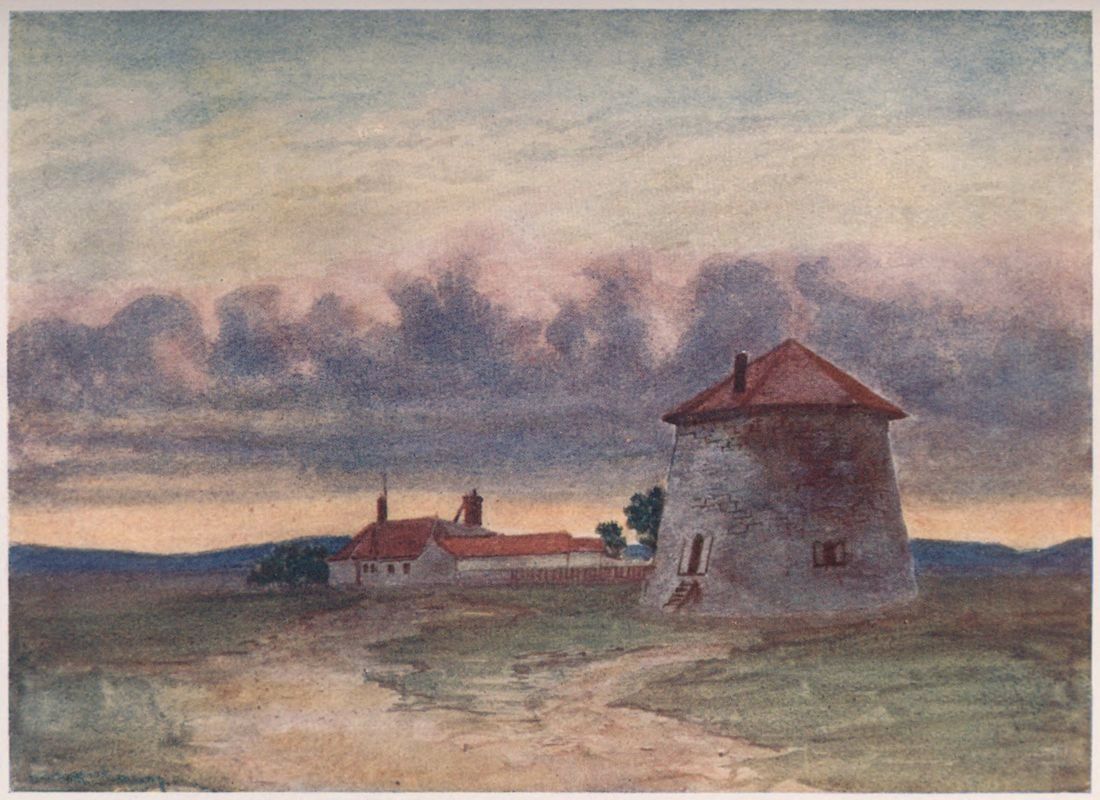
MARTELLO TOWER, PLAINS OF ABRAHAM
These young women were sent out in ship-loads at a time, and were consigned, in the care of some good women of the Church, to the governor, who undertook to find them suitable mates among the male inhabitants. They were for the most part peasant girls from the country districts, chiefly from Brittany, as the men had objected to the class of girl from the towns, who were delicate and could not work in the fields and endure the hardships which the early pioneer life entailed. A few ladies were sent out to be married to some of the officers at Quebec and Mount Royal, but the number was limited.
The convent of the Ursuline nuns was an important institution at Quebec in those early days, and Mary of the Incarnation and other women of religion were prominent characters, and took an active part in the early life of the colony.
MONTREAL AND THE UPPER ST LAWRENCE
The river St Lawrence, above Quebec, grows narrower, and its tides swifter, while the wooded and well-tilled lands on the shores are pleasing and picturesque. Some distance above the city, on the south side of the river, is the county and seigniory of Lotbinière, the country residence of Sir Henry Joly. The country hereabout is very lovely, and the manor-house stands on a commanding height and makes a very picturesque appearance among its trees above the river-bank.
Sailing up the river, Three Rivers, on the north side, is reached. It is the third largest city in the province, and takes its name from the triple mouths of the river St Maurice, which here joins the St Lawrence. It is a flourishing town, and has an important trade in lumber.
After leaving Three Rivers, the St Lawrence soon widens out into Lake St Peter, a large but shallow body of water; and navigation here becomes dangerous, especially for the larger ocean steamers. The scenery along here is very fine, and the farm-lands are well cultivated, and the villages on the banks interesting and quaint. Here and there can be seen old windmills in which the early settlers used to grind their corn, and some of the old stone houses are still standing. The only large buildings to be seen are the churches, which usually occupy commanding positions, some of them with lofty twin spires against the landscape.
Leaving Lake St Peter at Sorel, a well-built and progressive town, the river again narrows, and the picturesque farm-lands loom close on both sides of the stream.
One of the most interesting places in Quebec province is the village of Verchères about twenty miles from Montreal, on the south shore of the river. It is famous in Canadian history as being the scene of one of the most heroic incidents in the early life of the country. Here dwelt that famous heroine, Madeline of Verchères, who, though a mere girl, being at the time but fourteen years old, held her father’s manor-house against the Indians for several days, aided only by her two brothers younger than herself, two old men, and a few women. This heroic act has been related in Canadian song and story, and will make this little village live long in memory in the annals of French Canada.
The seigniory of Verchères was in the way of the Iroquois in their forays against the settlers of the upper St Lawrence in the vicinity of Montreal. It was a large tract of land with a small clearing about the fort or blockhouse, in which dwelt the lord of the manor and his tenants, who worked the land for him on the feudal system.
The blockhouse, where they all lived in those early days, was a large wooden building protected at each corner by a stockade and bastions, wherein the men could fight. The stockade was a wooden fence of high palings surrounding the enclosure, in the centre of which stood the blockhouse, where the women and children were sheltered in security. In this way only could the early settlers defend their lives and their possessions from the continuous raids of the wandering bands of hostile savages, who at the end of the seventeenth century beat like a relentless wave against the outposts of the Canadian colony.
It was in the year 1692, and late in the autumn, when the woods were beginning to shed their leaves of crimson and gold, and the tenants of the seigniory of Verchères were busy in the fields garnering their late harvest against the bleak months that were to come. It was a beautiful morning when Madeline, a girl of fourteen years, who dwelt alone in the fort, her father being from home, started in the direction of the river, accompanied by a serving man, when she discovered the approach of a band of Iroquois. She had barely time to hurry back to the fort and to cry, “To arms! To arms!” to warn those in the fields, when the stealthy and persistent foe were upon her.

AN INDIAN CHIEF
Quickly closing the gates to the stockade, she organised her scanty garrison. Here she had but two soldiers, and one of them was about, in his despair, to blow up the powder magazine and destroy them all, rather than have them fall into the hands of the savages, when she providentially arrived and prevented him.
Inspired by her dauntless courage, her few followers in the little garrison, including her eldest brother, a boy of twelve, promised to aid and obey her. Firing the only cannon in the fort, she for the time intimidated the Indians, but did not drive them away. Then, seeing a canoe approach the shore, she feared it was some of her friends, and determined to warn them of the presence of the Indians. As no one else had the courage to go, she bravely left the fort and went down to the shore alone, deceiving the Indians by her boldness, and got her friends safely into the fort.
For a whole week she kept the place in this manner, and through her cleverness in placing sentries, and by signals, made the Indians believe that there was a much larger garrison than there really was.
Meanwhile a few labourers in the fields, who had escaped the savages, had gone off in search of succour; and a large party soon arrived from Montreal and relieved the brave girl and her valiant garrison.
Continuing up the river, we arrive at Montreal, the Mount Royal of Maisoneauve, who founded this, the chief commercial metropolis of Canada.
Greater Montreal is an island-mountain at the confluence of the St Lawrence and the Ottawa rivers. The mountain slopes up behind the city to a majestic height, with its sides dotted with villas and mansions, and the view from the top is one of the finest in America.
The city is a place of contrasts, and one of the most beautiful on the continent. Here one will see hundreds of French who cannot speak a word of English, and hundreds of English who cannot speak a word of French. Here will be found the poor and the rich, the old families, the newly wealthy, the Indian, the Irish, and the French. Here the farm, the ocean, the woods, and the counting-house jostle each other in the busy streets.
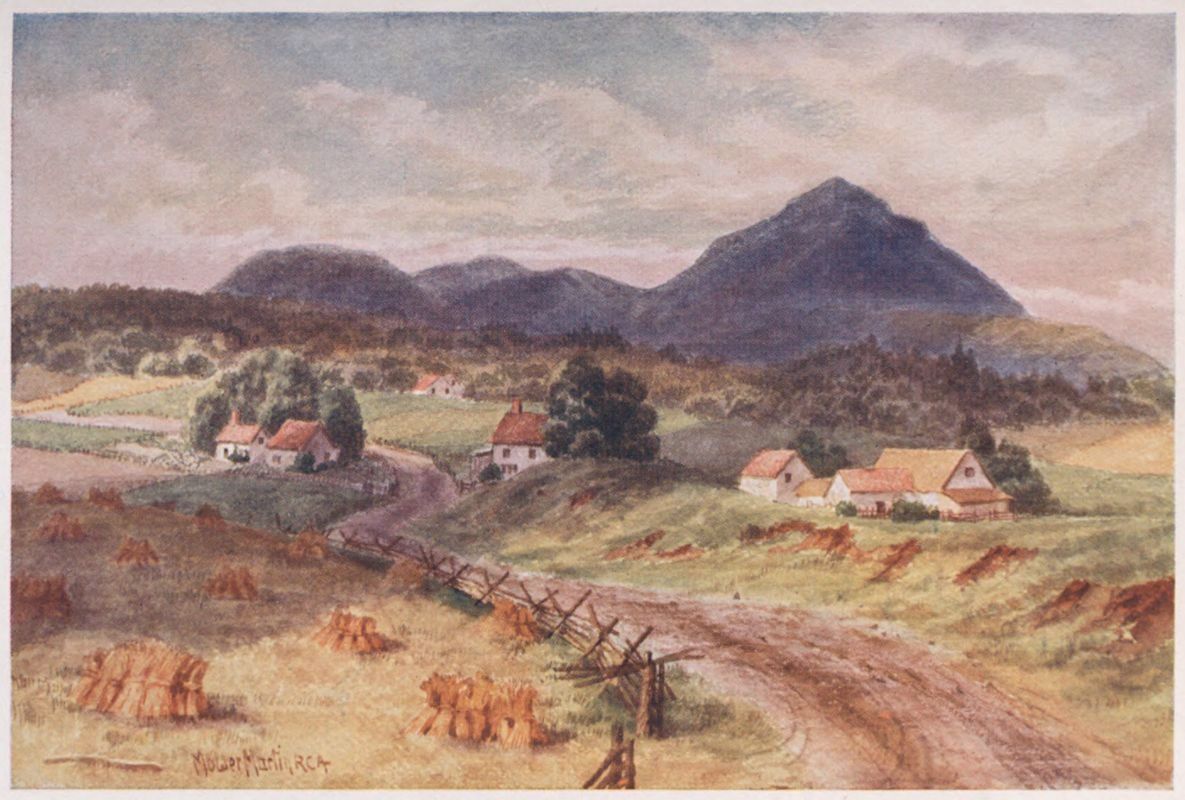
OWL’S HEAD MOUNTAIN, NEAR MONTREAL
Here, as elsewhere, the Scotchman is the leader in commerce, finance, and public enterprise; and probably nowhere else in the colonies have the Scotch and English made more of their opportunity than in Montreal. Some of the residences in the west end of the city are among the finest in the world.
The Irish population resides by itself in what is called Griffin Town, in the south-west of the city. There are many of them of the labouring class; but others of them hold a high place in politics and business.
The island of Montreal is the most fertile in Quebec, and famous for its fruit, especially apples. It is thickly settled with villages and rich farms, being about thirty miles long and ten broad.
Montreal is at the head-waters of ocean navigation, and is the port of the Allan Line of steamers; but the low water in the upper St Lawrence will, it is to be feared, make Quebec the summer seaport of the St Lawrence. The immense ships of twelve thousand tons and over, now being built, need a deep channel; and their great length necessitates that the channel should be wide. Otherwise the trip up the river from Quebec to Montreal is one of the finest summer voyages that can be taken. It might be mentioned here how much Canada and the Empire owe to the founders and owners of the Allan Line steamships, the pioneer line in ocean traffic between Canada and Great Britain. This firm, by its energy, courage, and enterprise, initiated the St Lawrence route, and advertised to the world the advantages and beauties of travel via the Canadian gulf. Their splendid new vessels, the Virginian and its sister-ship, the Victorian, were, I think, the first turbine passenger vessels to cross the Atlantic.
The Canadian Pacific Railway Company, which has done so much to open up the interior of the Dominion, and which has spanned this northern part of the continent with its road of steel, has added to its ocean fleet two splendid vessels of a greater tonnage than any yet entering the St Lawrence. These vessels, however, make the city of Quebec the Canadian terminus of their line. It is to be hoped that the Dominion Government will so improve the St Lawrence water-way as to make, what is one of the most delightful trips for the traveller, a safe and a certain one.
The part that Montreal has played in French history is no small one. It was, from the first, Quebec’s formidable rival; and even in religion the Sulpician brotherhood founded here a stronghold in opposition to the Jesuits, who had made Quebec their headquarters. It was from here that the heroic Dollard, or Daulac des Ormaux, went out up the Ottawa river with sixteen valiant compatriots to sacrifice themselves and save New France from its formidable enemy, the Iroquois. It was also here that Vaudreuil surrendered Canada to the English under Lord Amherst in 1760.
The Montreal of the present day is a modern city, populated largely by French, but, as already stated, financially controlled by Scotchmen. It is the chief Canadian residence of Lord Strathcona and Mount Royal, whose energy and genius have done so much to increase the wealth and importance of the city and the Dominion at large.
On a fine day in early autumn, the view from Westmount, which is perhaps the finest suburb of the city, is magnificent. Away in front of the beholder, below and afar, through a soft azure haze, stretches the great river, winding its shining tides between wood and shore-land; and beyond still farther, at the horizon, lie the distant mountains of Quebec and Vermont, blue and shadowy, pencilled against the sky. Near at hand, but also below, lies the great city, with its spires and turrets, its lines of habitations, its busy streets, and its vast walls and roofs for busy commerce.
Up and down the great stream tugs are puffing, and quaint square-sailed barges force their slow way against the tide; while here and there a crowded excursion steamer or a river passenger-boat passes up or down, with its happy freight of tourists or holiday-makers of a summer’s day.
On the opposite shore the towns and villages shine in the indolent atmosphere, while the red-and-black funnels of vast ocean-liners loom through the forests of spars, hulls, and rigging along the wharf-bastioned shores.
Here to-day come the adventurous children of ancient Europe to swell the tide of human effort, and affect the destiny of the far west. But for the most part, in these streets and on the quays, the language of the mountain, alley, and wharf is that of olden France before the days of the tumbrel and the guillotine, and the faces and forms are those of Brittany and the Norman coasts.
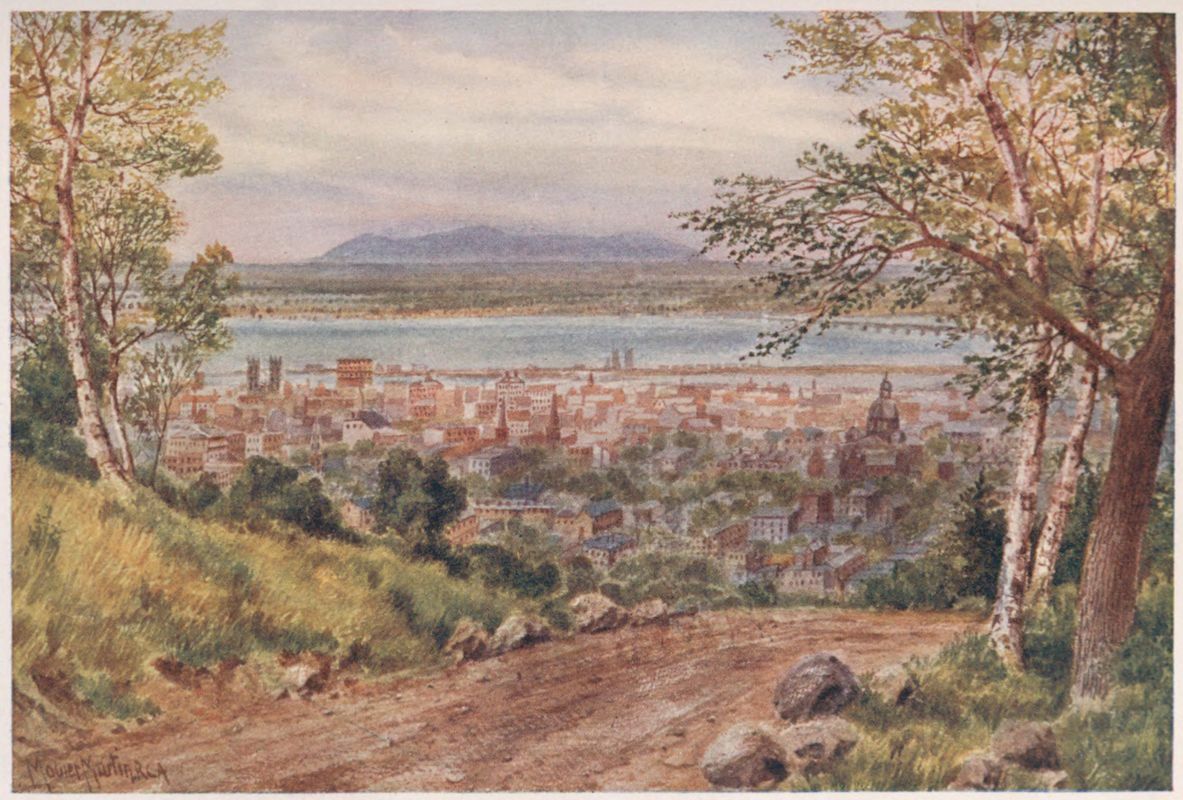
MONTREAL: THE RIVER ST LAWRENCE FROM THE MOUNTAIN
Here still stand the old houses of the historic past. The Château de Ramezay, now a museum, still represents the period and atmosphere of the old régime. In a house still standing, not far off, Washington Irving, the American Addison, wrote his Astoria, with its vivid account of the western fur-traders in the North-West and British Columbia. Here also some of Canada’s great financiers and merchant princes started life as simple clerks in the old warehouses on the river-bank.
Montreal is known not only as the greatest Canadian commercial centre, the head of ocean navigation, and for its beautiful situation. It is one of the great university centres of America. M‘Gill University was founded by James M‘Gill, a Scottish banker, and has since been largely endowed by three other noted Scotchmen, Lord Strathcona, Lord Mount Stephen, and Sir William MacDonald. It is one of the leading educational institutions on the continent, and its science department is one of the finest in the world. Its group of buildings on the side of the mountain is both picturesque and stately, and splendidly equipped within for all educational purposes.
Montreal is also famous, as has been mentioned, for the fine private residences of its financiers and merchant princes. It is the most solidly built city in Canada, many of the buildings being built of stone. It has many splendid churches, chiefly Roman Catholic, such as Notre Dame, after the style of the famous Notre Dame in Paris; the new church of St James, modelled after St Peter’s at Rome; and the famous church of the Jesuits, which contains some fine paintings.
Christchurch Cathedral (Anglican) is the most beautiful ecclesiastical structure in the city, and a very fine specimen of Gothic architecture.
Just above Montreal are the Lachine Rapids and the Lachine Canal, the latter connecting Montreal shipping traffic with the Ottawa river and Lake Ontario. The name Lachine was given to the place by the famous discoverer Champlain, who was under the misapprehension that it was the road to China, which the discoverers of his day imagined was not far off, mistaking the coast of America for that of Western Asia. It was through this mistake that the natives received their name of Indians, the explorers thinking that they had reached the extremities of Asia and the Indies.
In this neighbourhood, and below Montreal on the river-bank, it is interesting to study the life and habits of the French farmers. The farmlands are laid out curiously in long narrow strips nearly a mile in length, and all fronting on the river-bank. This brings the houses close together, and the countryside appears to be a long line of small houses on the river road with the riband-like strips stretching away behind. One reason for this allotment of the land is that the French social proclivities draw them together. They like to forgather, and abhor solitude as an enemy to be avoided.
This is one strong reason why the French have failed and the British have succeeded as colonists. The Scotch and English, for the sake of the land, were willing to penetrate the wilds and live a comparatively solitary life for years. In English Canada the farms were almost square, and the smallest farm one hundred acres, so that in a new settlement the neighbours were separated from each other. This had its advantages, but also some inconveniences. The French Canadian, however, is more contented and sociable; and it must also be remembered that in the earlier days, when the French first settled the country, there was more danger from the common enemy, the savage; and, moreover, the land really belonged to the seignior, who farmed it out to the peasantry.
The French farms are very picturesque, and the country presents a pleasant appearance in early autumn, when the fruits of the field are being gathered in.
One of the most important crops grown in French Canada is the native tobacco, a strong-smelling variety of the weed, but the favourite consolation, together with the “whisky blanc,” of the male habitant. Tabac Canadien, as it is called, is grown by each farmer; and even in the village gardens each man has his patch of this comforting vegetable production.
The French Canadians also raise fine vegetables, and the valley of the St Lawrence, especially the island of Montreal, is noted for its snow-apple, the Fameuse, a delicious fruit with snow-white interior and a deep scarlet skin, and one of the finest eating apples in the world.
French Canada is also noted for its horses; the French pony is not so common as it once was, but in what are called the Eastern Townships, in the neighbourhood of Sherbrooke, there are some well-known stock-farms which have a wide reputation.
Perhaps the most noted depictor, with the pen, of French Canada is Dr W. H. Drummond, the gifted author of The Habitant and other dialect verse. Dr Drummond, with a fine mingling of humour and pathos, describes the French Canadian as a charming and picturesque character, whose vices even lean to virtue’s side.
The great weakness of the French Canadian lies in his insular character, which is largely owing to his present system of education and his manner of life, which means practically an isolation from the rest of the country. Under British institutions he is free to remain under these conditions; but it is not likely that he will be satisfied to remain so always.
Leaving Montreal by rail, or in summer by the Lachine Canal, we reach the upper St Lawrence, and we come soon to St Anne’s, the scene of the beautiful boat-song, so long ascribed to Thomas Moore, the Irish poet, but now said to have been written by the Scottish poet, Thomas Campbell, the author of The Pleasures of Hope, Gertrude of Wyoming, and some of the finest patriotic verse in the language.
No matter who was the writer, the poem is strikingly beautiful, and a true picture not only of the locality, but of the bateau men, who in the early days, before the arrival of railways and steamboats, conveyed all travellers by the slow, laborious, but picturesque power of the oar, up and down these vast waterways, which were the earliest roadways to the wilderness and the regions beyond.
The whole spirit of that period of Canadian life—the toil, the hardship, and the enjoyment of life in the open, the delightful description of the water and shore, mingled with a delicate sentiment and exquisite fancy—is given in these immortal lines, beloved of all Canadians:—
“Faintly as tolls the evening chime,
Our voices keep tune and our oars keep time.
Soon as the woods on the shores grow dim
We’ll sing at St Anne’s our parting hymn.
Row, brothers, row: the stream runs fast,
The rapids are near and the daylight’s past.
Why should we yet our sail unfurl?
There is not a breath the blue wave to curl.
But when the wind blows off the shore,
Oh! sweetly we’ll rest the weary oar.
Blow, breezes, blow: the stream runs fast,
The rapids are near and the daylight’s past.
Utawa’s tide! this trembling moon
Shall see us float over thy surges soon.
Saint of this green Isle, hear our prayers;
Oh! grant us cool heavens and favouring airs.
Blow, breezes, blow: the stream runs fast,
The rapids are near and the daylight’s past.”
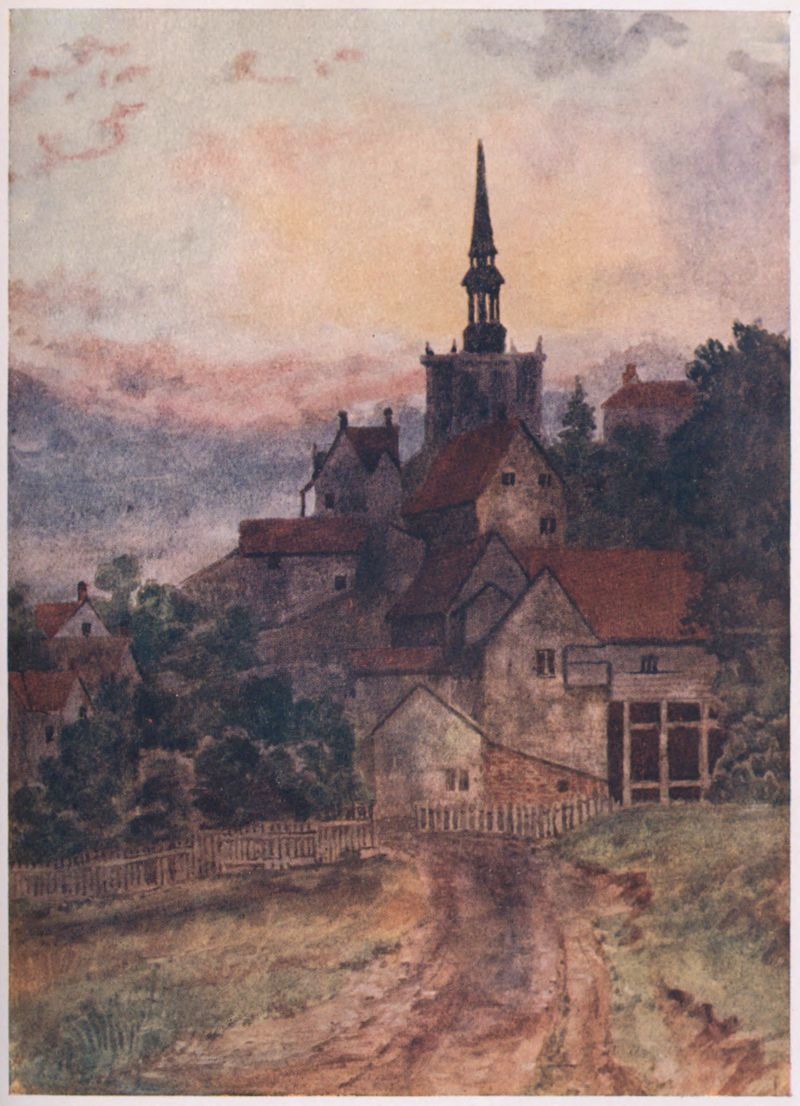
IN SHERBROOKE, EASTERN TOWNSHIPS, QUEBEC
Along the river above Montreal, and in the neighbourhood of St Anne’s, are some beautiful country homes, and some of the finest golf grounds in Canada. The country is an old settled one, the forest having been cleared for over a hundred and twenty years; and many generations have succeeded each other in the same locality, and the virgin atmosphere of the backwoods regions is to them a long way off.
The journey up the Ottawa river by rail on the Quebec side is worth taking; the glimpses of stream and shore, woodland and farmland, are very fine; but the trip by steamer in summer or autumn is better still. The Ottawa is a broad stream with pleasant shores of undulating farmlands bordering along its tides. On the Quebec side the country gradually climbs up into distant ranges of the Blue Laurentian Mountains.
The Ottawa river is famous for its great lumbering interests, which have made it a centre of activity for thousands of workmen who have spent the winter in its far pine-lands, and have, during the high waters of the springtime, poled their immense rafts of logs and timber down its waterways from the source of its most distant tributaries to the rapids of Lachine near Montreal.
The French Canadians have long been occupied in this hardy and somewhat reckless life, and a whole literature could be written describing the vicissitudes of fortune, the struggles, the hardships, the tragedy, the humour, and the pathos of the life of the Canadian lumber woods.
This takes us back to the days of the early canoe made of the bark of the birch tree, and the life of the coureur de bois or the runner of the woods, who was the first man, as a class, to penetrate the virgin wilds and open up the mysteries of our northern streams to the outside world.
There are some remarkable stories and legends associated with these hardy sons of the forest, who were as much Indian as French in their proclivities, and who were the forerunners of the class of shantymen or lumbermen who followed in their wake in the early years of the nineteenth century.
One of the weirdest of these legends, which is very vividly told by several of our French Canadian writers, is that of the flying canoe, which related that some of the woodmen had power to travel for hours through the air in their canoe, which rose at their bidding, it is said, by a magic which they obtained from the Evil One, the stipulation being, however, that none in the canoe should mention the name of the Deity or make the sign of the cross during the voyage. And the penalty was that at the name of God the canoe would instantly fall to the earth and the spell be broken, this often being attended by loss of life or danger to limbs.
A noted historical spot on the Ottawa river is the Long Sault at the head of the famous rapids, where the heroic Daulac and his sixteen young followers, assisted by a few Huron Indians, withstood, it is said, fully twelve hundred Iroquois for the space of several days, and gave their lives in the end for the preservation of New France.
Parkman has described very graphically the story of the remarkable self-immolation of these young men, which has been called the Thermopylæ of Canada.
It seems that Canada had suffered for twenty years under the persistent attack of the famous, cruel tribe of Indians called the Iroquois. The French population in the whole colony was less than three thousand souls, and they were only saved from destruction by the fact that their settlements were grouped around three fortified posts, Quebec, Three Rivers, and Montreal. To the Iroquois, Canada had become indispensable, and they determined, if they could, to destroy the French colony, their policy being a persistent attack on the outskirts of the different settlements. This became, in time, a perfect scourge to the French settlers, who saw no way of escape from this terrible condition. Outside the fortifications there was no safety for a moment, and a universal terror seized the people.
“Everywhere,” writes the Jesuit Superior, “we see infants to be saved for heaven, sick and dying to be baptized, but everywhere the Iroquois. They haunt us like persecuting goblins. They kill our new-made Christians in our arms. If they meet us on the river they kill us. If they find us in the huts of our Indians they burn us and them together.” And he appeals, says Parkman, urgently for troops to destroy them, as a holy work inspired by God.
Canada was at this time a mission, and the Church paramount and pervading, and the piety of the settlers intensely strong; the war with the Iroquois being regarded as a war with the armies of the Evil One.
When things were in this condition, Adam Daulac, or Dollard, appeared on the scene as a young officer of the garrison of Montreal. He formed a desperate plan. Shortly before, it had been discovered that twelve hundred Iroquois warriors were on the eve of descending on Montreal and Quebec, with the object of wiping out the whole colony. Daulac’s plan was a desperate one. He proposed to meet the Indians and waylay them on their descent of the river Ottawa, and fight them to the death. He asked for a party of volunteers. Sixteen of the young men of Montreal caught his spirit, determined to join him, and, gaining the governors consent, made their wills, confessed, and received the sacrament, binding themselves by oath to fight to the death and receive no quarter. “As they knelt for the last time,” says Parkman, “before the altar in the chapel of the Hôtel Dieu, that sturdy little population of pious Indian-fighters gazed on them with enthusiasm not unmixed with an envy which had in it nothing ignoble.”
The spirit of this enterprise was purely that of the Middle Ages. Honour, adventure, and faith had to do with its motive and inspiration. Daulac was a knight of the new world. The names, ages, and occupations of the young men are still in the old register of the parish at Montreal. They were soldiers and artisans of various callings, but their spirit made them equal.
Leaving Montreal in their canoes, they at last entered the mouth of the Ottawa and slowly advanced up the stream. They soon passed the swift current at Carillon, and after much toil and travail reached the foot of the rapid called the Long Sault. Here they found an old ruined fort which they took possession of, and were soon joined by a small band of Hurons and Algonquins, who, hearing of their intention, had followed them up the river to share in their victory or defeat.
Here, a few days later, they were besieged by an immense body of the Iroquois, and for five days, through hunger, thirst, and want of sleep, shut up in their narrow fort, they fought and prayed by turns; and here at last they died, but not until they had given the fierce savages such a dreadful lesson that they never forgot it.
The Iroquois were now satisfied. If seventeen Frenchmen and five Indians, behind a few logs, could hold twelve hundred warriors at bay for five days, what might they not expect from their compatriots behind their walls of stone? Daulac’s heroic if reckless effort had saved the colony.
Below Ottawa, on the Quebec side of the river, is Montebello, the seigniory and château of the well-known family of Papineau. The late owner was a son of the noted rebel who led the rising of 1837, and was one of the greatest orators of French Canada. The château, a quaint imitation of a French castle, stands on an eminence close to the river, and is the only example of an old-world edifice of this kind in Canada. The late lord of the manor was only too proud of the part he took in the rebellion, and would show the old musket which he said he had used on that occasion. In his later years he quarrelled with the Roman Church, and became a Protestant, joining the Presbyterian Church and building a fine new church for that body.
Sailing further up the river, the voyager arrives at a beautiful part of the country; and soon, at the junction of the Ottawa and the Gatineau, Ottawa comes in sight, the beautiful capital of the Dominion.
OTTAWA, THE CAPITAL OF THE DOMINION
Ontario is not only the largest province in point of population, and the wealthiest, but it has been also fitly called the garden of Canada. Canadians are proud of the vast territories in the great west, and the harbours and the waterways of the maritime coast; but, taken all in all, Ontario is the most desirable of all the Canadian provinces to live in. Here we have not only a variety of climates between certain degrees, but the general temperature is of that hardy, bracing, and yet genial nature that makes for strength in a people, without being too arctic for the development of the refinements and enjoyments of life.
Our winters are cold, but our summers are delightfully warm; and a century of cultivation of the land has made the province not unlike England in many respects.
Nowhere else in the Dominion are there the same variety of woods, grains, or fruits grown to the same extent. We have hardy wheat-lands and pleasant peach-gardens in one zone. We have the pine forests and the silver and nickel mines of the north, and the luscious vineyards of the Niagara district to the south.
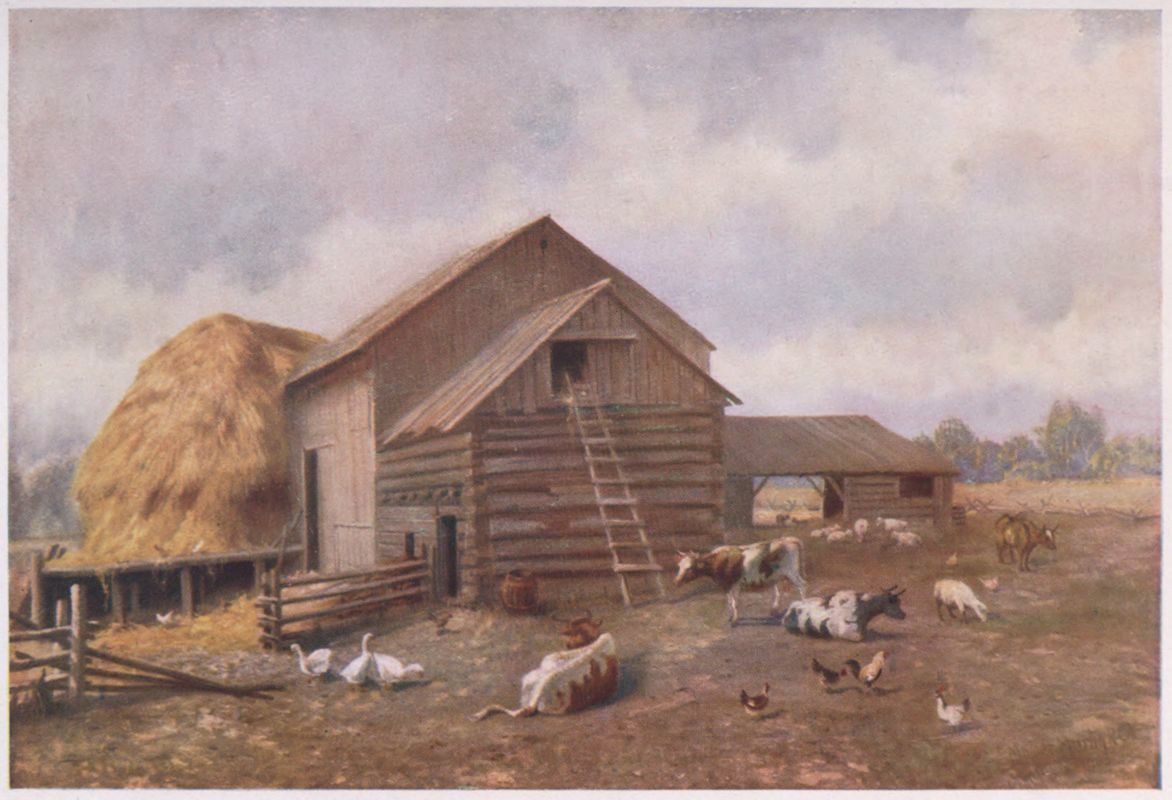
A FARMYARD IN ONTARIO
In the peninsula between Georgian Bay and Lake Erie is one of the greatest cheese, butter, and cattle regions in the world.
Ottawa, the capital of the Dominion, and situated in this province, has been called the Washington of the north. But, save that they are the two capitals of this northern continent, they have little in common. Ottawa is situated in one of the most ideal spots for the capital of a country such as ours is.
“Above her river, above her hill,
Above her streets of brief renown,
In majesty austere and still
Ottawa’s gloried towers look down.
Dim in the sunset’s misty fires,
Set on the landscape like a crown,
Loom tower and bastion, as the spires
Of some old-world cathedral town.
Here in the even, from afar,
By countryside or river breast,
Beneath the burnished evening star,
Those turrets gloom against the west.”
——
“Thou master of the splendour everywhere
Man’s soul can free it,
Whatever of beauty there be in earth or air,
Give to me to see it.”
Ruskin has given to the world his Stones of Venice. I marvel that heretofore no one has written of the stones of Ottawa.
Venice is an old-world city of an ancient and justified renown. Ottawa is the recent capital of the youngest nation of the western world. Of the older city there might be much to say, much to speculate on, much to admire, and to instruct the soul. It is a place of the past, that tremendous and fascinating ruin of man’s glory and man’s shame, his hope and his despair. Therefore it is a receptacle for material for the artist, the architect, the antiquarian, the historian, the poet, and the dreamer.
But even Ottawa is not altogether new. The past is the past, even though it be but yesterday. And it may be possible that in this metropolis of ours, founded in the mid-years of the nineteenth century, there may be much of beauty, much of truth; there may be a voice of pleasure and of uplifting, speaking from its piles of stones, raised on Government Hill; placed one upon the other by the slow but patient and godlike hand of man, shaped into forms of beauty and stateliness by his beauty-yearning soul; even as those other stones, those older, more remote structures, were raised by an earlier but similar spirit of human culture on the shores of the Adriatic.
It is not necessary to go half round the world to find beauty or truth. Just as great lessons as are taught by the Louvre and the Parthenon, may, if we are discerning, be found at our very doors. Man is here as well as there. Life is life now, as it was then. Given the same sense of life’s tragedy, the same desire for beauty and truth, for culture and æsthetic pleasure, and there may be voices even in stone here and to-day, such as spoke and yet speak in the ruins of Europe.
Athens and Edinburgh have each their mountain; Rome had its seven hills. But nowhere in the world has a city, the capital of a country, a nobler mountain than is seen from our city streets every day of the year. King’s Mountain, or mountain-range, rising above the Gatineau Hills, has a majesty and beauty all its own. To the thoughtful, all things are suggestive; and this mountain grows on one from hour to hour, from day to day, and season to season. Summer or winter, spring or autumn, it has as many moods as though it were human.
The whole range of the Laurentian Hills, overlooking the Ottawa valley, is intensely beautiful and impressive. If one studies its sublime personality long enough, the great contrast is felt between our fever of life here in the modern city, and those vast shoulders of primitive rock, monuments of earth’s age and man’s finality, which have looked down on this old river-valley since the beginnings of time.
We realise the antiquity of Venice, the ancientness of Greece and Rome; but what an ancientness is here, in comparison with which those others are but as yesterday! Mind cannot picture nor tongue speak what these hills have seen since their primal beginning. Earth holds no older stones to man’s decay, no earlier monuments to commemorate her ancient prime, than these silent prehistoric hills.
Could we only come closer into touch with the influence of their majestic solitude,
“Then might we know that silent power,
That patience, that supreme
Indifference to day and hour
Of their eternal dream.”
In summer clothed with verdure, in winter glistening with snows, their mighty bastions hold the horizon in their enfolding confines. There is a gloomy grandeur in the season of—
SEPTEMBER IN THE LAURENTIAN HILLS
“Already Winter in his sombre round,
Before his time hath touched these hills austere
With lonely flame. Last night without a sound,
The ghostly frost walked out by wood and mere.
And now the sumach curls his frond of fire,
The aspen-tree reluctant drops his gold,
And down the gullies the north’s wild vibrant lyre
Rouses the bitter armies of the cold.
O’er this short afternoon the night draws down,
With ominous chill, across these regions bleak;
Wind-beaten gold, the sunset fades around
The purple loneliness of crag and peak,
Leaving the world an iron house wherein
Nor love nor life nor hope hath ever been.”
Rome has her Tiber, Edinburgh her Firth of Forth, London her Thames, and Paris her Seine. But where can be found a stream of more magnificent sweep and flow than the Ottawa? Nature has no more beautiful outlook of stream and champaign than is to be seen from our suburbs any day of the year; and nothing is more majestic than our great limestone crags, those Titan foundations upon which our city is built.
They are the base which nature has reared, with the vast river sweeping below, on which man has constructed perhaps the noblest piles to be found on this continent. Approach Ottawa from any direction, and the first glimpse got of the city is of the splendid crown-like height of towers, turrets, and Gothic walls, with the dome of the Library and its flying buttresses standing forth distinctly, the three buildings blending as one, and giving it the resemblance to an old-world cathedral city rising from its cloistered and bastioned hill.
There are many ways in which to study these noble buildings—from afar, or near at hand; as a whole, a group, or in detail. For splendour of architectural outline they are best appreciated from a distance, especially on a summer evening, when they are between the spectator and the sunset.
Those who love a solitary walk or a delightful drive, will find a splendid view of the Parliament buildings from what is called the Montreal road, out near the quarries. From almost anywhere in this direction, if one climbs a height, they can be seen to the best advantage, rising against the west, giving in their bold outline a satisfactory ideal of architectural grandeur.
Another good view is from the Aylmer road beyond Hull. Here one gets perhaps the finest conception of the group of buildings, the cliff, and the river as a whole. Another fine view, with a splendid sweep of the landscape beyond, is that from the precincts of the Experimental Farm.
In so far as her public buildings are concerned, Ottawa has much to be proud of. No matter from which side the city is approached, by train, boat, or country road, a majesty of architecture meets the eye which is only found in some of the most famous of the old-world cities.
The resident, stranger, or tourist who is more architecturally inclined, will find much beauty in parts or partial glimpses of the different buildings, and from various directions.
The main building, approached from the front on a bright winter night, has been much admired. It seems to stand out on its crest of hill like a dream in stone, frozen and austere as the Canadian winter night itself. And yet this building is as much a part of the old world as any edifice in mediæval-built Europe.
Perhaps the loveliest view to be got of this building is by approaching it from the front, in one of those still winter evenings, when the sun has set to the west of the Gatineau Hills, and the saffron and orange afterglow still lingers along the ridge of the western sky. Here, in the steely evening, the stately building, its windows alight, looms with its pinnacles and towers like Aladdin’s palace or a crystallised fairy dream. Behind its shadowy outlines at the western end, the trees, denuded of their verdure, stand a delicately pencilled tracery against the exquisite blue and gold of the winter evening; and far above and over the edge of the horizon burn out steadfast and bright the wintry stars.
Another interesting place from which to study the main building and the eastern block, is from the approach through the Major-Hill Park. The most satisfactory time for this is on a warm morning in spring, when the buds are out on the trees, but the outlines of the walls are not hidden in their bower of leaves; or else in the autumn, when the leaves are for the most part gone. From here the fine cathedral-like appearance of the end view of the main building and the library is fully appreciated. The majestic main tower in front, the rows of lancet windows, in what would be in a cathedral the clerestory of the aisles, the two solid and massive lesser towers at the rear, and then the magnificent library, with its flying buttresses, complete one of the finest architectural groups to be seen anywhere in the civilised world.
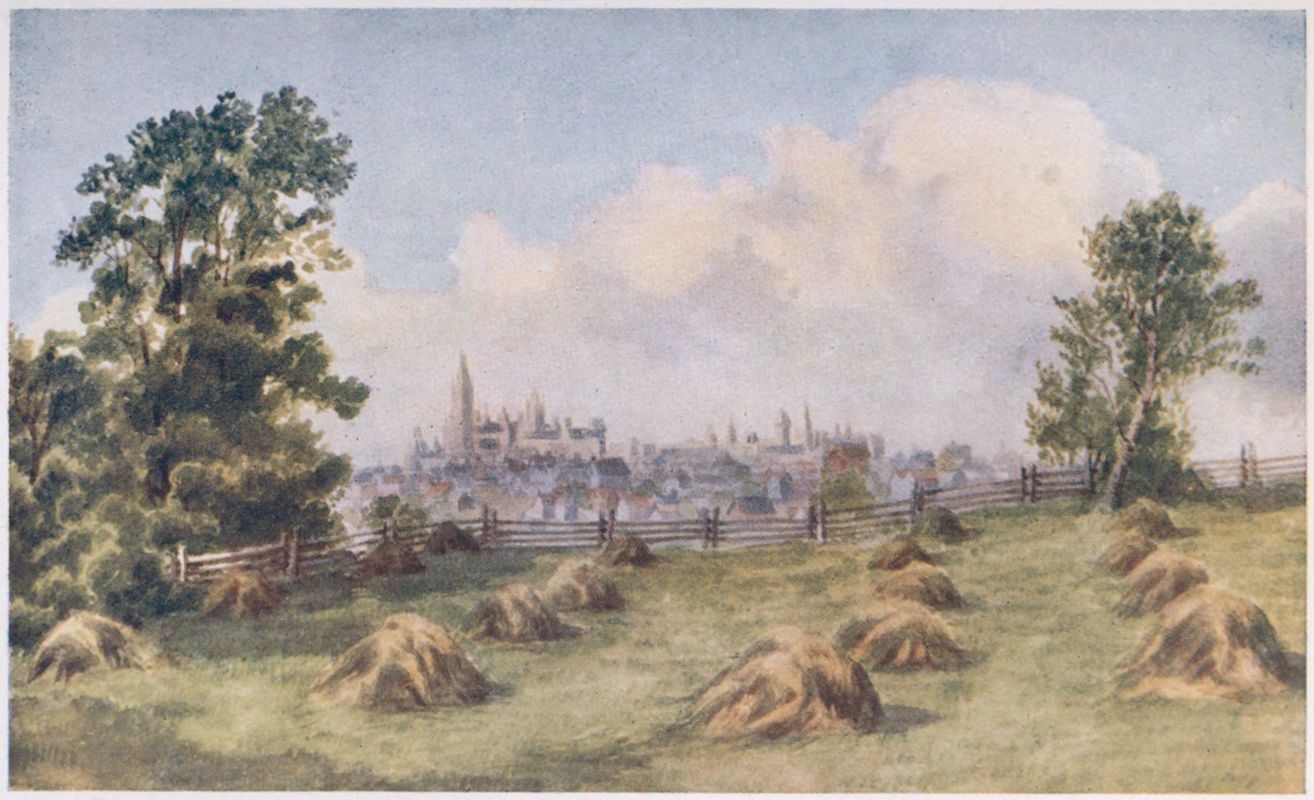
OTTAWA, FROM NEAR THE EXPERIMENTAL FARM
From this point the buildings seem to rise from, to almost be a part of and a sort of higher development of, the cliff itself. The fine rich colours in the stone-work of the walls suggest the hues in the time-stained rocks below, and the delicate shades of the birch and other trees that skirt and veil the base of the cliff. There is altogether an æsthetic satisfaction given to the beholder at the perfect sympathy in solidity, proportion, and colour between these noble buildings and their most fitting foundation.
The architect who evolved all of this wonderful effect must have been endowed with a remarkable genius; or if not, he builded better than he knew.
If the man of culture, the student of harmonious colouring, of massive and delicate outline, of exquisite blending of nature and art, of sky, stone wall, warm earth, tree-bole, cool rock, and shining water, desires to receive a pleasurable sensation, let him come here and study this magnificent picture.
But there is much more in these beautiful buildings than architectural beauty and æsthetic charm. These dreams in stone, frozen into majestic perpetuity, have infinitely more to teach the student and the lover of beauty. They are mute but eloquent volumes, appealing not only to the individual, but to the race and the history of man.
In them we can discover the whole secret of human effort. From them we can, if we care, evolve the mysterious development of humanity. Architecture is a sure indication of the spirit of the race which evolves it. The Egyptian mind was mathematical; hence we have the pyramid. The Greek loved beauty; hence we have the pillar or column, evolved partly from the idea of the statue upholding the roof. The ideal of our Western European races was to aspire, to achieve; hence we have evolved our wonderful Gothic architecture, of which the cathedrals of Britain, France, and Germany are the greatest examples.
And herein lies, perhaps, the greatest lesson which our majestic buildings can teach us. For while we speak of them as Canadian, every tower and arch, every buttress and carving, every groin and bastion, every window and doorway, is an evidence of the spirit and ideal of our Celtic, Saxon, and Norman forefathers. In these buildings we have as a people, both French and British, if we care to study them, epics in stone, revealing to us not only universal beauty and inspiration, but emblematic of our common ideal, our common artistic sense, our common ancestry, and our common Christianity.
When we approach or enter these beautiful structures, we are reminded of the old world; we realise that we are but a newer phase of Europe, a rejuvenated colony of the great old mingled races. We are encouraged by the thought that mankind is a vast family or a group of families. We are inspired by the ideals, the faith, the imagination and force of those who have preceded us. We are carried in spirit to Westminster, to St Paul’s, to Paris, to Cologne, to Rome itself. We get here suggestions of Scotland, of Normandy and Brittany. We realise that we belong to a race which has been worthy of greatness in the past, and that as our forefathers aspired and achieved, so may we, in the light of the same high ideals.
But her Parliament buildings, beautiful as they are, are not the only attractions of the Canadian capital. There are many imposing structures, among them the new main building of the Ottawa University, the Roman Catholic university of Ontario. There are many fine churches, some of them large and imposing. Here, as elsewhere, the Anglican Church holds the palm for architectural taste; and Christ Church Cathedral, occupying a commanding site, is the most beautiful ecclesiastical edifice in the city. The Roman Catholic churches, of which there are many, are very large; and one or two, like the Basilica, have handsome and imposing interiors; but they and the greater number of the Protestant churches fail, in the best sense, to add to the architectural beauty of the city.
Ottawa, from its natural position and surroundings, has many advantages. It is rapidly becoming a place of beautiful parks and attractive drive-ways. The latest of these is the new drive-way, a splendid road bordered by walks and shrubberies, which winds through the city along the banks of the Canal, and takes in many of the suburbs, connecting Rockliffe Park at one extremity with the Experimental Farm at the other. This artistic roadway is only the commencement of what the Government Commission intends to do in the direction of beautifying the capital city.
In addition to this, Ottawa has several splendid natural parks, to which art is adding those necessary touches which civilisation requires. Rockliffe Park, the finest of these, extends along the commanding and lofty banks of the Ottawa, below the Government House grounds, on the north-east side of the city. This park is covered with beautiful woodlands, and intersected with delightful drive-ways and secluded walks, giving frequent exquisite views of river, country lands, mountains, and sky beyond.
Opposite this park the Gatineau river, the largest and most turbulent of the tributaries of the Ottawa, joins its waters with the parent river. The view here of the confluence of the two streams, with the panorama of the valley of the Ottawa, the country and mountains behind, with the sweep of broad river in the foreground, as seen from the high crags at Rockliffe Park, is one of the most picturesque and beautiful scenes on this continent.
Another unusually beautiful view is that looking down the Ottawa river from the grounds and drive-ways of Rockliffe Manor, the residence of Thomas Keefer, Esq., one of Canada’s most noted engineers. From this commanding height the Ottawa river, with its shores, Kettle Island, the Ontario and the Quebec farm-lands, stretch for miles in front of the eye, the broad sweep of the river extending to the horizon; and the blue, misty hills of the Laurentian Mountains in the distant background complete a picture both beautiful in its detail and vast in its majestic outline.
One of the greatest glories of Ottawa is her river scenery. Standing as she does opposite the junction of the Ottawa and the Gatineau, and upon the confluence of the Rideau with the Ottawa, she has within her suburbs three unusually beautiful streams. The Gatineau we have already referred to, and the Ottawa is among the most majestic rivers on the continent. The Chaudière Fall, between Ottawa and Hull, in Quebec, is one of the largest Canadian cataracts, and, in the season of high water, exceedingly impressive and grand. The history of the Ottawa is a stirring one, since the days when Champlain first stemmed its tides, penetrated its upper waters, and crossed to the distant regions of the upper lakes. Since then the runner of the woods, the Hudson Bay canoe and bateau men, and the later toilers in the lumber camps, the raftsmen of its calm and tortuous tides, have associated with it adventure and toil, danger and human enterprise, which have gone to the building up of the young Dominion. From the place where its remote sources take their rise in the northern forests and wilds, to where its stately tides join with the more stately St Lawrence, every mile of its shore-land, every cascade and still water, every angry torrent and sheltering bay, holds some unwritten tragedy or romance untold in the world’s literature.

THE OTTAWA AT VAUDREUIL
TO THE OTTAWA
“Out of the northern wastes, lands of winter and death,
Regions of ruin and age, spaces of solitude lost;
You wash and thunder and sweep,
And dream and sparkle and creep,
Turbulent, luminous, large,
Scion of thunder and frost.”
The three streams in the vicinity of Ottawa are entirely different from each other in their individuality. The Ottawa is vast, majestic, and stately, as becomes so great a river. The Gatineau, coming, as it does, out of the lonely, bleak Laurentian Hills, is tortuous, rapid, and gloomy in its tides and shore-line.
Of an altogether different type of stream is the Rideau, which flows through the picturesque farmlands of Ontario until it spills its tides over its crag into the Ottawa, forming the curtain-like cataract which is one of the beauties of the vicinity. It is a quiet, peaceful, shallow stream, winding between meadows and under woodlands in shining level spaces, or murmuring gently down sleepy rapids with the spirit of a summer’s day.
Sunset on the Rideau, looking down stream from one of the bridges toward the Ottawa, is often very beautiful. The following lines give a picture of this elf-like stream:—
TO THE RIDEAU RIVER
“Across the peace of all the night’s great healing,
Beneath the silence of the dark’s hushed deep,
A phosphorescent, ghostly spirit stealing,
You softly slide, a sleep within a sleep.
You slip and shine, by boughs that bend to kiss you,
You dream by curved banks of shimmering green;
And where you swerve, the alien meadows miss you,
But happy are the banks you glide between.
Out by dim hazy shores, in reedy shallows,
The drowsy cattle sun them in the heat;
And far from woody slopes and ragged fallows,
A lazy wind goes loitering in the wheat.
By pebbly shoals, whereon your tides are driven,
In silvery surge and far-heard slumbrous song,
Your sleeping shores and the white hosts of heaven
Hearken your tender droppings all night long.”
Close to Ottawa, on the high, sloping countryside, is the Dominion Experimental Farm. This is not only a beautiful park, the grounds being laid out in artistic and picturesque manner, but it is also one of the most successful agricultural and forestry experiments on the continent. Situated on its commanding site, overlooking Ottawa and the Ottawa valley, it comprises several hundreds of acres in all conditions of expert tillage and successful plantation. The groups of buildings, handsome in their exterior, house and give office room to a corps of specialists, some of whom, such as Professors Saunders and Fletcher, are leading authorities on both continents in their own line of research and experiment.
Unlike other Canadian cities, Ottawa came into existence with the Confederation. Prior to that time it was a busy but crude centre of the lumber trade of the Ottawa valley. It was then known as By Town, being named after Colonel By, a British officer, who was sent out by the British Government to oversee the construction of the Rideau Canal, which was built as a military work, and which connects the city of Ottawa with the older city of Kingston on Lake Ontario.
Ottawa being the capital of the country, has since confederation been closely associated with Canadian politics and political and administrative life. The Dominion Parliament meets here each year, bringing a great number of people representative of her political life from all provinces of the Dominion. The civil service, which comprises some thousands of officers and clerks, makes up a strong element in the population. Its members are drawn from the peoples of the different provinces. The Premier and the members of the Cabinet, the Judges of the Supreme Court, and the chief officials of the Dominion also reside here; so that the city has a population more representatively Canadian than that of any other in Canada.
Here in the season, when Parliament opens, it brings together many of the most prominent personalities which the country has produced.
Perhaps the most important building in Ottawa, next to the Parliament buildings, is Government House, the residence of the Governor-General of Canada, who represents the Sovereign, and is the head of the Canadian Executive. This place is not only the centre of official life; but it is also the Mecca of Canadian social ambition. In what is called the season, the brilliant social functions held here are a fair replica of British Court life in the old land.
Short as has been the life of the Dominion, this residence has already been associated with the Vice-regal careers of many distinguished noblemen—among them Lord Lisgar, Lord Dufferin, the Marquis of Lorne, Lord Lansdowne, the Earls of Derby, Aberdeen, and Minto, and the present distinguished representative of the King, Lord Grey.
The building itself, as a sample of architecture, does little credit to the city or the Dominion. It is really a series of additions to the original house, which was a private residence; and the Government has spent enough money on it to have built a really handsome Vice-regal residence. It is now, however, a large building, quite comfortable, I am told, within; and as the Government contemplates making a large addition to the front, it will in time, no doubt, make, if not an ideal, at least a serviceable Vice-regal residence; and as the present Governor is striving to make its interior artistically handsome, as well as serviceable, and to form therein the nucleus of a national portrait gallery, it must become, as time goes on, more and more a centre of national interest.
Ottawa has also been closely associated with the lives and careers of many distinguished Canadians; prominent among them Sir John A. MacDonald, Alexander Mackenzie, Howe, Cartier, M‘Gee, Brown, Blake, and Laurier.
Here MacDonald died in the full honours of old age; here M‘Gee, the great Irish-Canadian statesman and patriot, was assassinated in the very prime of his career; and here, to-day, resides that other great Canadian, Laurier, on the avenue which bears his name, and which is one of the most beautiful in this city of picturesque streets.
The interior of the House of Parliament is very handsome, and contains in its spacious corridors many fine portraits, and a few of great value, of British sovereigns, governors, Canadian statesmen, and speakers of both Houses. In the Senate, a spacious and beautiful chamber, there are two splendid portraits of George the Third and his Queen, both painted by Reynolds, and regarded by experts as very valuable specimens of eighteenth-century art; also a fine portrait of Queen Victoria, painted by Partridge, a Court painter of the day; and in the Commons are the two new pictures of Edward the Seventh and Queen Alexandra, by our own able artist, Colin Forbes.
In the passage leading to the library are two large paintings of two famous Canadian Premiers, Sir John A. MacDonald, and his Liberal opponent and fellow-Scotsman, Alexander Mackenzie. Sir John is painted in his Windsor uniform, and is a strong contrast to the simple, severe type of Scotch reformer of his day, represented by Alexander Mackenzie.
All of the portraits, including a very fine and characteristic one of the famous Joseph Papineau, the fiery and headstrong but eloquent rebel, are worth studying as representative of the types of men who were prominent in the political life of Canada during a great part of the nineteenth century.
One of the strongest influences in the struggle against materialism in any country is that of art. We, in Canada, while we have a growing school of painters, have yet much to accomplish in this direction. The artist, like the man of letters, has generally to struggle for a livelihood in common with his fellow-men, while he is perfecting his work, and striving to attain his ideal. If we only had a larger constituency of people able, as well as willing, to buy good pictures, the path of the artist in this country would be made smoother. We are, however, on the whole a poor people, and many of those who have the greatest admiration for the work of an artist cannot afford to possess his pictures.
But art in Canada has before it a great field in the future, and as the country develops its appreciation is sure to grow. We have for the landscape artist a world to revel in, of sky, wood, water, and hill; of many changes of seasons; of beautiful colour, mood, and atmosphere. What can be more exquisite than the many aspects of our late summer and autumn, for the artist who is sympathetic with the delicate subtleties of nature? But art does not mean landscape alone. There is the type of the people; and we have many types here, as our best artists have already begun to reveal. Portraiture, also, a very difficult, but ambitious and remunerative branch of art, is growing in Canada. Then there is a region of art scarcely as yet trodden by our artists, that of the painting of historical pictures.
The names most prominent in Canadian art are those of Harris, Watson, Forbes, Brownell, Reid, Martin, and Forster; though we have a great many others doing unusually fine work.
In sculpture, we have two native Canadians who have made a reputation outside of the country. Of these, Hebert, the distinguished French Canadian, is pre-eminently the Canadian sculptor, and his statue of Queen Victoria on Parliament Hill is the finest witness to his gifts in the capital of the Dominion.
The other man is the brilliant Canadian sculptor and professor of anatomy, Dr Tait Mackenzie. Mackenzie’s rise into fame is no sudden success, though his recent triumphs in the great art-centres of England and France have followed one close upon the other. His present recognition as an artist of ideal and accomplishment is the result of years of patient, persistent study, and determination to put into shape and form the artistic genius which he possesses in no small degree.
Hamilton M‘Carthy, though not born in Canada, is Hebert’s rival in this country; and many public monuments over the Dominion have been modelled and constructed by him. There has also lately been added to the sculpture of the capital a beautiful bronze, representing Sir Galahad, erected to the memory of the Canadian hero, Harper, who was drowned in the Ottawa, while attempting to save the life of a young lady, and whose biography, by his friend, Mackenzie King, has been so widely appreciated. Harper without doubt represented the finest type of our young Canadian; and as it was in Ottawa that he died, and in the capital of his country that he was working out his life-ideals at the time of his death, and where his statue now stands, it would be fitting to end this description of Ottawa with the following lines of verse depicting the heroic end of this ideal representative of Canadian manhood:—
“In the common round
Of life’s slow action, stumbling on the brink
Of sudden opportunity, he chose
The only noble, God-like, splendid way,
And made his exit, as earth’s great have gone,
By that vast doorway looking out on Death.”
THE CANADIAN SEASONS AND WOODS
That this northern land of ours is one to inspire the poet and thinker, cannot be denied. There is something in its great beauty of nature, in its rigour as well as its almost tropical warmth of climate, its wide lakes, great streams, elusive mountains, and vast northern forests, to appeal to the poetic and contemplative nature.
The locality surrounding Ottawa is, on the whole, quite representative, in its moods of sky and earth, of the Canadian seasons; and nowhere in the whole world are the various seasons of the wheeling year more beautiful and distinctive than in Canada.
Though one might make an exception of the springtime, which is sometimes sadly disappointing, yet, when she does appear in her true character, Spring in Canada is as elusive and elf-like as she is delightful.
When the bleak days of March have faded out like smoke from the horizon of time, April is here. For all the raw airs and frosty, chill mornings, there broods behind them the spirit of springtime. The wizard is piping his magical note: the awakening is at hand. Out of the caverns of winter, out of the dull days, the biting, wizened nights, out from despair and sense of sin and defeat and possible death, man the dreamer feels a triumph of the spring in his heart; and, with the other children of earth, takes up anew the mysterious lease of existence, and feels, with the bird and the bud, the old, eternal, elemental joy and hope.
The two uppermost instincts at springtime are those toward beauty and joy. It is difficult for anyone to be sad at this mystic season; and to true happiness nothing can be abhorrent or ugly. All life reclothes itself with a mist of glamour. It is the bridal season of our universe; and man cannot, without wrong to his own nature, absent himself from the spirit of this festival.
To the true disciple of earth, beauty is never absent from the face of nature. But there is one beauty of summer, another of autumn, another of winter, and another of the spring. Each has its own beauty, and yet they are the same beauty. There is the beauty of the soul, and the beauty of the body; there is one of life, and another of death; and yet they are elementally the same.
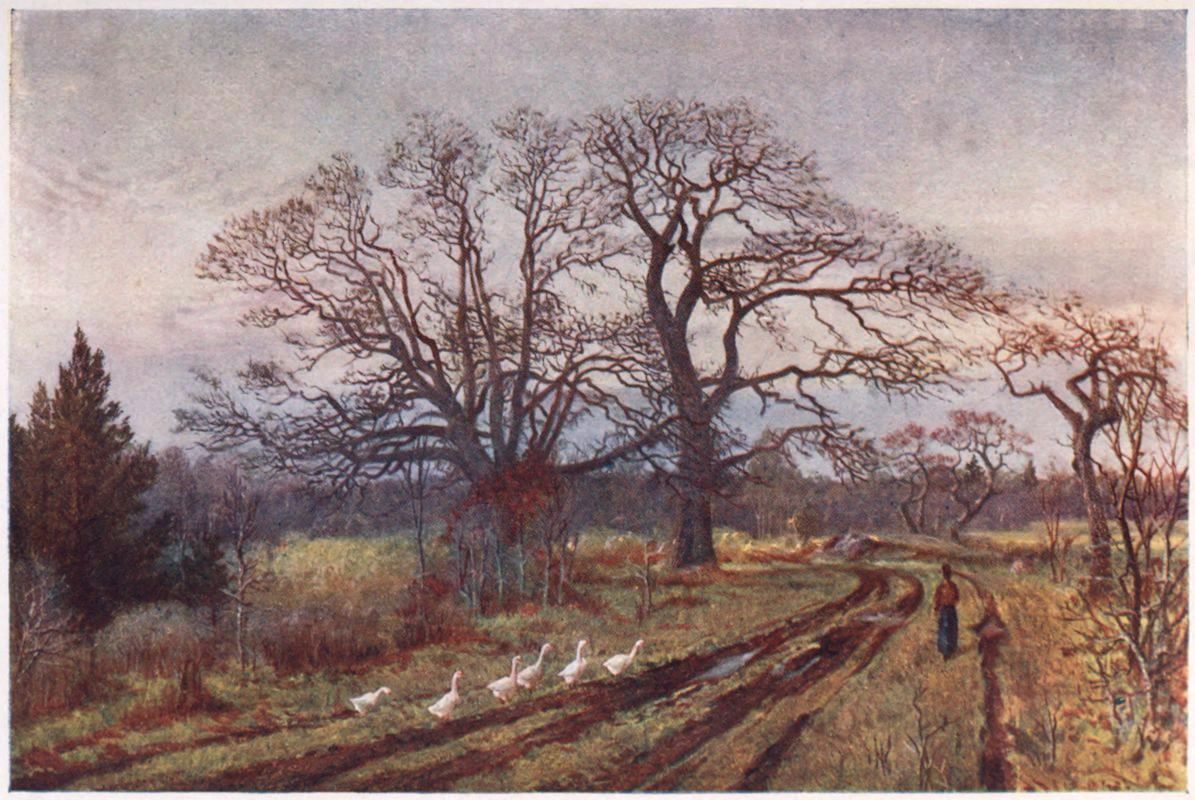
EARLY SPRING, NEAR VICTORIA, BRITISH COLUMBIA
The beauty of spring is the ever-mysterious and eternal garment of the spirit of youth and life. It is not seen in any special place or hour or resurrection, but in all things, and at all hours. Midnight, dawn, mid-day, evening—all know its presence, invisible, veiled, but which nevertheless walks forth by hill and valley, and brimming river and manacled lake, proclaiming as of old, “I am the resurrection and the life.”
To the student of the universe about us, the season of spring is evident even before it actually has approached. In truth, though the season of the March equinox is regarded as the gateway between muffled, arctic storm and
“April and her wraiths of tender rain,”
yet so soon as the sun turned north from his winter solstice at the close of December, so soon as he began to renew his strength and to put forth his benign power, just so soon did the magic of renewing life assert itself. Long before the world was ready to put on its bridal garments of resurrection, was the mystery of preparation working its inevitable law. The wonderful beauty of softness, of expectant maternity, was revealed in the misty veils of the night-skies of the later January and February, in contrast to the steely glitter of the stars of December.
Thus the premonitions of the great change are already at hand:
“And the landscape, chill and wan,
Softer aspect taketh on;
Something mystic, magical,
Hovers, glamours over all;
Then a film drapes the skies,
And the night hath softer eyes;—
Something in the heaven aglow,
Something in the earth below,
Toward glad dreaming turns the brain,
And the heart grows young again.”
But while we are still meditating upon the delicate beauty of spring, the season has fled, and June is here; and he who experiences our summer season can scarcely fail to appreciate the luxuriousness of its splendour. The Canadian summer, next to the Canadian autumn, is the finest season in the whole world.
There may be climates where the seasons are more steady, more gradual, and even milder; but for a pure elixir of sun and air, the tonic of out-of-doors, there is nothing that equals the Canadian summer. The only appreciable drawback to this season is its shortness and the suddenness with which it comes upon us. In some parts of Canada we have little or no springtime. The winter appears to continue on into April. Then there is a period of wet, or cold, dusty days, lasting for some weeks; when suddenly, without any warning, we are launched into the heat and verdure of the Canadian summer. Of late years June has been a cool month with us. It seems to assume the characteristics once supposed to belong to the month of May.
However, when the height of the midsummer is passed, then begins, to my mind, the most delightful season of the whole year—the rich, ripe days, with the cool, deep-bosomed heaven of the brooding nights. It is now that one enjoys being out-of-doors by field, wood, or water. In these days the whole of our Canadian world puts on a veil of delightful glamour. Over the countryside there rests a silence and a peace that is at once glad and mournful. All nature seems in a mood of quiet contemplation. It is the time of the year when men should forsake desk and counter and the sordid cares of the busy street, and get out-of-doors, away, alone, in some deep, cool wood, or by some wide water; when they should get away, for a time, where the chains of care cannot clank, where they may measure the petty strife and the shrivelled ambition in the light of the vast spaces and the eternal silence. This is the truest medicine, the best specific for the average life-jaded, toil-ridden man.
On the sward outside of my window, beside which I sometimes work, there is a clump, or rather patch, of corn-flowers. They grow, just a common weed, by the roadside, untended, uncared for by the hand of man; and yet in all the gardens of earth there can be no more beautiful sight than the delicate blue of those flowers, like a patch of the sky down-fallen. The corn-flower is generally a part of the Canadian roadside August landscape. It beautifies the borders of our country ways; and its delicate azure seems in fit harmony with the late summer’s smoky light. Together with the golden-rod, another glorious Canadian weed, it gives a warmth and a beauty to the ripeness of summer ere the richer, more glorious torches of autumnal death have lit our hills and dales with their spectral splendours.
Now is the time when
“Dreams of beauty here inspire
All the summer’s radiant fire,
In the gleam of leaf and bird,
Ere the autumn’s voice is heard,
Fluting soft her woodland tune
Down the golden afternoon.
Where the seaward ships go down
By some ancient Norman town;
Where the northern marshes lie,
Golden under azure sky;
Where the northern woodland glooms,
Luminous in leafy rooms,
With its ancient sunlit wine,
Under shade of smoky pine;
Here the soul of silence broods
Under haunted solitudes;—
Here that spirit rare and pure
Of the muses who endure,
Dreams with wisdom’s quiet eye,
While the phantom years go by.”
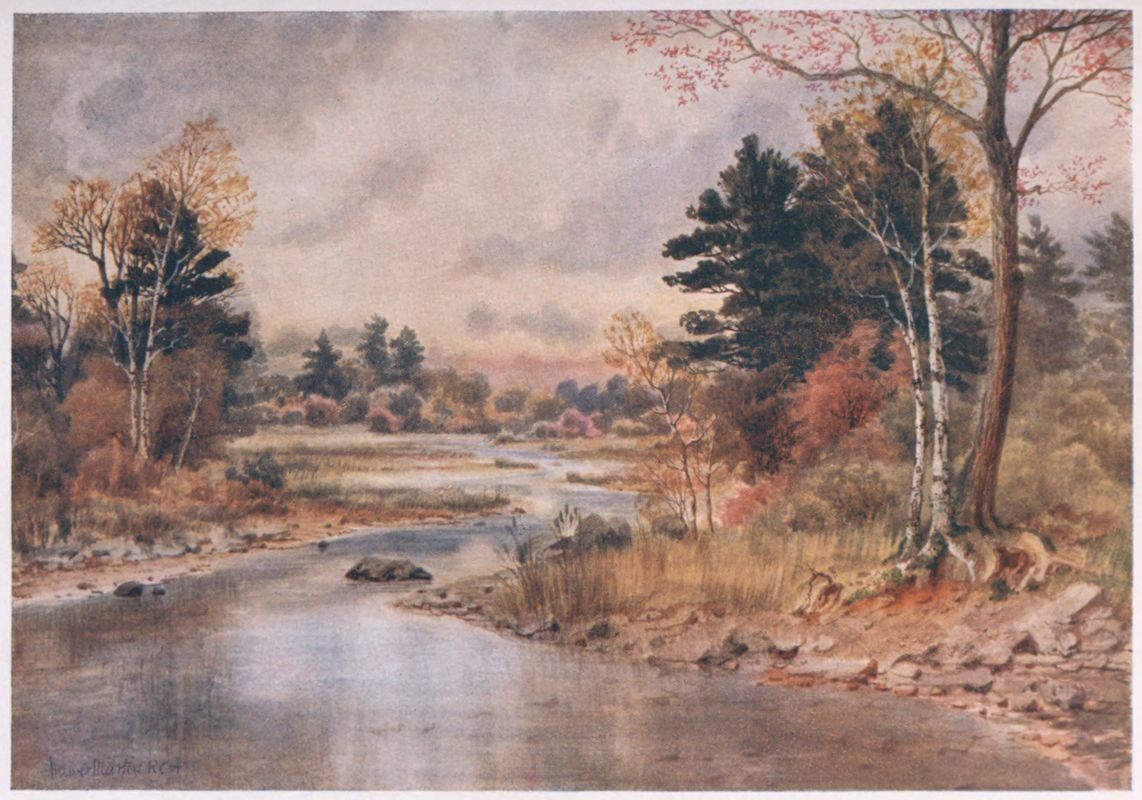
AUTUMN IN NEW BRUNSWICK
At this time of the year, there is no friend which the contemplative soul should get more intimately acquainted with than the Canadian forest. This great, patient, brooding friend of the soul gives to us bounteously of its blessings, its comfort, its healing, and its lessons; and takes naught from us in return except our weariness, our heart-sickness, and our despair, which we lose as a cast-off, worn garment, in the beneficent peace of its leafy glooms.
There is indeed an analogy to our life, and even to the genius of the various races and to history itself, in the very nature around us. We can see so much of our ideal in our environment. There is a very character in the trees of the forest that suggests great human heights of ideal. I can never enter a beech-wood without being reminded of everything which culture attributes to the classical. The beech-wood is purely Greek in all of its spirit and characteristics. If satyrs, nymphs, and goddesses ever wandered on earth, it would have been in such a place, where these trees mostly do congregate. There is something about the beech-tree itself, in all its form and character, which suggests statuary—the pure smoothness and perfection of trunk and limb; the firmness of the leaf, with its copper-brown in autumn, which suggests beauty in form, and delicacy of colour and finish in outline. There is a pure finiteness, a sense of art, which the beech-wood is typical of in its personality and environment. Its whole influence is classical and Greek in its sensuous effect. It suggests culture, outward beauty, simplicity and finality. And this is true of the whole Greek ideal. It was the dream of achievement which left nothing to be desired or completed. It gave life all which it had to give; as if its conception of beauty and truth in the perfect curve froze into immortal crystallization in the sculptured Apollo and the Venus of Milo.
It was nearer the ideal human type than was ever reached before or since, in so far as perfection of form is concerned; and this perfection, this exquisite sense of external beauty, fills the precincts of the beech-grove, as the warm morning sunlight permeates its leaves with its amber wine. In a sunny beech-grove one may dream of satyrs and fauns; one is very close to nature in the pagan sense. It is the home of the artist whose dream is landscape and form. Corydon might come here to meet his Phyllis. Watts or Gainsborough might have sought here for exquisite colour and tone. It is all charm and rich fancy; quite a realm of golden imagination:
“As though in ages long ago,
Before its dreams began to grow,
Some startled, fleeing dryad hid
Within its leafy coverlid;
Enmeshed her silvern reveries here,
And filled its shadows with her fear.”
But whoever entered a beech-wood with a sense of reverence? He came and went as a pagan. If he learned to love earth here, he learned to love it purely as earth. He found, perchance, joy and charm, melody and beauty, but never sublimity.
How different it is from the beech-wood in the shade of the mighty elm, the maple and the bass-wood! Here the sense felt is purely Gothic. One feels at once a solemnity, as if entering a great cathedral. The sense of beauty, form, and finality is lost in reverence, sublimity, vastness, and infinity. The soul can easily understand how such a mighty arched solitude would suggest to the architect those great Gothic structures which represent in Europe, in piled and carved stone, the aspiration and reverence of the Christian spirit.
There is a beauty here, but it is of another, more indefinite nature; as if body was lost in soul, and earth had faded into heaven. The merely sensuous seems merged in the vaguely mystical. Here also is another sort of austerity. It is not that of form, though it has used somewhat of the other ideal, as it were, as a basis. But what was before for pure enjoyment, is now put to a newer, larger, perhaps vaguer, but greater use. The God has risen to the heaven, more elusive, more difficult to attain to. But gradually dwelling in this dim, architectural dream of man’s relationship to Deity, has man arrived at the suggestion of character, and out of the mystical soul-struggle achieved the realisation of the human personality, as apart from the mere type, and human responsibility, as an advance in evolution from the grim fatalism which rounded the Greek environment.
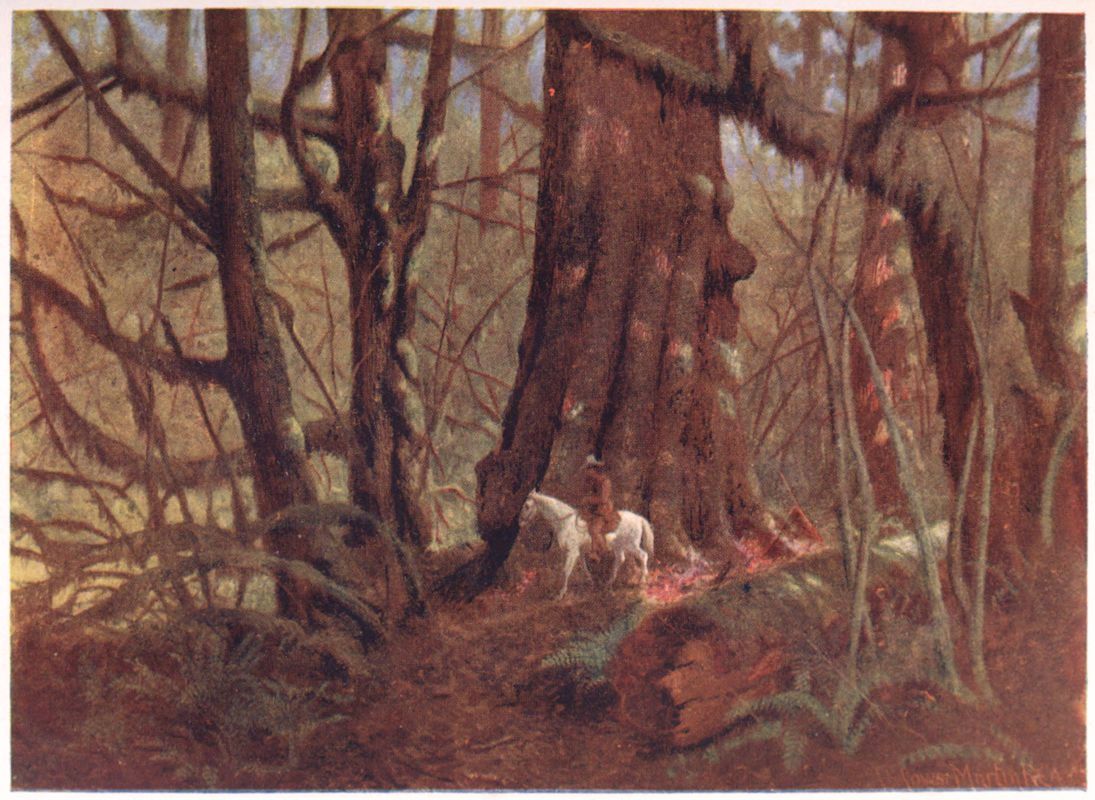
BIG SPRUCE IN STANLEY PARK
Where man was once content to merely enjoy, he now aspires. He is no longer the child of a fixed ideal, but he is filled with a vague unrest. He has set out on a far journey.
All this one learns, if he listens and dreams in the great forest. It is not only mere tree-trunks and branches and leaves, and far-off glimpses of sky. But it gives a sense of vastness, of reality, of a spiritual revelation emanating from this vast mantle, this Gothic temple, revealing what may be hidden under the deeper meanings of human life.
Far different from the others is the identity of the pine-forest. As the beech-wood is Greek in its suggestion, and the maple and elm-wood Gothic, so the pine-wood is in its whole character distinctly Celtic. There is an undefiled wildness and a sense of primitive savagery under its mighty shades, where in the stillest day one could hear one of its needles drop for half a mile, and where at other times the wind roars like the Atlantic in the swaying tops. Its poetry is more that of Ossian than of Homer. Everything here suggests withdrawal and seclusion, that almost childish pride in self which is so true of the Celt. There is that shadowed gloom which seems to hold an imagination peculiarly its own. And the sunlight which reaches these deeps seems to stab with a passion that only the true Celt can feel.
There is a sense of awe which pervades these precincts. But it is not the spiritual reverence of the Gothic aisle. It is the sense of the unknown, felt by the child of the primitive world, when he first found himself alone. There is a kinship here to the ancient Hebrew idea of Deity, as He walked “in the garden in the cool” or the wind of the day. It is not the bending down, spiritual Deity, but the god of the primal world, aloof and alien from man, feared and sought only in the fierce elements, and propitiated only in human sacrifice and physical delight.
There is no season of the year more beautiful than that of the fall of the leaf, when out by wood and water, or far afield, the year casts its mantle of red and gold or russet brown. We have many splendid trees in Canada, but among them there are those which are more than others distinctively autumn trees. Outside my study window is a maple, which of late has been a mass of gorgeous gold. Its leaves, motionless in the frosty air, or wakened by the slight stir of the breeze, are a beautiful etching of ruddy gold against a blue background. The singular beauty of the maple is that its foliage is diaphanous or light-shedding; and, green, or red, or gold, it is full of sun. Even on what is called a grey day, the maples stand like luminous torches in the autumn landscape. The maple is pre-eminently an autumn tree, and in the streets of our towns, or in the woods, at the autumn season, the walks or forest-floors, and even the pools, are leaf-paven with its exquisite foliage.
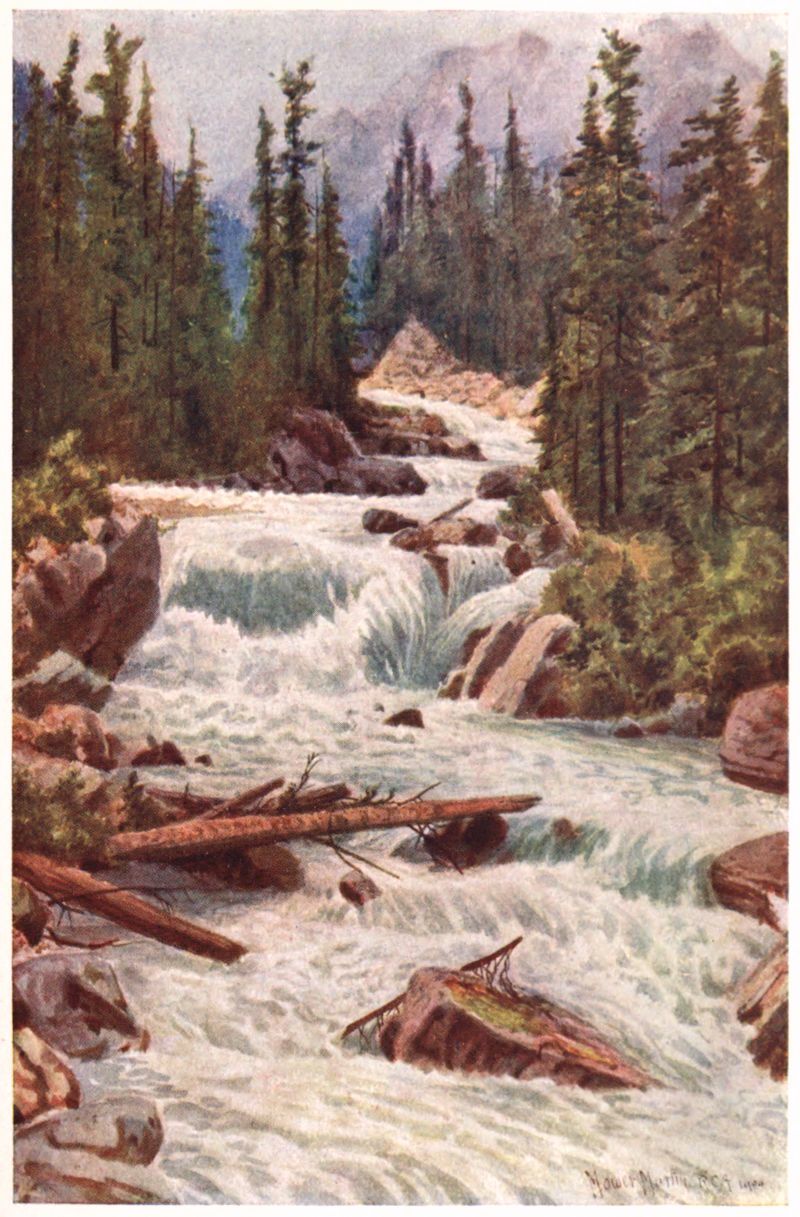
FALLS ON THE ILLECILLEWAET RIVER, SELKIRK MOUNTAINS, BRITISH COLUMBIA
Another tree which adds its beauty to the Canadian autumn is the beech. Though its leaves have not the brilliant ruddy tinge of the maple, they have delicately veined shades of their own, partly green and partly gold. Then the rich copper and bronze tints it also takes on are in keeping with the other colours of the season. There is a variety of stunted beech whose leaves are very effective in their many shades of green, brown, and gold. But one of the chief qualities of the beech is its form and personality as a tree. A well-formed beech-tree is a really classic bit of nature. No tree has such smooth, clear-cut, rounded trunk and limbs; and its delicate frieze of boughs and twigs against an autumn skyline is one of the finest objects in our landscape.
Of all our foliage, however, give me, for true finished beauty, the leaf of the oak. There is no doubt that the English people made a wise and instinctive choice in taking the oak as emblematic of their national character. This tree is not only one of the most stately and durable of all the forest family, but the leaf, with its firm, wax-like appearance, has a distinct and peculiar beauty of its own. As often as not, the oak leaf in the autumn is brown. But when you find its hues of a brighter shade, they are of a deep, wine-like, garnet-coloured red, even more beautiful than, though not so brilliant as, the maple.
Any person visiting Rockliffe Park about the season of the middle-autumn, will notice the rich, dark glow of the scrub oaks, like some late, flame-like flower, against the lonely, grey, denuded landscape. These scrub oaks are very hardy, and therefore seem to hold their foliage longer than the other forest shrubs and trees; following the law that the tree which keeps its leaves green the longest, and ripens more slowly, is the one of slower, hardier growth and stamina; while those shedding their leaves earlier, and assuming sooner the hectic blush, as in the case of the swamp maple, are the more perishable of our forest children.
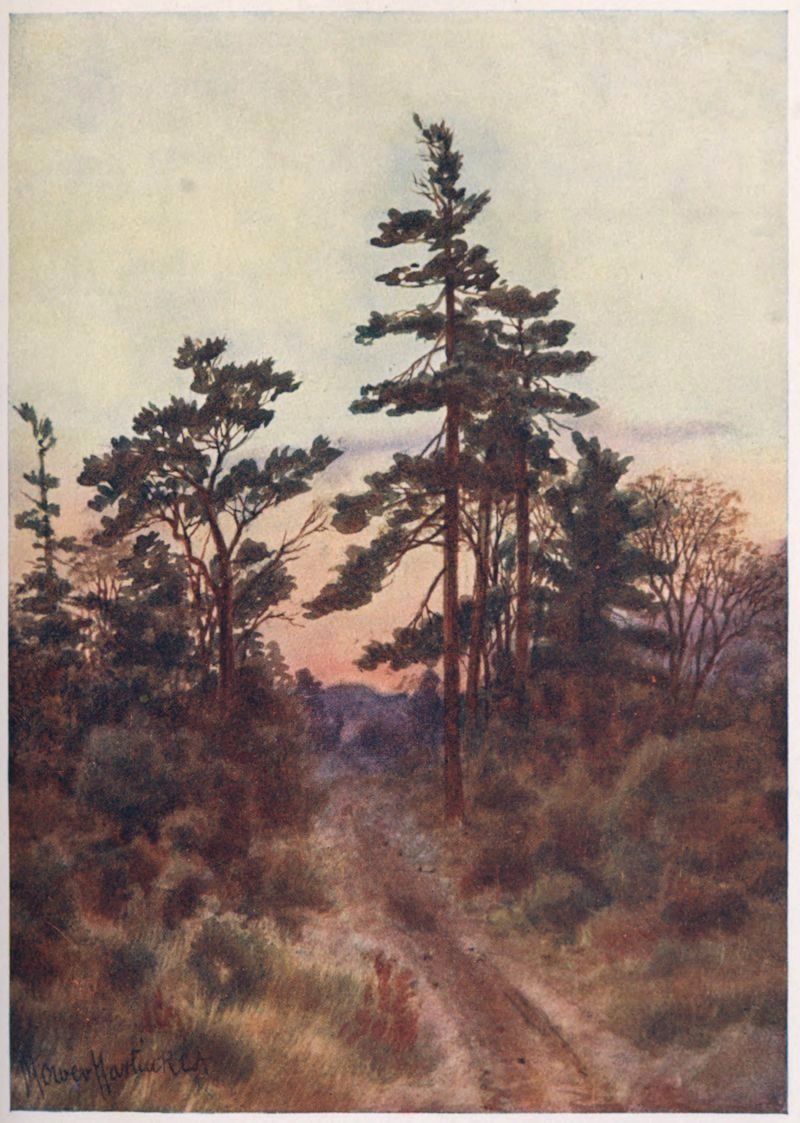
ROAD NEAR VICTORIA (EVENING)
The elm, a stately summer tree, and one of the greatest beauties of our summer-lands, where it towers in its majesty, out by pasture, roadway, or stream, has no especial beauty in its foliage during the autumn season. Its leaves turn a light yellow or a faded brown, and soon drop off. But the beauty of this tree in the early autumn is not to be found so much in itself, as in the deep red of the woodbine, often found clinging to its stately trunk. Later in the autumn, in the windy, bleak days or the wild nights, its bare branches assume a gloomy grandeur and a spectral loneliness of outline against our November landscape.
Another autumn tree, and one of our most characteristic, though never more than a large shrub, is the sumach, whose feathery scarlet frond adds colour to our bleak hillsides, where it seems to thrive best among the rocks. Next to the maple, it is the most brilliant in leafage of all our autumn trees.
For many years back, that alien tree in the Canadian landscape, the Lombardy poplar, long after all the leafage has faded from the forest, has stood out alone, with its late-turning leaves a rich, glowing gold, paler than that of the maple, but singular in its still rich glory against the desolate grey skyline. Without doubt, the remarkable brilliancy and beauty of our Canadian autumn foliage is owing largely to our sharp, dry atmosphere, and to the quick frost-change, in temperature, from warm to cold. In this northern climate, especially in the province of Ontario, this land of bracing airs—
“This short Canadian summer,
Whose every lonesome breath
Holds hints of autumn and winter,
As life holds hints of death”—
there will always be a more than ordinary beauty of autumn foliage.
What a delightful experience it is to walk abroad at this season, through the “long-drawn afternoon”—all smoke-haze and slanting sunlight, amid the woods and fields, which, in their gorgeous or sombre garments, stand spectral and deathlike!
What a wonderful procession of thoughts and imaginings upon life and death now pass through the mind! If, as is mostly the case, the wind is dead, how still all life seems, remote and far away! I sometimes think it strange, with our autumns to influence us with their sombre and desolate grandeur, that we are not a more thoughtful and imaginative people.
The last of our Canadian seasons, and not by any means least, is that fierce, that arctic, and yet, to the healthy life, genial and inspiriting period, our Canadian winter.
“Over these wastes, these endless wastes of white,
Rounding about far lonely regions of sky,
Winter, the wild-tongued, cometh with clamorous might:
Deep-sounding and surgent, his armies of storm sweep by,
Wracking the skeleton woods and opens, that lie
Far to the seaward reaches, that thunder and moan,
Where barrens and mists and beaches for ever are lone.
Morning shrinks closer to night, and nebulous noon
Hangs, a dull lanthorn, over the windings of snows:
And like a pale beech-leaf, fluttering upward, the moon,
Out of the short day, wakens and blossoms and grows,
And builds her wan beauty like to the ghost of a rose,
Over the soundless silences, shrunken, that dream
Their prisoned deathliness under the gold of her beam.
Wide is the arch of the night, blue spangled with fire,
From wizened edge to edge of the shrivelled-up earth;
Where the chords of the dark are as tense as the strings of a lyre,
Strung by the fingers of silence ere sound had birth.”
In spite of all our privations, our constant struggle with nature, we Canadians are among the happiest of earth’s people—we who dwell in this temperate belt of the northern zone. They who exist in the sweltering torpidity of a torrid heat, or who never have but one season the year round, cannot be said to really live as we do, who are children alike of the midsummer sun, and of the bitter arctic frosts.
The person who lives much indoors during our Canadian winter loses, to that extent, a great deal of life’s humanity and life’s enjoyment. To do so is to become like a burrower underground, which hibernates without any sense of existence. To live in the true sense, in this northern zone, man has to fight nature; and to conquer nature one has to meet it out of doors. If we do not, we are but the victims of the smiting sun or the biting frost. Therefore it is our bounden duty to ourselves to meet the winter in the broad open; to dare this cruel smiter, and genie of frosty sleep, and make him our friend.
Childhood and youth do this by nature. Life by instinct loves to be away from roofs and walls, and under the ever-moving sky. It was never primarily intended that man should live for the most part of his conscious existence shut up in an artificial cell. It is only through a long development of over-civilisation that men have grown to forget that the heaven is their roof, the earth their floor, and the mountains and the hills their walls.
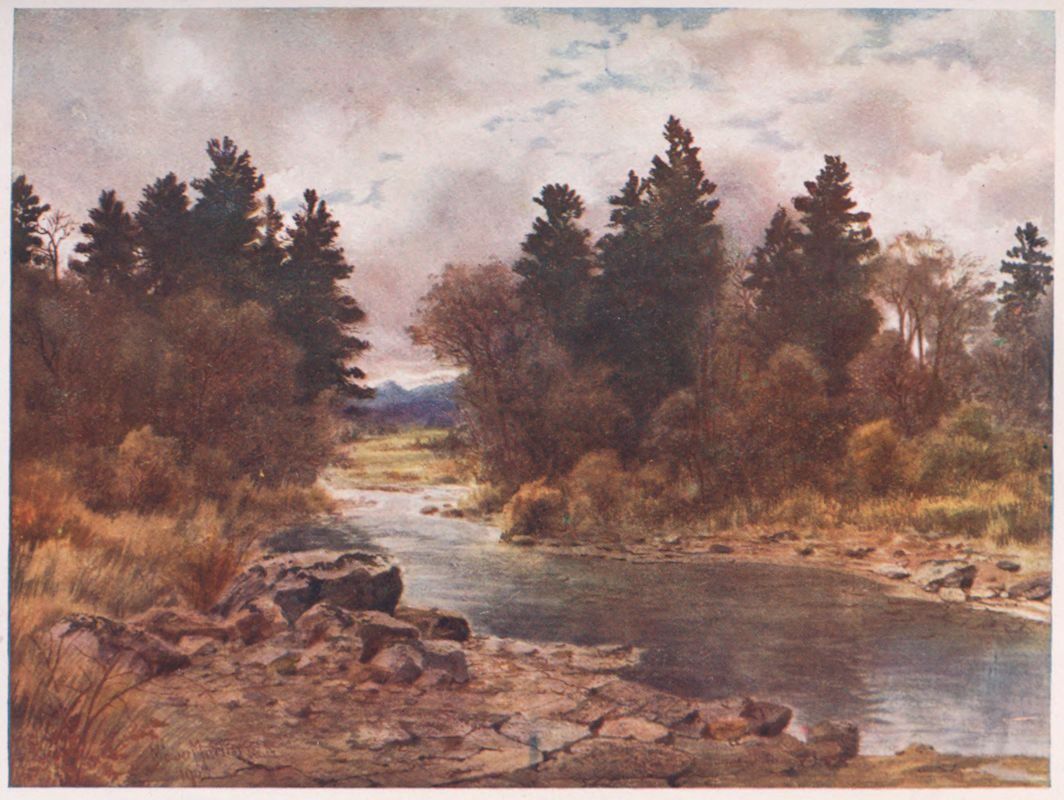
WINTER-TIME IN VANCOUVER ISLAND, BRITISH COLUMBIA
The world has, in its time, invented many kinds of footwear. But there is nothing, in its place and in its season, more comfortable and delightful than the moccasin; and there may be all sorts of means of out-of-door recreation, but for true pleasure—that is, quiet and thoughtful pleasure—nothing can equal the old-fashioned snowshoe. If one wants to appreciate the winter day, he may take his skis and enjoy the exhilaration of shooting down some of our many hills. But, better still, if alone, or with a suitable companion of like mood, to bind to moccasined feet the wing-like snowshoe, and join the ghostly company of the walkers of the snow.
Some winter days are as keen and biting as the ringing steel of the skater. Others are as soft and dreamy as a day in August. The latter is the ideal one for the lonely snowshoe tramp. Out away from roads and the hurry of streets, the wide fields are reached. Then the river waste, and the forest edge, gloomy and still, with its hood of snow and icicled branches, creaking in the wind, or ghostly and glinting in the frozen sunlight. Under the woodland, ragged, desolate and skeleton-like, the snow scurries in fine drifts, or lies silent against the mossy bark of the huge tree-trunks which reach toward heaven.
Far outside, away to the wintry skyline, stretches the lonely world of river, hill, and plain, bleak in its ghostly covering. But under here, there is a sense of comfort and companionship in the very trees themselves. There is a wonderful and austere beauty of the lower landscape. The giant elms, maples, beeches, and bass-woods rear their great trunks, like pillars holding up the sky, and spread and interlace their lofty branches, like the fretwork and groined arches of some old-world cathedral. The slim birches, in their delicate cream-white bark and tremulous branches, seem rather as the ghosts or the dead souls of trees among the more rugged and towering forms about them. The wind steals now and anon past, with a phantom voice, in the undergrowth, till even the pale, bleached, dry, brown, mullein stock finds a lonesome music of its own, reminiscent of the summer dead and gone.
Up on the wooded hillsides, the light peers in more often; but down in the deeper shadows, where the tree trunks are greatest, and the scrub oaks grow; there is the hushed isolation of a complete and inviolate solitude. If one looks close in such places, he will see on the glistening surface the tiny roadways of the mute and shy denizens of the wood, the rabbit, the squirrel, and the wood-mouse; often disappearing in some sheltered opening at the branching root of a tree, or under some upturned stump of a decayed forest father, long fallen to his place of sepulchre. He will discover their tracks thickest where the low cedar branches, the delicate young shoots and ground-twigs are to be found.
But intimate must he be with these solitudes, and loving of their grey twilight silences, who may ever hope to get acquainted with the timid earth-creatures who inhabit their depths. The stray passer-by may trespass on the streets of the underwood village: he may see the fairy door-stone, and mark the footpath of the indwellers; but it is only to the rare intimate that they reveal themselves in their shadowy fastnesses.
There is another suggestion of life to be found here in the forest brook, hooded in snow and ice-bridged, like a singing gnome at work in his silvern cavern. There is also that eerie fiddler, the winter wind, in the branches of the trees, who plays his skeleton dances in the dull day or under the icy moon.
Often, the most satisfying and delightful stage of the winter walk is the return homeward, if you are facing the western sun. As the god of day declines toward the occidental horizon, he seems to gather himself together, as it were, before his final plunge into the vast ocean of night. As the moon often appears to grow larger when she approaches the earth-line, so, on the other hand, the sun seems to shrink in a sort of wine-like concentration of his rich orange hues, as he blinks in ruddy spires of light beyond the dull fringe of a wooded winter hill.
At this time all nature around us, earth and sky, has become lonesome and sombre. The east grows dull and shadowed, and a sort of blackness, or impression of dark in an imperceptible mist, mantles the world. A chilly wind shivers in some dead branches overhead, as we enter the woodland hillside. How solemn and still everything is, as though this old cathedral of nature were but yesterday deserted, and dismantled of the funeral trappings of the dead yester-year!
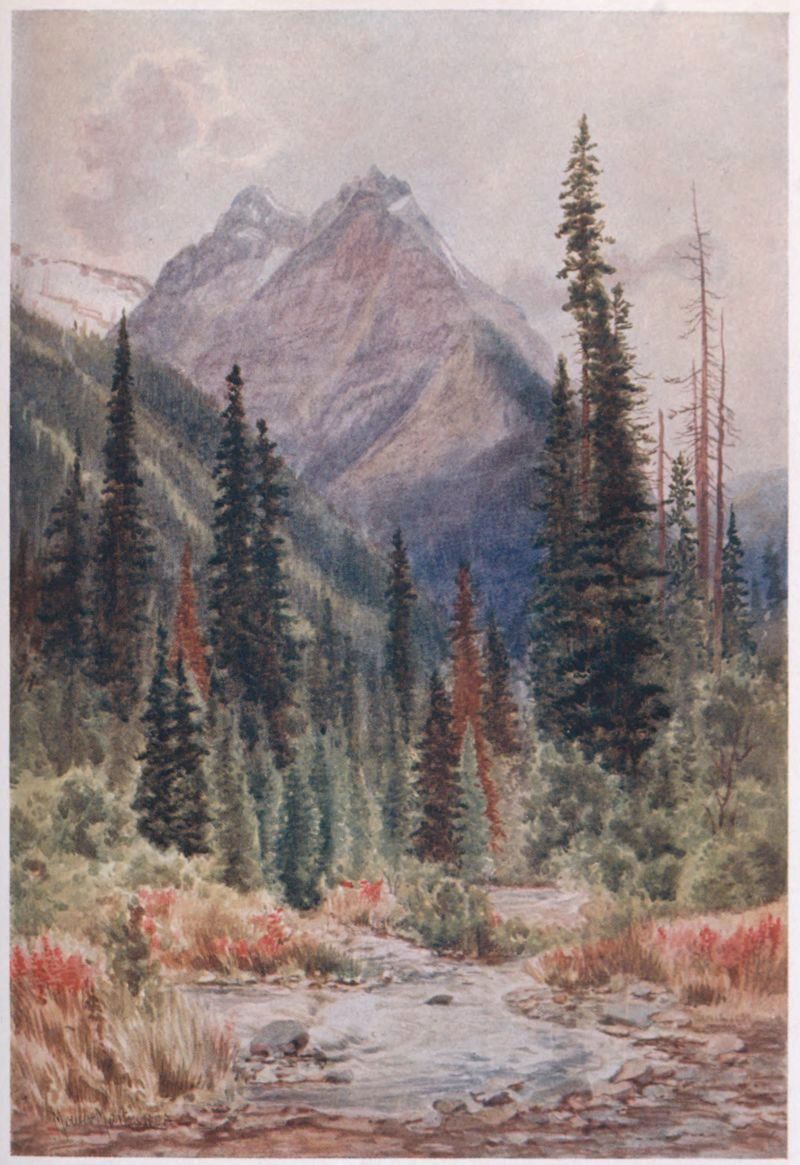
ROSS PEAK, SELKIRK MOUNTAINS, B.C.
Great forest monarchs raise their huge forms like Gothic pillars into the dusky air, where far above their arching branches shut in these austere wintry aisles, where only silence and nature’s voices reign supreme. But over the black hill-crest, where the ink-like pines lift their sombre and plumed branches; like the low, ruddy beams of a red winking eye, or a shaft of fire striking on an altar, the rich orange sunset floods the winter wood. Just before this happens, in summer, is the solitary hour of the hermit thrush:
“When all the sunset world seems ages old
In sad romance and achings of dead wrong;
And all the beauty of life is poignant gold
In the hermit thrush’s song.”
But beautiful as is the sun in the summer evening wood, there is something indescribably more glorious in the winter sunset. The rich, orange-red fire, which in summer dispels and loses itself in the thick and variegated foliage, seems to almost burn and to lend warmth to the bluish, pallid cloak of snows, and the desolate woodland; and to fill, with a splendour of fire, the inky heart of the pine-wood that fringes the hill, for a few moments ere the day be gone. Then it is, if one has a soul for the beauty of things, and a sense of the mystery of earth and sky, that life, of necessity, casts off its garments of care and age, and its chains of formality, and drinks, for the brief nonce, of that immortal draught of earth’s youth and youth’s longings from that spilled goblet of the winter sun.
It is at this hour, this rare space of time soon departed, that the miracle of nature is performed. Life conquers death; the bleak winter for the time has vanished; and the spirit grows soul-brother to
“The shooting sprout that feels
Within, the upward, golden wells of spring;
When young Pan’s piping down the rosy ways
Wakens the tremulous daughters of the year.”
Then, like the sudden hush of exquisite music, the day-god disappears from the world’s edge, leaving behind him the faint gold, orange, and saffron censor-flame of ghost-like afterglow. Then, by some Nubian hand of the dark, the subtle veil of blue and purple twilight is mystically removed; and high on the breast of the wintry heaven, beyond the dusky fringe of the solitary forest pines, gleams forth, an austere jewel, the silvern planet of even.
TORONTO AND WESTERN ONTARIO
Leaving Ottawa by railway, or, if it is summer, and one wants a delightful trip by water, by the Rideau Canal steamer, Kingston, on Lake Ontario, and the oldest city in the province, is reached. On the journey, the boat passes through the beautiful Rideau Lakes, a favourite haunt for sportsmen, and a noted summer resort. Kingston, originally known, in the days of the French, as Fort Frontenac, is one of the most historic and interesting cities in the province, and played quite an important part in the stirring drama of old Upper Canada. Here, for years, a British regiment was stationed, and at one time it was regarded as the chief fort on Lake Ontario; but it now is known by the name of the Limestone City, from the material out of which many of its buildings have been constructed. It is now a city devoted to manufacture and commerce, but is chiefly noted for having been the home and birthplace of several distinguished Canadian statesmen. Sir John A. MacDonald, Sir Richard Cartwright, Sir Oliver Mowat, and Sir Alexander Campbell were reared in this interesting old city, and passed many years of their lives there. It also contains two institutions, one Dominion and the other Provincial—the Royal Military College, the Sandhurst or Woolwich of Canada, and the penitentiary. The former institution has had a great influence in improving and developing the military life of our country, and many young Canadians, its leading graduates, now hold commissions in various regiments of the British Army.
Kingston is also well known as an educational centre, and ranks among the university cities of the Dominion. Queen’s University, of which Kingston is justifiably proud, takes rank with M‘Gill and Toronto as one of the three leading universities of Canada; and, excepting Sir William Dawson, it had the honour of possessing as its Principal, in the late distinguished Canadian, Dr Munro Grant, the greatest head of a university whom Canada has produced. Principal Grant was not only a fine scholar and a distinguished professor and administrator, but he was also a remarkable statesman, patriot, and man of affairs; and he would have been a powerful addition to the administration of his country in the Dominion Cabinet. Like Joseph Howe, and the present able principal of Queen’s, Dr Gordon, he was a Nova Scotian, being born in Pictou County; but the most active and important years of his life were given to the Dominion at Queen’s College, in the province of Ontario. Another noted Scotch Canadian, who was born at Kingston, was Sir Oliver Mowat, for many years premier of Ontario, and afterwards Minister of Justice in the first Laurier Cabinet, and lieutenant-governor of the province. Sir Alexander Campbell, another Scotch Canadian identified with Kingston, was a prominent lawyer, and postmaster-general for Canada for several years. Sir Richard Cartwright, who was born here, is one of the most noted men in public life to-day in Canada, and, except the Premier, is the only member of the Imperial Privy Council in the Liberal Cabinet. His family have been associated prominently with the life of Kingston from the earliest days of old Upper Canada; and Sir Richard, himself, has been for over a quarter of a century among the foremost political leaders of the Dominion. He was long an associate with, and afterwards an opponent of, the greatest figure in this distinguished group of Kingston politicians.
Sir John Alexander MacDonald stands with one rival only, Sir Wilfred Laurier, as a great Canadian political leader. He was born in Scotland, but his parents removed to Canada when he was very young, and his father was engaged in a business in the vicinity of Kingston. The future Premier received his education and studied and practised law in the city, which afterwards became his home. From the very first he became acquainted with Canadian politics; and at confederation he stood forward as the greatest administrative figure and political leader of the young Dominion, and for years, by reason of his remarkable magnetic personality and statesmanship, remained the political idol of his country, until death took him at Ottawa in 1891. He sleeps with many other noted Canadians in the old cemetery at Cataraqui, near Kingston; but his memory and his deeds live after him.
East of Kingston, on the lake and river, are Brockville and Prescot, two old historical Upper Canadian towns, associated with the early pioneer life, when the loyalists came here and took up the land which they afterwards held for Britain. West of Kingston, on the Bay Quinte, is the old town of Belleville, another early settlement of the United Empire Loyalists and British half-pay officers. Here, as in Kingston, many men afterwards prominent in the life of the country were born or lived their early life. Among these is Sir Mackenzie Bowell, an ex-premier of the Dominion, and for many years a prominent follower of Sir John MacDonald.
West of Belleville, on the lake, are Port Hope and Cobourg, picturesque old towns; and back inland, on the line of the Canadian Pacific Railway between Ottawa and Toronto, is Peterborough, a progressive city. The Grand Trunk Railway, the oldest Canadian railroad, runs from Montreal to Toronto along the St Lawrence river and the shore of Lake Ontario, and passes through the very oldest settled part of the Eastern Ontario frontier.
Toronto, the capital of Ontario, is the second largest city in Canada, and one of the most beautiful. It is situated on the lake shore, inside a small island which helps to form its harbour, and lies between two rivers, the Don and the Humber, which flow into Lake Ontario on its eastern and western sides respectively; and is surrounded by some picturesque hill-lands and commanding river-bluffs, especially those which skirt the Don valley.
The first European settlement at this place was an old French fort, founded in 1749 by the government of Louis XV. of France, and then called Fort Rouille. The English settlement or village of York, was named after the distinguished Prince and Duke of that name, who was commander of the British forces. It was the principal town of old Upper Canada; and when the government was moved from Niagara by General Simcoe it was made the capital. Here Simcoe, who was its true founder, and the wisest governor that old Upper Canada ever had, located his government, and built Castle Frank, his residence, among the pines on the Don river. Here he carried out those wise plans for the development of the social, material, and political life of the colony. He was, without doubt, Canada’s first great developer of her practical resources, and her first great administrator. Among his practical operations was the making of Yonge Street, a famous road thirty miles long, and connecting the infant capital with Holland river and the great western waterways; so that he might be also considered as the first great Canadian road-builder.
The history of this beautiful city is the history of the province, and in the early days of the nineteenth century it saw many stirring incidents connected with the restless and history-making life of the young colony.
It was not only the residence of the early lieutenant-governors, but it was also the birthplace and home of many of Canada’s most noted sons, who resided or held office here during the last century. Many of its inhabitants were United Empire Loyalists, who were among the early settlers; and retired officers and soldiers from the disbanded regiments of the British Army.
In the early days Toronto went under the name of Muddy York, and it was evidently not a very desirable place from the picturesque standpoint, though the wooded heights out back of the city must have made a pleasing suburb.
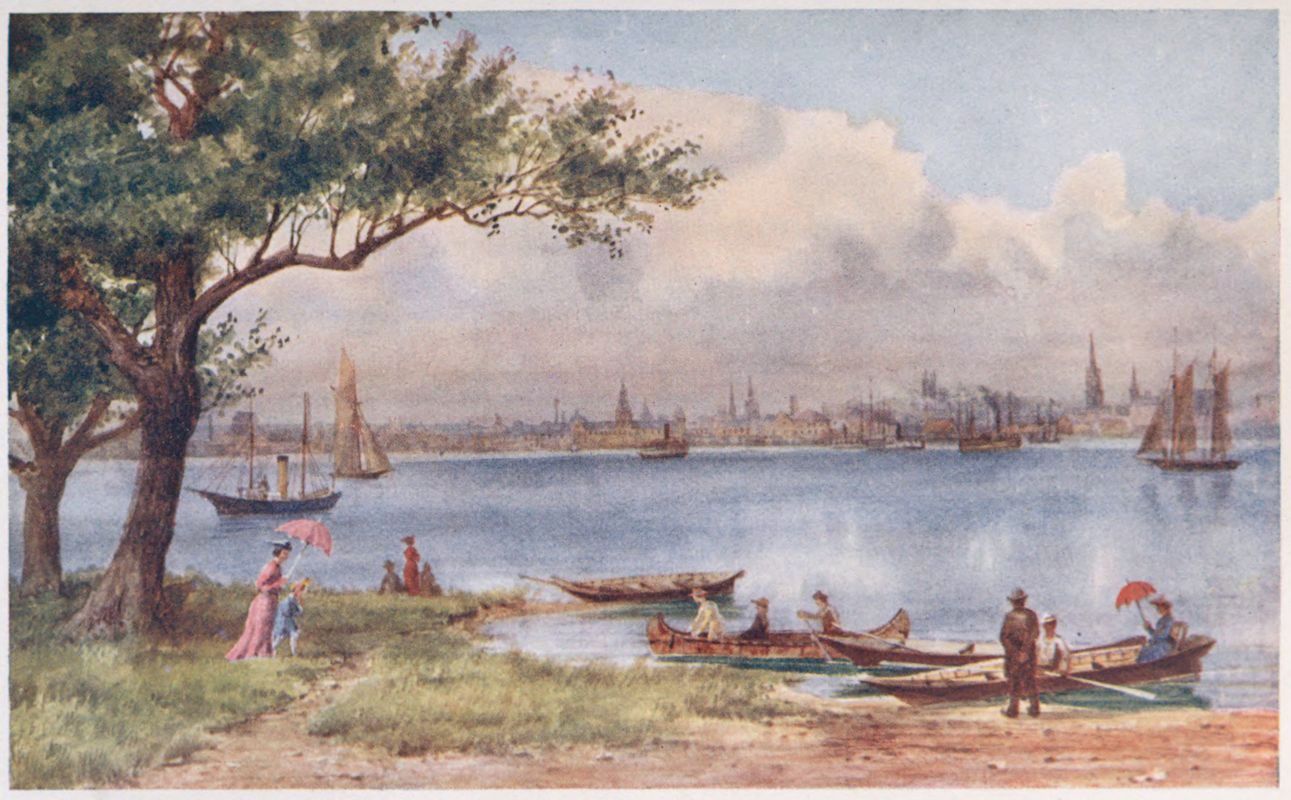
TORONTO, FROM THE ISLAND
Much has been written concerning the rebellion of 1837. It was a blessing for Canada that this rebellion did not succeed. In fact, the leader of the insurrection, M‘Kenzie, afterwards expressed himself very strongly to that effect, after having realised the true conditions, political and social, of the republic to the south. But, much as the rebels were to blame, there is no doubt that early Upper Canada was cursed by the existence of a ring or clique of self-interested bureaucrats, who had decided to exploit the resources of the province for the use and advantage of themselves and their friends. Canadian history in its reality has not yet been written. But anyone studying the records of those days cannot but read between the lines, and see that the political life of the country was at a low ebb. So much was this true, that, had not Upper Canada had the rare luck to possess in its first governor, Simcoe, a man of strong practical qualities, high ideals, and a determination to make the province one more than in name, there is no doubt that Canada and Ontario as they exist to-day would never have reached their present development. History prefers to gloss over the weaknesses of a people, but it cannot be denied that the early settlers of Upper Canada, while they had fine qualities, were narrow and parochial, without too much patriotism and thought for the future. Many of them had come over the borders from the old colonial life in New England and the Middle States. They were a class reared under the shadow of the forest, and had been over-educated by necessity to think first of themselves. Therefore it is scarcely to be wondered at that they should desire to possess as much of the land as possible, and that any power, position, or emolument coming their way would scarcely be disregarded. This was the class, not possessing over much of the refinements of life, which Simcoe had to, as it were, guide, inspire, and control, contend with, and trim and comb over into some condition of social ideal, and a sense of political responsibility. The facts are that Simcoe had to force the first Upper Canadian Parliament to pass laws to do away with slavery, and to tax themselves for the current expenses of their own Parliament. And, as the archives show, some of these members, elected by the votes of the people, were actually desirous of receiving what they called wages for work done in connection with their local government. This gives a slight idea of the condition, which grew steadily worse, until it developed into what was called the Family Compact, with its system of misrule, which outraged the feelings of sincere if extreme men like William Lyon M‘Kenzie, who, coming from the more constitutionally governed mother-country, were appalled, and finally thrown into despair, by the conditions which then existed.
This is the true picture. Too much blame has been laid on the shoulders of the governors, who, though none of them were as wise as Simcoe, were plain, straightforward military men, who despised talk and believed in action. Some of them, like Sir Francis Bond Head, were lacking in judgment; but, if the truth be known, their lack of judgment lay in being unlike Simcoe: and, instead of studying the needs and necessities of the country for themselves, and then taking the law into their own hands, they foolishly allowed themselves to be guided against their better judgment and counsels, by the little ring of bureaucrats who desired to hold all power in their own hands and to magnify to an absurd extent the grandeur and power of officialdom, of which they formed a part. This is well illustrated in the following quotation from the writings of one of the governors, who was, of all, the greatest failure, the late Sir Francis Bond Head:—
“Within a week after my arrival at Toronto I had to receive an address from the Speaker and Commons House of Assembly. I was informed that I was to sit very still on a large scarlet chair, with my hat on. The first half was evidently an easy job, but the latter part was really revolting to my habits and feelings, . . . and several of my English party quite agreed with me. However, I happened to mention my intention (to remove my hat) to an Upper Canadian; and never shall I forget the look of silent scorn with which he listened to me.
“I really quite quailed beneath the reproof which his countenance read to me, and which too clearly expressed: ‘What? to purchase five minutes’ loathsome popularity, will you barter one of the few remaining prerogatives of the British Crown?’ . . . and accordingly my hat was tight enough on my head when the Speaker bowed to it, and I shall ever feel indebted to that man for the sound political lesson which he taught me. I could mention many similar reproofs which I verbally received from native-born Canadians, especially one which very strongly condemned me for a desire I innocently entertained, to go once—merely as a compliment—to the Presbyterian Church, which when quartered in Scotland I had often attended; but I was gravely admonished by the son of the soil that although I ought to protect all churches, yet, as the representative of the Established Church, I ought to take part in no other service but my own; and a few moments’ reflection told me that he was right.”
This quotation throws light on the conditions, the influence brought to bear, and shows where the governor failed in not asserting himself and using his own judgment. It was the case of a weak governor and a fussy, self-magnifying officialdom, standing between him and his people.
As Toronto was the centre of all this political tragedy and comedy, it was here that many of these good people, with their foibles and follies, and their, underneath it all, genuine loyalty to the crown of Britain, dwelt, for the good or evil of the province which they wisely or unwisely controlled.
They were, no doubt, all of them, Whig and Tory, loyalist and rebel, in their several ways, a picturesque and often well-meaning lot. Here came Osgoode, the first Chief Justice of Upper Canada, after whom that fine old building, with its historical interior, Osgoode Hall, the Upper Canadian Law Court, is named. Here also presided Sir William Campbell, a Scotch Nova Scotian, another Chief Justice, whose picture hangs to-day in the corridor of the Senate at Ottawa. Here dwelt and ruled, as a civil and ecclesiastical official, that remarkable Scotchman, the Honourable and Right Reverend John Strachan, first Anglican Bishop of Upper Canada. Here he founded first King’s College, now Toronto University, and afterwards Trinity University, connected with the Anglican Church, and but lately affiliated with Toronto University. Here resided Ryerson, the founder of the Upper Canadian public school system; and here studied, toiled, and officiated such men as Sir John Beverly Robinson; Dr Rolf, head of the first Ontario Medical College; Robert Baldwin, Canada’s first constitutional reformer; and the fiery, restless, but sincere idealist, William Lyon M‘Kenzie.
Here, at the seat of government, Britain was represented by two distinguished governors, Sir Peregrine Maitland and Sir John Colborne, afterwards Lord Seaton, and one of the greatest generals of his day in the British Army.
Toronto is famous in Canada for its many beautiful buildings, among them colleges, provincial and civic buildings; and especially for its fine churches. Toronto University, in Queen’s Park, is one of the leading universities in Canada, and has had many distinguished men at its head. The main building of the University College is architecturally one of the handsomest on the continent; and it has many other fine buildings, among them the handsome university library, grouped together in its grounds adjoining the park. Near here two other universities—MacMaster, belonging to the Baptist Church, and Victoria, the Methodist university—occupy stately and commodious buildings. Out in the western side of the city, on Queen Street, stands Trinity University, a handsome, quaint old pile, not unlike an old overgrown English manor-house. Among its other fine buildings are the City Hall, Osgoode Hall, the Provincial Parliament buildings, and many fine churches—prominent among them St James’s (Anglican) Cathedral, St Michael’s (Roman Catholic), and the Metropolitan Church, one of the largest Methodist churches in Canada. Toronto is also, being a great university centre, and decidedly English and Scotch in its religious proclivities, a city of many theological colleges, which are affiliated with, or a part of, the four universities. These are Knox College (Presbyterian), Trinity College and Wycliffe College (Anglican), Victoria and MacMaster (Methodist and Baptist), and St Basil’s (Roman Catholic).
Toronto is also a city of many private residences; and, of late years, several quite palatial in their magnificence have been built by wealthy financiers and merchants of the city. On the whole, Toronto, by reason of its origin, past history, the class of its inhabitants, its situation and position as the chief city of Ontario; its mercantile wealth; its prominence in legal, educational, and political life, is the most representative Canadian city. And when one hears its myriad church-bells ring on a Sabbath morning, giving it the air of an old English cathedral town, it will scarcely be realised that here on the week-days exists the unrest and the fever of a people over-much American, in their absorption in the world of finance and the awful business of stock-gambling and other material interests, the too close application to which is bringing about a marked deterioration in our Canadian manhood. Nor would one, who has witnessed the intense loyalty to British institutions shown by the citizens of the city of Toronto, and their strong appreciation of the necessity of the imperial spirit and of the development of the Empire, realise without surprise that this city has long been the residence of that distinguished historian, essayist, and master of English, Goldwin Smith, whose life-dream for many years in the past was to bring about the annexation of the Dominion to the United States. Mr Smith has, however, of late, admitted his mistake; and no one now realises more than he does the remarkable part which Canada, as a nation, is likely in the future to play on this continent. His residence, The Grange, is one of the most delightful of Toronto’s fine residences. The house, an old brick one, a typical English manor-house, stands in the centre of a small but English-looking park. It contains some fine historical portraits of Cromwellian and other noted characters, of which their owner is very proud. He is a delightful and dignified host, quite after the aristocratic and old-time manner.
A few hours by train from Toronto is Hamilton, a beautiful city on a noble bay. Behind the city is a very fine mountain, which rises up in tiers, from the top of which a splendid view is presented of Burlington Bay, Lake Ontario, and the country around. This is regarded as one of the loveliest spots in Canada; and the country about here is like a vast garden on a larger scale, but not unlike the cultured scenery of the counties of Kent and Sussex in England. For beauty of landscape, fertility of soil, and mildness of climate, this locality and the Niagara district are unequalled in Canada. The winter season in this peninsula is nearly three weeks shorter than at Montreal and Ottawa, and the weather is never quite so cold, though less bracing than in other parts of Ontario.
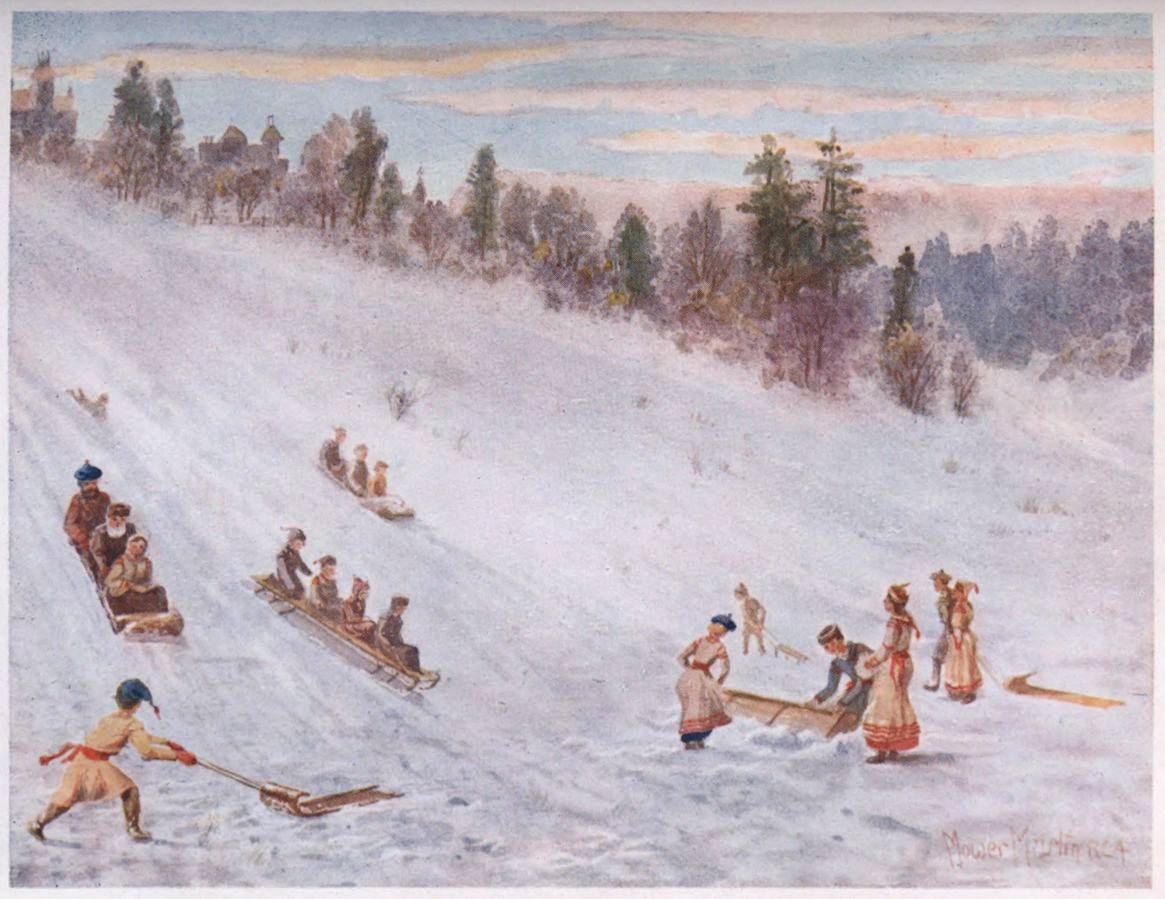
TOBOGANNING AT ROSEDALE, TORONTO
The history of Burlington Bay and the city of Hamilton is worth relating. La Salle entered here with his flotilla on the 24th of September, in the year 1669, when the dense forests on the hillsides were crimson and gold with the beauty of autumn. Over a century afterwards came Robert Land, one of the earliest of the United Empire Loyalist settlers, who was the first to break land in this city. In 1778 he took up his homestead at the head of the lake, as the most desirable place in the locality. His first plot of ground he cultivated with a hoe, and with this rude utensil raised the first infant crop grown in that country.
Soon others came to keep him company in the lovely wilderness at the head of the lake; but it was not until the year 1813 that Hamilton became a town, when emigration swept over the Upper Province, and the tide of progress to the west overflowed into these fertile regions of southern Ontario. The city of Hamilton gets its name from George Hamilton, who owned the land whereon the city now stands, and who decided to lay out his farm in village lots. The leading citizen of the ambitious city, as she has been called, was the late Sir Allan M‘Nab, and the principal street is named after him. He was prominent in the politics of the province, and was made a baronet by the British Government. Dundurn Park is so called from Dundurn Castle, which was Sir Allan’s private residence.
An interesting story is related of Sir Allan, which necessitates the describing of another original character of the same clan, namely, The M‘Nab, the chief of the clan, who came out to Canada, bringing with him a large following of his clansmen, and settled on the Upper Ottawa river, in the vicinity of where now stands the town of Arnprior. The M‘Nab chief, through extravagance and misfortune, had been ruined at home, and his lands became forfeit to his creditors. He applied to the Canadian Government for a whole township, which yet bears his name; and promised to settle it with a farming community brought out from Scotland. He received the grant, but the amusing and remarkable side of the matter was, that he persuaded the people whom he brought out that the land was his, and that they could receive farms from him, which they were to work under a sort of feudal system, paying him so many bushels of corn for the use of the land as long as they occupied it. Now, the truth was that these people coming out as settlers were entitled, had they applied to the Canadian Government of the day, to the land perfectly free, except for their surveying and other fees, which were necessary for location; and it has been considered by many that the chief of the M‘Nabs took advantage of the ignorance and innocence of his clansmen who followed his fortunes into the new world. This at least they were afterwards persuaded of, for a great number of them revolted, refused to pay their rent, and finally, by an arrangement, were made free from what they regarded as a tyrannous condition and an unfair extortion.
This at least is the popular attitude toward the colonisation of the M‘Nab township; but when the matter is looked into, and it is known that M‘Nab had paid the passage of these people out to the new world, had gone to the trouble of securing the lands and having them surveyed, and considering the value of money in those days, and the utter uselessness of the land and its remote situation, it cannot be considered that this old Scottish chief had made so good a bargain after all. Like his cousin, Sir Allan, the M‘Nab chief was a prominent character in the early days of the province, and his great pride was the fact that he was The M‘Nab; whereas, on the other hand, the late Sir Allan, being a man of some substance and political importance, felt that he was at least equal to the proud but ruined chief of his clan; and on one occasion, the story is told, that they both arrived at the same stopping-place for the night, and that the chief signed his name in the hotel register as “The M‘Nab”; and Sir Allan, coming in after him and seeing the signature, signed himself in turn, “The Other M‘Nab.”
Leaving Hamilton, Dundas and the Dundas valley are reached, which, since La Salle first gazed on them, have been famous for their beautiful scenery. From Dundas, across the country, is the Grand river and the city of Brantford, so called after the name of the great Mohawk chief, Joseph Brant. Here the same trail may be followed by which the great French explorer Joliet came, when he crossed to the upper lake region. And here the old Mohawk church still stands, and here is Brant’s tomb—all that remains of the famous old Mohawk community. Here is still the oldest Indian Reserve in Canada; but the glory of the ancient race has departed, and their camp-fires are ashes, and the old-time warpath is obliterated by the myriad feet of Europe’s hosts, who have crowded them from the camping-grounds of their forefathers. The story of the American Indian is not only picturesque and dramatic in the extreme, as told by Parkman, Longfellow, and Fenimore Cooper; and as has been evinced in the real history of their slow, but sure, extinction as the result of the spread of European civilisation upon this continent; but it is more; it is a tragic and a sad story. Their history is one of a gradual disappearing into the westward, as if fulfilling the strange fatalism of their own mythology and religion, which taught them that their Valhalla, or land of the blessed, was out in the regions toward the setting sun. Whatever part the Indian played in the history of this continent in the past, he and his tragedy, even his picturesque personality, are no longer of interest even in literature. He has broken camp, he has departed; even the sparks of yesterday’s fire are obliterated, and the ashes blown by the winds of the present into the spaces of oblivion.
“O saddest picture of a race,—
A wild and passionate, broken race;—
That, melting nightward, leaves no trace,
No camp-fire on the sweet loved face
Of their own land;—
As shades that wander to their rest,
Toward those dim regions of the west,
And setting sun.
No wonder that in sternest close
The last wild war-cry weirdly rose,
To break the settlers’ short repose,
In midnight hour.”
At the church here, the service of communion plate presented by Queen Anne is still in use.
Further west is Galt, a flourishing town, named after the eccentric but able Scottish novelist, who founded and helped to lay out many of the towns in what is called the western peninsula of the province.
Farther south again is the Niagara district, and the fine city of St Catherine’s, noted for its manufactures and for the beautiful agricultural country round about. This is the great peach and grape region of Canada. It is quite common here to see acres covered by immense peach orchards, laden with the finest quality of the luscious fruit; and sometimes as much as fifty acres will be wholly devoted to a grape vineyard, containing numerous varieties of the most delicious grapes. A good deal of wine is made in this district; and it is very interesting to go into the vineyards at the autumn season, and, after enjoying the luxuriant sight presented by the acres of trellised vines, covered with the exquisite clusters of the delicate fruit that would have made the mouth of the old Roman poet Horace water to observe, then to go down into the long wine-cellars and see row after row of the vast tuns and wine-casks, and then perchance to taste also some of the subtle juices which are housed therein.

INDIANS IN THE OLDEN TIME
In spite, however, of the delightful climate and the luxuriant growth and the splendid variety of fruit, the class of wine as yet produced in Ontario is very much inferior to anything made in the old world.
Taking a steamer at Toronto, the mouth of the Niagara river is reached. This is one of the most noted rivers in the whole world, by reason of its famous cataract. Here is Lewiston, and up on the Canadian side, following the river, the historical Queenston Heights, where that gallant British soldier and Canadian hero, Isaac Brock, fell, like Wolfe, mortally wounded in his hour of victory, while defending these heights from the American invaders. Here also is the deep gorge of the river, one of the most remarkable sights in the world; and spanning the great gorge are several steel bridges, splendid results of modern engineering skill. Then last of all we arrive at the great fall itself, which has been so many times described and advertised as one of the acknowledged wonders of the natural world.
Here, in early days, that charming old French priest, Father Hennepin, came, when the land was a virgin forest, and was the first known white man to gaze on this majestic marvel. Here he found the simple aborigines worshipping as a deity this vast tide which literally falls from the skies with Titan thunders into its seething abyss below. Few poets have ever tried to express their feelings with regard to this splendid cataract. The finest poetic tribute to Niagara is probably that from the pen of Washington Alston.
Next to the historic story of Brock, the splendid deed of Laura Secord is the most popular historical action recorded in connection with this part of Canada. She was the woman who made the desperate day’s journey, through a trackless forest, to warn the Canadian soldiers of the approach of the Americans. This story, which is worth relating, is as follows:—Laura Secord’s husband, who was a cripple, brought home to her the startling news that the American general, Boerstler, was approaching with the object of surprising the British troops, who, unaware of his proximity, were stationed at Decaws, a place a good day’s journey, with no roadway, from where she dwelt. This heroic woman realised the necessity of someone making that journey, and of notifying the troops of their danger. Otherwise they would be taken by surprise, and the Canadian cause would be virtually ruined.
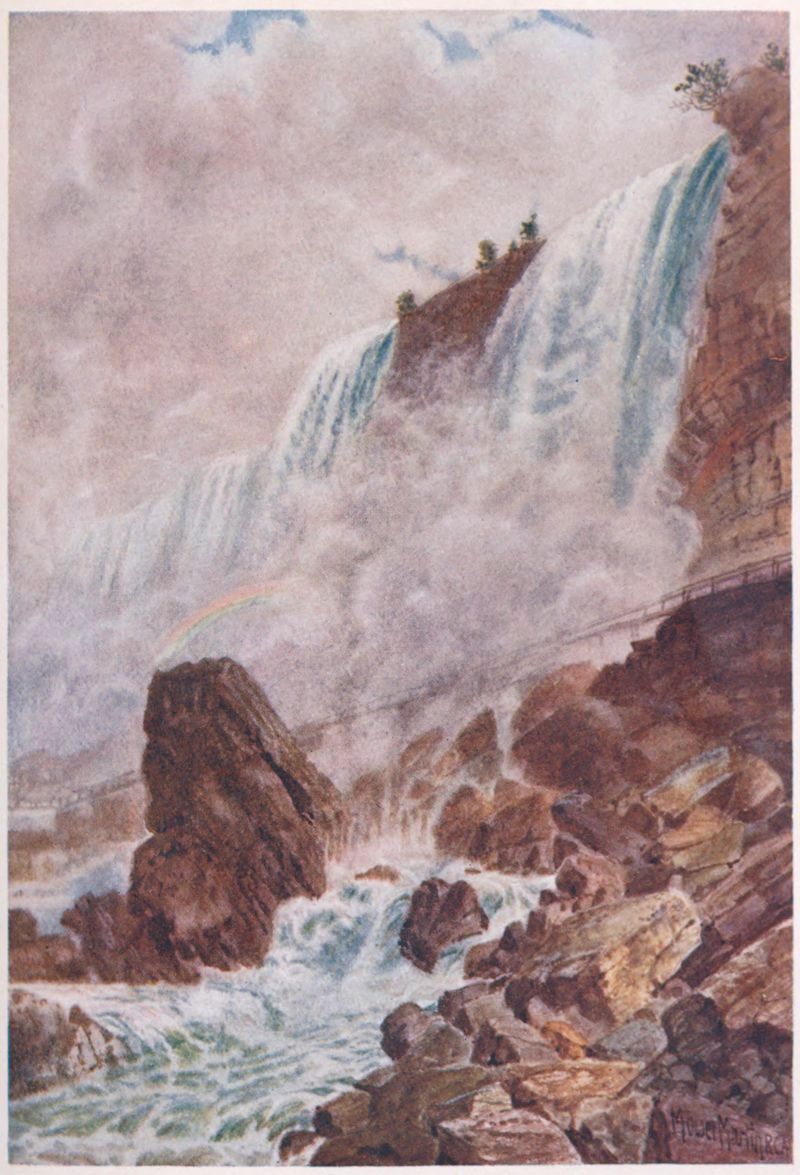
NIAGARA FALLS
Quietly gathering some food, and preparing herself for the journey, she bade her husband good-bye; and slinging a wooden bucket upon each arm, as if going out to milk her cows, in order to deceive the American sentinels, whom she had to pass, she went out into the bright dawn of the Canadian summer. There was purpose in her heart, and she set her face forward to the work she had in hand; and by a clever ruse, eluding the sentinels, she reached the deeps of the forest. Once there, and out of sight, she dropped her buckets and sped through the woods, heedless of danger of pursuit or the attacks of wild animals, and the risk she underwent from the cruel blind thickets that she had to pass; and though her clothes were torn and her feet cut and bleeding, she never paused or lost her courage, until at the close of that long day she reached the British camp and told her story.
West of the Niagara district is the great peninsula of Ontario, called the Western Peninsula, bounded on the south by Lake Erie; on the west by the river Detroit, Lake St Clair, the St Clair river, and the vast waters of Lake Huron; and on the north by that great arm of Lake Huron called Georgian Bay.
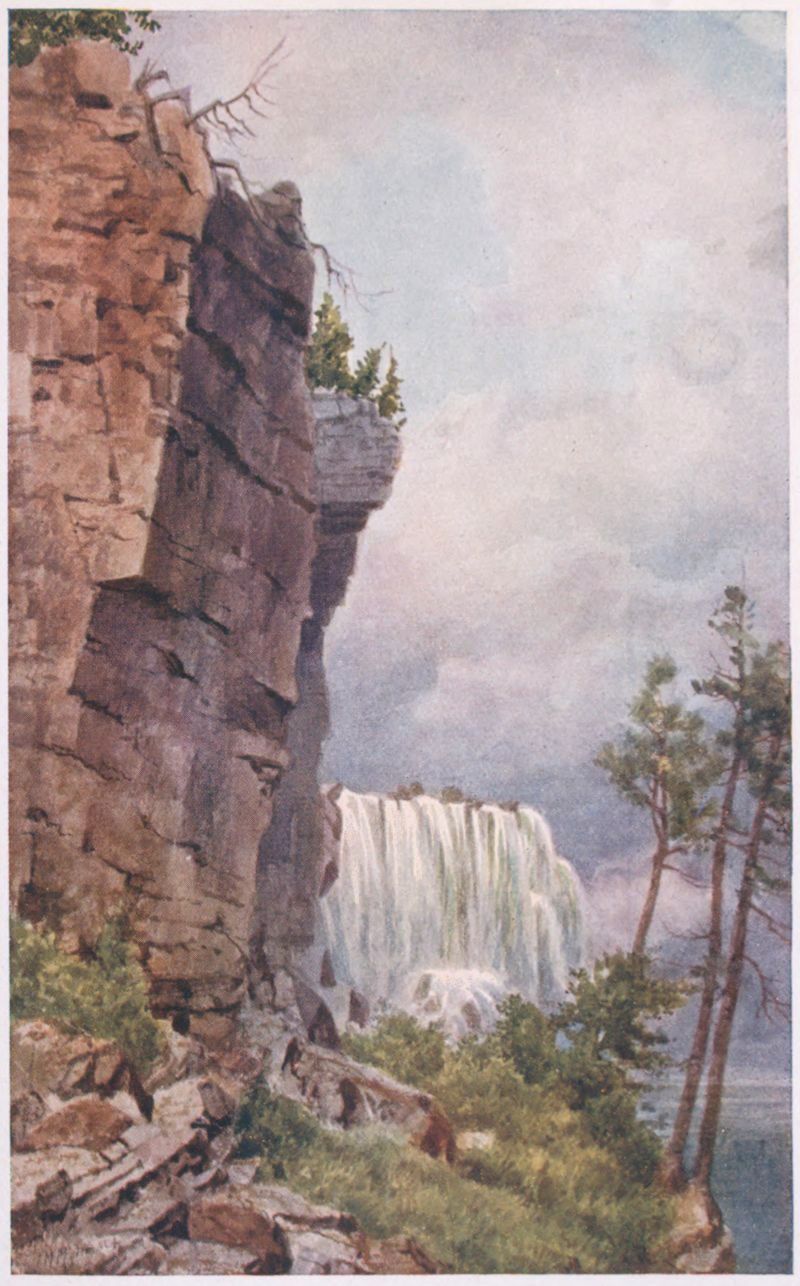
A GLIMPSE OF NIAGARA FROM UNDER LUNA ISLAND
This peninsula is without doubt one of the finest agricultural and grazing districts in the whole world. In the southern part, directly west of Niagara, is the city of London, like old London, situated in a county called Middlesex, and placed, like that other more famous city, on an equally small if less glorious Thames. London, while situated in a country less undulating than other parts of Ontario, has been pronounced by strangers to be one of the most beautiful smaller cities, not only in Canada, but on the continent. Besides being a commercial and agricultural centre, it is the seat of what is called the Western University, and is the cathedral town for the Anglican diocese of Huron. West of London is Sarnia, and the county of Lambton, noted as centre of the Canadian oil-fields. A large portion of the southern part of this peninsula is famous for its gas-wells. The shores of Lake Erie have several interesting ports. South of London is St Thomas, another beautiful city and county town. St Thomas is especially famous for being the home of, and being called after, the noted Colonel Thomas Talbot, one of the most remarkable characters associated with the history of old Upper Canada. His history, suffice it to say here, was mysterious, to say the least. He was generally known as the younger son of an old Irish commoner family; but his place of birth, and where he received his early education, are shrouded in mystery. He first comes to light as a fellow aide-de-camp with no less a personage than the great Duke of Wellington, when, as mere lads in their teens, they, as cornets in the army, were attached to the court of the Viceroy at Dublin. Later he came out to Canada as an aide-de-camp to General Simcoe. Here he was unusually successful; and it was during his stay in Canada that he discovered the spot which was afterwards to be the scene of his life’s labours, and the place of his death. Returning to Europe, he went with the British army on the disastrous venture into Holland under the command of the Duke of York. He soon rose to be a colonel, and when he had achieved that rank he suddenly, for no known reason, sold out his commission and retired to Canada, where he determined to reside as an “Hidalgo,” as he called himself, on a large estate in the wilderness. He applied to the Crown for a large grant of land, about five thousand acres, and comprising a whole township. This he boldly asked for in a direct appeal to two members of the royal family, sons of George III., asking that it should be made a Crown grant in the king’s name, and then be handed over to him. This request, through the royal favour, was granted; and settling on his estate near St Thomas, at a place now called Port Talbot, he approached the government of Upper Canada, with a project he had to bring emigrants out from the old country and settle them on his own and upon government lands. His project being received with favour, he proceeded to the ports in New York and Canada where the emigrants landed, and in that way, after several years, he managed to settle with British people a large portion of what is now called the Talbot Settlement.
He lived on his estate in an eccentric manner, sometimes performing himself the most difficult labour, and living in backwoods simplicity. His first residence, which he called The Castle, was a rude, rambling log structure; but to this he afterwards added a suite of rooms of more lofty pretensions. Here he lived for many years the life of a solitary, his only companion a faithful servant, in whom his master placed great confidence. For many years he ruled with almost imperial power over his part of the country. During the American invasion of 1812 he commanded the militia of his district, and was present at Lundy’s Lane and Fort Erie.
Colonel Talbot’s abode grew in time to be a resort for distinguished visitors who came to the province; the Lieutenant-Governors frequently visited him, and the Chief Justice was often his guest. Among distinguished visitors to Castle Malahide were the Duke of Richmond, Sir Peregrine Maitland, Lord Aylmer, and Sir John Colborne, afterwards Lord Seaton. The noted writer, Mrs Jameson, when visiting Canada, also paid him a visit, and refers to him in her writings.
“This remarkable man,” she says, “is now about sixty-five, perhaps more. In spite of his rustic dress, his good humour, jovial, weather-beaten face, and the primitive simplicity, not to say rudeness, of his dwelling, he has in his features, air, and deportment that something that stamps him gentleman. And that something, which thirty-four years of solitude has not effaced, he derives, I suppose, from blood and birth; things of more consequence, when philosophically and philanthropically considered, than we are apt to allow. He must have been very handsome when young; his resemblance now to our royal family, particularly to the King (William IV.), is so very striking as to be something next to identity.” “Colonel Talbot’s life,” continues Mrs Jameson, “has been one of persevering, heroic self-devotion to the completion of a magnificent plan, laid down in the first instance, and followed up with unflinching tenacity of purpose. For sixteen years he saw scarce a human being, except the few boors and blacks employed in clearing and logging his land; he himself assumed the blanket-coat and axe; slept upon the bare earth, cooked three meals a day for twenty woodsmen, cleaned his own boots, washed his own linen, milked his cow, churned the butter, and made and baked the bread.” In addition to this he carried on his farm of six hundred acres, upon which he had sixteen acres of orchard land, in which he planted and reared with success all the common European fruits, apples, plums, and cherries, in abundance. He was very fond of his garden, and in it he produced some beautiful varieties of roses which he had brought himself from England. Mrs Jameson remarks of him: “Family and aristocratic pride I find a prominent feature in the character of this remarkable man. . . . His lonely position, the simplicity of his life and manners, lend to these lofty and not unreal pretensions a kind of poetical dignity. . . . Another thing . . . was the sort of indifference with which he regarded all the stirring events of the last thirty years. Dynasties rose and disappeared; kingdoms were passed from hand to hand like wine decanters; battles were lost and won;—he neither knew, nor heard, nor cared. No post, no newspaper brought to his forest-hut the tidings of victory and defeat, of revolutions of empires, of rumours of unsuccessful and successful war.”
Colonel Talbot was a Tory, but as a rule took no part in election contests. He was a member of the Legislative Council, but seldom or never attended the deliberations of that body. With all his faults and eccentricity, he was a father to his people, and a friend of the poor, industrious settler, whom he was pleased to hold under his protection. In his old age he paid a visit to England, where he renewed his old associations with his former friend, the great Duke of Wellington. But he soon again returned to his old haunts, and died in the city of London, Ontario, on the 6th of February 1853. It was then found that he had left in his will his whole estate, valued at two hundred and fifty thousand dollars, to his faithful servant, George M‘Beth. He sleeps in the churchyard in the village of Tyrconnel, and the plate on his coffin when he was buried bore the simple inscription: “Thomas Talbot, founder of the Talbot Settlement; died 6th February 1853.” The career of this remarkable man is only one of the many instances of the tragedy of life, and the vicissitudes of fortune, of which these regions of the new world have been the picturesque stage.
It is not possible in this work to enumerate all the remarkable personages who have, by their life and works, aided in building up the fortunes of the province of Ontario. It would take an immense volume to contain the history of the Christian heroism of the clergymen who administered to the spiritual wants of the early settlers. The Methodist Church has a vast roll of noted preachers, who were among the first to pierce the half-cleared forest, and proclaim the Gospel under its primitive arches. Presbyterianism has also a long roll of eminent men, devoted and unselfish. The Anglican Church was equally zealous in establishing parishes from the banks of the St Lawrence to the western confines of the Talbot Settlement. And among these devoted bands, none were more zealous than the priests of the Roman Church, among whom the first Bishop of Upper Canada, the late Archbishop M‘Donnell, a prominent figure in early Upper Canadian life, and the late Archbishop Lynch were the most prominent personalities.
Nor would it be possible to more than refer to the long list of men distinguished in law, medicine, commerce, and financial life, of whom we have had a numerous and a noted company. Such names as those of Blake, Cameron, Armour, Osier are a few of the many, each representing whole families, distinguished at the Bar and on the Bench of this province. As for medicine, our colleges and hospitals rank with the best in the modern world; and Dr William Osler, an Ontario man, is the present Regius Professor of Medicine at Oxford. In finance and commerce we are equally distinguished and successful. It is true that Ontario has neither a Strathcona nor a Mount Stephen; but she has produced a host of merchant-princes and financiers of whom she may well be proud. In the science of engineering, Sir Sandford Fleming, C. H. Keefer, and the late Sir Casimir Zoski rank high in their profession. The first of these has done much in the cause of an inter-imperial cable.
THE CANADIAN LAKE REGION
“Domed with the azure of heaven,
Floored with a pavement of pearl,
Clothed all about with a brightness
Soft as the eyes of a girl;
Girt with a magical girdle,
Rimmed with a vapour of rest—
These are the inland waters,
These are the lakes of the west.”
The Dominion of Canada has, without doubt, the finest waterways in the whole world, and the greater portion of the fresh water upon the globe is within its confines. The great lakes which lie between Canada and the United States contain within themselves alone more than half of the fresh water upon the face of the earth.
Lakes Huron and Superior are really in their extent and depth inland seas, and with Ontario and Erie, and their connecting rivers, form a highway for shipping unequalled on either continent.
The early French explorers and missionaries, those remarkable pioneers of the western world, embarked, with their guides and their dusky hosts of the wilderness, on Lake Ontario, below Kingston, and paddled to the Niagara river, where, after portaging, they came to Lake Erie, where the Griffin, the first vessel ever launched on these inland waters, was constructed, and conveyed the adventurers westward across the shallow waters of this tempestuous lake, until they entered the Detroit river, and thence found their way through Lake St Clair and the stream of that name into the vaster, deeper, and more ocean-like waters of the then unknown Huron. Here the good priests ventured to save the souls of the Algonquins and other tribes of the trackless wilderness; and here, side by side with them, paddled the merchant-adventurers, whose more material mission was the beaver trade of these northern lakes.
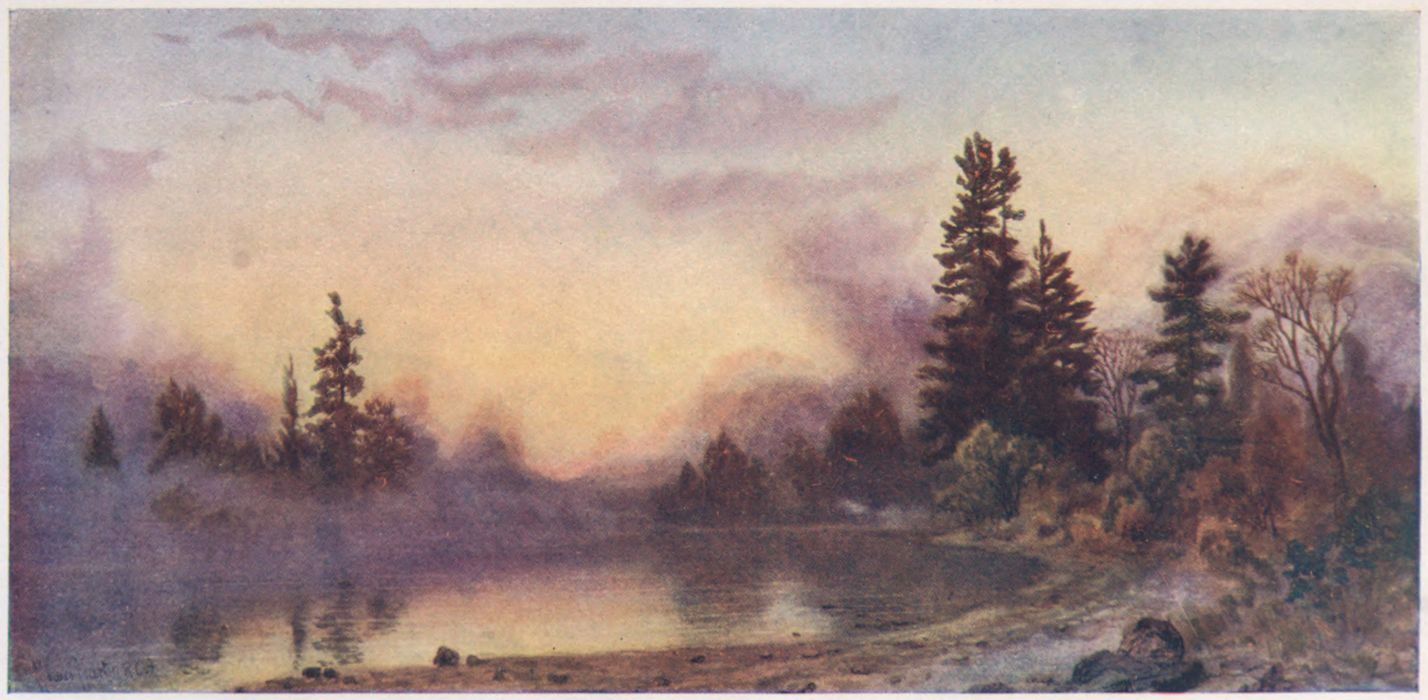
EVENING MISTS, MUSKOKA
Here, sad to say, at Father Marquette’s mission of Michillimackinac, the riotous and drunken habits of the coureur de bois, by their influence on the Indians, more than off-set the work of the good fathers. As one of them wrote, “Our missions are reduced to such extremity, that we can no longer maintain them against the infinity of disorder, brutality, violence, injustice, impiety, impurity, insolence, scorn, and insult which the deplorable and infamous traffic in brandy has spread universally among the Indians of these parts.” The same writer, Father Etienne Carheil, complains bitterly of the horrible conditions of life at this fort; and, allowing for the constant quarrel that was carried on between the Jesuits and the military commandants, there is no doubt that his strictures were justified.
The region of the upper Canadian lakes will always be closely associated with the memory of several great French discoverers and missionaries, Champlain, La Salle, Marquette, and Brebeuf. These distinguished men stand out as gigantic figures from the hosts of priests, wood-runners, and adventurers who invaded and infested the Canadian lake-side rivers and forests. Among these, the first to penetrate to the upper lakes was the intrepid Champlain, who, not satisfied with having discovered the beautiful and fertile valley of the St Lawrence, determined on another exploring expedition, in the hope of discovering, what had always been a favourite dream of his, a short road to India and China.
Lured by the false story of a young French adventurer, who told of a wonderful experience, in which he claimed to have ascended a northern river and to have discovered the long-desired shores of the eastern ocean, the great discoverer, being filled with his dream of reaching China, welcomed this mirage of the imagination as gospel truth, and, hastening to Canada, set forth with four Frenchmen and two Indians and made his famous journey up the Ottawa, and across through the wilderness to Lake Nipissing, and then westward, paddling down the French river, until he reached the vast waters of Lake Huron. Having skirted its shores for over a hundred miles, he landed close to Thunder Bay, and, following a trail through the wilderness, entered, for the first time, the fields of maize or Indian corn and golden pumpkins that girdled, with their agricultural splendours, the fortified villages of the Indian nation of the Hurons.
Returning down the lakes, crossing Georgian Bay, he arrived at the Huron capital near Lake Simcoe; and at last, after a long and wearisome journey, arrived at the shores of Lake Ontario.
This was the last, and no doubt the most noted, of Champlain’s explorations. He had been the first white man to journey so far into the trackless deeps of the Canadian lake region; and his name in this connection will always be associated with the early history of Lake Huron and Georgian Bay.
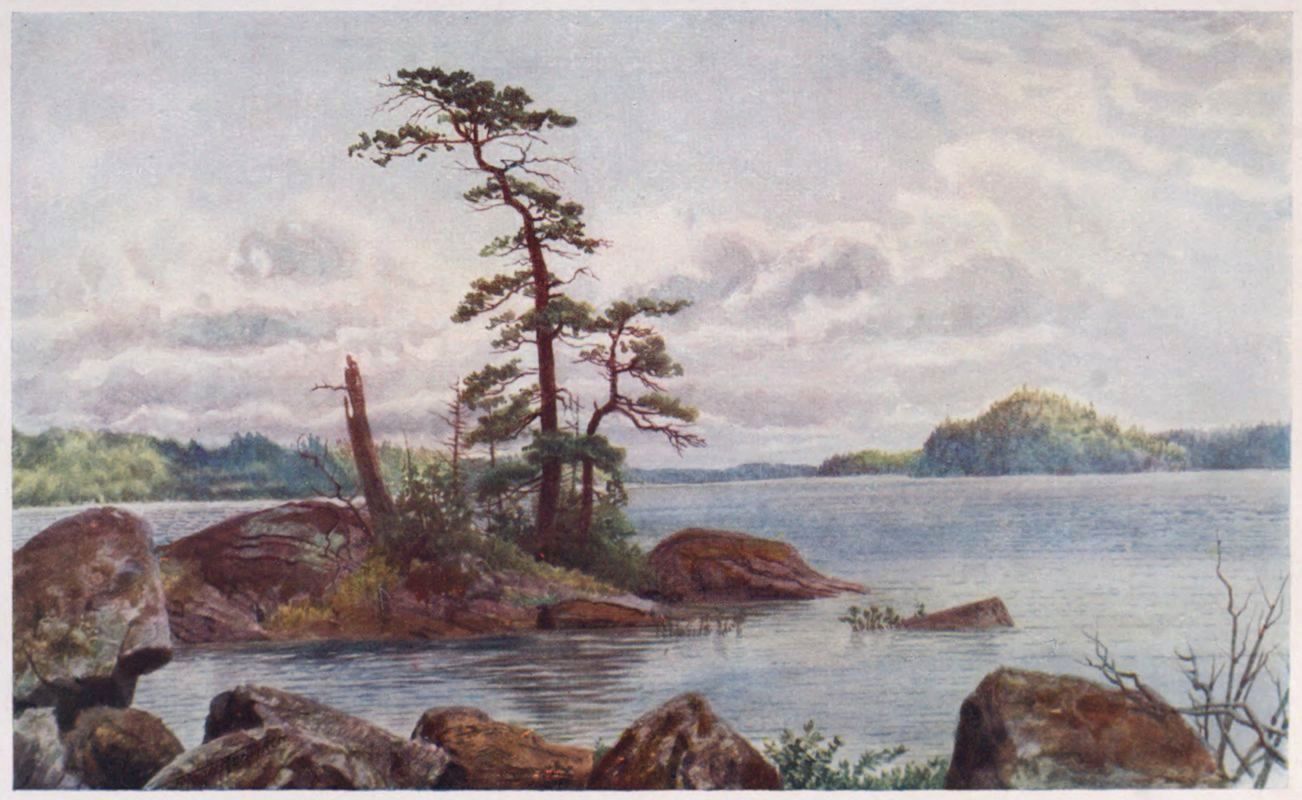
MUSKOKA LAKE, NORTH ONTARIO
Another remarkable character, whose labours and consequent martyrdom are associated with these vast inland waters, is that most distinguished of all the famous French missionaries, Jean de Brebeuf. He was of noble Norman birth, and a man of unusually strong physique, having many of the qualities of a soldier. Stern and commanding, he was as ready for danger and action as he was faithful to the mission which he had at heart.
It was on the shores of that vast and beautiful arm of Lake Huron, now called Georgian Bay, that he found his life-work in the Huron villages. Accompanied by two devoted brothers, Brebeuf spent his years on the coasts of Huron, toiling, teaching, preaching, making long, arduous, and perilous journeys, and enduring with untiring spirit the extreme privations which are the accompaniment of such a life. A little corn crushed between stones, mixed with water, was often their only food during their journeys, which sometimes lasted for days. But their only aim in life was their single purpose to save the souls of the savages; and as they travelled under the beating sun of the midsummer noonday, or endured the arctic cold of the fierce winter night, their hearts were thankful that they could perform their duties. But they were not long to work in peace. The Iroquois, the fiercest of all Indian tribes, and the greatest haters of the French, were determined to annihilate the peaceful Hurons, who were of a milder and more civilised character, living in their towns amid their cultivated fields. After having destroyed several of the Huron villages, the Iroquois finally attacked the town of St Louis, which they captured and burnt. Here Brebeuf, who encouraged his flock to the last, and refusing mercy, died as he lived, heroic and undaunted to the last. Thus ended the remarkable labours of this devoted man; and so closely were these years of his life associated with the shores of Huron and Georgian Bay, that there is scarcely a harbour or cape, a fair, smiling bay or a beetling crag, which is not associated with his memory.
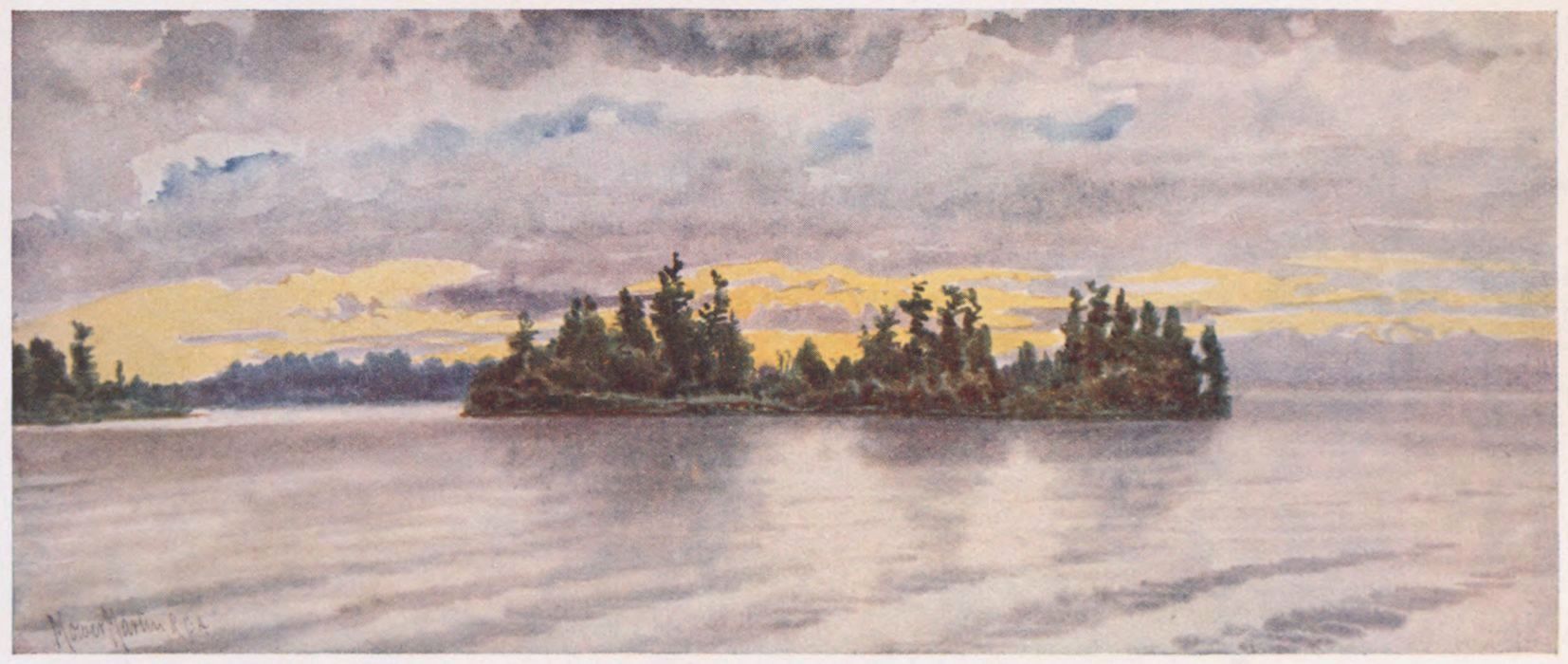
SHOWERY WEATHER, MUSKOKA LAKE
But perhaps the most remarkable and the most famous of these early adventurers into the wilds of the lake region was the distinguished La Salle, the discoverer of the Mississippi. This restless spirit, at first a Jesuit, and finally an explorer, perhaps the most remarkable that the American continent has known, was fired with the ambition to do what Champlain had failed in doing—to discover the western passage to China. In this he of necessity failed; but he accomplished what was more important in a practical sense. He was the first to open up the interior of the country, and claim it for the French. Coming to Canada, he was offered, and accepted, a grant of lands near Lachine, above Montreal, where he erected a palisaded house and village, the remains of which are visible at the present day. But, like Champlain, he was dissatisfied, for he carried in his heart the eternal restless longing and ambition of the discoverer to achieve. He was one of those fated lonely spirits
“Who strove and dared, and greatly overcame;—
Wresting from nature half her secret, cruel,
Wherewith she darkens down in glooms apart
The mystery of this planet.”
Being a man of a remarkable and magnetic personality, he became exceedingly popular with the natives, with whom he had, in his restless nature hidden under a cloak of outward almost savage reserve, much in common. He was, like all great men, one who lived his life apart, and kept his inner dreams to himself, while daily associating with the souls about him; and it was this fatal quality, in his case, which finally brought about his tragic end, just when he had accomplished the great work of his life. His friends among the Indians told him of a mighty river to the far west, which flowed, as he and they supposed, into what was then called the Vermilion Sea, but which is now known as the Gulf of California.
Filled with this dream, he obtained letters patent for the carrying out of his project, disposed of his seigniory at Lachine to raise money to pay his expenses, purchased several canoes, and engaged over a dozen men. At midsummer he set out, accompanied by a religious expedition to the upper lakes. Reaching Niagara, he went west by way of Lake Erie, and struck out into the trackless wilderness beyond, discovering the Ohio and the Illinois rivers.
The next and the most remarkable journey undertaken by La Salle was some years later, when, under the patronage of his friend Frontenac, the noted governor of New France, he received a royal patent in 1678, giving him authority to continue his successful discoveries. Going up the Niagara river, La Salle determined to build a vessel, in which to survey the great lakes beyond, and, if possible, find a waterway into the extreme west.
Early in the summer one of the most remarkable incidents in connection with the Canadian lakes occurred. It was the launching of the Griffin, the first vessel built by Europeans which ever floated upon our inland waters. These early explorers were therefore not only the discoverers of the inland waters and forests of the west, but they were also the pioneers in the shipping business and the navigation of the upper lakes. This ceremony was performed, the record says, with firing of cannon and great rejoicing. In a few days she was made ready for her journey westward, and, after firing a gun, spread her sails to the breeze, and departed—the first vessel to navigate those lonely waters.
But the fate of the Griffin was similar in its unfortunate character to that of the great explorer who stood on her decks. In the early autumn La Salle sailed out into Lake Huron, and along the white sandy shores and ghostly islands of the lake of the Michigans. Here he loaded the vessel with valuable furs, and sent her back down the lakes; while he and his companions, in several canoes, continued their journey westward.
There are many conjectures regarding the fate of this unhappy vessel; but one thing remains certain—she never returned. Some historians suppose that there was mutiny on board among the desperate adventurers and sailors. Others, that she was caught in a storm, and sank in mid-Huron; or was cast on the bleak shores of the Manitoulin Island, or the inhospitable coast of the great peninsula which lies between Lake Huron and Georgian Bay. Another and a probable suggestion has been made, that she was attacked and captured by Indians, who destroyed her crew, and sank the vessel. However plausible these conjectures may be, her fate will ever remain a mystery; and, strange to say, though she was the first, she is not by any means the only, ship which has been known to disappear in the fatal waters of these vast and magnificent but ominous inland seas. There is a spot near the north of what is called Cabot’s Head, the extreme point of the great Huron peninsula, where, it is said, two small brass cannon can be seen shining in the clear depths of the crystal waters. If this be a true story, it may be possible that an investigation might solve the mystery of the disappearance of the first of our inland craft. Meanwhile there remains the sad, romantic halo which mystery ever casts over the history of early adventure; and the fate of the Griffin will always give us the suggestion of a phantom ship, manned by Norman and Breton sailors, beating up eternally, in vain, to port, like the phantom crew of Vanderdecken, that fated admiral of ocean’s ghostly fleets.
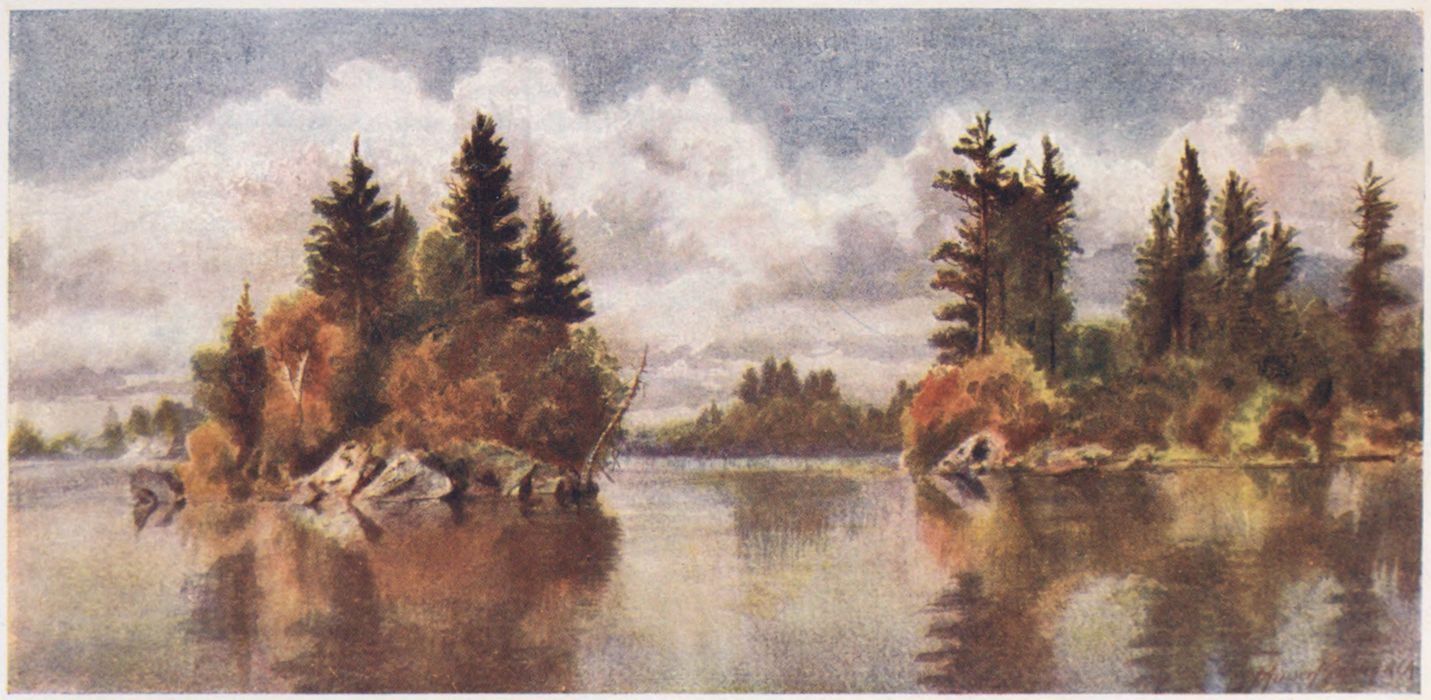
AUTUMN ON LAKE OF BAYS, MUSKOKA
The lake region of Canada is composed of two groups of lakes which are spoken of as the upper lake region and the lower lake region. The latter comprises Lakes Erie and Ontario; and the former, Huron, with its vast arm, Georgian Bay; Superior, and Michigan. The lower lakes are chiefly interesting because they form the boundary-line between Ontario and the United States, and because of their value as waterways from the St Lawrence to the upper lakes.
They are picturesque bodies of water, and in the summer season the beaches along their shores make delightful summer resorts; and their large body of fresh water has a tempering effect on the climate of that part of the province bordering upon them. Parts of Lake Ontario are very lovely as regards scenery. About Cobourg, the Thousand Islands, the Bay of Quinte, and above Toronto at Oakville and Hamilton, its shores are pleasing, and abounding in a variety of coast scenery of the quieter and less rugged character.
Lake Erie, which is higher above the sea-level, is a little larger than Ontario, but shallower. Its coast-line, on the Canadian side, is much the same as that of Lake Ontario, with the difference that its shores have a bleaker appearance, partly owing to the immense sand-dunes which in places fringe its waters. It is a more dangerous lake for navigation, owing to the fact that its waters, being shallow, are more easily disturbed by the gales, and consequently wrought up very often to an intense fury. There is an immense shipping traffic at the western end of this lake, from Toledo and Sandusky in the United States, which continues along Lake Huron and around to Chicago, at the southern extremity of Lake Michigan; and those who have an idea that the lake region of Canada is a wild, unploughed waste of inland waters would be surprised to learn the amount of tonnage in vessels which continuously passes over this chain of waters, making it, near the entrance to Lake Michigan on Lake Huron, appear more like a vast canal than an immense lake, such as it is. The chief ports on the Canadian side of Lake Erie are Port Colborne, Port Dover, and Port Stanley. At the western end of Lake Erie is Point Pelée Island, which is noted for its remarkable production of the finest grapes.
Leaving Lake Erie near Amherstburg, one follows around the three sides of the county of Essex, an oblong peninsula at the extreme south-western angle of Ontario, and by means of the Detroit river enters Lake St Clair, a small, almost square lake, lying directly north of the county of Essex. This is a shallow lake, really a widening of the two rivers, the Detroit and the St Clair, which run almost directly south from Lake Huron. These two rivers and Lake St Clair form the boundary-line between Canada and the United States. On the Detroit river is the town of Windsor, a flourishing place connected by a ferry with the great city of Detroit in Michigan. The county of Essex is noted in Canadian history for an early settlement of the French, which in the old days had its headquarters at Fort Detroit, where the city of that name now stands. And it is a proof of the tenacity of the French settlers in Canada, that there remains to this day a flourishing community of French Canadians in this county, where they are a political force at the present time.
The scenery along the Detroit and St Clair is marshy and flat, and the locality has been in the past a favourite one for sportsmen.
Sailing north through the St Clair river, Huron and the upper lake region, or what is properly the true lake region of Canada, are reached.
Lake Huron and its arm, Georgian Bay, comprise a body of water only surpassed in size in the world by its sister lake, Superior. It is about two hundred miles long from north to south, and from eighty to a hundred miles wide, not including Georgian Bay, a body of water nearly as large as Lake Ontario. Its waters are very deep, and it is a common thing, in some of the harbours of Georgian Bay alone, to have a depth of from fifty to sixty fathoms within half a mile of the shore. Here we enter a picturesque and really sublime region, one of the most beautiful for coast scenery and wide sweep of water-line in the whole world. As one goes north along the shores of the counties of Huron and Bruce, a region is entered, in the summer-time, of vast stretches of shore-line, composed of cliffs and sand-hills century-blown. Farther north, along the coasts of the county of Bruce, there is a wild beauty of the scenery, which in places suggests that of the ocean. Here, in the late summer and the early autumn, for miles there stretches the winding shore, a perfect picture of forest and sand beach, shining water and sky, wrapped in an elusive mantle of dream-like haze. This wonderful condition of shore, lake, sky, and atmosphere will sometimes continue so late in the year as October, when the autumn tints of crimson maple, russet and golden beech, scarlet sumach, and the wine-like, claret-coloured leaf of the oak light up the landscape in autumnal glory. Here at this season are to be seen
“Miles and miles of lake and forest,
Miles and miles of sky and mist;
Marsh and shore-land, where the rushes
Rustle, wind and water kissed;
Where the lake’s great face is driving,
Driving, drifting into mist.
Miles and miles of crimson glories,
Autumn’s wondrous fires ablaze;—
Miles of shoreland red and golden,
Drifting into dream and haze;
Dreaming where the woods and vapours
Melt in myriad misty waves.
Miles and miles of lake and forest,
Miles and miles of sky and mist;—
Wild birds calling, where the rushes
Rustle, wind and water kissed;
Where the lake’s great face is driving,
Driving, drifting into mist.”
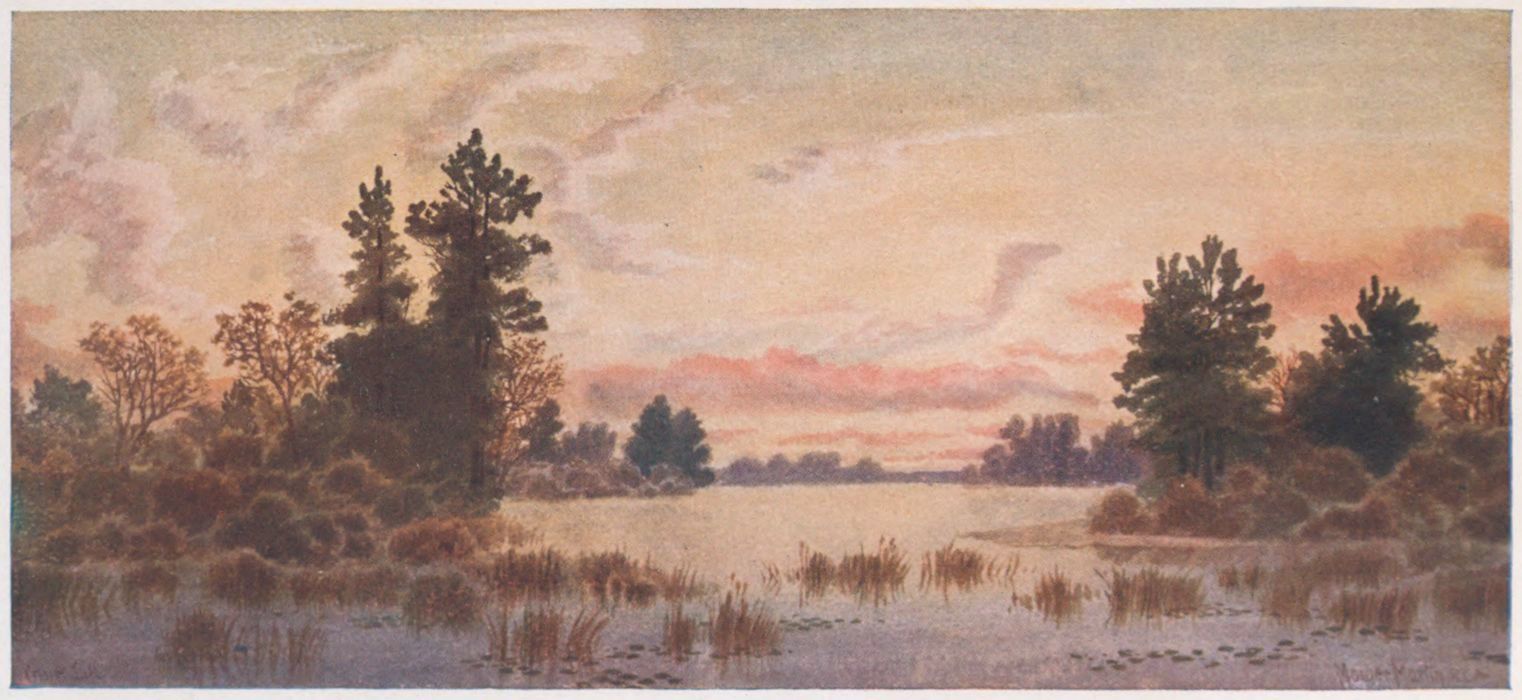
SUNSET ON CANOE LAKE, PARRY SOUND
Following the shore-line around the great peninsula into Georgian Bay, or sailing north to the sacred island of the aborigines, the Manitoulin—
“Girdled by Huron’s throbbing and thunder,
Out on the drift and lift of its blue”—
a region is reached of vast craggy shores, crowned with forest; smooth, sandy and pebbly beaches, shining like the silver horseshoe in the Arabian legend; deep, sheltered bays, where Britain’s armoured fleet might anchor; desolate, forbidding coasts where, in October, the mighty surf is grinding death and hate on the rocks, as sandward and landward it roars.
Here, on the breast of these mighty waters, or in the region which walls them in, is found a variety of beauty, from the winter desolation of the cruellest, most fatal seas without exception on the face of the globe, to the exquisite glamour of the summer morning of the lake region, where the dim, misty dome of the world, scarce awake, blushes rose like the cheek of a child.
Here, at the season of springtime, when over the desolate hushed spaces of water, and the iron-bound lands, only sleep and death had dwelt during the bitter months, it is an experience of one’s life to see the coming of the revival of mighty nature, renewing her youth once more, as life and the returning season
“Wake with mystic songs the sullen beaches,
And flame to life the pale, mute, death-like sleeps.”
One of the finest regions in America for a holiday outing is that of Lake Huron and Georgian Bay. For a renewal of life and vigour, and a tonic for heart and brain, of all places in the world, give me an island at the entrance to an arm of Georgian Bay, which I knew in my youth, and of all times the Canadian midsummer. These are the waters for the bold and sensible yachtsman. Here he will get breezes to his liking; here he can tack and tack, across the teeth of the wind, his sails filled and his keel cleaving the purest and most buoyant deeps; and here he will find, at the day’s end, the most beautiful harbours and the safest roadsteads to be found anywhere. This island—and there are more like it, wild and desolate, haunted by old stories of mishap and adventure of the early settler and of Indian lore, or perchance by the ghosts of men who fled to these wilds, driven by crime, misery, or other tragedy which infests life—is an ideal spot in which to spend the mid-heat of summer, and get into close touch with the mighty heart of nature.
Here one, sleeping on the shingle by the lakeside camp-fire, may awake just before the dawn of the summer day:
“When the night is beginning to fail,
And the stars have lost half of their glow,
As though all the flowers in a garden did pale
When a rose is beginning to blow.”
This early flush of the dawn-rise over the great water, with all of the silence and beauty and repose of the mighty shore and lake brooding about one, is one of the most exquisite experiences life can know.
Or perhaps it is a morning after a storm, when, red in the mists, angry and coloured as with fire, the great lake rocks in its wild beauty, tossing from headland to headland, its waves touched with the glories of dawn, and afar, its wide ribbons of beaches stretching out, pale and wind-swept. Behind the observer is the wild tangle of island swept and drenched by the gales of the night; and in front are the lone stretches of water, flame-bathed by the incoming light.
Or, again, nothing is more impressive in its mighty loneliness than a stormy sunset on Lake Huron or Georgian Bay:
“Great brown, bare rocks, wet, purple-dyed
By sunset’s beams, hedge in this realm
Of sky, and wide
Bleak sweep of tide,
Grey, tossed, scarce ploughed by keel or helm.”
In all parts of this lovely region there are moods of day and night, of dawn and evening; there are, in sheltered bays,
“Crags that loom like spectres
Half under the sun and the mist;
There are beaches that gleam and glisten.”
Out in the sunny day,
“There are miles and miles of waters
That throb like a woman’s breast;
With a glad harmonious motion,
Like happiness caught at rest;—
As though a heart beat under,
In love with its own glad rest.”
Girdling these placid deeps,
“There are forests that kneel for ever,
Robed in the dreamiest haze.”
And over these wild, haze-haunted, late summer regions,
“There are birds that like smoke drift over,
With a strange and a bodeful cry,
Into the dream and the distance
Of the marshes that southward lie,
With their lonely lagoons and rivers
Far under the reeling sky.”
Or perchance it may be a day of mists, when the whole world is draped in the sombre garments of that mystical spirit of fogs and rain. Then
“The crags and the low shores kneel,
Like ghosts, in the fogs that reel
And glide, and shiver and feel
For the shores, with their shadowy hands:
Earth and heaven are grey,
The worlds of waters are grey,
And out in the fog-haunted day,
A spectre, the lighthouse stands.”
Here, into this haunted region, comes that sublime season of the Canadian year, the lonesome, mist-mantled autumn. Here she comes, covering all with her glamour and majesty of beautiful decay. Like a magical wizard, herald of death, she touches with her frosty wand the whole brooding face of earth and waters; and from the far-off blue-peaked mountains, from the vast bearded forests, from the spaces wild and lonely, from the corn-lands, from the golden undulating wheat-fields, where the music of far voices is heard, there goes up a requiem, sad and mournful, yet beautiful in its note of nature’s resignation.
“Here in the glad September,
When all the woods are red
And gold; and hearts remember
The gone days that are dead;
And all the world is mantled in a haze;
The wind, a mad musician,
Melodious makes the days.
And the nights are still, and slumber
Holds all the frosty ground.”
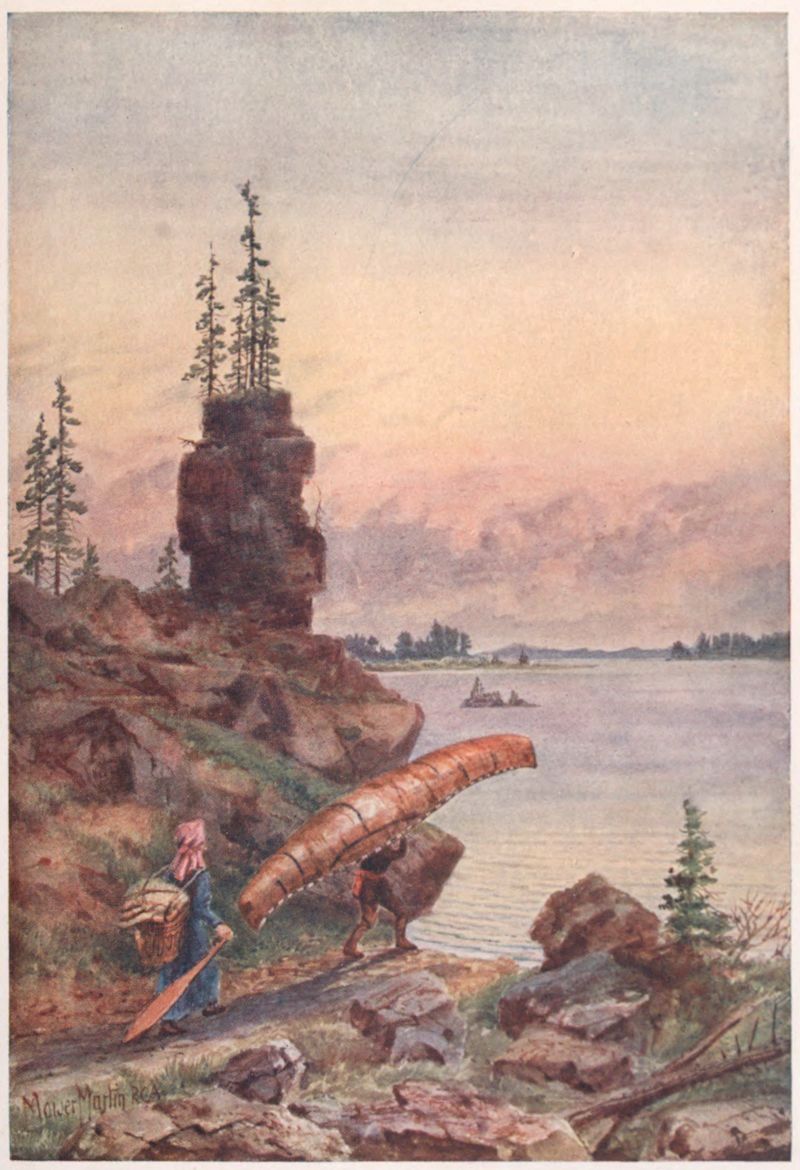
PORTAGE ON SURPRISE LAKE
Then here, more than anywhere else, is felt the majesty of the autumn season. There is a bleak loneliness of the daytime, and a crisp beauty of the mornings, in this region, by shore and wave, that makes the heart desire that this wonderful season might last for ever.
Here the whole world of men seems so remote, with all its fever and ache of hope deferred, and unattained desire, where:
“Within these dreamy borders nought takes shape,
Of weird ambition, sorrow at the heart’s core;
But holdeth only love of cape for cape,
Of murmurous shore for shore.”
But later, when come the rude blasts of November, nature in this region assumes a more angry and forbidding aspect. I well remember, in my boyhood, after a November storm, listening, in the still night, to the sound of the surf pounding on the sands of the Huron coast seven miles away. This shore was, in the late autumn, the dread and despair of the seamen, whose fate made it necessary for them to still sail these tempestuous waters; and many of the people who lived on its bleak sandy beaches eked out a shiftless sort of livelihood by gathering the derelict wreckage which came ashore—much of which was the cargo from vessels stranded on this angry coast, or was washed ashore from the wreck of vessels which had foundered out in the middle of the lake. Some of this wreckage was very valuable; and one autumn, after a gale in which many an unfortunate ship went down, hundreds of barrels of flour and lard came ashore at a place called White Stack Island, and supplied some of the shore-people with food for many a month after.
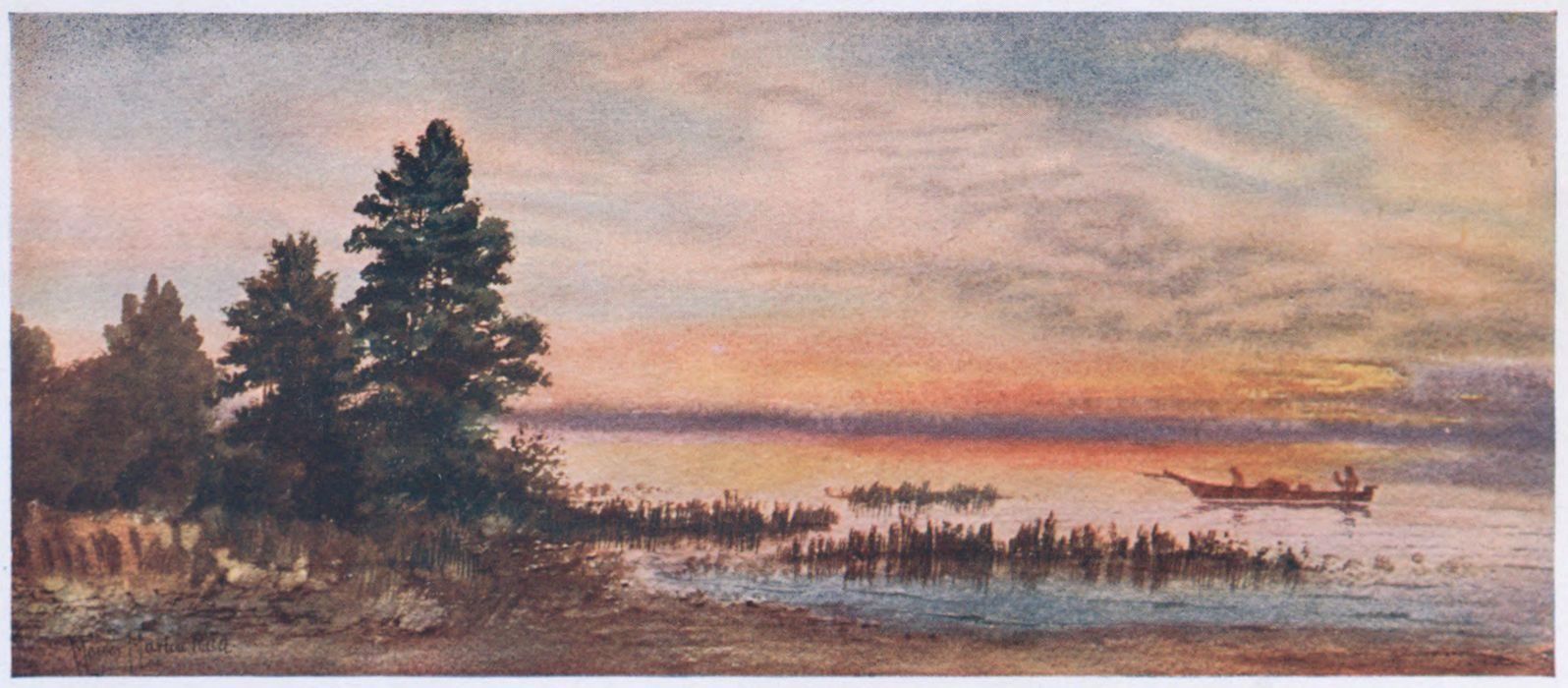
SUNSET ON LAKE SUPERIOR
In this aspect of their stormy and cruel moods, the Canadian lakes have an unfortunate reputation in the shipping world; and now on the great lakes the old-fashioned wooden steamers have long been replaced by Clyde-built iron vessels, which are more fitted to weather the fierce storms which sweep over, with a force equal to that of the ocean, these vast inland waters. Every year has its sad tale to tell of vessels wrecked, cargoes lost, and lives wasted on these watery highways. It would astonish the ocean-going man, if he were told that the waves on Lakes Superior and Huron in a fierce autumn storm, beating landward, would soon destroy even a great Atlantic vessel; so that it can be understood that, every season in turn, there must be the usual quota of shipwreck and death in the waters of the upper lakes. Though in the winter the ice forms in great patches over a large portion of these fresh-water seas, yet navigation is kept up as late as possible into the inclement season, so that the danger to life in late navigation is by this very much increased.
In the late December, when
“Here the white winter’s fingers
Tip with dull fires the dawn,”
the picture of this region is that described in the following verses:
“Rises the wild red dawn over the icicled edges
Of black, wet, cavernous rocks, sheeted and winter-scarred,
And heaving of grey-green waves, foaming the ice-blocks and ledges,
Into this region of death, sky-bounded, solitude-barred.
Turned to the cold kiss of dawn, gilding their weird, dark faces,
Lift the cyclopean rocks, silent, motionless, bare;
Where high on each haggard front, in deep-ploughed, passionate traces,
The storm hath graven his madness, the night hath furrowed her care.
Out of the far grey skies comes the dread North with his blowing,
That chills the warm blood in the veins, and cuts to the heart like fate:
Quick as the fall of a leaf, the lake-world is white with his snowing;
Quick as the flash of a blade, the waters are black with his hate.”
Another remarkable feature of the fateful side of the lake region is the mystery already referred to, in connection with the disappearance, on various occasions, of lake steamers and other vessels, without any reasonable explanation of their casting away, like the remarkable loss of a large vessel like the Wabuno, which disappeared suddenly, leaving no trace, not even a spar, to show what had become of her, or where she had foundered. There have been several cases of this kind on the lakes, and no explanation of the mystery has ever been found. One large vessel, in the middle of the northern waters of Lake Huron, vanished in this manner in a single night, with nothing left to explain what catastrophe had overtaken her. The catalogue of these mysterious founderings, if collected, would be a long one. One of the most remarkable happened in the southern waters of Georgian Bay, where the lake and some of its bays are unusually deep. A small steamer carrying passengers and laden with freight was coasting along the shores between Owen Sound and Colpoys Bay. She was known to leave a port just outside of the latter bay, and she was seen to arrive within the bay about ten or eleven o’clock on a dark night. Her lights were seen within half a mile of her next port, when suddenly they disappeared, and she, her passengers and crew, were never seen or heard of again. It was a still night. There was no storm on the waters; and yet this vessel went down in a most mysterious manner. She was not burnt, or the fire would have been seen. She may have capsized, or simply foundered. But these are only conjectures. Her fate still remains, and is likely to remain, a mystery; as the place where she vanished is a spot where, under great overhanging limestone cliffs, the waters of the bay are unusually deep, being in some places as much as sixty fathoms.
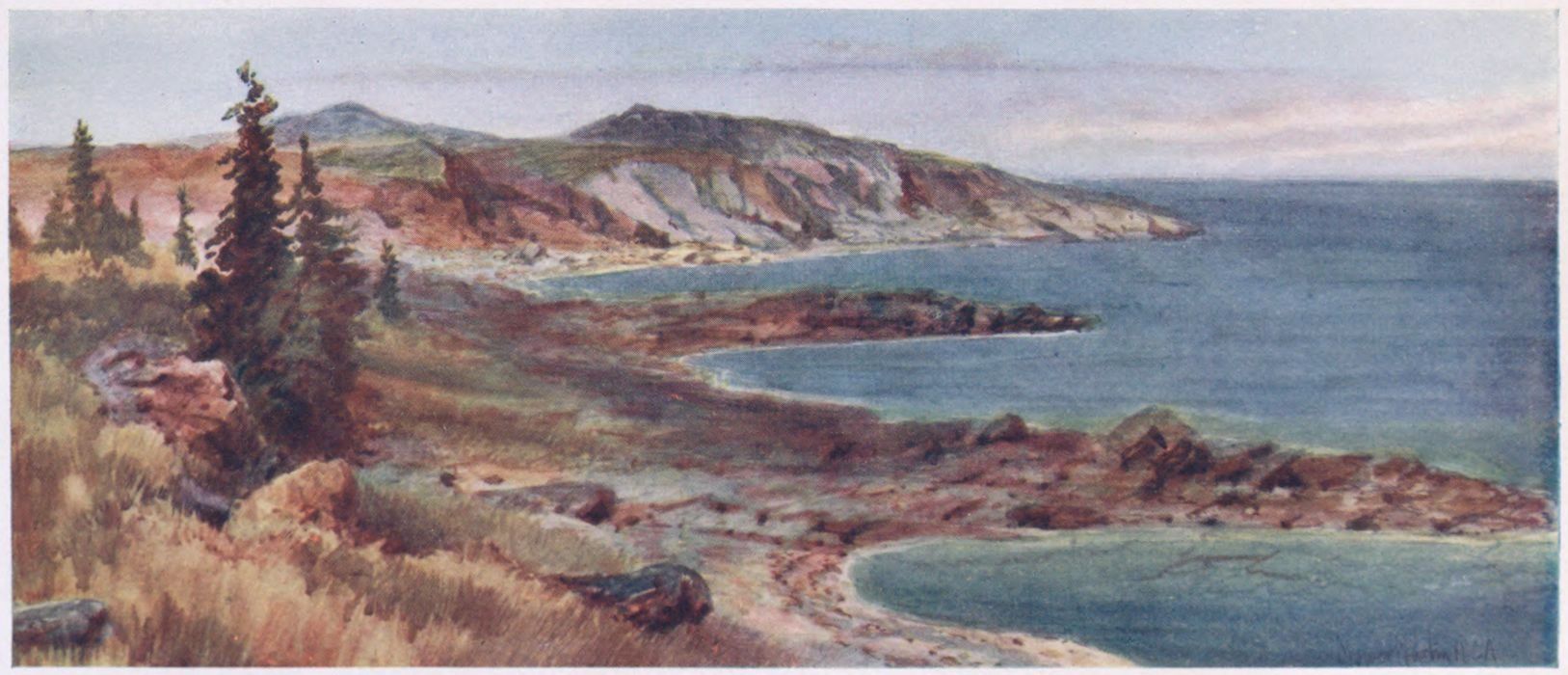
NORTH SHORE, LAKE SUPERIOR
There has been of late years much comment with regard to these mysterious disappearances; and whatever the explanation may be of these sudden catastrophes so peculiar to the lake region, they certainly cast over those waters a mantle of sinister and ominous mystery, which adds to the sombre loneliness and gloom of their vast waters and haunted shores.
The most ocean-like, and most formidable to navigators, of all these waters is Lake Superior. This, the largest fresh-water body in the world, is even more sublime in the appearance of its vast tides and rugged and desolate shore-ways than the others. Proceeding up the Sault Ste Marie river, with its impassable rapids, now overcome by the two great American and Canadian canals, its lonely and picturesque waters are entered. Here is a stretch of inland sea, extending from end to end nearly three hundred miles in length, and over one hundred in breadth. Its wild and rugged north shores are now being opened up as farm-lands, but are known especially to the outside world for the remarkable copper, silver, and other mines which are being developed. Along its south shore are the famous Pictured Rocks, which have long been a problem to the ethnologist and the geologist. These rocks, which are an immense line of stately cliffs hundreds of feet in height, extending along the shore of the lake, are covered in places with a remarkable series of markings, resembling inscriptions, which some contend were made by the mysterious prehistoric peoples who at one time, at a remote period, inhabited these regions. Another remarkable evidence of prehistoric civilisation in this region is found in the ancient workings of the Lake Superior copper mines, which were discovered by the earliest mine explorers. Here a system of mining, which must have been very ancient, was found to exist, and large blocks of the copper were found placed on ancient trestles of wood, which had rotted away in the period of time which had intervened since these ancient miners had ceased their toils. Whoever these people were, it is certain they were not the present Indians who inhabit this continent, and were evidently a race whose civilisation existed prior to the coming of the present nomadic tribes of the red man.
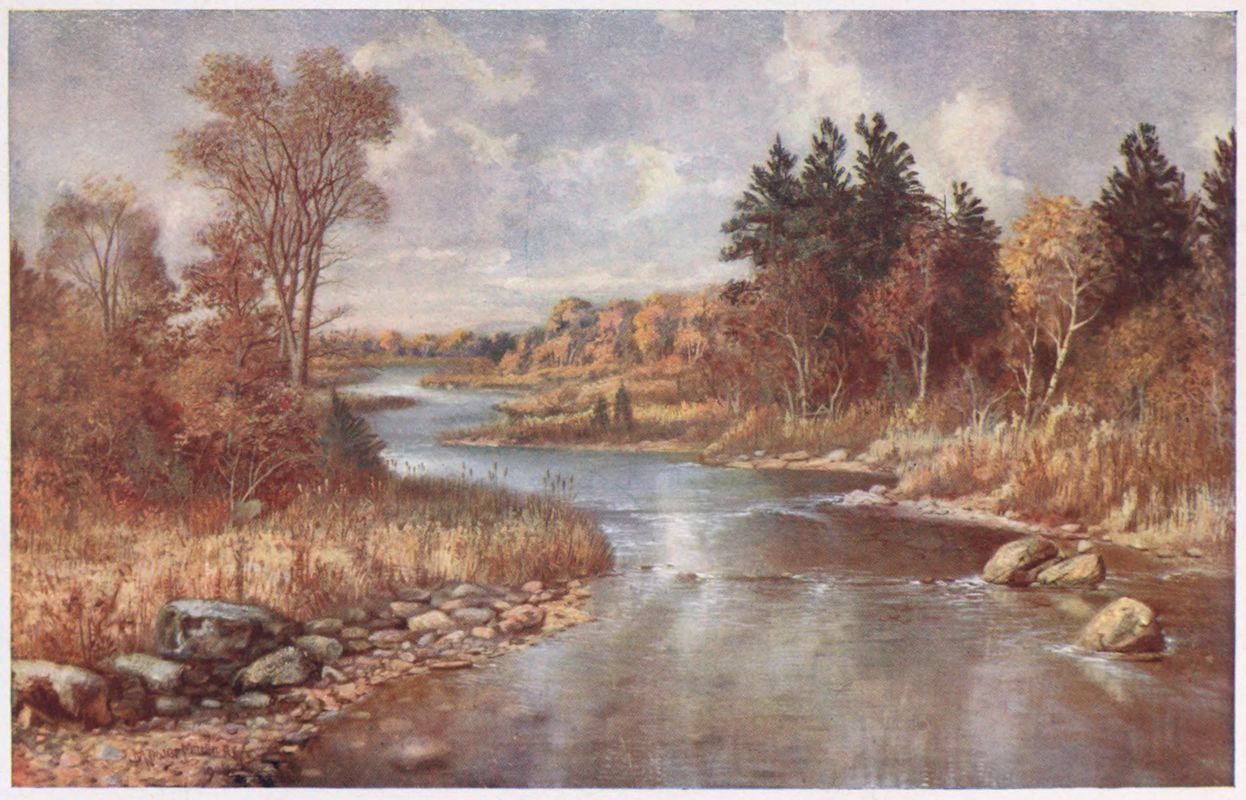
IN THE MOOSE COUNTRY, NEAR LAKE SUPERIOR
At the extreme northern point of Lake Superior is the splendid harbour and inlet of Thunder Bay. Here is the flourishing town of that name; and near it, on another fine harbour, Port Arthur, is the town of Fort William. Near here, also, is the famous Silver Islet, containing one of the most remarkable silver mines ever worked on this continent. Guarding the entrance to Thunder Bay is Thunder Cape, an immense cliff of basaltic rock, thirteen hundred feet high, and one of the greatest and most majestic sights to be seen on the continent. Therefore, having given this short and necessarily incomplete account of this beautiful and legend-haunted lake region, it were fitting that it should close with the following stanzas from an ode to Thunder Cape:—
“Storm-beaten cliff, thou mighty cape of thunder;
Rock-Titan of the north, whose feet the waves beat under;
Cloud-reared, mist-veiled; to all the world a wonder;
Shut out in thy wild solitude asunder,
O Thunder Cape, thou mighty Cape of Storms! . . .
Year in, year out, the summer rain’s soft beating
Thy front hath known; the winter’s snow and sleeting;—
But unto each thou givest contemptuous greeting.
These hurt thee not, through seasons fast and fleeting,
O proud, imperious, rock-ribbed Cape of Storms!
O thou so old, within thy sage discerning,
What sorrows, hates; what dead past loves still burning
Couldst thou relate, thine ancient pages turning;
O thou, who seemest ever new lores learning,
O unforgetting, wondrous Cape of Storms!
O tell me what wild past lies here enchanted;
What borders thou dost guard? what regions haunted?
What type of man a little era flaunted,
Then passed and slept? O tell me, thou undaunted,
Thou aged as eld, O mighty Cape of Storms!
O speak, if thou canst speak: what cities sleeping?
What busy streets? what laughing, and what weeping?
What vanished deeds and hopes, like dust, upheaping,
Hast thou long held within thy silent keeping?
O wise old cape, thou rugged Cape of Storms!
These all have passed, as all that’s living passes;
Our thoughts they wither as the centuries’ grasses,
That bloom and rot in bleak, wild lake morasses:—
But still thou loomest where Superior glasses
Himself in surge and sleep, O Cape of Storms!
And thou wilt stay when we, and all our dreaming,
Lie low in dust. The age’s last moon-beaming
Will shed on thy wild front its final gleaming;—
For last of all that’s real, and all that’s seeming,
Thou still wilt linger, mighty Cape of Storms!”
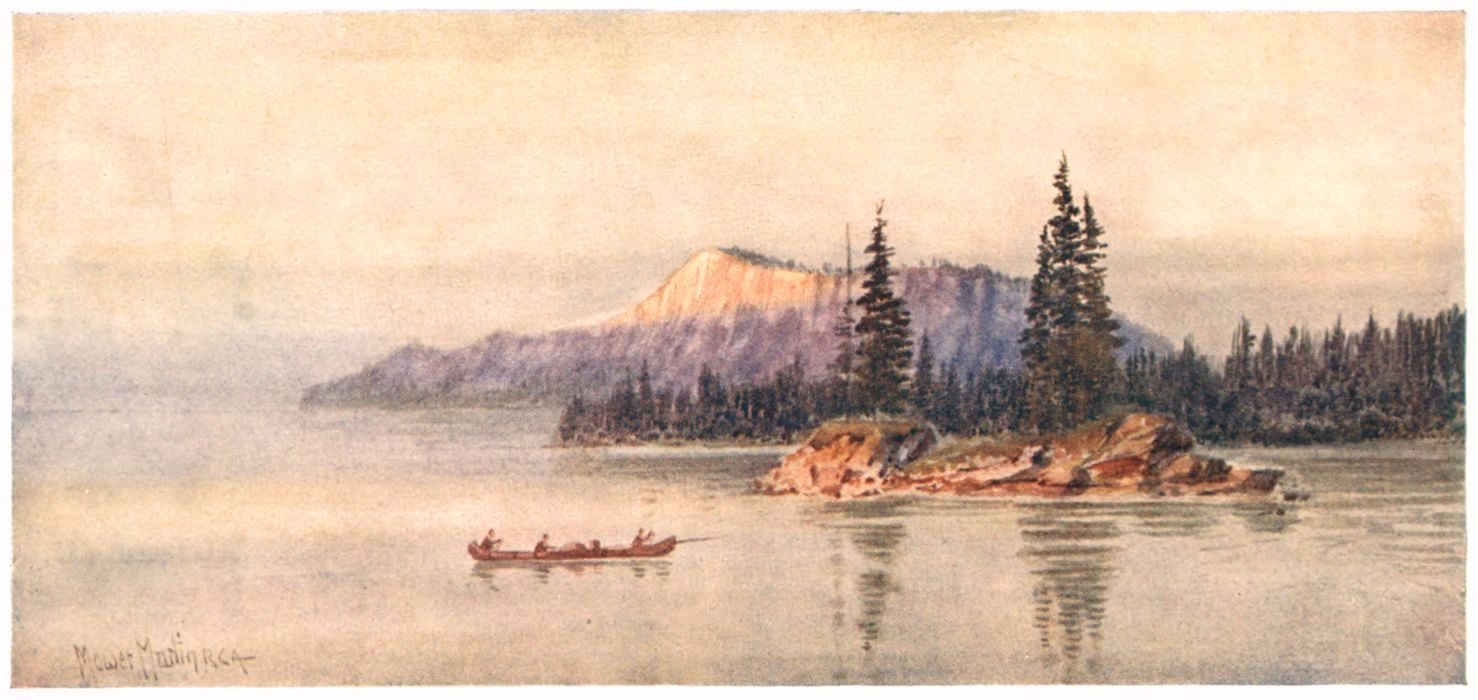
CARIBOO ISLAND, THUNDER BAY
THE OLD NORTH-WEST AND MANITOBA
We now come to a part of the Dominion which, a generation ago, was outside its borders in so far as organised government is concerned. This part of Canada, which stretches from the north-west extremity of the great lakes nearly to Hudson Bay, is now known by the name of the Middle West, and is organised into a province which is, to-day, the central province of Canada, namely, Manitoba.
The history of this newer Canada, which it has in common with the three western provinces of later date, is really the history of the Hudson Bay Company, the two Riel rebellions, and the building of the Canadian Pacific Railway. Around these three clusters all else of interest which has happened in connection with the discovery, acquirement, and development of the North-West. When this is recognised, it will be seen that, while the old North-West and Manitoba are grouped in what is called recent Canada or the Canada of to-day, the real history, and perhaps the most remarkable history, at any rate the most interesting and romantic, connected with that country, dates almost as far back as that of Quebec and the eastern portions of the Dominion.
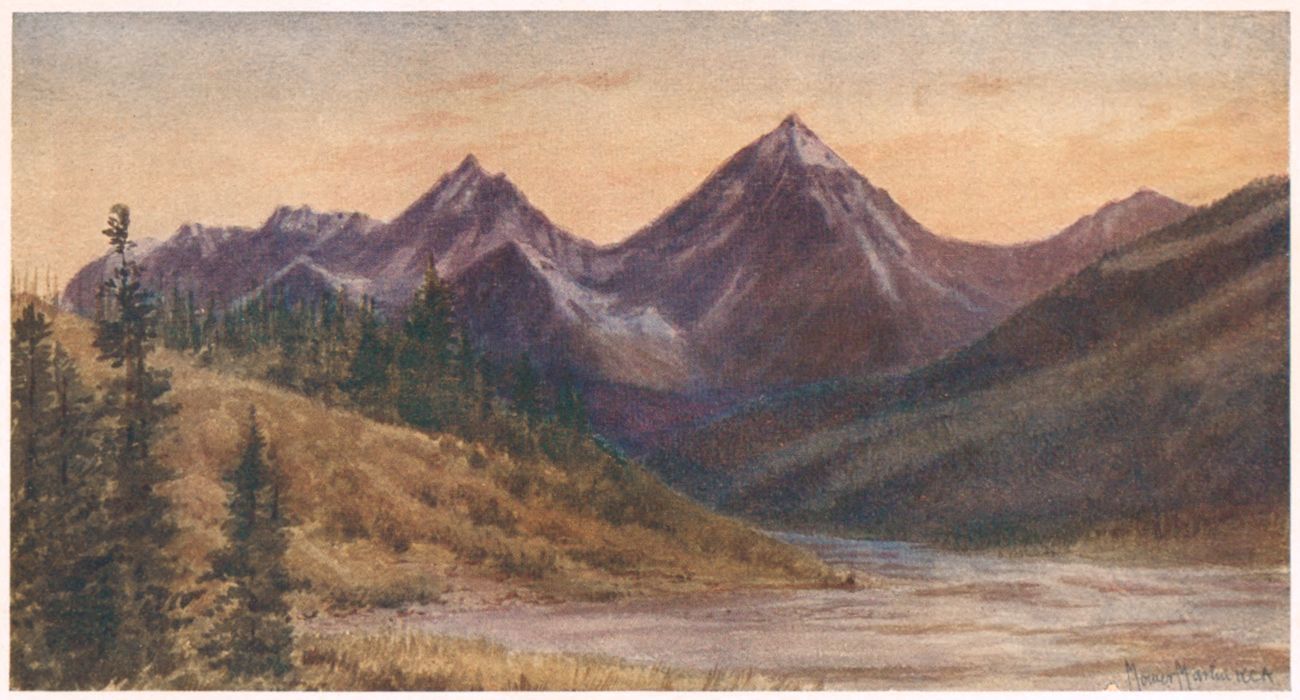
VAN HORNE RANGE (EVENING)
More than this, it will be seen to be the history of a more than ordinary pioneer life and experience; that the energy and determination which entered into the toil and hardship required to achieve in this remote northern region were of no common order. The men who from the earliest days entered the ranks of the Hudson Bay service, and were the pioneers of North-Western exploration, were, as was to be expected, of the Scotch stock. They belonged to that remarkable race which has dominated the history, and has guided the destinies, of this Dominion, as will be seen by the names prominent on the maps of the Canadian West. These are Fort Garry, the Mackenzie river, Fort Simpson, the Fraser river, Fort M‘Leod, Selkirk, Strathcona, and Mount Stephen; and all show who were the men who were the great explorers of the lands and the builders up of the fortunes of this immense territory.
That region known as the great North-West, and which extends from Hudson Bay and Lake Superior to the Rocky Mountains, and from the 49th parallel of latitude to the Arctic Ocean—an area a thousand miles in length and nearly five hundred in width, and more than equal to all of Europe exclusive of Russia—may be naturally divided into two portions. There is the great, mysterious north, watered by the Mackenzie river and its affluents, with their network of lakes or inland seas; where great forests, as yet but partially explored, stretch out to the grim frost-bound regions of the north, to which men persistently turn, regardless of privation and suffering, in their eternal search for gold.
Here is a district rich in minerals, timber, and game, and the climate of which is not more severe than that of Russia, and where the scenery varies from the beautiful to the sublime or awful; a region of the future for the hardy, self-contained, north-loving peoples, who are destined by fate and inclination to conquer its physical disabilities, and make it their own.
South of this there lies that portion of the West which promises, according to the verdict of the inhabitants, to become the great centre of the world, or at least the heart of the Dominion of Canada.
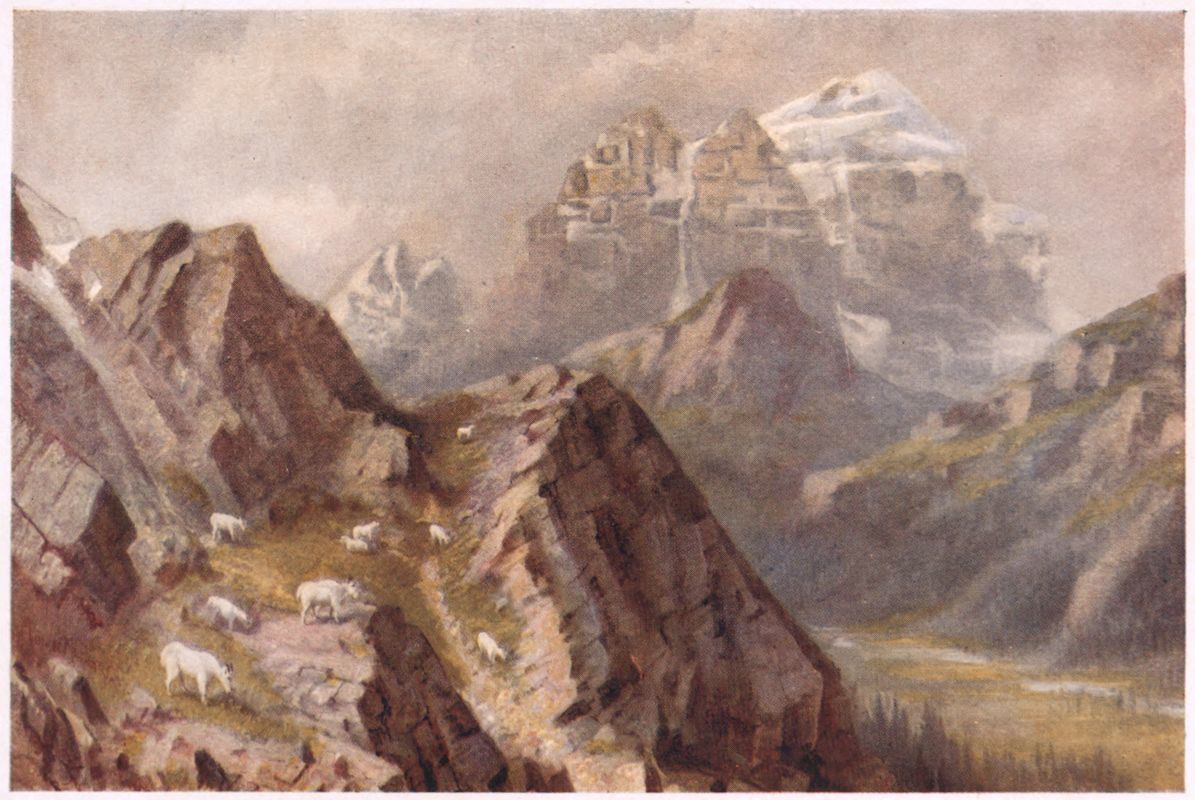
MOUNT TEMPLE, WITH WILD GOATS FEEDING
The northern portion of this vast country remained, until the beginning of the nineteenth century, practically unexplored. For although the Hudson Bay Company had for many years maintained its fortified posts upon the shores of the Hudson Bay, its policy was not in the interests of exploration or development of the western territory. It served its interests better, for the time, to bring the trade down to the forts, rather than to penetrate into the wilds, braving dangers and privations, with much expenditure and toil, in order to exchange merchandise for the furs which were desired and so persistently sought. In this the Company was wise, it being, as Parkman shows, the very opposite of the early French-Canadian policy, which patronised remote exploration, and ended in destroying the fur trade in French Canada.
The Hudson Bay directors were also exceedingly jealous of any encroachment on their territory; for, in the fur trade, any invasion would be unfavourable for more reasons than even the competition that would ensue; so that they kept secret anything which they learned concerning the wealth of the interior, especially the knowledge of the presence of gold.
But this naturally could not last for ever. Hardy adventurers and explorers entered from time to time, ignoring or defying the monopoly of trade which the Hudson Bay Company claimed; and a number of these finally combined under the name of the North-West Fur Company, and systematically prepared to set the Hudson Bay Company at defiance, by establishing their forts in the immediate vicinity of those founded by their rivals.
Then it was that one of the directors of the Hudson Bay Company, Thomas Douglas, fifth Earl of Selkirk, conceived the project of forcing back the new company by establishing a powerful colony of emigrants from the old land in the North-West, whose interests would be identical with those of the Company. This plan was promptly carried out, and in 1812 a colony of evicted Highland crofters from Sutherlandshire was established by the Company in the lower Red River valley; and then began the war between the rival companies, which was to last for some years.
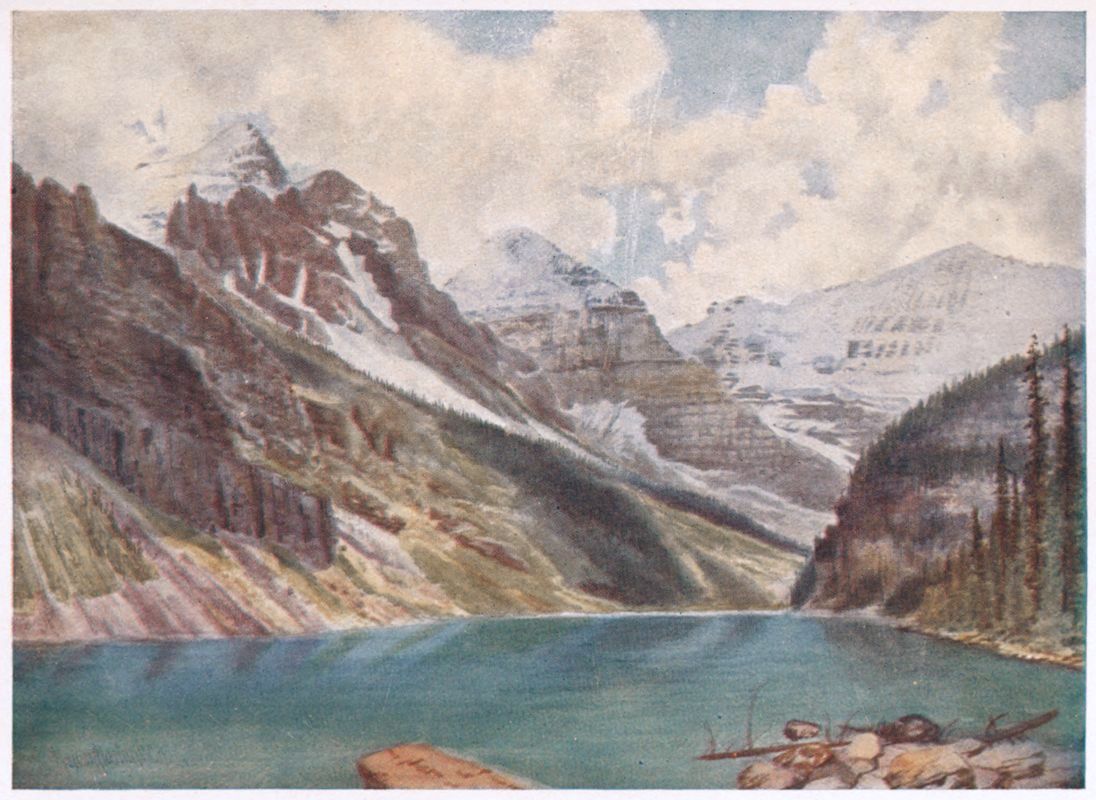
MOUNTS ABERDEEN, LEFROY, AND VICTORIA, ON LAKE LOUISE
Later on, Lord Selkirk bought all the lands near the lower Red River from the Indians, and established more Scotch immigrants. All this was good for the country in the long run; but it was the immediate cause of so much trouble that the conditions in the region affected became rapidly unbearable, and the stock-holders of the two companies, urged by public-spirited men at home and in Canada, agreed to a settlement by which the two companies were merged in one, under the name of the older company.
For a time after this, the Hudson Bay Company still reigned supreme in the district; and although, with the increase of population which they had brought in, came priests and missions, which, in their efforts to spread the Gospel, endeavoured to penetrate farther into the interior, explorations were not encouraged.
The Company now established itself at Fort Garry, abandoning Fort William, which had been taken from the North-West Company. This post was situated upon the north bank of the Assiniboine, a tributary of the Red River. The territory, under the name of Prince Rupert’s Land, was governed by the Company, whose chief commissioner had the title of governor over this territory; and besides their large trading interests, the directors were now invested with powers which necessitated a regular system of government, with administration of laws and establishment of courts of justice. Regular troops were sent out from England to strengthen the administration, but were shortly succeeded by a Canadian military force, with a constabulary. Everything was in the hands of the Company, who were supreme.
But this state of things could not last. In the rush of gold-seekers, they had to loosen their hold upon British Columbia; and Parliament refusing to renew their extensive privileges, in the course of time this great factor in the early settlement of Western Canada ceased to be paramount, and the monopoly they held came to an end; though the Company still exists, and continues an extensive and lucrative trade with the Indians.
Meanwhile the Red River people had established a prosperous trade between Fort Garry and St Paul’s, Minnesota. But troublous and unsettled times followed, and soon led up to the first Red River rebellion, after which the Red River country became the province of Manitoba.
The history of this rebellion, and that of the succeeding one, is too complicated to be dealt with here. The trouble arose over the ownership of the land, between the new-comers, who went into the country, and the French half-breeds, who had been settled there for many years. It is difficult to get at the whole truth of the matter; but there is no doubt other issues were at work, and other influences in the bringing about of the catastrophe, which had its commencement in the murder of Thomas Scott, and its close in the execution of Louis Riel, the principal leader of the first and the second rebellion.
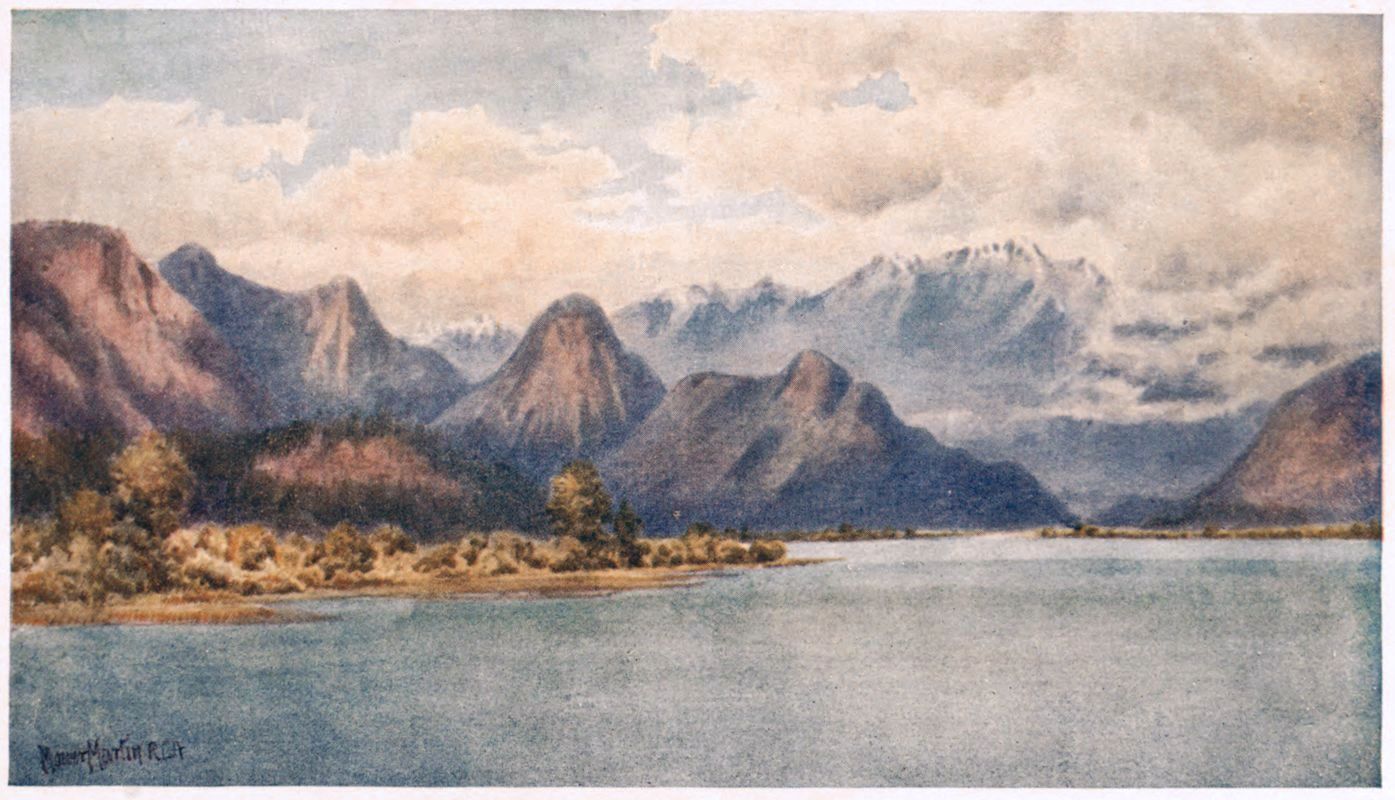
PITT RIVER AND GOLDEN EAR MOUNTAINS
Whatever may be the individual opinion regarding this episode in the history of the Middle West, it cannot be denied that it was in a sense a little war, a struggle, which, whatever be the rights or wrongs of the matter, was one between conservativism and progress; and this troubled period marks the commencement of a newer era; and the suppression of the rebellion was followed by the establishment of constitutional government and the formation of the new province of Manitoba.
With this change, however, the old adventurous, romantic life of the Middle North-West ceases; and the picture of the solitary Hudson Bay posts, the picturesque fur-trader, and the more picturesque Indian, the quaint semi-civilized half-breed, and the romance of the priest and missionary, have already faded from the canvas, and have given place to the less picturesque, more practical era of the land-boomers, the rapidly developing commerce, the widely advertised wheat-fields, and the rush of European settlers, which have created the Winnipeg and the Brandon of to-day. In making this contrast, it is not intended to slight in any way the remarkable development of the Canadian West. The world moves—and moves, we hope, in the direction of higher levels of society and toward loftier ideals; and we hope that this is so of the Canadian North-West, and that, when the earlier, cruder, more material stage of its development shall have passed, the more ideal life, the closeness to nature, and an era of culture will take its place. Meanwhile there lingers the picture of the early life in the region of the Red River, described so very beautifully by the American poet Whittier, in his Voyageur:—
“Out and in the river is winding
The links of its long red chain,
Through belts of dusky pine-land,
And gusty leagues of plain.
Only at times a smoke-wreath,
With the drifting cloud-rack joins—
The smoke of the hunting-lodges
Of the wild Assiniboines’
Drearily blows the north wind
From the land of ice and snow;
The eyes that look are weary,
And heavy the hands that row.
The voyageur smiles as he listens
To the sound that grows apace;
Well he knows the vesper ringing
Of the bells of St Boniface:
The bells of the Roman mission,
That call from their turrets twain,
To the boatman on the river,
To the hunter on the plain.”
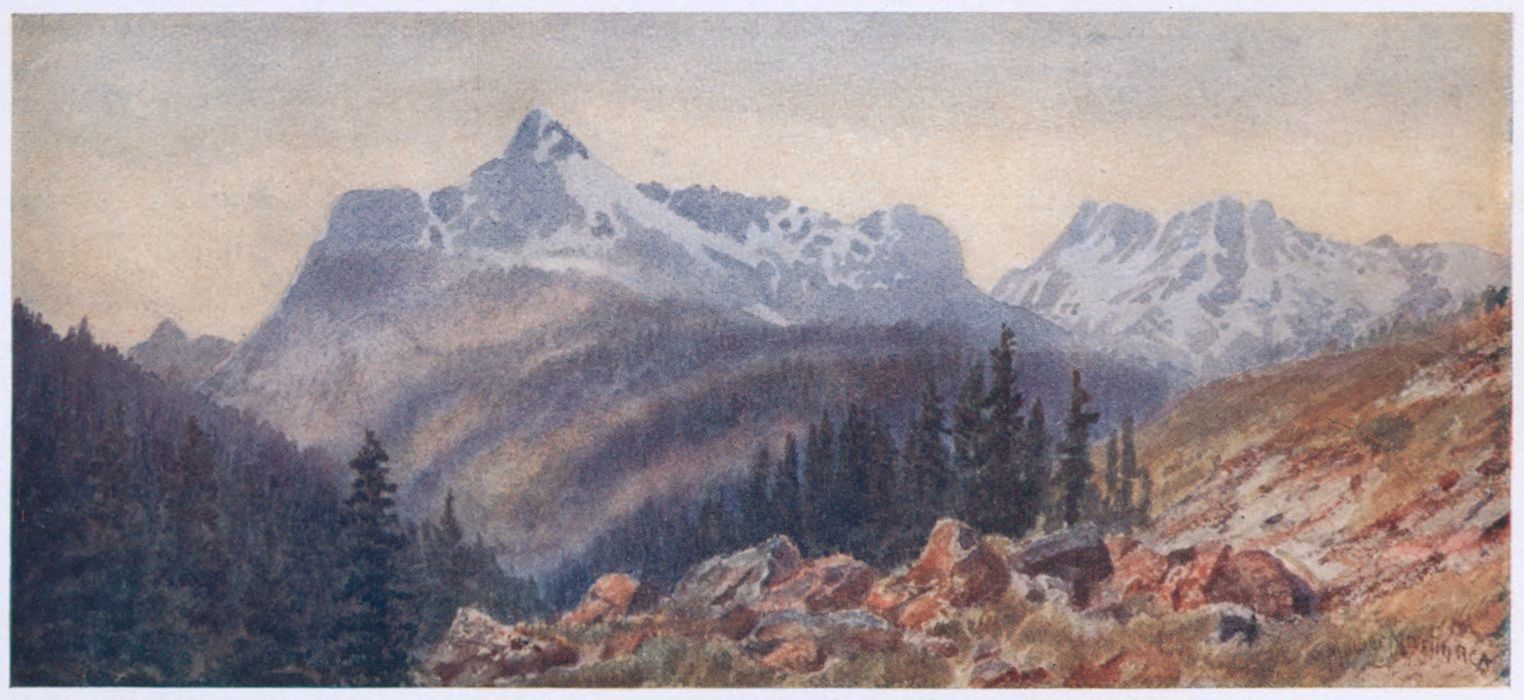
FROM THE FOOT OF EAGLE PEAK, SELKIRK MOUNTAINS
This is the spirit of the Middle West of the past; and remarkable it is that, as Longfellow, a poet of New England, should have preserved for us the spirit of the earlier Canadian life of Acadia in his beautiful Evangeline, it is another New England brother singer who so beautifully commemorates this, the vanished life of the early North-West, which corresponds so sympathetically with the Acadian life of Eastern Canada.
In contrast with this beautiful picture of the old North-West, let me quote here a few lines from the pen of a poetess of the new province. It is entitled Manitoba. It is a song of the wheat-field, the prairie home, and the giant cities of the future:—
“Softly the shadows of prairie-land wheat
Ripple and riot adown to her feet.
Onward, and onward, her fertile expanse
Shakes as the tide of her children advance
Onward, and soon on her welcoming soil
Cities shall palpitate, myriads toil.”
But all of this remarkable development from a wild region of fur-traders, half-breeds, and Indians to a prosperous province, did not come about spontaneously or in one day. Something else had to take place before a province, even in the Middle West, would be practically possible. Another story has to be told, and the history of a great undertaking related, which changed the current of Canadian history, and determined for ever the national and political future of the northern half of North America; and this was the building of the Canadian Pacific Railway.
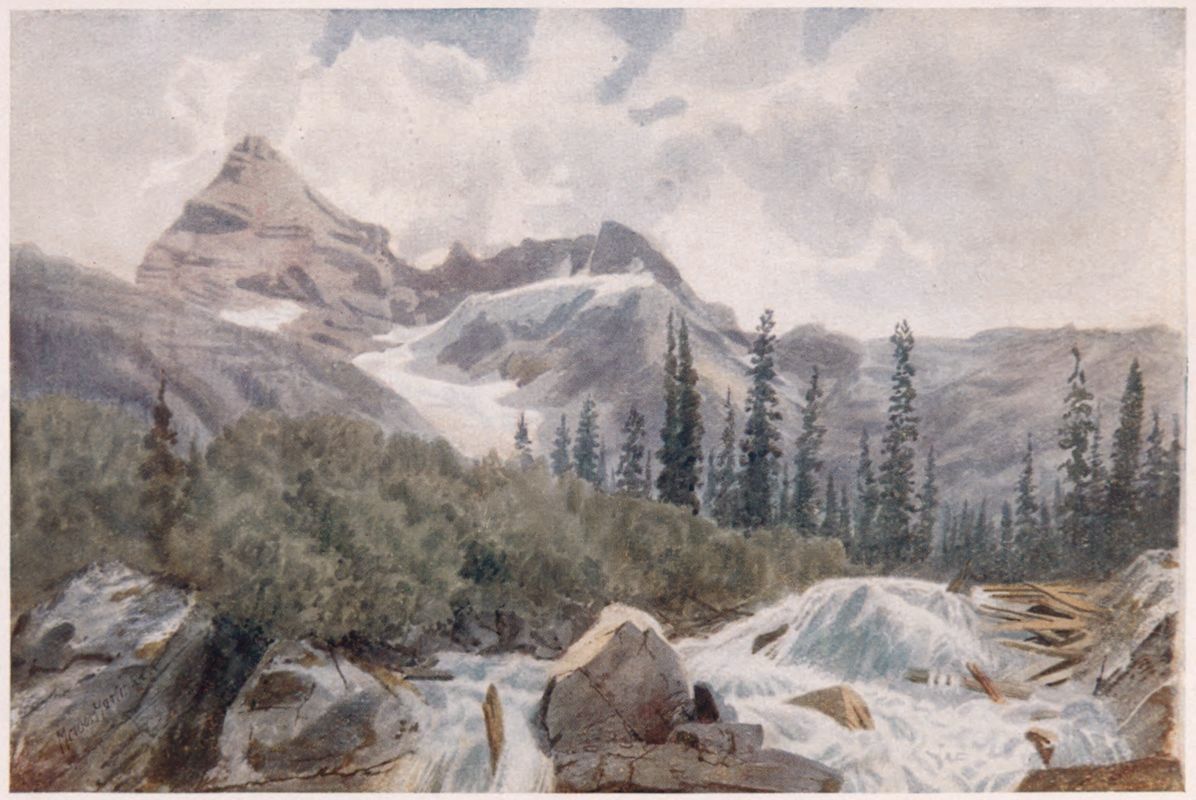
MOUNT SIR DONALD, IN THE SELKIRKS
The story of this vast and responsible undertaking, which bound by bands of steel the remote east and west of the Dominion, and made them one country, is necessarily the history of that remarkable Scotch Canadian, Donald Smith, now a peer of the realm, under the title of Lord Strathcona and Mount Royal. This distinguished man was born in Forres, in Scotland, in the twentieth year of the nineteenth century. Rejecting the study of law, he at the age of eighteen entered the Hudson Bay Company’s service, and came out to Canada, where by hard work and ability he rose step by step to be the chief factor, and in time chief commissioner in Canada, and resident governor of the corporation.
He became prominent as a special commissioner, dealing with the first Riel rebellion. In 1870 he became a member of the Legislature for Winnipeg, and ever since has played an important part in Dominion politics. In 1896 he was appointed High Commissioner for Canada in London, and sworn a member of the Canadian Privy Council. He had already been knighted, and in the Diamond Jubilee year was raised to the peerage.
His name will always be associated with the history of the development of Western Canada, and he may be said to have been the founder of the Canadian Pacific Railway. Sir Charles Tupper, a distinguished Nova Scotian premier of the Dominion, said in the House of Commons that the Canadian Pacific Railway would have had no existence to-day, had it not been for the indomitable pluck and energy and determination, both financially and in every other respect, of Sir Donald Smith. Lord Strathcona is famous to-day over the Empire. His patriotic service and conduct, in sending out the Strathcona Horse to South Africa, and his munificent benefactions to universities and other public institutions in Canada and in Scotland, have added to his other remarkable services to humanity.
The building of the Canadian Pacific Railway was the real foundation of the great West. The knowledge of the great wheat-lands to be had for the taking, brought thousands from the older parts of Eastern Canada, especially from Ontario, whose people may be said to be the immediate ancestors of the pioneers of Manitoba. Indeed, this province has often been called a newer Ontario. The rich grain-fields of the new West soon got a wider fame, and emigrants began to pour in from Europe, and in a few years the country became known as the great grain centre of the world. The result has been that Winnipeg is to-day one of the leading cities of Canada, and is even called the northern Chicago.
It is the seat of a university and two colleges; and there has even been a suggestion that it should be the capital of the Dominion.
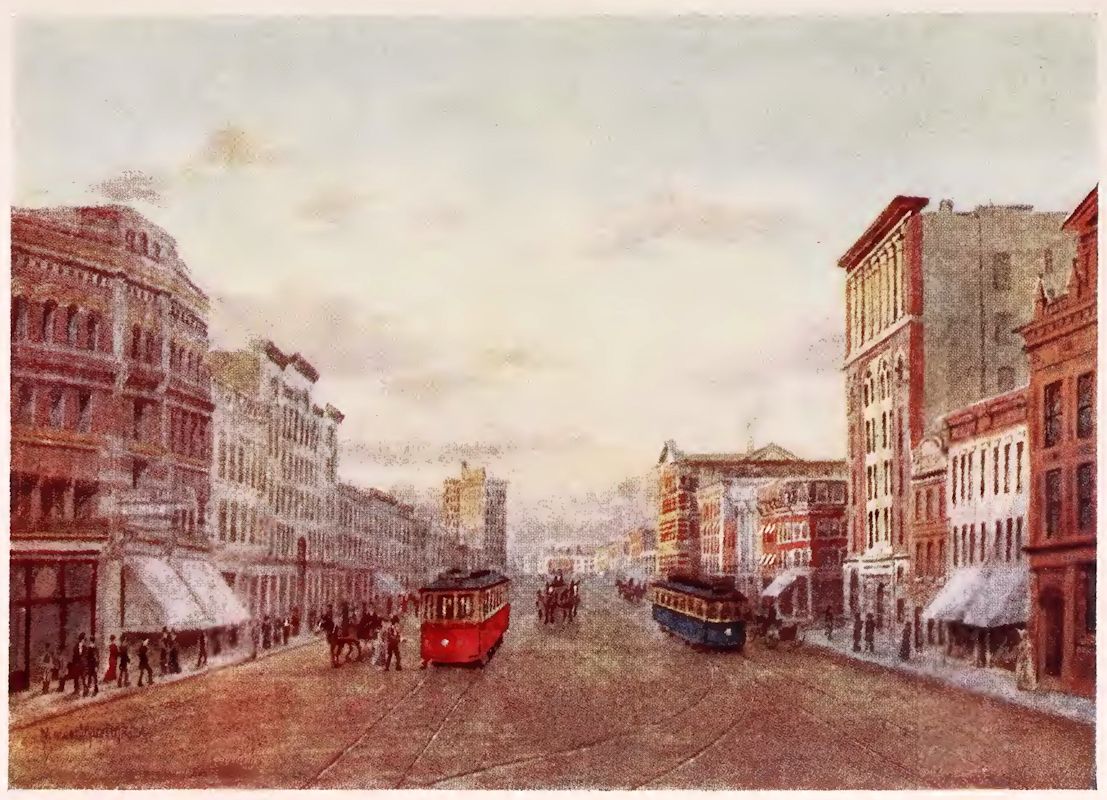
WINNIPEG: CORNER MAIN STREET AND PORTAGE AVENUE
Meanwhile it is also the seat of a very active provincial government, which makes itself felt in the Dominion, in common with those of the three western provinces, as a new force in the country, which bids fair to dominate in the affairs of the future, and control the destinies of the coming generation. But everything has its compensations. Time is a remarkable wizard who makes weird changes; and Manitoba, once the centre of our extreme western activities, has already come to be regarded as the older or middle west, and not so modern, new, and so desirable a place, for the adventurer after fortune, as the more recently developed communities, Saskatchewan and Alberta, which are known as twentieth-century Canada. This is the natural result of the boom system of building up a country, which our people have borrowed from our American cousins; and the wave of notoriety must necessarily follow the horde of land-grabbers and others interested in large profits and quick returns. Therefore it is not to be wondered at that Manitoban lands are not regarded as so productive as those of the newer West. But in spite of this natural decline in material reputation, this province holds her own, and has entered on a more permanent if slower condition of advancement.
Here are the great plains and prairies of British North America. The scenery, while more monotonous than that of the rest of Canada, has its own special beauties. The vast undulating seas of waving grass, spangled with flowers, and the grim cattle plains under clear-blue skies, are well worth seeing. There are several branch-lines of the Canadian Pacific Railway in Manitoba, running to points of interest, and enabling the traveller to see the farm-lands. Here the prairie, stretching to the horizon, is broken by small houses and scattered groups of buildings, while vari-coloured patches show where the soil is under cultivation. Men riding upon the great farm-implements of the West, driving four-in-hand, are ploughing and harrowing the soil, or cutting grain at a speed which would astonish a European. Occasionally there is a bit of marsh-land, with little ponds of still water, which break the landscape. It is, on the whole, a fairly equable climate—more reliable than that of the East or Far West. The springs are early, and summer advances rapidly to great heat in midsummer. Grain ripens quickly, and there is little rain at harvest-time, so that crops are gathered in without dread of wetting; and though there is sometimes early frost, the abundant average yield more than compensates for this danger; and the same may be said of the other two provinces to the west.
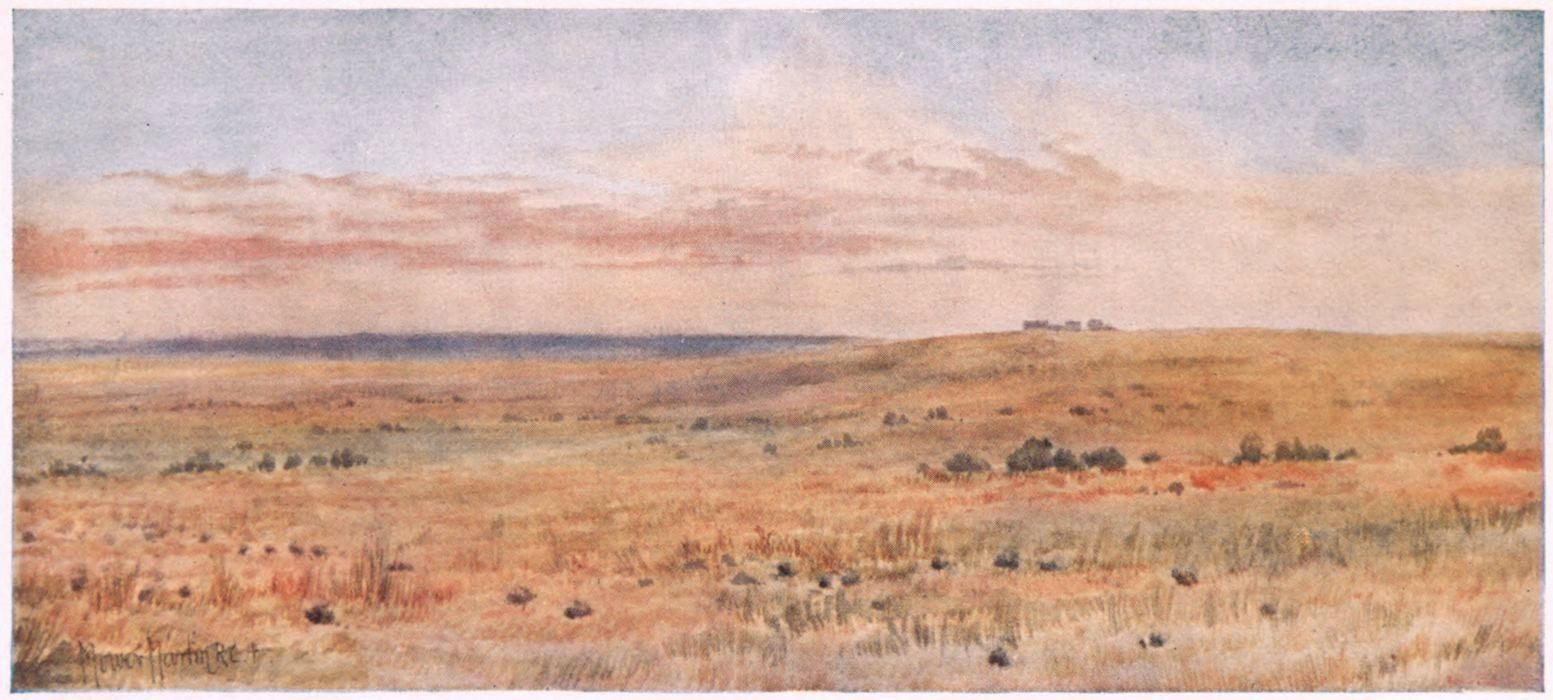
OUT ON THE PRAIRIES
Of the country in the vicinity of Hudson Bay and its southern extremity, James Bay, not much can be said, though tales of its fertility reach us from time to time. This region is chiefly interesting as the scene of operations of the Hudson Bay Company in its earlier days. There is picturesque scenery along the rivers which flow into James Bay, and there is good sport for the fisher and hunter who care to go so far afield.
But the land is not suited to farming. This district, lying between Ontario and Manitoba, and extending north to Hudson Bay, is named Keewatin, or Keewaydin, the romantic name given by the Indians to the region at the northern end of the Lake of the Woods, and which means “the North Wind coming back.” This was a spot beloved by the Indians, both Chippewas and Crees; and the beautiful lake, a favourite haunt. The country in the vicinity of the lake is particularly romantic and beautiful. The lake itself is one of the great chain of lakes which, with their connecting links, stretch across the continent between the great lone land and the more fertile and salubrious plains to the south. The Lake of the Woods is one of the most beautiful and romantic of these. It is a veritable paradise for sportsmen. Near it is Lake Winnipeg and the Falls of Winnipeg, which themselves are well worth seeing, and are among the most beautiful on the continent, not only because of their own grandeur, but on account of their beautiful setting, the colouring of the high wall of rock which rises above, clothed with lichen, ferns, mosses, and flowers, with the snowy, seething depths below.
From Manitoba east to Labrador, and south to Ontario and Quebec, is the region now of most interest to miners, lumbermen, and railway-projectors. It is no doubt the Eldorado of the seeker after the unknown in the mineral world, and may yet be the richest mining region of America. Meanwhile it is one of those vast areas of unexplored wilderness which make Canada seem but another undeveloped Russia.
The new railway, which Sir Wilfred Laurier has so much at heart, will do much to open up this vast unsurveyed region, and move Canadian civilisation several degrees farther north than was supposed possible.
It is such tremendous undertakings as this railway is proving to be, that are earning for the Dominion of Canada the name of the country of the twentieth century. When the Grand Trunk Pacific Railway is completed, and the second great continental highway binds either ocean, Canada will be, in many senses, the chief highway of the civilised world.
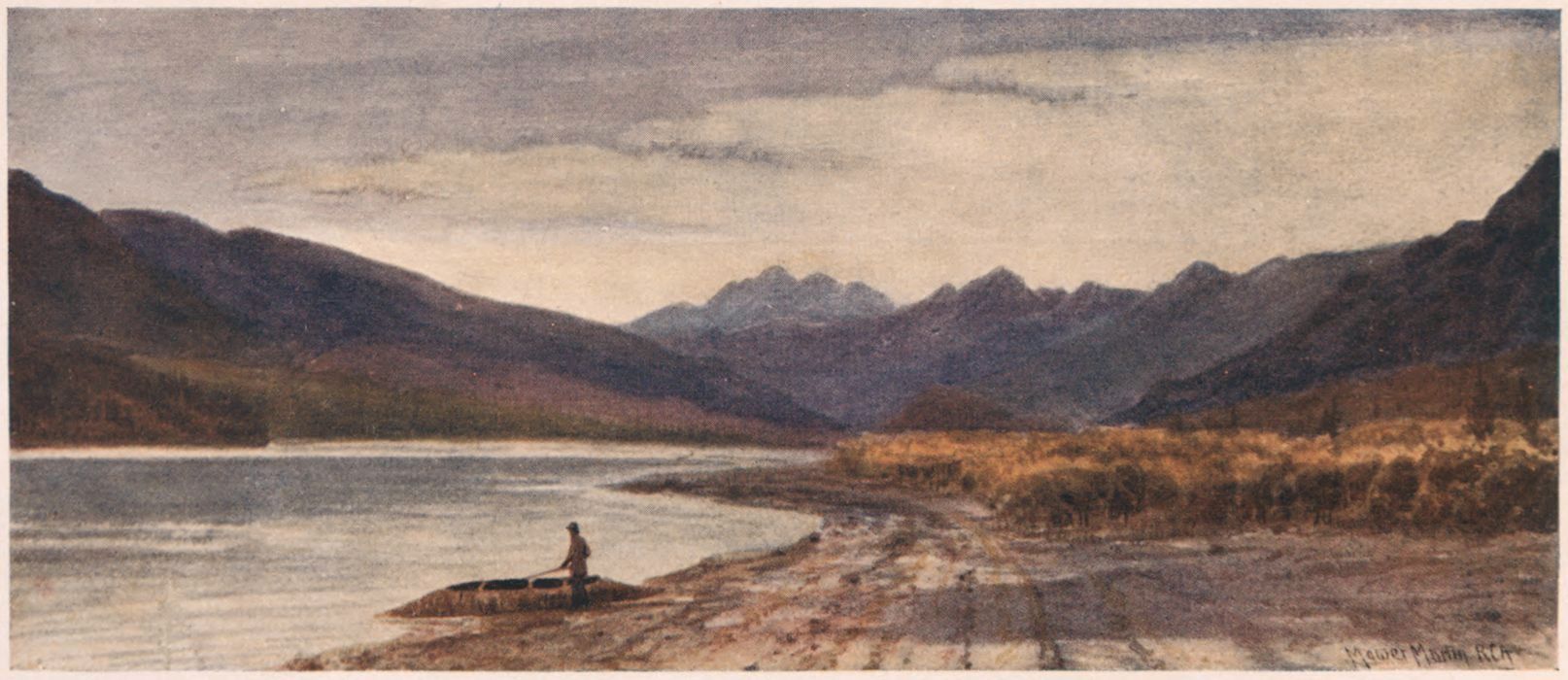
ON ARROW LAKE, COLUMBIA RIVER
THE TWO NEW PRAIRIE PROVINCES
The really new Canada of the present, unless it is the Cobalt mining district, is that part of the Dominion comprising the young provinces, Alberta and Saskatchewan. These provinces have lately been formed out of what was at one time called the Farther West.
This is the region of the western Indians, those roaming prairie-bands which hunted, in years past, the now extinct bison, and were a fierce, nomad people. But even here the red man has, like Esau of old, sold his birthright, and has long ceased to offer any resistance to the ever-encroaching advance of the white population. They are, however, still to be seen everywhere through the North-West, adding, in many cases, with their gay-coloured blankets, curious wigwams, and fleet ponies, to the picturesqueness of the landscape.
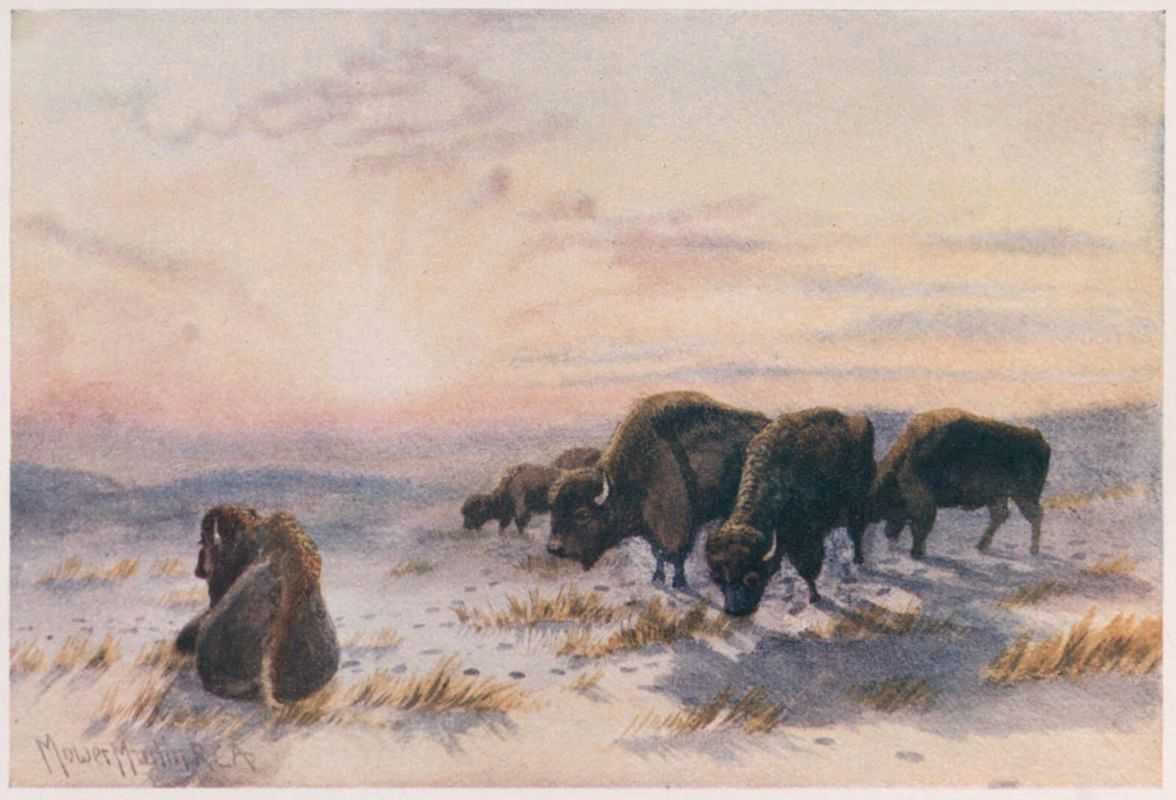
BUFFALO FEEDING IN WINTER
The chief agency for many years in opening up the North-West was the cattle ranch. What the backwoodsman was to the East, the rancher was to the West, the pioneer of civilisation. The successful rancher was a man who cared little for the comforts, and less for the refinements, of civilisation, and who chose, by temperament, the wild, free, and unconventional life of the open. What has of late become an affectation of a certain class of American literature, was the real life and unwritten creed of the western ranchman. He lived all day, and a large part of the night, out of doors, his pillow the prairie grass, and his candles the stars. It was, to a special type of healthy young Britons, who found the restraints of counting-house and social life at home too confining, a very paradise of physical freedom.
It was a splendid escape-valve for the over-pressure of old-country restlessness, which, out in the opens of the new world, developed a condition of physical manhood of the splendid physique exemplified in the Strathcona Horse—a body of men of whom any country might well be proud. But the old-countryman was not, by any means, the only pioneer of the Farther West. Eastern Canada, especially Ontario, furnished the greater portion of the early inhabitants of this productive region. The young men on the eastern farms, who desired more land, and the larger possibilities of the new territories, deserted the older provinces for the country of the future.
The ranching section is chiefly confined to Southern Alberta and Western Assiniboia. Here the winter season is neither severe nor prolonged. The days are bright and cloudless, and the light snowfalls are neither frequent nor lasting. They vanish before the warm Chinook winds, and are followed by days of soft weather. There are cold snaps in January and the early part of February; but the winter breaks up early in March, and before April the prairies are spangled with flowers, false-indigo, shooting-stars, and violets, with roses, lupines, and vetches following after, until the prairie is all a glory of wonderful colour. The atmosphere here is very dry, and the thermometer rises very high in the summer days; but the nights are cool, so that sleep and rest follow easily after the heat and exertion of the day.
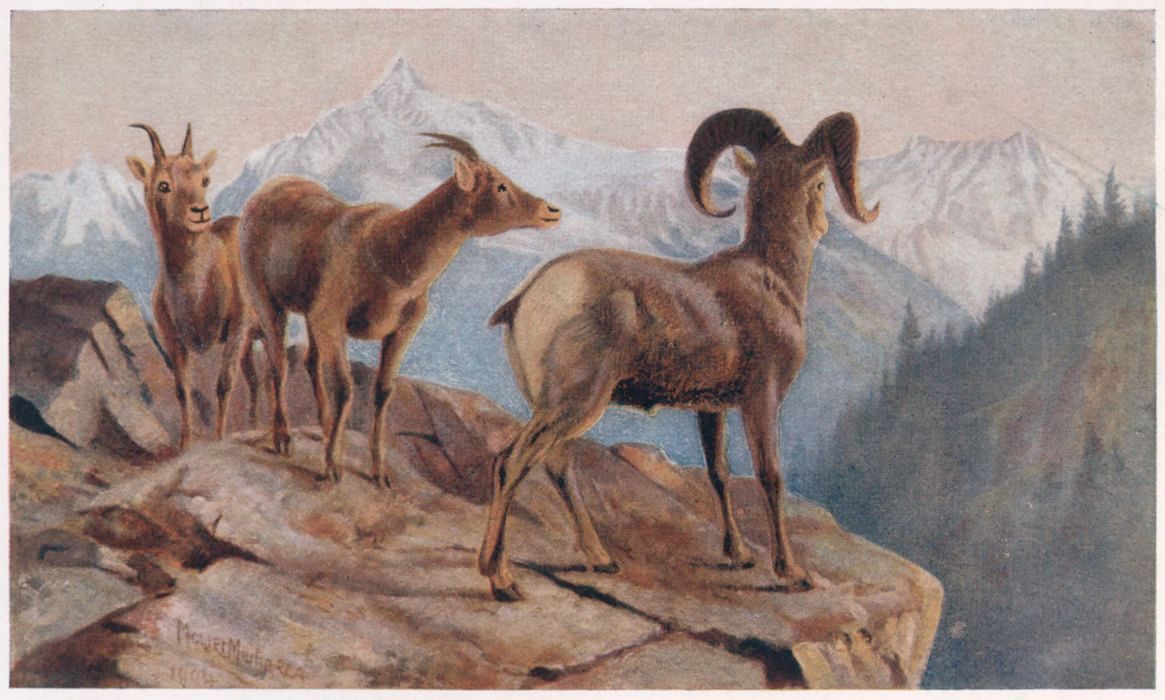
MOUNTAIN SHEEP AT HOME
The life of the cowboy, though not so romantic as some writers would make it appear to be, yet has its interesting side to the man who loves the life of a rider in the open. The business of ranching has grown from a small beginning of the early days, to be one of the great industries of the West. It began when the Mounted Police brought into Southern Alberta a couple of milch cows and a few yokes of oxen for their own use. Shortly after, a Montana trading company brought in a small herd of cattle to provide beef for the police.
Then in the year 1876 a member of the Mounted Police bought a small herd, consisting of one bull and fourteen cows; and, having no other way of providing for them, he turned them loose on the prairie to take their chances; and the result of this experiment, whose importance was little dreamed of at the time, was entirely and surprisingly satisfactory. Without shelter or provision for food, they survived the winter, and took their chances with the buffalo, the wolves, the Indians, and the prairie fires, and proved their fitness to share the fortunes of the creature inhabitants of the treeless wilds.
The early history of the ranching industry is exceedingly interesting. Late in the autumn of the year 1873, a brave and enterprising band of men pushed out into the wilderness, from what is now Winnipeg, and reached the neighbourhood of the Saskatchewan. Here they founded Fort M‘Leod, and under the leadership of Colonel M‘Leod, then commissioner of the Mounted Police, they planted the British flag, and made a new outpost of the Empire in the then remote West. It was not long before there were several large ranches in the vicinity. These ranches were the nucleus of a community, which the presence of the Mounted Police helped to build up, and which it virtually protected and ruled for many years. Since then, as time has progressed, the ranch business has become one of the most valuable and lucrative in the world. Conditions have changed, and finer business methods have been applied; so that now the profits of a successful ranch are exceedingly large. It is only a quarter of a century since the institution of this industry; and yet, to-day, more than sixty thousand head of cattle are annually exported. There are nearly two hundred million acres of grazing lands in the two provinces; so that it can be imagined what a future there is for this important business, which comprises the production of sheep, horses, and cattle.
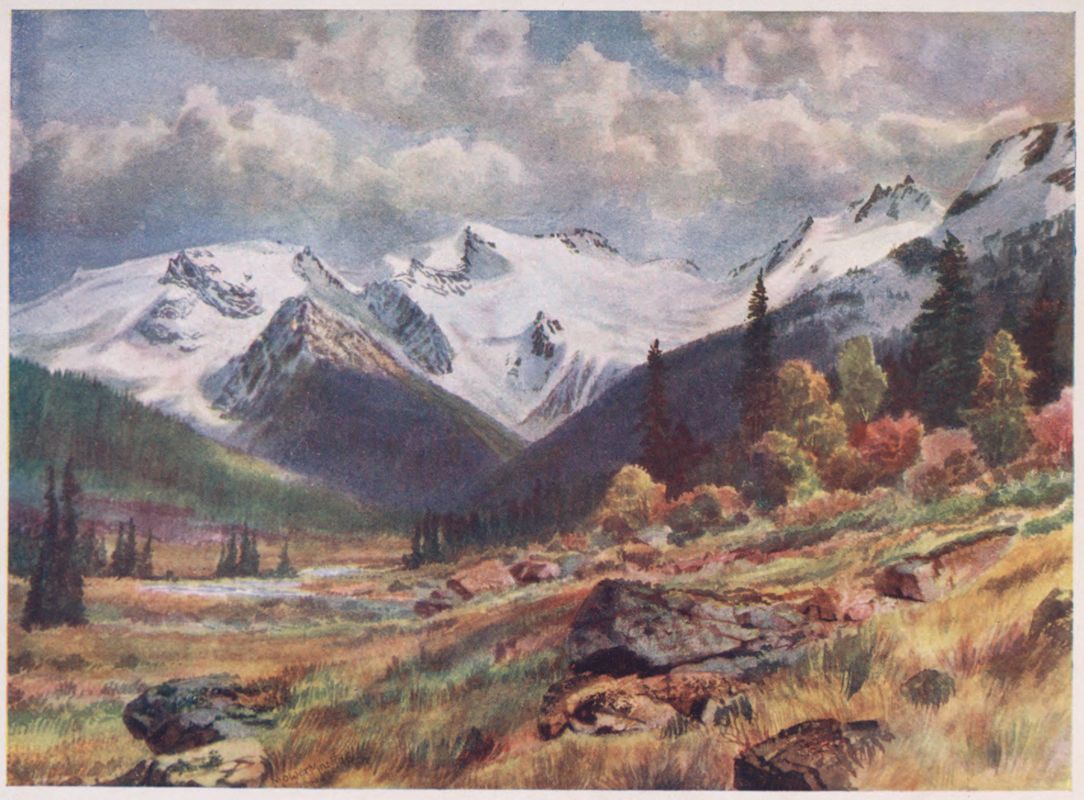
THE VALLEY FROM ROGERS PASS
The province of Saskatchewan was created in 1905, out of the eastern portion of the territories of Assiniboia, Saskatchewan, and Athabasca. It lies to the west of Manitoba, and has nearly three times the territory included in that province, containing nearly one hundred and sixty million acres. It is a country for wheat, mixed farming, and ranching, and is destined to be one of the greatest wheat-growing regions in the world. It has a desirable climate, no cyclones or violent storms, and possesses good water. Along the line of the railway many flourishing towns have sprung up. The appearance of the country is park-like, with alternating groves of poplar and willow, and prairie.
There are in the south many branch railways, and the Grand Trunk Pacific will build across the north-east corner of the southern portion of the province. Of the rivers, the Saskatchewan is a magnificent stream, with a great number of tributaries. It waters a large territory, taking its rise in the Rocky Mountains, and emptying its waters into a chain of lakes west of Lake Winnipeg. It is navigable, and will yet prove an important medium for transportation of freight as the region develops. This province is also becoming known for its facilities for dairy-farming. It has luxuriant grass, a mild climate, plenty of water-springs, and cool nights. Like its sister province to the west, it has abundance of coal close to the surface.
Alberta comprises the old Alberta district, a part of the western portion of Assiniboia, and Saskatchewan, and the western half of Athabasca. It contains nearly one hundred and sixty-two million acres, and is twice the size of Great Britain and Ireland, and much larger than either Germany or France. While it could contain easily fifty million people, it now has a population of only two hundred thousand.
The southern part of this province has an attractive climate, the winters being mild, with little snow, and the summers very pleasant; and the Chinook winds disperse any snow which falls, and create a sunny, warm temperature. Here the system of irrigation has furnished an abundance of water from the many streams flowing down from the mountains.
The ranches vary in size from one thousand to twenty thousand acres. Some of the largest of these are operated by companies, and many of the smaller are run by Englishmen with capital.
Of late the sound of the reaper is heard, where once the cowboy held sway; and the growth of grain, and beetroot for the manufacture of sugar, is rapidly developing, especially in the western section.

PITT MEADOWS, ON THE FRASER RIVER, BRITISH COLUMBIA
Central Alberta comprises that valley, about two hundred and fifty miles in length, which stretches past the Battle, Red Deer, North Saskatchewan, and Sturgeon rivers, from north of Calgarry. This country has plenty of wood and water, the hillsides furnishing the one and the other. The chief city is Edmonton, a place of growing importance, lying in a fine region.
The scenery is picturesque, and varied according to the locality. Now it is wide and level prairie-land, bounded by the horizon only. Again it is rolling and undulating. Again, hill and valley meet the eye, with, flowers, and grasses, and splendid groves of spruce, aspen and poplar. It is also a country of open water and waterways, being sprinkled with myriads of ponds and lakes of all sizes, and quiet streams; while the magnificent valleys of the larger rivers, such as the Saskatchewan, complete a delightful panorama of pastoral beauty.
Perhaps the most important institution in the Far West, for many years, was the Mounted Police Force. It was this body of men which had most to do with the early opening up and the development of this vast region. The history of this splendid corps dates back nearly thirty years; and while it was originally organised for the protection of the pioneer and the enforcement of law and order, it also formed a nucleus for settlement in many parts of the West, and made sparse habitation possible. The first duty of the police had to do with the care of the Indians, and the prevention of the savage and other encroachments from the country to the south. But they became, in reality, the advance-guard at the outposts of Western civilisation; and where they advanced, their forts soon became centres of pioneer activity, such as ranching.
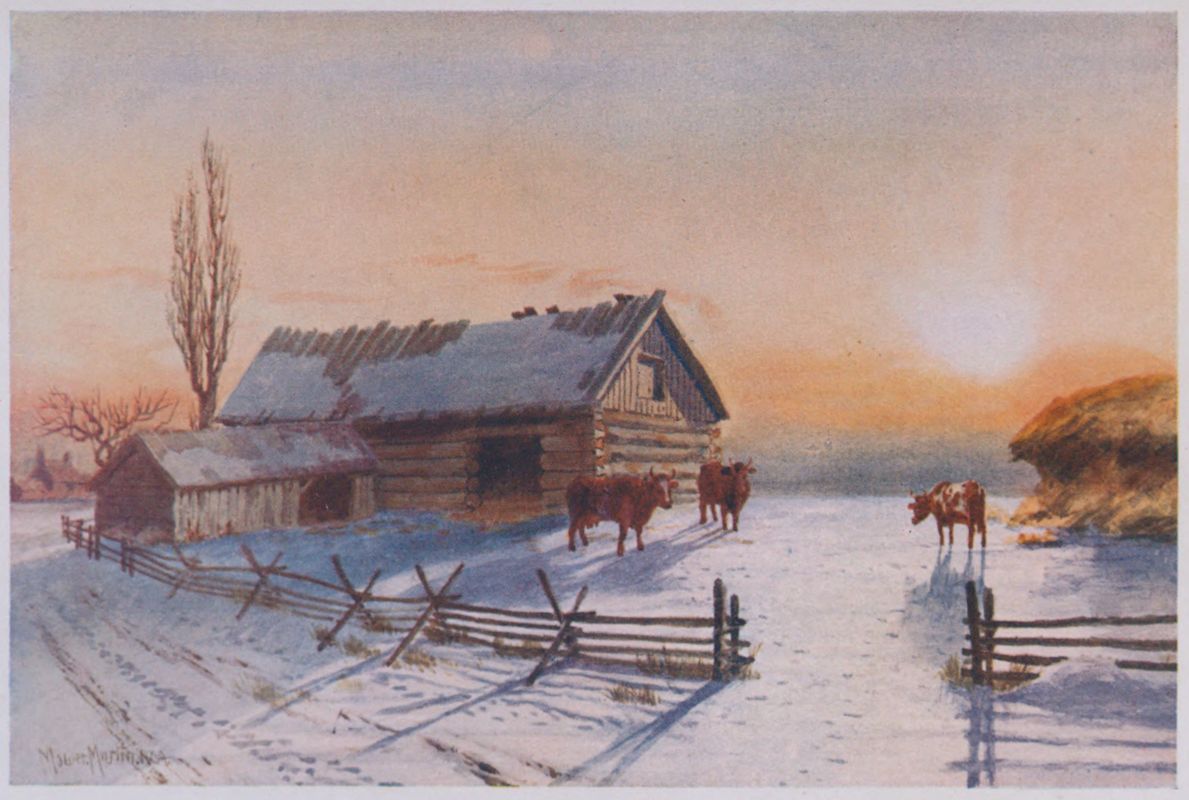
BACK COUNTRY FARMYARD, WINTER
Carefully selected from the first by the Government, and placed under the most expert management, they have become famous as one of the finest bodies of mounted men for police purposes in the whole world. The members of the force were at first engaged for a period of years, and at the end of their time were entitled to a special grant of land, with the result that many of them took advantage of this, and are now among the most successful and prominent men in the West. For a long time, however, their life was a lonely and hard one; and it needed a strong will and an iron constitution to meet the requirements of this arduous and difficult service. The following spirited lines from a poem composed by two of these pioneer heroes in the early days of their worst hardship, may be interesting to some of the readers of this work, who can sympathise with the lives of many who, at the outposts of Empire, have to suffer and struggle to make it and keep it what it is. This poem is one that should be in the Canadian anthology of verse. It is the song of these brave veterans, as they marched, in the year 1874, into the North-West Territories, and it is aptly called:
THE RIDERS OF THE PLAINS
“We wake the prairie echoes with
The ever-welcome sound,
‘Ring out the boot and saddle’ till
Its stirring notes resound.
Our horses toss their bridled heads
And chafe against the reins;
Ring out, ring out the marching call
Of the Riders of the Plains.
Full many a league o’er prairie wild
Our trackless path must be,
And round it roam the fiercest tribes
Of Blackfoot and of Cree;
But danger from their savage bands
Our dauntless heart disdains,
That heart which bears the helmet up
Of the Riders of the Plains.
The thunder storm sweeps o’er our way,
But onward still we go;
We scale the rugged mountain range,
Descend the valleys low;
We face the dread Saskatchewan,
Brimmed high with heavy rains;
With all his might he cannot check
The Riders of the Plains.
We muster but three hundred
In all this great lone land,
Which stretches o’er the continent
To where the Rockies stand;
But not one heart doth falter,
No coward voice complains,
That few, too few, in numbers are
The Riders of the Plains.
Our mission is to plant the rule
Of Britain’s freedom here,
Restrain the lawless savage, and
Protect the pioneer;
And ’tis a proud and daring trust
To hold these vast domains,
With but three hundred mounted men,
The Riders of the Plains.
We bear no lifted banner,
The soldier’s care and pride;
No waving flag leads onward
Our horsemen when they ride;
The sense of duty well discharged
All idle thought sustains,
No other spur to action need
The Riders of the Plains.
Ours is no marble monument,
Ours is no graven stone,
To blazen to an envious world
What deeds our dead have done;
But the prairie flower blooms lightly here,
The creeping wild rose trains
Its wealth of summer beauty o’er
The Riders of the Plains.”
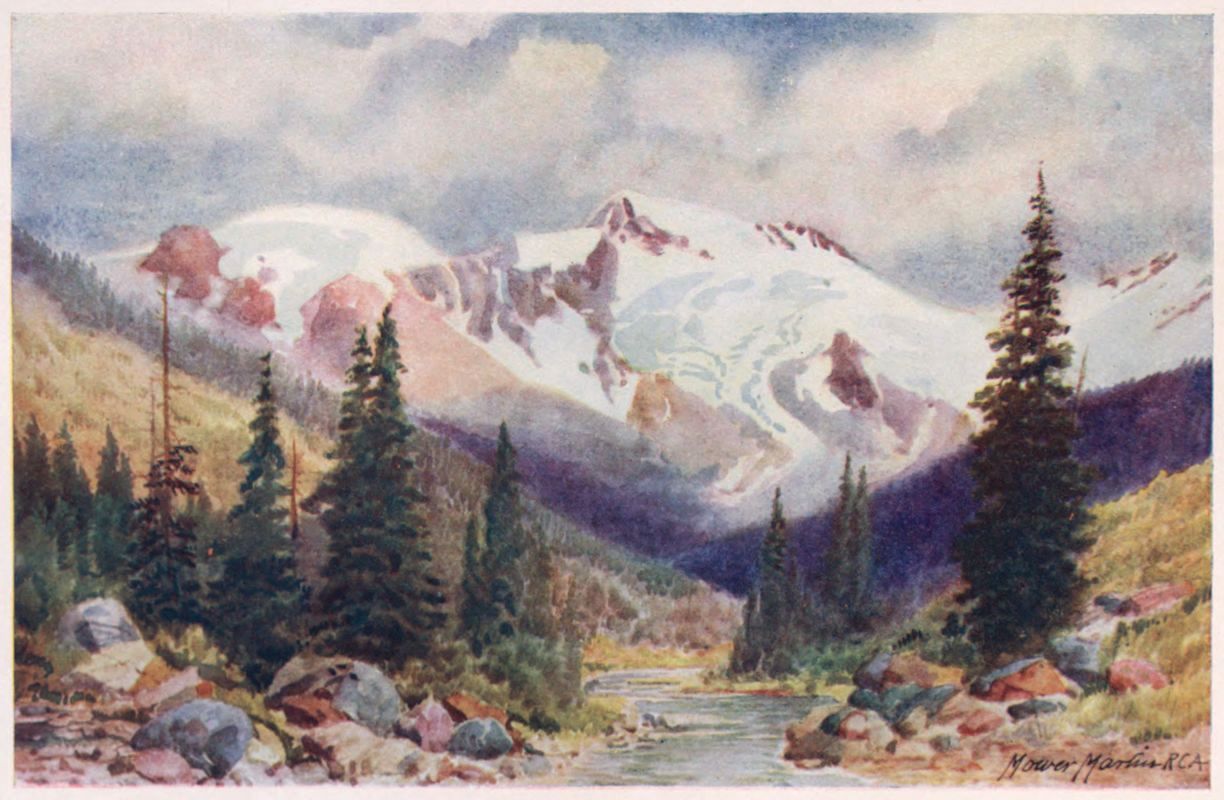
SOURCE OF THE BEAVER RIVER
It is a difficult matter to do justice to all the brave spirits who did so much to build up these new provinces. There were many pioneers in all walks of life: ranchers; administrators of the Mounted Police, like Colonel M‘Leod; and a long roll of legislators, like the present able and strenuous Minister of the Interior, the Honourable Frank Oliver, who went west among the first, and literally grew up with the country, devoting his energies and talents as legislator, editor, and as a citizen to the development of the infant territory.
The principal towns in Alberta, besides Edmonton, are the city of Calgarry, and the growing towns of Lethbridge and M‘Leod. The chief towns in Saskatchewan are Regina, in the south, and Prince Albert, in the north. These provinces will, no doubt, as time goes on, become prominent centres of Canadian life and commercial and agricultural industry.
The effort to civilize the Indians of the North-West has been of slow accomplishment. Years ago the Indians were pure savages, and many of them are little better now. When the buffalo disappeared, they had to accept the reservations and the terms made by the Government. They came into the reserves expecting to be fed and clothed like children. There was no difference. Crees, Sioux, and Blackfeet were all alike in their lack of ambition for civilisation. Few cared to farm. Most of the work on the reserve was done by the squaw, and very little grain was raised. But in the parts of the country where the old savage habits are forbidden, they are beginning to work the land, and many are becoming prosperous and respectable; and the dances and the other demoralising customs appeal no longer. The industrial schools have had much to do with this change; but the chief factor in bringing this about has been the refusal to feed them, and the prevention of their savage orgies. In the Qu’Appelle reservation the ex-pupils have become large producers of grain, have good houses, horses, and farm implements, and are a credit to those who have taught them.
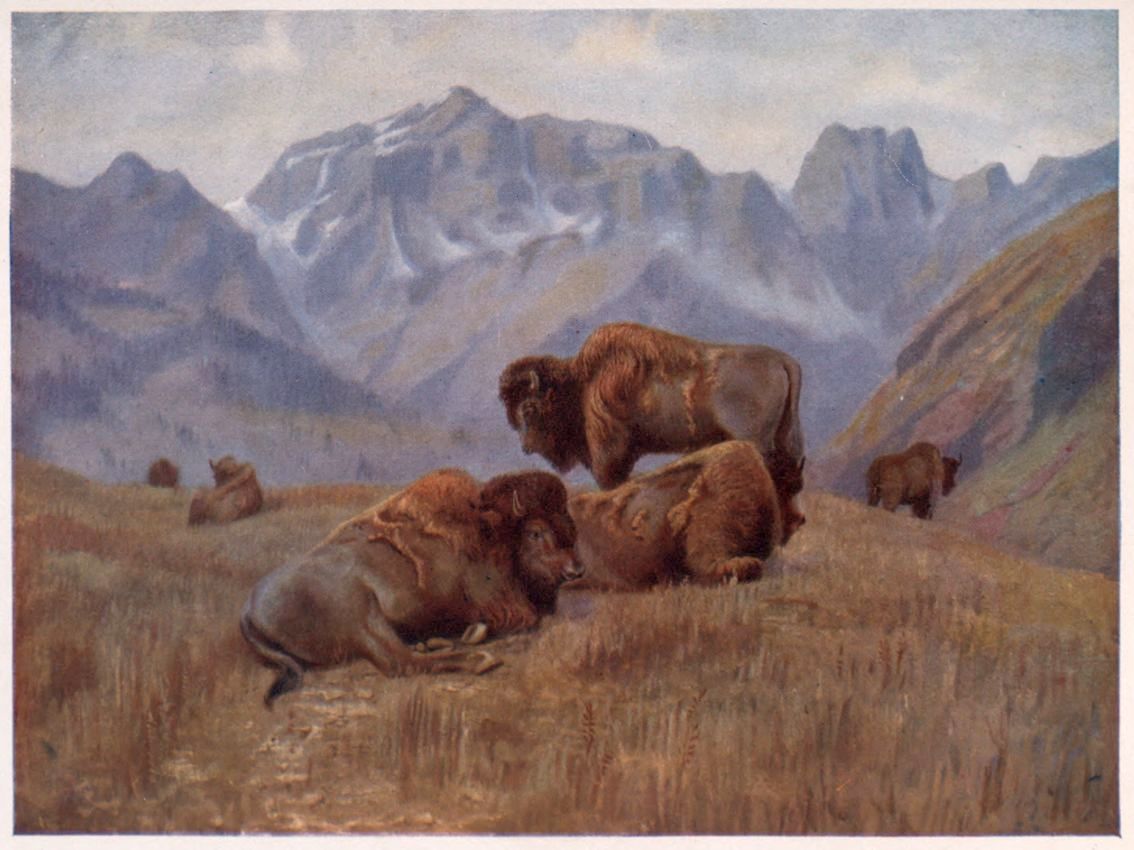
BUFFALO IN SUMMER-TIME, ON BOW RANGE, NEAR BANFF
BRITISH COLUMBIA AND THE ROCKY MOUNTAINS
British Columbia is one of the most important provinces in the Dominion. It differs in many characteristics from the other provinces, and maintains an individuality of its own. Sheltered on one side by the high wall of the Rocky Mountains, its long western coast washed by the warm waves of the Pacific Ocean, watered by the Fraser river, another of those wonderful streams of this country of great and wonderful rivers, its climate is peculiarly salubrious and its soil more lavishly generous, perhaps, than that of any other part of the Dominion where so much fertile land abounds. The history of the province begins with, and for some years is identical with, that of the Fraser river, which was first partially navigated in 1793 by Alexander Mackenzie, the first man to cross the continent. It was fifteen years later that Simon Fraser continued the exploration of the river which gets its name from that noted explorer. Following Fraser, the Hudson Bay Company came in, and for more than half a century occupied the region of the valley of the Fraser, established trading posts, and opened up trails. But the Hudson Bay Company was not allowed to hold this rich field for ever. Goldseekers came in, in spite of precautions of the Company to keep the presence of gold a secret. Gold, like murder, is hard to hide. In 1857 came the usual stampede into the country, which was with miraculous suddenness invaded by hoards of miners and prospectors. Trading posts grew in a night into cities, and the fur trade received its death-blow. The history of the life of the province at this stage is one that has been too often told of other similarly invaded gold regions, to be worth repeating; feverish excitement, wild and hazardous exploits, with life of little value, and every man for himself; the ruling passion dominating everywhere. The usual inevitable reaction set in—cities, homes, roads, bridges abandoned to be ravaged and destroyed by Indians, and overgrown by the rank, smothering foliage of this humid climate. However, a steady and more healthful growth under less feverish and more normal conditions followed the reaction; and a class of settlers came in from the home-land, people of sufficient means to live in comparative comfort without joining in the rush after gold; not an enterprising element, but one which gave a certain distinction to the tone of the population, and not without its value as a refining or restraining influence.
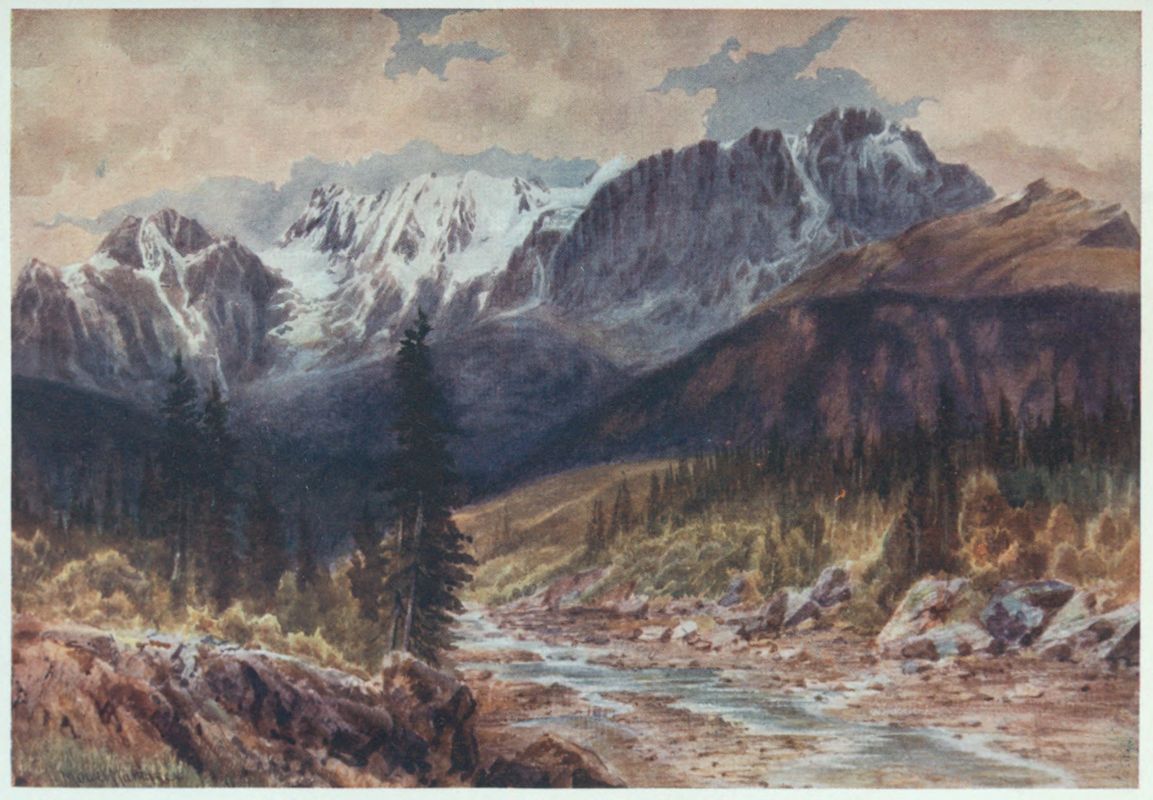
OTTERTAIL RANGE, ROCKIES, B.C.
In writing about British Columbia from a spectacular standpoint, one instinctively takes the Fraser river as a basis to work upon. The country between the Rocky Mountains and the Coast Range is mountainous and varied, an inexhaustible mine of wealth to the explorer whose primal object is the discovery and enjoyment of beautiful and wonderful scenery; but that along the valley of the Fraser river is gorgeous and awe-inspiring beyond the power of human pen to describe. The river is navigable for steamers as far as Fort Hope, and the cañon is traversed as far as Lytton, nearly two hundred miles beyond.
At the mouth of the Fraser river, about twelve miles south of Vancouver, the present capital, and the terminus of the Canadian Pacific Railway, is the old city and capital, New Westminster. This city is situated upon the north bank of the delta which is formed by the group of islands which lie in the mouth of the river. It is beautifully located at the foot of a slope topped by great cedars and spruces. Homes and gardens cover the cliffs, and there is a general air of stability about the town not characteristic of many western towns, where there is a moving population, or of a city which is the seat of government, and subject to less normal conditions. It is a city of homes rather than of residences. Lumbering and salmon-canning are the leading industries.
Vancouver Island lies opposite the mouth of the Fraser, and is separated from the mainland by the Straits of Georgia and Juan de Fuca. Its coastline is mountainous and broken by bays and inlets. The scenery is consequently well worth seeing, and the trip across to Victoria or Nanaimo is extremely pleasant and interesting, affording a fine view of the mainland and the city of Vancouver, a very beautiful city and a progressive business centre; as well as of the island itself.
The Fraser river, near its mouth, is a broad, placid stream, passing through marshy lagoons and meadow-lands, where great herds of cattle graze, while beautiful mountains may be seen on either side, near the foot of one of which, Mount Cheam, the train stops. Gradually the banks of the river rise, forming cañons and cliffs, which increase in height till the village of Fort Hope is reached. This village takes its name from one of the peaks of the group of Cascades which lie behind it, and which, at times, has marked upon it, in snow ridges, the semblance of a huge anchor. A few miles above Fort Hope is the old town of Yale, situated at the foot of the Grand Cañon of the Fraser river, a narrow gorge where the river winds its tortuous way between great broken walls of cliffs, dashing against the huge black boulders which lie in its path, covering them with white foam and spray. As the cañon expands, the scene is varied by glimpses of Chinese gold-washers on the gravel bars, or Siwash Indians fishing with dip-nets from the rocks for salmon; while here and there are scattered drying-frames festooned with red flesh of the salmon; and fantastically decorated graves give a weird touch to the scene. Here the mountains of the Coast Range, which the river passes, rise to heights varying from 6000 to 9000 feet above the level of the sea. They are extremely rugged and densely wooded, the south and western slopes especially luxuriantly covered with the characteristic growth peculiar to the humid climate.
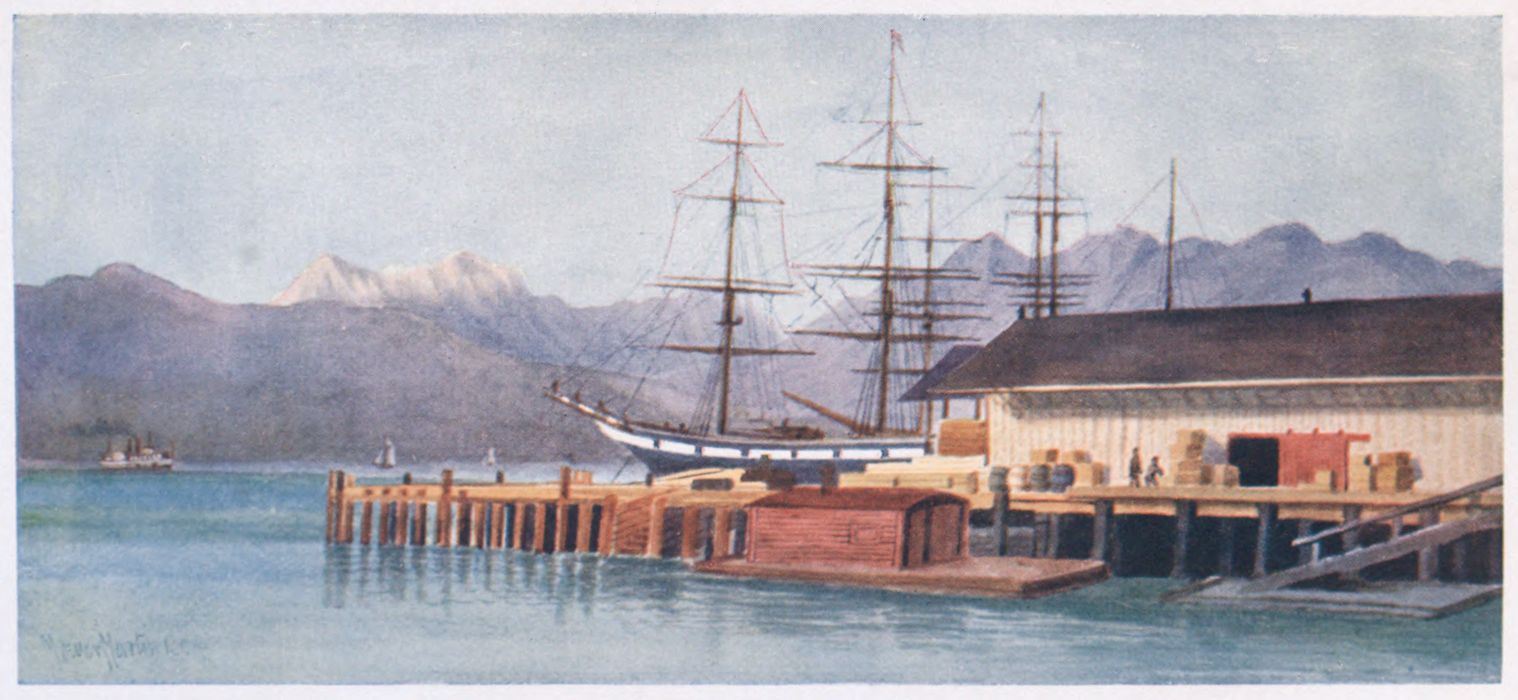
HASTINGS WHARF, VANCOUVER
The scenery along the cañon is beyond description in its savage grandeur, and the feats the railway performs in crossing chasms, tunnelling cliffs and skirting perpendicular rocks, beneath which the river, hundreds of feet below, dashes, a mad torrent, rushing, whirling, roaring, through a chaos of rocks of every form, shape, and size, are simply marvellous. Seven miles below Lytton, the railway, emerging from a tunnel, crosses the river by a huge cantilever bridge. Near this point the Thompson, another great river, along whose banks the railway now passes in its eastward track across the continent, joins the Fraser.
A perilous trail through a series of cañons up to the head-waters of the Fraser, and a terrible waggon-road, formerly wound through the mountains, along overhanging ridges at times nearly a thousand feet above the roaring torrent; but now the Cariboo or upper valley of the Fraser is reached by daily stages from Ashcroft, a town on the Thompson river, and through which the Canadian Pacific Railway passes, about twenty-five miles above the junction; and the river is again navigable above Lilloet.
Scenes like those seen on the Fraser are repeated in the valleys of the other great rivers, the Columbia, Kootenay, and Thompson, which, with chains of lakes, form a network through the country. These other rivers also are navigable at certain points, or confined in narrow cañons as they pass through the mountains. A description of each of these rivers would fill a volume. The central southern valley of British Columbia, lying as it does between the Rocky Mountains and the Coast Range, is much drier than that of the rest of the province, and there are fewer forests.

BURIAL-GROUND OF SIWASH INDIANS
The lake district is an enchanting paradise, a bewildering labyrinth of blue-green waters, between which are snow-capped mountains, farms, orchards, ranches, and towns. The scenery is a never-ending dream of beauty. Kootenay, Arrow, Okanagan, with dozens of smaller lakes hiding between, each has its characteristic features, peaceful, or rugged and grand. In the Okanagan district lie beautiful farms, luxuriant peach and apple orchards, some of the most productive in the Dominion.
Another remarkable river, the Columbia, is navigable at its source, many hundreds of miles from its mouth. The total length in miles of the three rivers, the Fraser, the Columbia, with its tributary, the Kootenay, must be something immense, winding in and out as they do between the mountain ranges. Rising in a small lake at the base of the Rocky Mountains, the Columbia flows northward for about two hundred miles, then takes a sharp curve around the north end of Selkirk Range, and then continues its tortuous path in a southerly direction. From its source it is navigable for about a hundred miles, as far as the town of Golden, where it is crossed by the Canadian Pacific Railway. Above that point is one of the most terrific cañons in this country of wild cañons, and there are frightful tales told of the perils and hardships of the brave men who have, from time to time, followed its windings in their explorations. The river continues its mad course, past towering cliffs, through black chasms, where its way is impeded by fallen boulders worn into weird shapes by the rushing waters, for over two hundred miles, when the valley widens, and the river broadens into a noble stream through swampy bottoms of beaver bush. Above this point are the rapids, Dalles des Mort, or Death Rapids, two miles long, and a great maelstrom almost equal to the Niagara whirlpool. The river receives many tributaries, some of which, leaping from the mountains, form beautiful cascades, which add to the beauty and variety of the scenery, which is at all times entrancingly beautiful and grand.
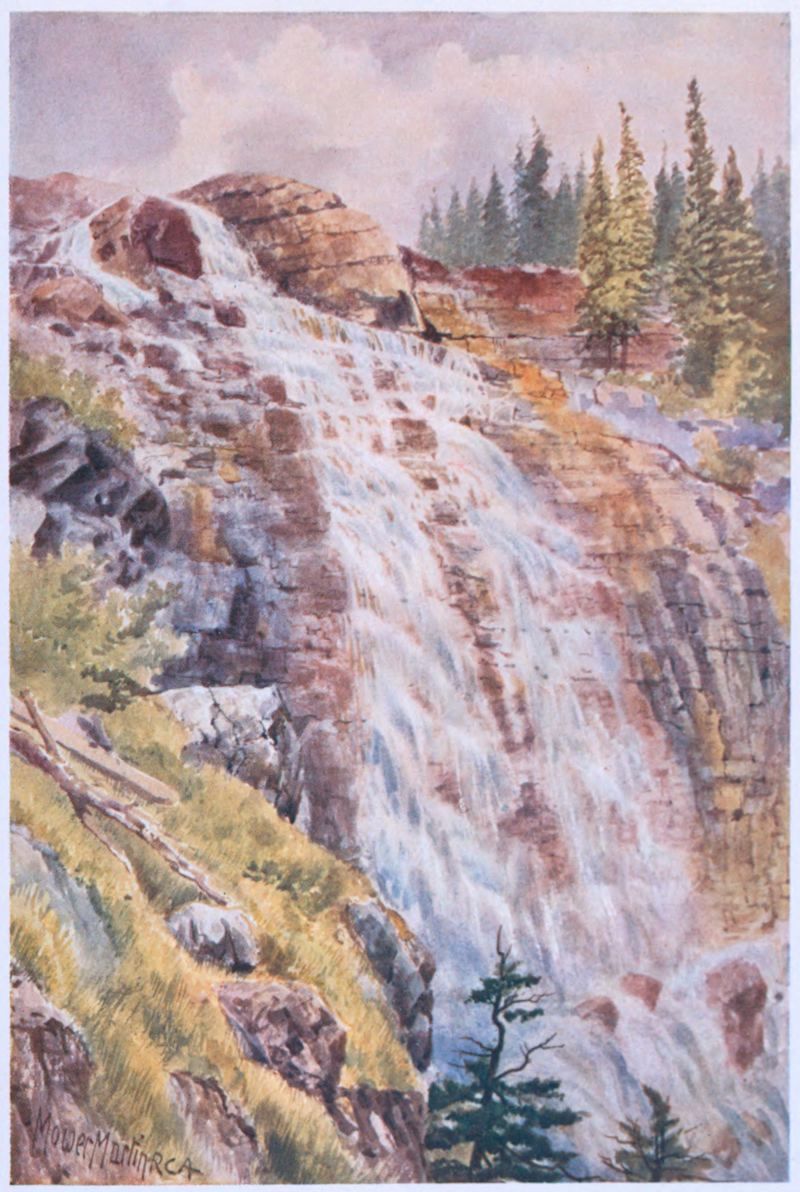
OUTLET OF LAKE AGNES
The Kootenay river, with its lake expansions, its wonderful rapids twenty-four miles long, where the water leaps in glistening cascades from shelf to shelf, or roars a mad torrent of green foam-flecked waters, is another of the streams which cut their way through the mountain ranges and render it possible for man to overcome the obstacles which nature has placed in his way and to make this wonderful country his own. The pen fails, words are inadequate, to do justice to the wonders which meet one on every side. One might continue for pages to depict scenes of splendour and beauty, and yet yield in despair to the hopelessness of the task of doing justice to the scenery which unfolds itself, until eye and brain refuse to marvel; and all this without more than a passing reference to the mountains. The Coast Range has been referred to. If an attempt be made to describe the Selkirks, where shall a vocabulary be found, equal to the stupendous undertaking of picturing the Rockies in their awe-inspiring grandeur?
The Selkirk Range, lying to the west of the Rockies, in the south-eastern part of British Columbia, is completely encircled by the Columbia and Kootenay rivers. The Columbia, having its source to the west of the mountains, flows north for a couple of hundred miles, then turns sharply around the north end of the range, continues its course to the due south end of the range, where it is met by the Kootenay, which skirts the mountains on the east side. This range differs in many characteristics from the Rocky Mountain range. Its lofty peaks receive, and break, most of the heavy rain-clouds which blow in from the Pacific. There is therefore more rain and more snow, and consequently the soil receives more moisture, and the growth of forest and farm is more dense. The lower slopes, beneath the snow-line, except where the bare rock refuses to sustain life, are clothed with impenetrable forests of spruce, cedar, and hemlock, of which the underbush is the most difficult barrier to exploration.
These characteristics give more richness and contrast in the colour. On a clear day the snow-capped summits and crested peaks, tinged perhaps with the crimson glow of the setting sun, glisten and sparkle with dazzling brilliancy. Great, luminous spears of transparent blue ice cut down into the dark rich green of the forest, which is blended into the warmer tints of shrubbery and foliage in the foreground. Great castellated crags of white and green rock break through the velvet mantle of forest. Blueberry bushes and alders, with white-flowered rhododendrons, adorn with delicate tracery the trailing skirts of the forest; and rich-tinted, red, purple, and yellow wild-flowers nestle in the fringe. All this, rising against the clear blue of the sky, while soft veils of mist rise from the valleys, floating across the face of the mountains, or break and hang in fleecy tassels upon the edges of cliffs and crags, makes a study in colour and grandeur beyond the power of human artist to depict, or poet to describe.
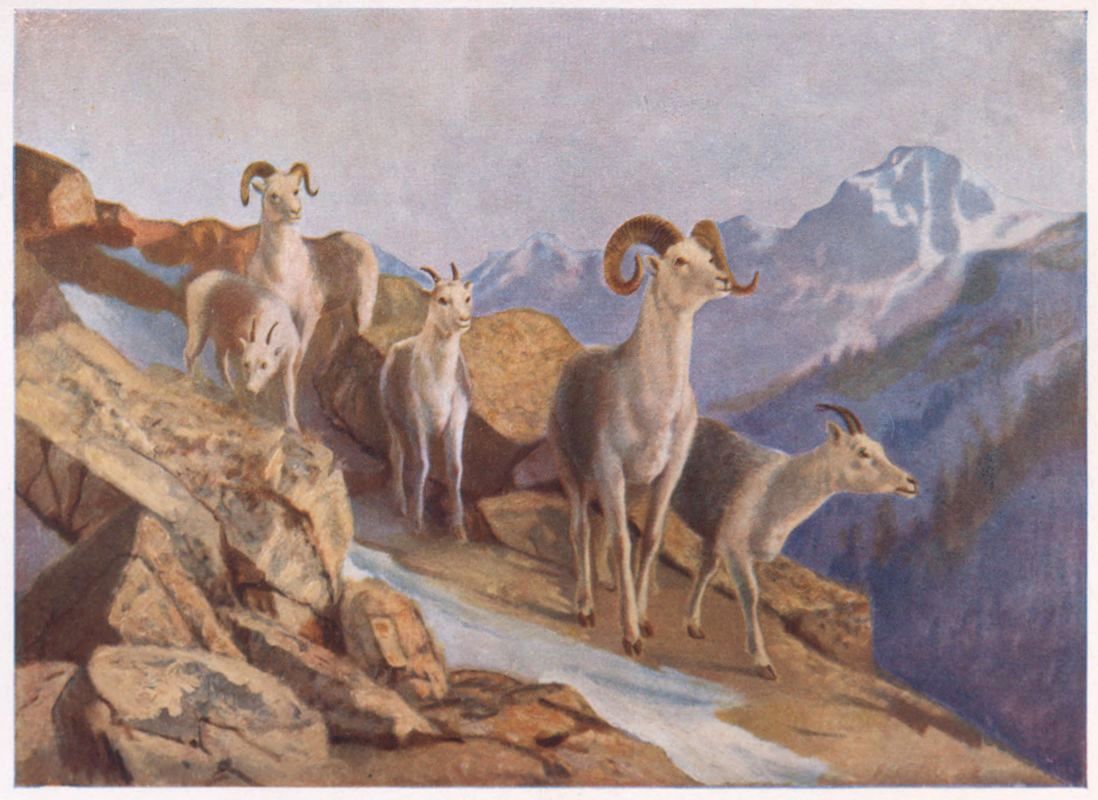
FANNING SHEEP COMING DOWN TO FEED
The best views obtainable of both the Rocky Mountains and the Selkirks, to the ordinary traveller, are those seen from points along the Canadian Pacific Railway as it crosses the ranges, winding in and out in its necessarily tortuous course, through mountain-passes and over steep slopes, upon which a direct ascent or descent would be an impossible feat.
Approaching the Rocky Mountains from the east, after crossing the gently undulating prairie, one gets the best view of the range. First, while the eyes are fresh from the soothing monotony of the plain, and the brain not yet dazed with wonder and awe, until incapable of receiving further impressions, beyond the sea of grass, rising against the horizon, a great pinnacled purple wall of irregular outline gradually shapes itself into a vast opal-tinted panorama of snow-topped peaks and forest-clad slopes, blue in the distance, melting into soft green and gold of the prairie. Gradually the prairie rises in undulating slopes to meet the foot-hills, which are now outlined against the more distant mountains, now rising in all their awe-inspiring grandeur of mighty peaks, sombre, forest-clad slopes, vast ravines, broad valleys, clothed with green; grim, towering cliffs of rock, with huge clefts, from which mountain streams rush in mad torrents. Passing the foot-hills into the heart of this region, the climax of nature’s sublimest achievements, the railway carries the awed spectator.
Up the valleys of the mountain streams, which come down to the river along whose bank the railway passes, glimpses are obtained of grassy knolls and wooded hollows, beyond which tower snow-white peaks. To the north-west, overlooking Devil Head, which is visible from far out on the plains, as the hills open and the gorge widens, a broad vista stretches into the very heart of the mountains, lofty, stern, majestic—towering to the sky, draped in a flimsy veil of mist, rising from the valleys between, and floating, transparent, rose-tinted over the face of black rock, stern forest-capped cliffs and glaciers; softening hard outlines, and throwing a glamour over all, which greatly enhances the eternal beauty and grandeur of the scene.

GLACIER CREST, ILLECILLEWAET
Passing The Gap, a station just within the mountains, and following the broad valley of the Bow river, more mountains appear, and we are surrounded by snow-peaks. The mountains are capped with white, and huge white mantles fall over the gorges between the peaks; ledges are marked with snow, and furrows are filled with it, making fantastic markings upon the faces of the mountains; and all the while it is summer below, and the valleys and the lower slopes are teeming with verdure. Wind Mountain, Mount M‘Dougal, and The Three Sisters are all visible, and each displaying some characteristic beauty or distinctive feature of grandeur. Appalling precipices, laden with snow, tower above; and gorgeous, ever-changing colouring marks the alternate layers of rock and snow, the patches of forest, outlines of ledges, and glistening cascades, which leap over rocks and down ravines, gaining force as they come.
A patch of forest upon the side of one of the Three Sisters is called, from its remarkable resemblance to a bovine face, “The Bulls Head.” All the features are there, a gigantic face, startlingly realistic.
As Canmore is passed, across the valley ahead rises, gigantic, a perpendicular wall of rock, its face marked with vari-colored streaks. A slender cascade, which falls from the top of the mountain over the face, gives it its name, “Banff the Beautiful.”
At Banff, a favourite stopping-place in the mountains, where the Canadian Pacific Railway has a fine hotel, there are hot springs. From the balcony of the hotel an extensive view of the surrounding mountains may be had. The rooms are luxuriously furnished, with every modern convenience at a very moderate price. There is also a sanitarium in the vicinity. Here are the great national parks. From Tunnel Mountain also a marvellous view is to be had. The beautiful valley below, with the ruddy-tinted Vermillion Lakes, and the rich, transparent green waters of the river, walled in by a circle of towering peaks, is an entrancing and memorable scene. Rocky Mountain Park extends from the foot-hills to the Divide; and from this, Yoho Park extends to the Pacific, the two covering nearly 4500 square miles. These parks are set apart by the Government to preserve the beauties and resources of this marvellous district. There is another smaller park in the Selkirks.
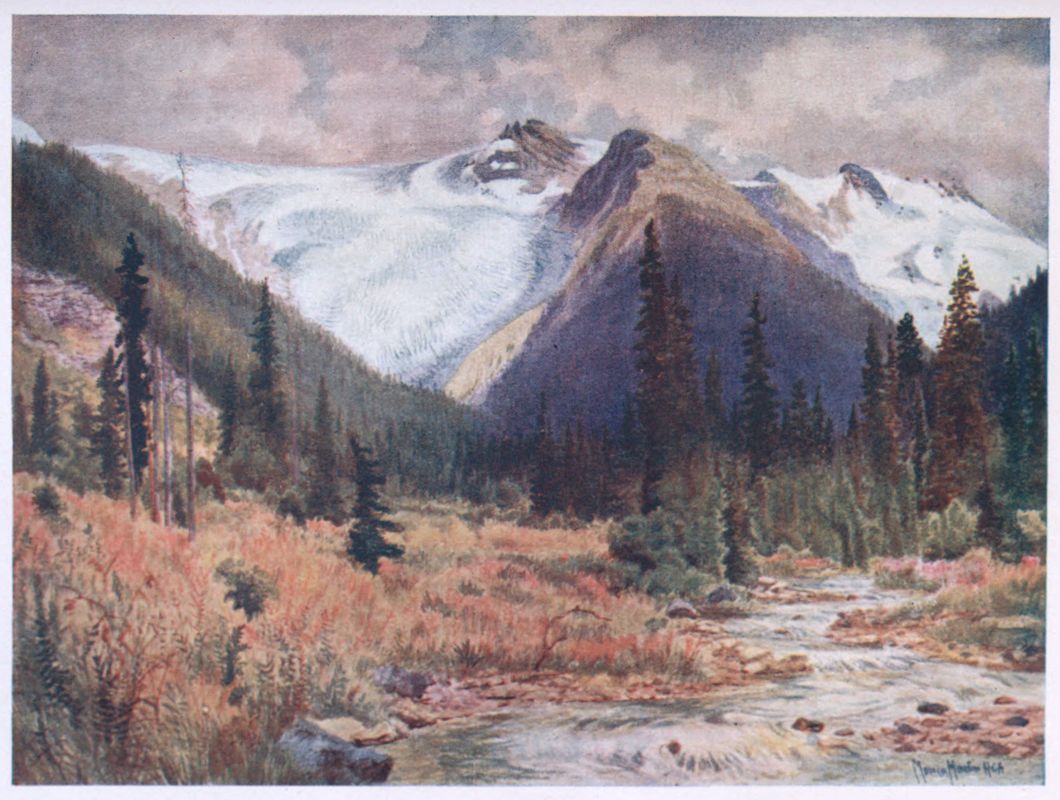
GREAT ILLECILLEWAET GLACIER
From Banff as a centre, a series of delightful expeditions may be made to points of interest. The ascent of Cascade Mountain and return may be made in a day, and from its summit may be obtained a more extended view of the Rockies, and a first glimpse of Mount Assiniboine, the Matterhorn of America. This giant pyramid towers 1500 feet higher than the neighbouring peaks, and 11,860 feet above the sea-level. It covers an area of thirty square miles. This is one of the most remarkable mountains in the range, the startling grandeur of its lofty precipices and its magnificent slopes giving it a distinctive character of individuality among the surrounding mountains. Further on looms in the distance Castle Mountain, like a gigantic turreted fortress, and Mount Temple, shaped like a huge helmet; and beyond these lies the beautiful valley of the Ten Peaks. Space forbids the enumeration of half the beauties and splendours of this region.
Lake Louise itself is one of the loveliest pictures, like a vision from a dream of enchantment, nestling like a jewel dropped from heaven; its blue waters glistening in a setting of flower-strewn, grassy shores, sloping into the forest of tapering spruce and pines, above which loom huge, gaunt precipices and frowning cliffs, with the black walls of Mount Leroy rising beyond the valley, its ice-crowned peaks melting into the blue of the sky. Mount Victoria also stands out among the peaks seen from Lake Louise, and other lovely lakes are to be found higher up, as they are everywhere, hidden among the mountains. A few miles further on, the Rocky Mountain range culminates in The Cathedral and Mount Stephen. The former, like a gigantic ruined cathedral, mounted above great brown slopes, upon a vast pile of fallen debris, comes first in view. Mount Stephen looms up behind, a noble pile, supported upon a huge pedestal by gigantic piers rising between two and three thousand feet above the valley. This mountain is named in honour of Sir George Stephen, Bart., first president of the Canadian Pacific Railway, who afterwards took his title from the mountain, as Lord Mount Stephen.
The height of Mount Stephen, the summit of the Rocky Mountains, is 10,523 feet above the sea. It is not the highest, but the most conspicuous and imposing of the range, a detailed description of which would fill volumes, without doing justice to their grandeur and transcendent beauty.
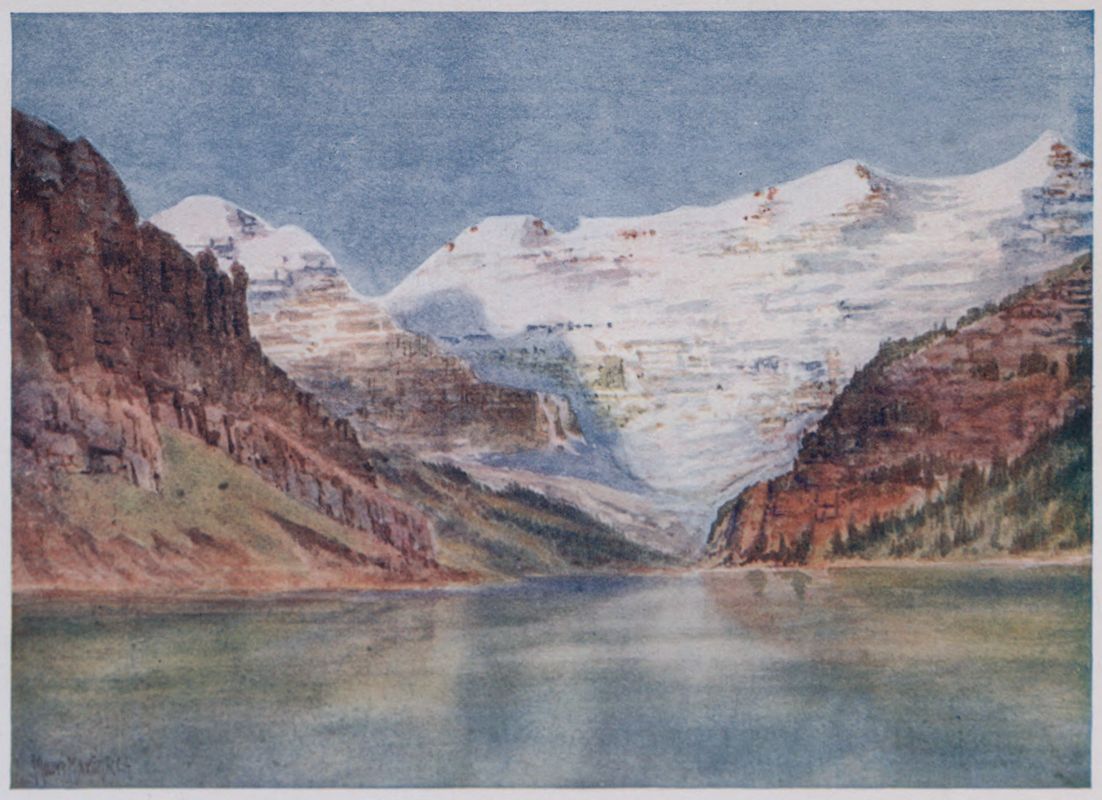
LAKE LOUISE, LAGGAN
The soil of British Columbia is unusually productive. Many beautiful farms, orchards, and ranches may be seen in the broad valleys of the south, and there is room for more. The chief mineral wealth is in the north, where the climate is less salubrious.
The forests consist chiefly of white cedar, Douglas pine, spruce, and hemlock. The Douglas spruces reach an average height of 200 feet, and the cedars rise to nearly the same height, while individual trees reach 250 feet and over.
This province has a great future ahead of it, if its people only know how to take advantage of one of the finest aggregations of natural resources on the face of the globe. It is not merely a wilderness of beauty, but much more. It has more areas of untouched nature than any other country. It has a climate which will suit anyone who has lived in Britain. Mr Byron E. Walker, a prominent Canadian banker, in an address a short time ago before the Vancouver Canadian Club, said:—
“Washing the feet of the mountains was the greatest ocean in the world, teeming with food which was essential to the maintenance of man, and which was to be found nowhere else in the world. The value of the ocean was increased by the great number of harbours, which would eventually give British Columbia the command of the commercial navy of the world.” “Some persons,” he said, “had called British Columbia a world of mountains, but he would rather call it a world of valleys.”
Many different accounts are given of the effect of its remarkable climate. Some call the sea-coast of the province and the island of Vancouver the land of the lotus-eaters. They say that the air is enervating, and the inhabitants gradually grow indolent, and cease to worry and struggle. But this description is not in keeping with the development of this young giant region of the remote west. It is more likely that the great danger to life here lies rather in too much stress and development of the activities. Men in these new countries are far too strenuous; and, in their haste to outrun the rest of the world, they are likely to go behind in those most important necessities to society on the side of ideals, both spiritual and social.
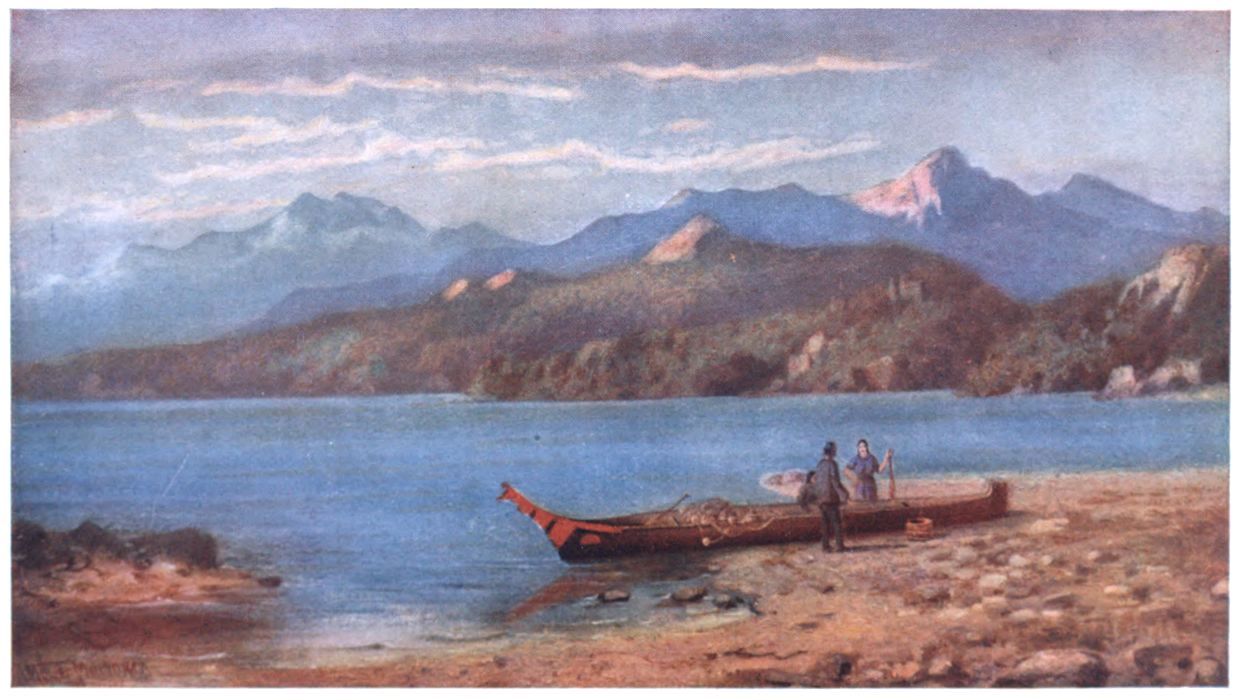
COAST NEAR SECHELT, BRITISH COLUMBIA
The inhabitants of British Columbia are for the most part of British origin. There are many people from Eastern Canada. Some of the prominent men in politics, business and professional life, are graduates of Ontario colleges. There is also a very large percentage of people from the British Isles. So that the province is British Columbia in more than mere name. The chief interests of the province at present are mining and fishing; but its real resources lie in its agricultural possibilities. Herein lies the means by which it may yet be one of the paradises of the western world. Mining is a great factor in making a country important in a material sense; but as an industry it does not improve the people. On the other hand, the real strength of a nation lies in its agricultural population; and the country which lays most stress on this side of its development will, in the future, rule the world.
Herein lay Britain’s great power. It is true that her commerce made her wealthy, but it was her great agricultural resources which sustained her; and more, it was her rural population which gave her her army and navy, her bulwarks ashore and on the deep. It was her country places, her straths of Scotland, her meadows and hillsides of England, and her opens of Ireland and Wales, which gave her those men of all walks of life, her preachers, her poets, her statesmen, her financiers, her soldiers and sailors, who have made her famous at home and abroad.
It is said on good authority that British Columbia is one of the finest fruit countries in the world, that peaches and grapes grown there are unsurpassed. Let it, then, be hoped that this beautiful province will yet become a very paradise of rural life, and breed a people of the brawny, well-made, out-of-door variety, strong in character and physique, by reason of a true closeness to nature, such as made the old-time yeoman of famed Britain. But this province has her troubles, even at this early stage of her history. She, being a mining community, has an immense labour population, and the labour problem is the great social difficulty of the hour; and, just now, British Columbia is in the clutches of the United States labour boss. This is a strange condition in a young and seemingly free country, which prides itself on the liberty of its citizens. And yet it is a fact that thousands of dollars worth of fruit has gone to waste this present season, because of lack of labour to properly handle it. The other great trouble is the Oriental immigration, which is mixed up with the former matter, as it is the labour party which prevents the entry of the Chinese and Japanese cheap labour, which would make the tillage of the land a possibility. This is a case where one class of the people is acting as a drag on the wheels of progress, and is doing this, remarkable to say, under the whip of a foreigner in the United States. Not only will this mad policy result in stagnation of the development of the province, but the people who are treating so brutally an alien but harmless and industrious race, are laying up for themselves a terrible retribution in the not remote future. The Oriental will never forget the deadly insult which has been offered to his kin by the American and Canadian people. He has been treated as no decent human being should be treated in any country calling itself human and Christian. He is much more intelligent and industrious than many of the European peoples which have demoralised these American shores; and yet he has been placed under a tyrannous ban, whilst the scum of Europe has not only been admitted, but warmly welcomed, even subsidised.
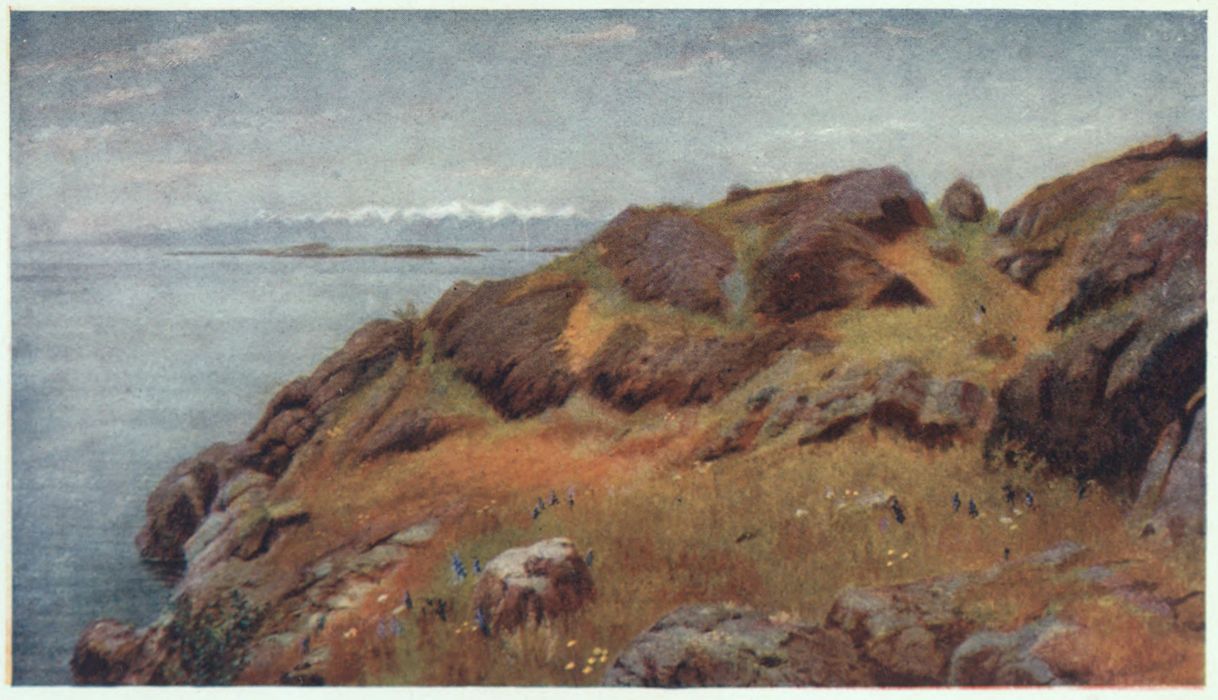
COAST OF VANCOUVER ISLAND
The result will be that the Orientals of the Pacific, who are a highly civilized people, the oldest in the world, and who are now awakening from their lethargy, and rapidly adopting modern methods of warfare, will some day arrive in such numbers, and under such conditions, as will annihilate our people, and teach them, when too late, that true freedom should be given to all men alike.
No one has more sympathy than the present writer for the labouring class; but the truth is the truth, and must be spoken; and the poor man has no more right to act against the good of the whole community than has the rich. When he does so, though unconsciously, he is injuring the poor man more than all others, as he is in the majority, and must feel more than others what injures the whole country.
The fruit-raising possibilities of this province cannot be overestimated. The sides of the mountains in the valleys, where the timber has been removed, make ideal farms for fruit; and it would be a paying investment, for those who have capital, to embark in this laudable scheme of rural improvement. During the first years, while the orchards are maturing, small fruits could be cultivated, such as strawberries; and a good and ever-growing market is at hand in the inland provinces of Alberta and Assiniboia, where fruit does not grow. Why should not companies be formed, as they are for more risky ends, such as mining ventures? Here the money invested would not only be safe, but every share would go to the improvement of the people and the country. This is not the only industry. There is dairying, and the manufacture of jams and preserves. His Excellency Earl Grey, the Governor-General, recently said: “British Columbia is an ideal dairy and fruit country, and it seems to me that it will be your own fault if you are not able, when you have cleared sufficient ground, to export to Japan all the jam, butter, and cheese which she may require. Until this year, Japan levied a higher duty on Canadian than United States imports. This year, owing to the advantage which Canada enjoys in being a portion of the British Empire, Canadian imports have been given by Japan the advantage of the most favoured treatment.”
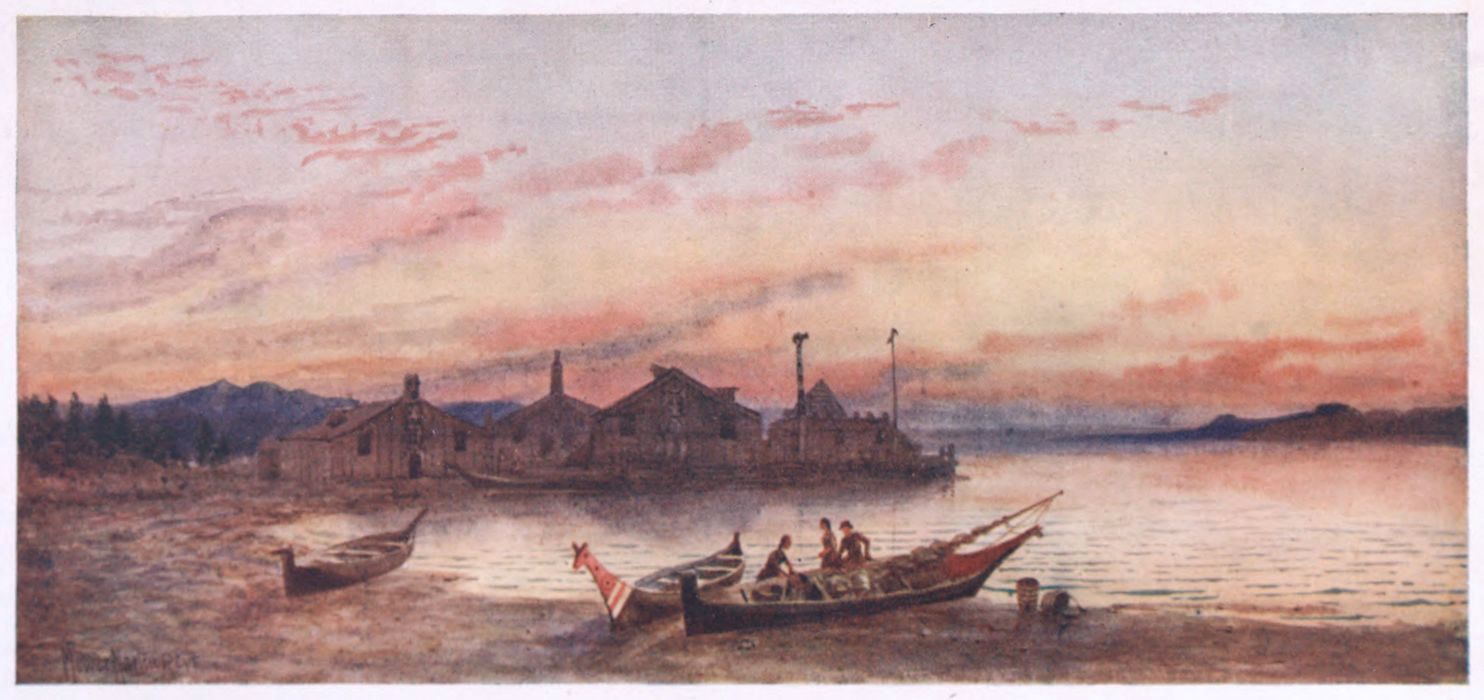
SIWASH VILLAGE, PACIFIC COAST
Finally, in closing this chapter, and with it, this volume, it might be well to quote the words of two of our distinguished Governors with regard to the fortunes of this great Dominion.
Twenty-three years ago the present Duke of Argyll, then Lord Lorne, when leaving the Dominion, said, in a speech at Ottawa:—
“You ask why I am so enthusiastic a Canadian? I ascribe it to the simple fact that I have seen more of your country than have very many amongst you. I know what your great possessions are, and to what a magnificent heritage you have fallen heirs. I know that wide forest-world out of which the older provinces have been carved. I know that great central region of glorious prairie-land from which shall be carved out future provinces, as splendid, or more splendid, than those of which we now proudly boast. I know also that vast country beyond the Rocky Mountains, that wondrous region, sometimes clothed in gloomy forest, sometimes smiling beneath the sun in pastoral beauty of valley and upland, or sometimes shadowed by Alpine gorges and mighty mountain peaks—the territory of British Columbia. And in each and all of these three immense sections of your great country, I know that you have possessions which must make you in time one of the foremost among the nations, not only of this continent, but of the world. . . . It is because I have seen so much of you and of your territories that I am enthusiastic on your behalf, and that the wish of my life shall be the desire to further your interests; and I pray the God who has granted to you this great country, that He may, in His own good time, make you a great people.”
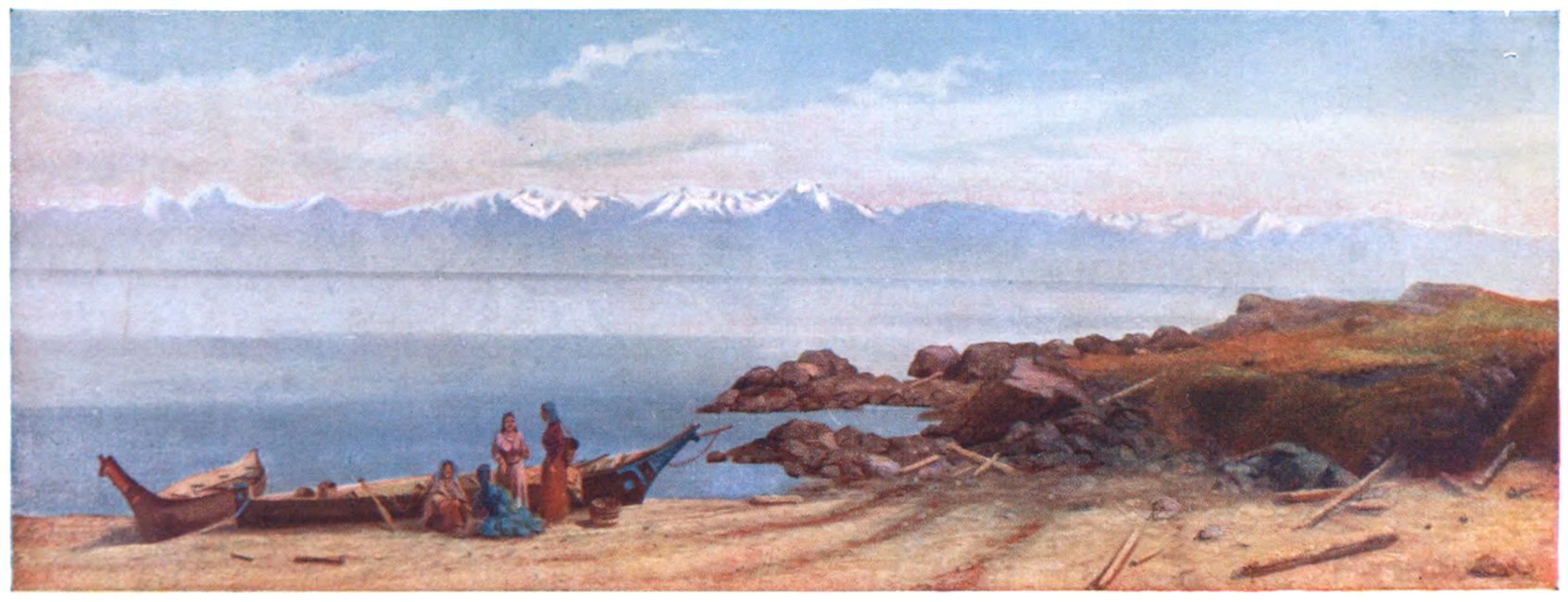
OLYMPIC MOUNTAINS, FROM COAST NEAR VICTORIA
The other quotation is from the speech of Lord Grey, our present Governor, at Vancouver. Speaking to the Canadian Club as to the work and ideals of the Club, he said:—
“It will provide you with a security against those evils which fasten upon every self-governing city whenever democracy goes to sleep and allows self-interest to creep into places of public trust. Eternal vigilance is the price of liberty, and unless those who have at heart the well-being of the people are continually on the watch to guard against the entrance of corruption into the sacred temples of the State, the people will be pillaged and oppressed just as ruthlessly under democratic forms as under the most cruel and selfish despotism of ancient times.
“Some people are afraid that a community, which has received so much as you have at so slight a cost, will be wanting in that character which, as a rule, only results from the hard discipline of toil and suffering, and from the grace of tears. Your Canadian Club, by holding the highest ideals to the community, can do much to remedy that want of discipline. There is a blessed law of nature which has decreed that little is unattainable to the individual who earnestly devotes himself to the unselfish attainment of the public good. . . . If your Club, under the guidance of the most patriotic among you, resolves that its influence shall be on the side of all that is calculated to make a strenuous, cultured, and righteous people, there will be no limit to the degree of your influence.”
The necessarily condensed chapters of this volume have given a slight idea of the splendour of the natural conditions of Canada, and the characteristics and possibilities of its people. So long as Britain sends out men of this high ideal to represent our monarch, and so long as we continue to produce men of the calibre of our best statesmen and thinkers, there is no danger that Canada will not develop in the direction of those ideals and achievements which are the guiding star and the final accomplishment of a great people.
THE END
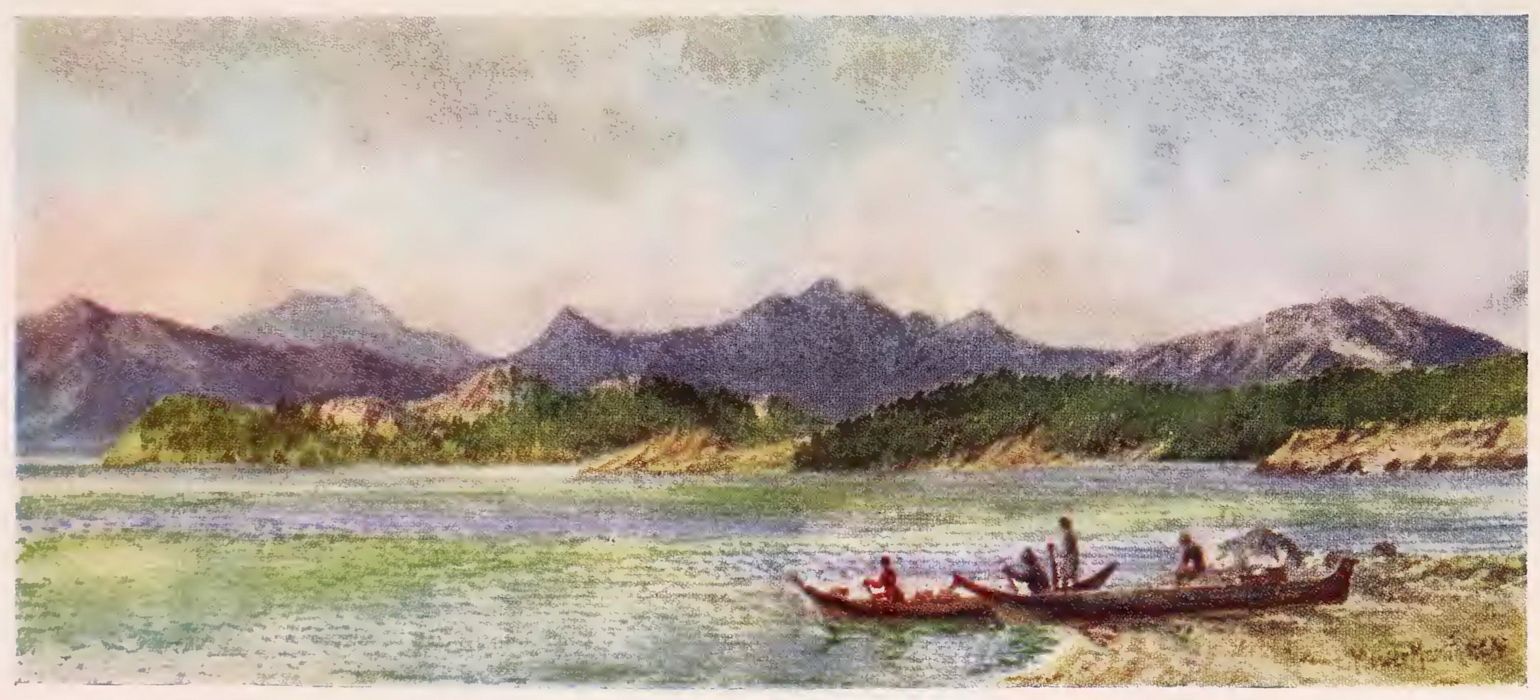
PACIFIC COAST NEAR NELSON’S ISLAND
Note.—The principal reference is indicated in black type. The Illustrations are indexed in italics.
Aberdeen, Earl of, 113
Alberta, 230;
Climate of, 226
Algonquins, The, 178
Allan Steamship Line, 78
Alston, Washington, 166
Amherst, 43
Amherst, Lord, 79
Amherstburg, 189
Annapolis Valley, 23
Anticosti, 57
Antigonish, 42
Arrow Lake, 243
Arrow Lake, Columbia River, 222
Art, Canadian, 115-117
Aspotagoes, 39
Autumn in Canada, 123;
Poem on, 124;
in the Lake Region, 196
Autumn in New Brunswick, 124
Autumn on Lake of Bays, Muskoka, 186
Aylmer, Lord, 171
Back Country Farmyard, Winter, 232
Baldwin, Robert, 155
Banff, 250
Basin of Minas, Nova Scotia, 36
Bay of Fundy, 17
Bay of Fundy, Autumn, Road near, 16
Bay of Quinte, 188
Beaver River, Source of, 234
Belleville, 147
Big Spruce in Stanley Park, 128
Blackfeet, The, 236
Blair, Hon. Andrew, 29
Blake, Hon. Edward, 5, 113
Borden, Hon. R. L., 27, 29
Bowell, Sir Mackenzie, 147
Brant, Joseph, 162
Brant’s Tomb, 162
Brantford, 162
Brebeuf, Jean de, 55, 179, 181
British Columbia, 237;
Climate of, 254;
Forests of, 253;
Fruit-growing in, 258;
Trees of, 253
Brock, Isaac, 165
Brosse, Père, 59
Brown, 113
Brownell, 116
Buffalo Feeding in Winter, 224
Buffalo in Summer-time, on Bow Range, near Banff, 236
Burial-ground of Siwash Indians, 242
By, Colonel, 111
Cabot’s Head, 186
Cacouna Bay, 60
Calgarry, 235
Campbell, Thos., Boat-song by, 85
Campbell, Sir Wm., 154
Campbelton, 17
Canada the Scotland of America, 2
Canadian Art and Artists, 116;
History, 50;
Forests, 125-135;
Trees, 125-135;
Loyalty, 157
Canadian Municipal Union, 11
Canadian Pacific Railway 78, 216
Canadian Sculptors, 116
Canadian Vintage, 165
Canmore, 250
Canoe Lake, Parry Sound, Sunset on, 190
Cape Blomidon, 40
Cape Breton, 17
Cape Eternity, Sonnet to, 58
Cape Porcupine, Gut of Canso, Cape Breton, 28
Carheil, Father Etienne, 179
Cariboo Island, Thunder Bay, 204
Cartwright, Sir Richard, 144, 145
Cascade Mountain, 251
Castle Mountain, 251
Cathedral Mountain, 252
Cattle Ranches. See Ranching.
Champlain, 55, 61, 62, 70, 179
Chapleau, 55
Charlottetown, 43
Château de Ramezay, 81
Chaudière Falls, 108
Chinese Labour, 257
Chippewas, The, 221
Citadel, Quebec, The, 62
Alberta, 230;
British Columbia, 254;
Rocky Mountains, 243;
Selkirk Range, 246
Coast of Vancouver Island, 256
Coast near Sechelt, 254
Colborne, Sir John, 155, 171
Colonisation of the M‘Nab Township, 161
Columbia River, 243
Columbia River, Arrow Lake, 222
Compain, Père, 59
Confederation of Canada, 53
Cooper, Fenimore, 163
Copper Mines, Lake Superior, 203
Cornwallis, Hon. Edward, 40
Coureur de Bois, 178;
Legends of, 88
Cowboy, The Life of the, 226
Daulac. See Dollard.
De la Roque. See Roque.
Derby, Earl of, 113
Dominion Experimental Farm, 110
Drummond, Dr W. H., 85
Dufferin, Lord, 112
Dundas, 162
Early Discoverers of Canada, 14
Early Spring, near Victoria, 120
Edmonton, 231
End of Lake Louise, and Mount Aberdeen, 12
Eric the Red, 17
Evening Mists, Muskoka, 178
Fall of the Year, Nova Scotia, 20
Falls on the Illecillewaet River, Selkirk Mountains, 130
Family Compact, The, 151
Fanning Sheep coming down to Feed, 246
Farm, Dominion Experimental, 110
Farmyard in Ontario, 94
Fenimore Cooper, 163
Fielding, Hon. W. S., 29
Fisheries, Ruin of, 10
Fletcher, Prof., 111
Forbes, 116
Forests, 128-135;
of British Columbia, 253;
Denudation of, 9
Forster, 116
Fort Frontenac, 143
Fort Garry, 207
Fort M‘Leod, 207
Fort Rouille, 148
Fort Simpson, 207
Fort William, 204
Foster, Hon. George, 29
Fraser River, Pitt Meadows on, 230
French Canada, 55
French Canadians, 189;
Character, 85;
Colonists, 83;
Farmers, 83;
History, 52;
Statesmen, 55
From the Foot of Eagle Peak, Selkirk Mountains, 214
Fruit-growing Industry, 256-259
Fundy, Bay of, 17
Galt, 164
Gap Station, The, 249
Gas-wells, 169
Gatineau River, 107
Georgian Bay, 187;
Yachting in, 193
Gilbert, Sir Humphrey, 21
Glacier Crest, Illecillewaet, 248
Glimpse of Niagara from under Luna Island, 168
Gold Fever, 238
Golden Ear Mountains, Pitt River and, 212
Golf, 87
Government House, Ottawa, 112
Governors-General of Canada, 112
Grand Manan, 45
Grand Pré, 25
Grand Trunk Railway, 147, 223, 229
Great Illecillewaet Glacier, 250
Grey, Earl, on British Columbia, 259, 261
Gulf of St Lawrence. See St Lawrence.
“Habitant, The”, 85
Habitants of Rural Districts, 54
Halifax Harbour, York Redoubt and, 40
Harper, 117
Harris, 116
Hastings Wharf, Vancouver, 240
Head, Sir Francis Bond, 152
Hebert, 116
Hennipen, Father, 166
Henry VII., 19
Hermit Range, Mount Cheops and, 4
Hiawatha, 51
Highland Crofters from Sutherlandshire, 210
“Hind, The”, 22
Holidaying in the Lake Region, 194
Home Rule, Drawbacks of, 45
Howe, Joseph, 27, 30, 31, 37, 38, 113
Howe Sound, Pacific Coast, North of, 2
Hudson Bay Company, 207-212, 238
Huguenots, The, 62
in Autumn, 191;
Depth of, 201
Hurons, The, 180
Illecillewaet below Sir Donald, Frontispiece
Illecillewaet, Glacier Crest, 248
Illecillewaet Glacier, Great, 250
Illecillewaet River, Falls on the, 130
Immigration, Oriental, 256
Indian Chief, An, 74
Indian Reserves, 163
Origin of Name, 83
Algonquins, 178
Blackfeet, 236
Crees, 236
Hurons, 180
Iroquois, 182
Sioux, 236
Siwash, 241
Indians in the Olden Time, 164
Inglis, Bishop, 30
In Sherbrooke, Eastern Townships, Quebec, 86
Irving, Washington, “Astoria”, 81
Jameson, Mrs, 171
Japanese Labour, 257
Jesuits, The, 79
Joliet, French Explorer, 162
Joly, Sir Henry, 72
Keefer, Thomas, 107
Keewatin or Keewaydin, 221
Kent, Duke of, 42
King, Mackenzie, 117
“King’s Girls,” The, 70
King’s Mountain, Ottawa, 97
Kirke, 62
Knox College, 156
Kootenay Lake, 243
Kootenay River, 245
Labour, Chinese and Japanese, 257
Lachine, 183
Lachine Canal, 82
Lake Agnes, Outlet of, 244
Lake Arrow, 243
Depth of, 201
Lake Kootenay, 243
Lake Louise, Laggan, 252
Lake Louise, End of, and Mount Aberdeen, 12
Lake Louise, Mounts Aberdeen, Lefroy, and Victoria on, 210
Lake Michigan, 187
Lake Nipissing, 180
Lake Okanagan, 243
Lake Ontario, 187
Lake Region, Autumn in, 196;
Holidaying in, 192;
Mysterious Disappearance of Vessels in, 200;
Spring in, 192;
Winter in, 199
Lake St Clair, 189
Copper Mines, 203;
Pictured Rocks, 202;
Silver Mines, 202
Lake Superior, North Shore, 200
Lake Superior, Sunset on, 198
Lake Winnipeg, 222
Lake of the Woods, 222
Lakes, Great, 177
Lansdowne, Lord, 113
La Salle, 55, 162, 179, 182, 184
La Tour, Charles, 43
Laurentian Mountains, 87, 98, 107
Laurier, Sir Wilfred, 55, 113, 114, 222
Laval University, 69
Lefroy, Mount, 210
Lemoyne’s “Chronicle of the St Lawrence”, 59
Lethbridge, 235
Lewiston, 165
Lisgar, Lord, 112
Literature of Canada, 7
Local Government, 45
London, Ontario, 168
Longfellow, 163
Longfellow’s “Skeleton in Armour”, 17
Lorne, Marquis of. See Argyll.
Lotbinière, 73
Louis XV. of France, 148
Lumbering, 87
Lytton, 242
M‘Carthy, Hamilton, 117
Macdonald, Sir John A., 31, 113, 114, 144, 146
Macdonald, Sir William, 81
M‘Gee, D’Arcy, 5, 20, 30, 113, 114
M‘Gill, James, 81
M‘Gill University, 81
Mackenzie, Alex., 113, 114, 237
Mackenzie, Dr Tait, 117
Mackenzie River, 207
M‘Kenzie, Wm. Lyon, 155
M‘Leod, Colonel, 228, 235
MacMaster University, 156
M‘Nab, Sir Allan, 160-162
M‘Nab Township, 161
Maisoneauve, The Mount Royal of, 76
Maitland, Sir Peregrine, 155, 171
Manitoba, 208
Maritime Province Men, Characteristics of, 27
Maritime Provinces, 13-48
Martello Tower, Plains of Abraham, 70
Martin, 116
Medley, Bishop, 30
Menier, the French Chocolate King, 57
Michigan, Lake, 187
Middle West, The, 206
Minto, Earl, 113
Mohawks, The, 162
Moncton, 43
Montcalm, 70
Montebello, 93
Montmorenci Falls, 66
Montreal, 76
Montreal, The River St Lawrence from the Mountain, 80
Montreal, Owl’s Head Mountain, near, 76
Moore, Thomas, Boat Song by, 85
Moose Country, near Lake Superior, 202
Mount Assiniboine, 151
Mount Cheops and the Hermit Range, 4
Mount Leroy, 252
Mount M‘Dougal, 249
Mount Royal, 71
Mount Royal, Lord. See Strathcona.
Mount Sir Donald, in the Selkirks, 216
Mount Stephen, 252
Mount Stephen, Lord, 81
Mount Temple, 251
Mount Temple, with wild Goats Feeding, 208
Mount Victoria, 252
Mounts Aberdeen, Lefroy, and Victoria, on Lake Louise, 210
Mountain Goats Feeding, 10
Mountain Sheep at Home, 226
Mounted Police, The, 231
Muddy York, 149
Municipal Union, Canadian, 11
Murray Bay, 60
Muskoka, Autumn on Lake of Bays, 186
Muskoka, Evening Mists, 178
Muskoka, Settler’s Farmyard, 8
Muskoka Lake, North Ontario, 180
Muskoka Lake, Showery Weather, 182
Nanaimo, 240
National Portrait Gallery, 113
Nelson’s Island, Pacific Coast, near, 262
New Brunswick, Autumn in, 124
New Brunswick, Old-fashioned Farm, 32
Newfoundland, Discovery of, 21
New Glasgow, 42
New Orleans, 60
New Westminster, 239
Niagara, from under Luna Island, A Glimpse of, 168
Niagara Falls, 166
Niagara Falls, 166
Nipissing Lake, 180
North of Howe Sound, Pacific Coast, 2
North Shore, Lake Superior, 200
North-West, Extent of the, 208
North-West Fur Company, 210
North-West Territory, 206
Nova Scotia, 16;
Discovery of, 19
Nova Scotia, Basin of Minas, 36
Nova Scotia, Fall of the Year, 20
Oakville, 188
O’Brien, Archbishop, 30
Oil-fields, 169
Okanagan Lake, 243
Old-fashioned Farm, New Brunswick, 32
Oliver, Hon. Frank, 235
Olympic Mountains, from Coast near Victoria, 260
Ontario, 94
Ontario, Farmyard in, 94
Ontario, Western, 143
Oriental Immigration, 256
Osgoode, 154
Ottawa, 95;
Parliament Buildings, 100-105;
University, 105
Ottawa, from near the Experimental Farm, 102
Ottawa at Vaudreuil, The, 68
Ottertail Range, Rockies, 238
Out on the Prairies, 220
Outlet of Lake Agnes, 244
Owen Sound, 201
Owl’s Head Mountain, near Montreal, 76
Pacific Coast near Nelson’s Island, 262
Papineau, Family of, 93
Parkman, 49, 50, 52, 56, 61, 89, 90, 163, 209
Parliament. See Dominion Parliament.
Parliament Buildings, Ottawa, 100-105
Peterborough, 147
Pictou, 42
Pictured Rocks on Lake Superior, 202
Pitt Meadows on the Fraser River, 230
Pitt River and Golden Ear Mountains, 212
Plains of Abraham, Martello Tower, 70
Point Pelée Island, 189
Political Corruption, 45
Port Arthur, 204
Port Colborne, 189
Port Dover, 189
Port Hawkesbury, on the Strait of Canso, Cape Breton, 24
Port Hope, 147
Port Royal, 24
Port Stanley, 189
Port Talbot, 170
Portage on Surprise Lake, 196
Portrait Gallery, National, 113
Prairies, Out on the, 220
Prince Albert, 235
Prince Rupert’s Land, 211
Churches of, 69;
Winter Sports of, 67
Quebec, The Citadel, 62
Quebec, Marquis of Lorne’s Poem on, 64
Quebec from Point Levis, 64
Queen Anne, 164
Queen’s University, Kingston 144
Quinte, Bay of, 188
Race Ideals, 57
Red River, 214
Red River Rebellion, 212
Regina, 235
Reid, 116
Reynolds’ Portraits of George III. and Queen, 114
Richmond, Duke of, 171
Rideau Canal, 111
Rideau River, Poem, 110
“Riders of the Plains, The,” Song, 233
Riel, Louis, 213
Rimouski, 57
Road near the Bay of Fundy, Autumn, 16
Road near Victoria, 132
Roberval, 59
Robinson, Sir J. Beverley, 155
Rockies, Ottertail Range, 238
Rockliffe Park, Ottawa, 106
Rocky Mountains, 247;
Climate, 243
Rocky Mountain Park, 250
Rogers Pass, The Valley from, 228
Rolf, Dr, 155
Roque, Jean François de la, 21
Ross Peak, Selkirk Mountains, 140
Royal Military College, 144
Ryerson, 155
Sable Island, 23
Saguenay River, 58
St Andrews, 44
St Anne de Beaupré, 60
St Basil’s College, 156
St Clair, Lake, 189
St John, Stormy Sunset, Coast near, 44
St Lawrence, Gulf of, 13
St Lawrence, Lower, 49;
Upper, 72
St Lawrence, near Sillery Cove, 54
St Thomas, 169
Salmon-fishing, 60
Sarnia, 169
Saskatchewan, 228
Saunders, Prof., 111
Scenery, The, 9
Scott, Thomas, 213
Sculptors, Canadian, 116
Seasons, Canadian, 119
Seaton, Lord, 155, 171
Sechelt, Coast near, 254
Secord, Laura, 166
Selkirk, Lord, 210
Selkirk Range, 245;
Climate, 246
Selkirk Range, Mount Sir Donald in the, 216
Selkirk Range, Ross Peak, 140
Selkirk Mountains from the Foot of Eagle Peak, 214
Selkirk Glaciers, Sunset on the Great, 6
Settler’s Farmyard, Muskoka, 8
Sherbrooke, 85
Sherbrooke, Eastern Townships, Quebec, 86
Showery Weather, Muskoka Lake, 182
Silver Mines, Lake Superior, 202
Sioux, The, 236
Siwash Indians, 241
Siwash Indians, Burial-ground of, 242
Siwash Village, Pacific Coast, 258
Slick, Sam. See Haliburton, Thomas.
Smith, Donald. See Strathcona, Lord.
Smith, Goldwin, 157
Sorel, 73
Source of the Beaver River, 234
Spring in Canada, 119;
in the Lake Region, 192
“Squirrel, The”, 22
Stanley Park, Big Spruce in, 128
Stellarton, 42
Stormy Sunset, Coast near St John, 44
Strathcona Horse, The, 225
Strong, Hon. John, 155
Sulpician Brotherhood, 79
Summer in Canada, 122
Sunset on Canoe Lake, Parry Sound, 190
Sunset on the Great Selkirk Glaciers, 6
Sunset on Lake Superior, 198
Copper Mines, 203
Pictured Rocks on, 202
Silver Mines, 202
Superior, In the Moose Country near Lake, 202
Surprise Lake, Portage on, 196
Sydney, 17
Tadousac, 59
Talbot, Col. Thomas, 169
Tantramar, Marshes of, 16
Ten Peaks Valley, 251
Thousand Islands, 187
Three Rivers, 72
Three Sisters, The, 249
Thunder Bay, 203
Thunder Bay, Cariboo Island, 204
Thunder Cape, Ode to, 204
Tilley, Sir Leonard, 29
Tobacco Culture, 84
Toboganning at Rosedale, Toronto, 158
Toronto, 147
Toronto, from the Island, 150
Trees, Canadian, 131-134;
of British Columbia, 253
Tricolour, the Flag of Quebec, 56
Trinity University, 156
Truro, 43
Union of the Canadas, 53
United Empire Loyalists, 5, 27
Ursuline Nuns, 71
Valley from Rogers Pass, 228
Vancouver Island, 240
Vancouver Island, Coast of, 256
Van Horne Range (Evening), 206
Vaudreuil, 79
Verchères, 73
Verchères, Madeline of, 74, 75
Victoria, British Columbia, 240
Victoria, Early Spring near, 120
Victoria, Road near, 132
Victoria, Mount, 210
Victoria University, 156
“Voyageur,” Whittier’s, 214
Walker, Byron S., 253
Watson, 116
Weldon, Dr, 29
Western Peninsula, 168
Whittier’s “Voyageur”, 214
Wind Mountain, 249
Winnipeg, 218
Winnipeg, Lake, 222
Winnipeg, Corner Main Street and Portage Avenue, 218
Winter in Canada, 135;
in the Lake Region, 199;
Sports of Quebec, 67
Winter-time in Vancouver Island, 136
Wolfe, 61, 70
Woods, Canadian, 119
Wycliffe College, 156
Yachting in Georgian Bay, 193
Yale, British Columbia, 241
Yoho Park, 250
York Redoubt and Halifax Harbour, 40
Young Street, 148
PRINTED BY NEILL AND CO., LTD., EDINBURGH.
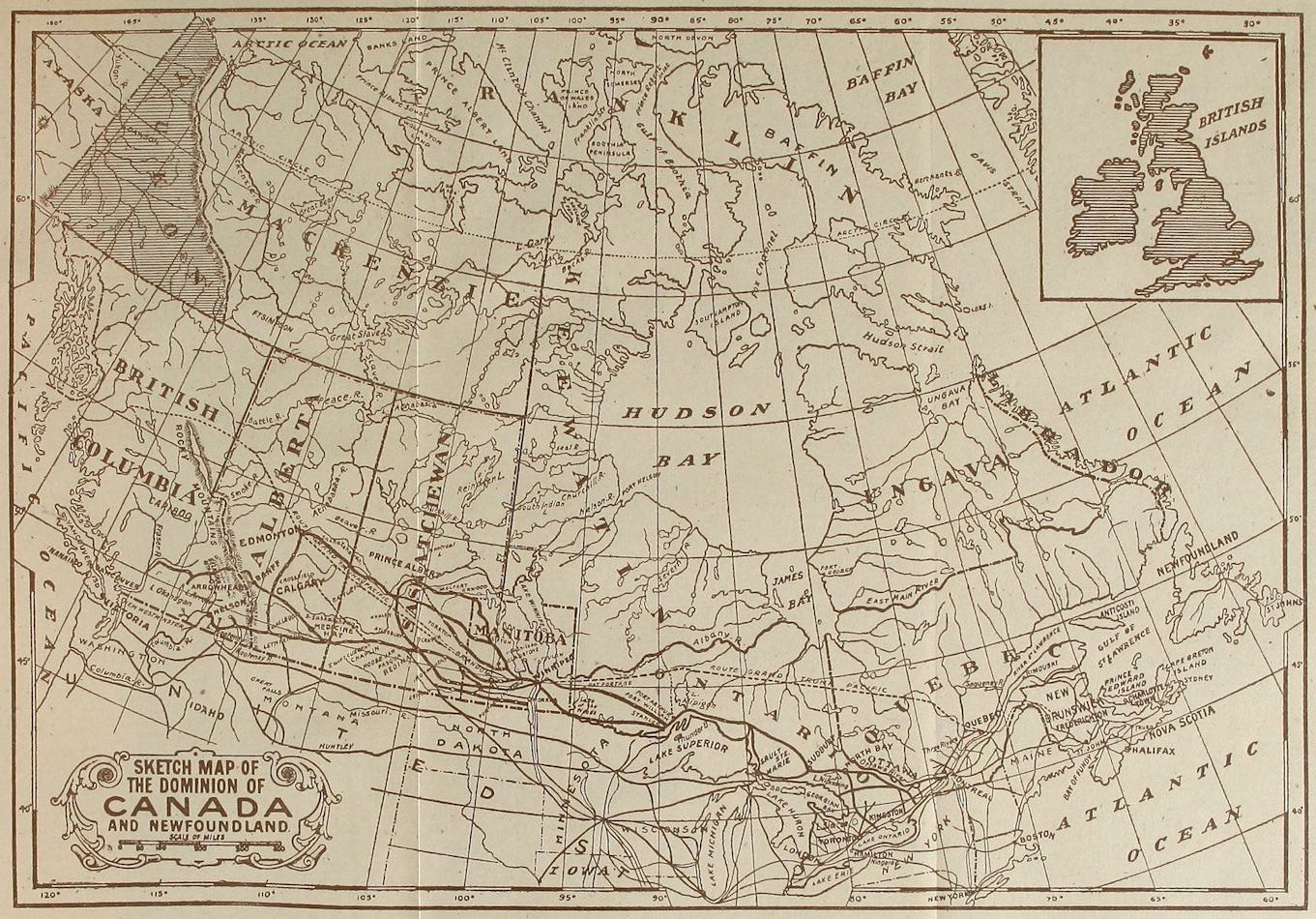
MAP ACCOMPANYING “CANADA.”
“CANADA.” PAINTED BY T. MOWER MARTIN. R.C.A. DESCRIBED BY WILFRED CAMPBELL, LL.D. PUBLISHED BY A. AND C. BLACK, LONDON.
Punctuation and obvious type-setting errors have been corrected without note. Archaic spellings of words and place names have been retained. Most illustrations have been relocated slightly from the original positions to keep paragraphs intact.
[The end of Canada by William Wilfred Campbell]